Australian
and international
exploratory
performance and
media arts
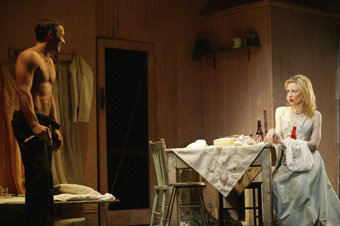
Joel Edgerton, Cate Blanchett, A Streetcar Named Desire, Sydney Theatre Company
photo Lisa Tomasetti
Joel Edgerton, Cate Blanchett, A Streetcar Named Desire, Sydney Theatre Company
a streetcar named desire
It was with some apprehension that I went to see the Sydney Theatre Company’s A Streetcar Named Desire. First, would Cate Blanchett be too young and temperamentally too strong to realise Blanche DuBois’ fading beauty and emotional fragility? Secondly, did an actor as able and inventive as Blanchett need an exotic import like Liv Ullmann as her director? Or was the choice simply a signal of psychological seriousness and world’s best practice? Thirdly, the word was out that the production was going to be conventionally staged. What could we possibly learn from that?
I’d watched the opening scenes of Charlie Kaufman’s film Synecdoche, New York with amusement as a director (Philip Seymour Hoffman) daftly cast Arthur Miller’s The Death of a Salesman with a young Willie and Linda in an otherwise straightforward staging. I’d read Daniel Mendelsohn’s caustic account of Natasha Richardson’s 2005 performance as Blanche in New York with “the sexless glow of an Amazon, or given her coloring, perhaps a Valkyrie” (“Victims on Broadway II”, How Beautiful It Is and How Easily It Can Be Broken, Harper Perennial, 2009). In trying to up the gender wars ante in the Blanche-Stanley conflict Richardson and her director, Mendelsohn complains, had reduced the woman’s vulnerability and altogether eliminated the potential for sexual frisson between the protagonists—a key element of the play for him and so evident in the Elia Kazan film with Vivienne Leigh and Marlon Brando.
At one level, I needn’t have worried about Blanchett. Once again, her capacity for transformation was evident in the overall conception of the role and in myriad details. Her Blanche is driven by a nervous energy that is always on the edge of exhaustion: a quivering alertness alternating with distracted inwardness. Bursts of posturing, over-confident lying and angry self-defense increasingly weary her until, fractured, confession and withdrawal ensue. This stripping away of the Southern belle facade is amplified by the ‘undressing’ of Blanche. Ullmann and Blanchett rightly make much of Blanche’s relationship with her clothes, in the end leaving her with even less dignity than we might expect—exiting abject in petticoat and bare feet. Another image, seen twice, that disturbingly complements this descent has Blanche, still and silent, squatting on the floor with a piece of cloth draped over her head, cutting out a world she can no longer handle. Perhaps it’s this imagery that Liv Ullmann, with her experience of the film world of Ingmar Bergman, brings to Blanchett’s interpretation of Blanche—a complete psychological demolition of the woman and concomitant physical weakening.
Joel Edgerton’s Stanley in the opening performance didn’t seem interpretively distinctive but looked right and by the second half the rolling momentum of his psychological and physical assault on Blanche, and its roots in her overheard reference to him as an ape, is fully felt. As for any sexual play between this Blanche and Stanley, I didn’t detect it, and the rape was a rape. This might not satisfy Daniel Mendelsohn should he see the production when it bravely tours to New York. Blanche and Stanley here are simply antagonists, the complexity of the production residing in the woman’s condition. Certainly there’s no concealing the danger that Stanley embodies—a capacity for blind physical violence, against men as well as women—and a community that hypocritically abides it and for which Blanche is sacrificial victim.
Blanchett’s performance is admirable, above all, for conveying a palpable sense of Blanche’s suffering and her limited self-awareness, but I was left wondering what could have been revealed by a more inquiring director. Ullman’s production looks like one that could have originated on Broadway at any time since the play’s premiere. On the positive side there’s the fidelity to Tennessee Williams’ very particular sense of light and sound in Nick Schlieper’s lighting, sharply contrasting the moonlight and dark in which Blanche hides with, for example, sunlight blazing through a window, while Paul Charlier and Alan John do film score justice to the writer’s desire for a sound world which includes music largely heard only by Blanche, and ourselves. The kind of ‘magical realism’ that Williams was aiming to achieve is, then, partly realised if not forthcoming elsewhere.
The set design emphasises the limits of the production. Ralph Myers (whose wonderfully expressive designs for Benedict Andrews and Barrie Kosky sometimes evince an architectural sensibility, as in the thrusting rooms in Act 2 of Lost Echo) places atop of Stanley and Stella’s humble 1940s apartment a giant, oppressive block of 50s modernist construction that fills the upward balance of the stage, as if perhaps to highlight a world that has moved coolly on from these downstairs melodramatics. However, the apartment setting itself looks not simply like a poor American home but a standard American stage set. As well, there’s an uncomfortable feeling of facing a pronounced fourth wall, of peering into rather than sharing a world (amplified if you’re some distance from the stage) where the actors, for the most part, play to each other across the stage in a self-contained world. This is at a time when stage acting is in a fascinating period of transformation with much gestural and spatial play and a return to, or radicalising, of older conventions of performance in more direct relation to the audience.
If grateful to have witnessed Blanchett’s performance, not least in the final stages of Blanche’s decline, the residue of feeling about the production was of over-familarity, of museum mustiness that blunted the threat that A Streetcar Named Desire can still doubtless deliver. We are quietly reminded of this not in the passages of high passion but when Blanche is tempted to seduce the boy collecting newspaper money or the silent moments when she covers her head.
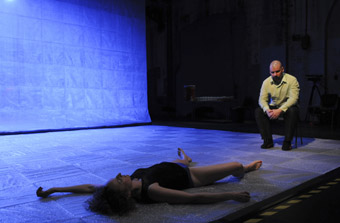
Kim Vercoe, David Williams, This Kind of Ruckus, version 1.0
photo Heidrun Löhr
Kim Vercoe, David Williams, This Kind of Ruckus, version 1.0
this kind of ruckus
It’s a quick trip across town, from Tennesee William’s 1947 at Sydney Theatre to version 1.0’s 2009 at CarriageWorks, but not a lot has changed—the violence perpetrated by men against women is still the issue, but the way of playing it is light years away. Version 1.0’s mixed media and performance modes have cast a widely admired ironic and revealing light on contemporary politics, but in This Kind of Ruckus the company inhabit a reverie confabulated from their own raw materials instead of their customary drawing on government reports, Hansard and the media.
The outcome is a large scale looping reverie of motifs, strange tales, fragmented encounters, unlikely cause and effect, missing links and a dense layering of metaphors. There’s little that’s literal. The outcome is a work of peculiar beauty, like a half-remembered dream, part-nightmare, replete with oddly aestheticised violence and not a little humour. “It was funny, in an ugly kind of way”, I heard someone say.
This Kind of Ruckus is like a Freudian dream theatre: images repeat, split, multiply, condense, mirror themselves; figures appear in new guises; narratives fragment, skip beats; episodes re-play with new variations, some obvious, some distant. Suspended screens appear to duplicate the live action below, but are as likely to contradict stage conflict with images of fond intimacies. The screens reveal memories of distress and trauma but also images of wish fulfilment.
The performing space itself transforms, multiplying meanings. Initially a huge curtain, lit red, looms over the audience with the cast lining up as cheer leaders, locked into position, ready for the “1, 2, 3…” Instead they abruptly sit and chat, one vigorously telling a story of two women on a Saturday night drive witnessing city street violence and fantasising vigilante action on behalf of endangered females—until they’re disabused by a sinister policeman. The storyteller is joined by another of the cheerleaders and together they ogle the men in the audience, making lewd offers. Actually, they’re mimicking male behaviour; a dismissive male cheerleader states the obvious: “You haven’t got the balls.” The curtain is gone, revealing a wall and floor of quilted bubble wrap, suggestive of a padded cell or, a dance club, a therapeutic space. Above is the screen, to either side, tables with rows of alcoholic drinks which the performers consume regularly with an escalating sense of bingeing, especially by the women.
The opening scene is indicative of the metaphorical layering and shifting which are the show’s modus operandi: the image of an unspecified sporting function mutates into a storytelling bout, into some calculately confusing gender role shifts, and then morphs into a “this is theatre” mode and offers an ambiguous performing space in which a seated man stares at a woman sprawled on the floor, possibly unconscious, perhaps lifeless. A victim of violence?
Before the curtain closes when the cheerleaders return for their oranges at half time, the audience has had printed into its consciousness a series of images and episodes. Central to these is the man watching the woman on the floor. We’ll see the same couple in conflict but intimate on the screen, and then undergoing counselling in this padded room. The counseller negotiates the man’s approach to the woman, constraining him according to the woman’s response (“He was pretending not to walk but he is walking. It’s a bit creepy.” “He feels tall, toweringly tall.”) She’s wounded, volatile. He’s accommodating, but has nowhere to go. Our empathies swing; we’re deprived of context.
In a parallel scene in the second half, when wall and floor have disappeared to make way for a large space down which the performers can hurtle as if in a race (sport again?), a man approaches a woman. An escalating, grating score suggests the location as a dance club. He draws very close, moves about her, touches her cheek, her arm. She does nothing. He touches her breast. She waits then briskly walks away. He shivers, rejected; he shakes with body-consuming fury. Elsewhere in the performance, the same figure has quietly repeated a few questions to a woman that suggest the controlling personality that underlies jealousy. We make the link. Later images are more overtly suggestive of violence: blood smeared across faces and torsos, male and female. The man who stared at the floored woman, now sits bloodied, naked to the waist, at the same angle, but now in the distance. We guess at the cause, the event has gone missing. Her blood or his? We guess, we weave.
In This Kind of Ruckus version 1.0 has studiously avoided making documentary theatre, instead conjuring suggestive images of the triggers for and aftermaths of male violence against women. Some of these are blunt and a few surprisingly literal (a court scene in which a victim’s humilation is intensified by a female defense council). Most are more complex, ambiguous even. Likewise, the framework for the show appears to be rooted in sport, but it’s cheerleaders we see, not players, in an unglamorous rendering of a mere fragment of the spectacle.
Once sport was thought of as a means for sublimating sexual desire but we see it now as locus for sex, violence and corruption. This Kind of Ruckus might have been ‘inspired’ by a spate of sports-related sexual violence but it’s not an investigation of that phenomenon—which has included the desire of team members to witness each other having sex with the same woman in the same room at the same time. This show essentially operates at a more atomistic level—the couple. The second half, for example, opens with the story of a woman terrified into having sex with her partner after she’s told him the relationship is over. The following morning they have breakfast as if nothing has happened and she never sees him again. The other members of the cheer squad quietly imply she triggered his threatened violence, as does the defense lawyer later on.
Other than sport, it’s dancing—noisy, ruckus-y, lewd, limp and falling-down—and alcohol consumption that provide a mutating framework for the show’s sexual violence, not as causes per se but amplificatory, suggestive of an inescapable loop of the forces at work in the nightmarish arena that version 1.0 has created. With its distorting single figures, blurred couple action (sometimes glimpsed through bubble wrap), spare scenography and projected video diptyches, This Kind of Ruckus recalls the febrile visions of Francis Bacon.
The company, with guest Arky Michael, performs with great no-frills conviction and ever intensifying ensemble strength while Gail Priest’s dense, pulsing score (breaking glass and riot melded with dance beats) and Sean Bacon’s haunting live and pre-recorded projections provide motifs that not only heighten the show’s dream sense but anchor its wilder flights.
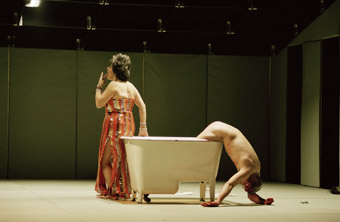
Barbara Spitz, Florian Carove, Poppea
image courtesy Sydney Opera House
Barbara Spitz, Florian Carove, Poppea
barrie kosky’s poppea
If you love Monteverdi’s The Coronation of Poppea (1642) you have to put much of it out of mind to enjoy Barrie Kosky’s re-working of the opera as vigorously entertaining, comic to the point of silly, sometimes aptly repulsive music theatre. All opera is music theatre but not all music theatre is opera. ‘Theatre’ is writ large in this production. It’s not that the music is secondary in any way, but rather that its realisation is infinitely more theatrical than even the most progressive of 21st century opera productions (even New York’s Metropolitan Opera, in search of new audiences, has mounted a new Tosca set in an industrial warehouse and replete with blow job for Scarpia). This Poppea has been created for and is rooted in the theatrical capacities of performers Kosky worked with in Vienna and even where they are stretched by the music (Cole Porter no less a challenge than Monteverdi) they bring it into their own range, entirely in character. Beatrice Frey as a tall, Shelly Duvall-ish Octavia ascends in falsetto to the top note, reaching it with a cracked screech—funny, without any sense of parody and apt for the empress’ frustrations.
Elsewhere Kosky redistributes musical passages to pointed psychological effect. Seneca (Florian Carove), the playwright-philosopher adviser to Nero (Kyrre Kvam), is played as mute, his tongue having been torn out as prelude to a forced sucide. Nero, hovering over a bloodied Seneca awash with blood in a bath tub, sings his erstwhile tutor’s lines as if knowing precisely what he would argue. It lends Nero a sharper intelligence, intensifying the sense of danger he embodies along with the ambivalent feelings as he embraces and then bluntly tosses aside Seneca’s body. Fittingly, Kvam’s singing is the closest to operatic.
The physically sexual intensity of the production is evident early on when the erotic play between Nero and Poppea (Melita Jurisic) has the emperor behind his mistress, his hands tightening around her neck in an act of sexual strangulation, grimly counterpointing opera’s breath-based, orgasmic soaring. Later there’s cunnilingus (to “Anything Goes”), Nero briskly rapes Ottone (Martin Niedermair as Poppea’s former lover) and Poppea cuts Nero’s chest. The emperor’s court is joyously and dangerously decadent, making actual what was only suggested in the opera.
Ottone, quite unlike the furiously angry man in the Monteverdi, is played here as a love lorne, lugubrious intoner of Cole Porter songs while looking like a sailor refugee from Fassbinder’s Querelle de Brest. He plots with Nero’s wife, Octavia, to kill Poppea with the help of the latter’s servant, Drusilla (Ruth Brauer-Kvam)—now infatuated with Ottone. An exotic, Theda Bara-ish presence in the court, her vocals inflected with a husky Eastern-European twang, Jurisic’s Poppea is sensual, self-possessed and single minded in her ambition, but the physical centre of the production is Drusilla, a joyful dynamo whose dancerly speed and contortions recall Meow Meow at her most excessive. Amor (Barbara Spitz), the god of love, on the other hand is a languorous observer, a droll queen, not the cute devil-cupid of some 20th century productions.
The final duet, shared by both the opera and this music theatre confection—when the emperor has, remarkably, forgiven and banished the plotters—is as affecting as ever. Poppea’s dark mezzo underlines and entwines with Nero’s lilting tenor. Love has unexpectedly weathered the rampages of lust and perversion even in Kosky’s grimly hysterical 21st century rendering. Compared with The Lost Echo and The Women of Troy, Poppea is Kosky-lite and his idiom now more than familar if never less than fascinating—especially as realised by such formidable performers.
the rameau project
While Barrie Kosky preserves the essential narrative of Monteverdi’s opera, the principal characters and some of the music, Nigel Kellaway’s approach to classics of any kind is very different and, in Rameau, more demanding if you’re not familiar with the source material. He has high expectations of his audience. In a season of three free performances in one of the voluminous CarriageWorks tracks, The opera Project presented a new music theatre work after the 18th French composer with whom Kellaway feels a particular affinity.
The centre of this work was not a Rameau opera (these have recently found new favour in major productions in Europe) but Genet’s play The Maids supplemented by texts from other sources and a strand of petulant satire that had Kellaway on the phone to Cate Blanchett negotiating an unlikely collaboration. The text-based scenes were punctuated by pieces largely from Rameau cantatas scored by Kellaway for two violins, two cellos, double bass, piano and singer Annette Tesoriero, who doubled as the maids’ Madame, voice-off and elegantly fulfilled a range other functions. The small ensemble was particularly effective, neither emulating a period feel nor, thankfully, sounding like a 19th century chamber group. Tesoriero’s lucid singing made the Rameau a double pleasure. As for what the songs were about…none of the luxury of Opera House surtitles here.
Compared with previous opera Project productions Rameau was efficient, a meticulous, upgraded work-in-progress showing, no mean achievement given the late replacement of Regina Heilmann (called away on a family matter) by Nikki Heywood with script in hand. Over a number of productions, Kellaway and Heilmann have developed a mutual playing idiom, somewhat Brechtian, intoned, almost dancerly and most memorable in their take on George and Martha from Who’s Afraid of Virginia Woolf in The opera Project’s Another Night: Medea, 2003 (which drew in part on Clerambault’s cantata Medee, 1710). Passion in this manner of playing is palpable, but tautly framed, indeed operatic. Heywood broke the mold, countering the arch, strutting imperiousness of Kellaway’s maid with nuanced responses and a felt emotional collapse, at the same time avoiding conventional psychological realism. Kellaway’s maid departed like a strangled diva, deprived of her aria.
Rameau confirms Kellaway’s esoteric vision—musically scholarly, literary, in love with the cut and paste of building idiosyncratic works out of others’ classics. It’s a modus operandi he shares, broadly, with Kosky, and one which faces the inevitability of likewise becoming itself ‘classical.’
the duel
With the Elevator Repair Service’s seven-hour ‘reading’ of Gatz still resonating pleasurably in mind and body, a visit to the ThinIce/Sydney Theatre Company production of The Duel (from an episode in Dostoevsky’s novel, The Brothers Karamazov) proved to be a bonus. Tom Wright’s adapation dextrously interweaves direct storytelling with adept dramatisation played out in designer Claude Marcos’ wide, shallow box of a room emblematic of the closed circuit of social relations and codes that one man will rupture, if only for his own moral salvation. Like postmodern dancers, the actors stand about, observing and then suddenly slipping in and out of storytelling or acting as required. Played very close to the audience, the performances are realised with an absorbing, intimate intensity by Luke Mullins, Renee McIntosh, David Lee Smith and Brian Lipson. Lutton’s directorial hand is assured. It would be good to see more of Perth’s ThinIce in this kind of welcome co-production in a period, at last, where more and more shows cross state borders as well as the boundaries of form.
the city
Benedict Andrews’ meticulously faithful account of Martin Crimp’s The City precisely captures the playwright’s ambiguous tone. Crimp appears to be the inheritor of the early Pinter idiom, not in his silences but in the signifiers that refuse be nailed down and the threats that come with their instability. Characters are constantly uncertain of the topic of conversation or their position within it and seek clarification—the apparent banter of social comedy quickly turning dark when characters can’t read intentions. Crimp calculatedly extends the resulting verbal ambiguities (about love, family, identity, war, vocation and storytelling) into physical reality when a small girl, the daughter of the principal characters, Clair and Chris, suddenly appears dressed identically to the nurse, Jenny, who is the family’s neighbour. At this stage, Clair, a translator and would-be novelist, suspects (as we do) that she might be inventing her own and her family’s reality.
Much more than a postmodern conceit, this scary bleed between worlds real and imagined runs through this short (80-minute) but remarkably dense work. The very notion of the city shifts about restlessly, one moment a cruelly adaptive market economy and uncomfortably cosmopolitan, the next a model of a writer’s inner world, elswhere the scene of war. The neighbour Jenny confides an account of a “secret” war (where her husband is a doctor): “the city has to be pulverised so that the boys—our boys—can safely go in and kill the people who are left—the people, I mean, still clinging to life.” Director and cast wisely eschew literally enacting the anxieties prompted by these uncertainties; the tone, not least in Belinda McClory’s finely idiosyncratic performance as Clair, is close to social comedy and all the more chilling for it. Characters are distracted, suprised and indifferent by turns, and like the verbal dancing, it’s hard to tell which way things are going, like Chris’ happy transformation from businessman to supermarket butcher.
Ralph Myers’ set almost looms over the audience, mirroring the seating rake in a series of giant carpeted steps (an abstracted city garden) requiring the performers to make their moves often with great effort, amplifying, if too awkwardly at times, the real challenges of meeting each other and negotiating already problematic communication.
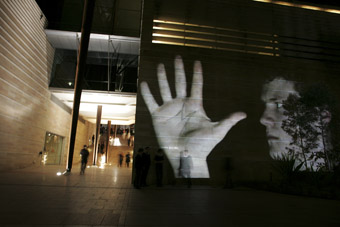
Lots in Space, UNSW/NIDA
photo courtesy NIDA
Lots in Space, UNSW/NIDA
nida: lots in space
Melbourne director Peter King has been NIDA’s inaugural artist-in-residence for six months this year, bringing together first year actors, students from NIDA’s open program, the McDonald College of Performing, UNSW Performing Arts and the UNSW Faculty of the Built Environment to collectively create Lots in Space. The outcome was an engrossing epic, true to the director’s architectural passions, flowing from the Parade Theatre foyer up the UNSW Mall, moving from installation to installation, and back to the theatre for a performance.
On the mall we glimpsed, through glass, figures in a halting abstracted Renaissance dance descending the Law Library stairs. Further on virtual water tumbled spectacularly down a raked square on which actors played out an excerpt from Thomas Middleton’s Women Beware Women (c1621). Around a corner a huge moon and scrolling text filled a vast facade below which performers danced, then led us back down the mall, completing a circuit of some 10 installations. In the theatre, images from the promenade recurred alongside further excerpts from Middleton’s play, Shakespeare’s The Tempest and Pericles and, hugely projected, Eistenstein’s Ivan the Terrible.
The almost ritualistic ebb and flow of large numbers of performers was dotted with microcosmic moments of intense drama of manipulation, oppression and sudden release. If at times a bewildering collage (a treasure house for keen quotation identifiers and cross-referencers), Lots in Space displayed organisation, collaboration and commitment of a high order. The young actors were impressive and the promenade installations revealed a confident engagement with powerful projection technology. Lots in Space was an apt celebration of UNSW’s 60 years and NIDA’s 50, when it needs to be looking to the demands of a diversified performance sector in the 21st century.
–
Sydney Theatre Company (STC), A Streetcar Named Desire, writer Tennessee Williams, director Liv Ullmann, performers Cate Blanchett, Michael Denkha, Joel Edgerton, Elaine Hudson, Gertraud Ingeborg, Morgan David Jones, Russell Kiefel, Jason Klarwein, Mandy McElhinney, Robin McLeavy, Tim Richards, Sara Zwangobani, musician Alan John, set designer Ralph Myers,?costumes Tess Schofield, lighting Nick Schlieper, sound designer Paul Charlier; Sydney Theatre, Sept 5-Oct 17;
version 1.0, This Kind of Ruckus, performer-devisors David Williams, Danielle Antaki, Arky Michael, Jane Phegan, Kym Vercoe, video artist Sean Bacon, sound artist Gail Priest, lighting Neil Simpson, devisor-dramaturgs Deborah Pollard, Yana Taylor, Christopher Ryan; Performance Space, Carriageworks, Sept 3-12;
The opera Project, The Rameau Project, writer, director, composer Nigel Kellaway, performers Nigel Kellaway, Nikki Heywood, Annette Tesoriero, dramaturg Bryoni Trezise, lighting Simon Wise; Performance Space, CarriageWorks, Aug 20-22;
The Duel, adapted by Tom Wright from Dostoevsky’s The Brothers Karamazov, director Matthew Lutton, performers Luke Mullins, Renee McIntosh, David Lee Smith and Brian Lipson, designer Claude Marcos, lighting Damien Cooper, sound design Kingsley Reeve; Wharf 2, STC, opened June 9;
The City, Martin Crimp, director Benedict Andrews, performers Georgia Bowrey, Anita Hegh, Belinda McClory, Colin Moody, Gigi Perry, set designer Ralph Myers, costumes Fiona Crombie,?lighting Nick Schlieper, composer Alan John; Wharf 2, STC, opened July 3;
NIDA and UNSW, Lots in Space, director Peter King, designers Matthew McCall, Kate Robert, Aron Dosiak, lighting Sarah Kenyon, Richard Whitehouse, UNSW Mall, Parade Theatre, Sydney, July 21
RealTime issue #93 Oct-Nov 2009 pg. 44-46
© Keith Gallasch; for permission to reproduce apply to realtime@realtimearts.net
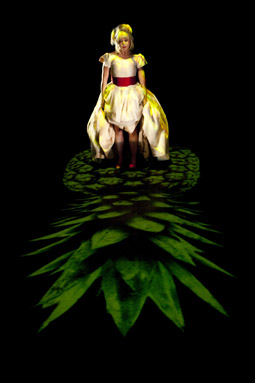
Lisa O’Neill, The Pineapple Queen
photo Sean Young
Lisa O’Neill, The Pineapple Queen
HOWEVER IDIOSYNCRATIC, LISA O’NEILL IS AN ICONIC QUEENSLAND DANCER, ACTOR AND NEW MEDIA ARTIST. WITH HER OWN DEEP SENSE OF IRONY, THE PINEAPPLE QUEEN MIGHT SEEM TO HAVE BEEN INTENDED TO SELF-REFLECT THIS CULT STATUS, AS INDEED IT DOES, BUT NOT IN A WAY PERHAPS MANY OF US EXPECTED.
the pineapple queen
This collaborative performance piece at the Roundhouse Theatre began as a more condensed, feral affair gleaned from a reworked script by writer Norman Price in 2004 as part of a series of Dada inspired performances around Brisbane. This piece and its developments, one says admiringly, exhibited O’Neill’s usual strengths. However, the La Boite showing added a new dimension of transparent vulnerability to O’Neill’s performance and repetoire. Strong dramaturgical input from director Ian Lawson elastically stretched definitions of both theatre and performance for La Boite who showed nerve in mounting this production.
The Pineapple Queen is presented through short scenes and minimal effects reminiscent of Buchner’s Woyzeck retold in a rural Queensland setting. The crucial elements in Buchner’s play—the dark pool (love and suicide) and the encroaching storm (Woyzeck’s madness)—are reproduced to similar effect in this production by the mysterious “coal hole” and the storm over the Glass House Mountains. However, as the Glass House District Pineapple Queen, it is O’Neill who is going mad, and her romantic self-confabulations and grand illusions are butresses against this end. As her defences crumble, the domestic brutality and squalor of the protagonist’s marriage are revealed in a final directorial coup which exposes O’Neill’s character as no longer capable of ‘acting.’ It is as if we are seeing Buchner’s Marie further down the track with her Sergeant, with all the nasty implications of history implacably repeating itself. In the final fadeout on the dethroned queen, cringing without any armour, it is as if we too have been effectively shut out from the text, along with her, denied a voice in history.
If the voice of history is patriarchal and monological, where are our vaginas? The central image of the hole in the Golden Circle Pineapple and the ellipses implied by the “coal hole” alert us to the gaps in consciousness, language and the body where real possibility for dialogue in this dark fairy tale exists. But Ian Lawson’s narrative uptake drives the play like a detective story, providing clues to the Queen’s madness, and this is indeed intriguing while ironically we are complicit from this monolithic vantage point in excluding her voice. But that a realistic explanation would ever be sufficient clue is moot given that the cause of her trauma is so shockingly and symbolically overdetermined in what is proposed in the final analysis—that she was forced as a child to assist her mother to self-abort with a baling hook, and that she herself repeats this familial cycle of violation. Her own comically depicted abortion of a pineapple after a vicious rape has an appropriately hallucinatory edge.
Despite such shocking imagery, this production sustained an uncanny poetic flow, all the elements contributing to maintaining a heightened feel that this woman is trying, above all, to survive and live. Price’s text this time is more spacious and allows the performance to move forward adeptly. Michael Coughlan, as the Pineapple Queen’s husband, delivers a superbly timed, immaculate performance of restrained emotion and potent physicality. The animations by Jaxcyn, projected onto the floor, such as the pineapple process plant at which The Pineapple Queen presumably worked in a menial position, or the expanding flower arrangement on which O’Neil danced, is simply the best integrated video design I’ve seen in a very long time. These were matched by David Walters’ subtle lighting and portentous music from Guy Webster.
There seem to be two versions of The Pineapple Queen. The earlier, more surreal version was easier to laugh at; the second is harder to watch, but equally rewarding in very different ways. In the first, The Pineapple Queen resorted to an axe to decentre authority or perhaps, more importantly, to perform a creative, purposeful act of self-authority. In this one, we see the performer Lisa O’Neill make a huge leap with the assistance of generous collaborators to lay herself open to dialogue with multiple voices.
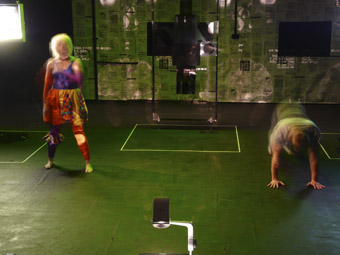
Genevieve Trace, Kieran Law, Transverse Fracture of the First Metacarpal
photo Yvette Turnbull
Genevieve Trace, Kieran Law, Transverse Fracture of the First Metacarpal
transverse fracture of the first metacarpal
Another work in the physical performance vein was Transverse Fracture of the First Metacarpal performed as part of the Independents 2009 season at the Sue Benner Theatre at Metro Arts. This often disarming but deceptively contrived piece dealt with personal encounters with physical injury and rehabilitation by the co-creators Kieran Law and Genevieve Trace. That this might be of major industrial concern for starting out artists was emphasised, coincidentally, by the fact that only relatively recently did mid-career artist Lisa O’Neill return to performance after significant time out due to injury. Curiously, the shows bear a resemblance.
Law and Trace warmly engage with the audience and each other, developing a neat patter between them and bearing lightly on their physical injuries. Trace is particularly funny as she clowns through the story of how she seriously hurt herself while in the original daffy costume she wore on stage as a teenage performer. Law plays a more bashful muggins when he describes the usual dumb things young men do that resulted in his own injuries, although, to be fair, Trace unrepentantly confesses to having her nose broken in a stupid fight with her sister.
There’s an underground tension that emerges darkly to counter this lightness. This transverse fracture in the proceedings is well managed by the performers as they disengage from the audience and each other, entering another world of their own. Thom Browning’s low key electronica inundates the space to create a moody uneasiness perfectly complemented by Whitney Eglington’s spare lighting design. Two medical light boxes suspended in the space illuminate the brain scans and x-rays of broken bones held up to them in classic gestures that recreate to strong effect the still moment of anguish and horror before a patient’s life or death sentence is pronounced. Law’s Suzuki-based and Trace’s circus style of repetitive choreographed movement performed with absolute focus likewise served to prolong this moment to an unnerving extent considering the real risk of injury in this context.
This was a sophisticated and interestingly constructed show—the moment of disconnect, the movement into abstraction, was similar to the act of severence performed by O’Neill in The Pineapple Queen wielding her axe, and for the same reasons. Law and Trace, by cutting ties to their own self-narratives, seemed to be staking claim to new and uncharted territory on a level basis with the audience. Given their obvious skills and commitment, it will be interesting to see how their future work develops with larger subject matter. As a footnote, I’d like to mention the salient influence I’ve been observing that OzFrank has been having on two generations now in Brisbane.
The Pineapple Queen, creators Norman Price, Lisa O’Neill, writer Norman Price, director, dramaturg Ian Lawson, performers Lisa O’Neill, Michael Coughlan, sound composer Guy Webster, lighting design David Walters, costume design Glen Brown, video design Jaxzyn; Roundhouse Theatre, Brisbane, July 28-Aug 8; Transverse Fracture of the First Metacarpal, co-devisors, performers Genevieve Trace, Kieran Law, sound design Thom Browning, lighting design Whitney Eglington; Sue Benner Theatre, Metro Arts, Brisbane, July 9-25
RealTime issue #93 Oct-Nov 2009 pg. 47
© Douglas Leonard; for permission to reproduce apply to realtime@realtimearts.net
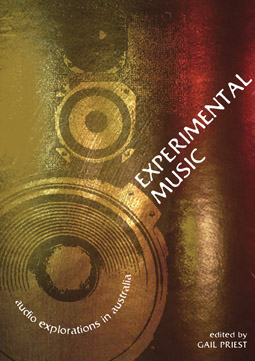 A NEW BOOK, EXPERIMENTAL MUSIC: AUDIO EXPLORATIONS IN AUSTRALIA, FROM UNSW PRESS, OPENS ‘SCENIC’ WINDOWS ONTO HIDDEN WORLDS OF AUDIO CULTURE AND CONTEMPORARY MUSIC-MAKING FOR THOSE WHO MAY HAVE BEEN CAUGHT IN ITS SPELL AND WONDERED WHERE IT ALL CAME FROM.
A NEW BOOK, EXPERIMENTAL MUSIC: AUDIO EXPLORATIONS IN AUSTRALIA, FROM UNSW PRESS, OPENS ‘SCENIC’ WINDOWS ONTO HIDDEN WORLDS OF AUDIO CULTURE AND CONTEMPORARY MUSIC-MAKING FOR THOSE WHO MAY HAVE BEEN CAUGHT IN ITS SPELL AND WONDERED WHERE IT ALL CAME FROM.
My first conscious meetings with experimental music were through a high school music camp tutor and through the older brother of a school friend. The tutor introduced me to the post-war classical experiments of total serialism, graphic scores and chance processes; the friend’s brother to the world of Severed Heads and other Australian and international manifestations of the experimental electronica that emerged in the wake of Punk. These two broad strands of activity are the primary antecedents that the editor of Experimental Music, Gail Priest, identifies for today’s Australian experimental music culture.
It’s been a long wait for a book-length attempt to document and interpret these developments in Australia and I approached Experimental Music with both excitement and anxiety. I was excited because at last an important part of the music scene of my own era and place was being represented in book form, but anxious that the book would not be up to the task—that I would find myself taking issue with the writers on everything from the book’s title to its many claims and omissions.
In attempting to meet this challenge, Gail Priest and her publishers have provided an introduction and framework for what amounts to a series of essay memoirs by a representative group of artist-commentators, each presenting and reflecting on the genre, scene or facet of the experimental music kaleidoscope they know best.
The opening quote from Jon Rose sets the book’s tone. “You can and should research and write your own history…” This is history written by the history-makers, an idiosyncratic assemblage of artists whose primary strength as commentators is the immediacy of their experience and the freshness of their memories of the cultural scenes, practices and people they write about.
A snapshot of Experimental Music’s kaleidoscopic treatment of the experimental scene is gleaned by turning to the index and dipping into the different facets of particular artists featured across several chapters. The commonalities point to the slippery and constantly evolving nature of experimental ‘genres.’ They also highlight the importance of a relatively small number of artists in catalysing the scene-making activities of the many. Indeed, the convergence of the book’s narratives around these figures (such as Lucas Abela, David Ahern, Ross Bolleter, Philip Brophy/tsk tsk tsk, Warren Burt, David Chesworth, Jim Denley, Tom Elllard/Severed Heads, Robin Fox, Ron Nagorcka, Jon Rose and Rik Rue) seems to suggest an implicit Australian experimental canon. The absence of women from this quick survey reflects the apparent rarity of influential cross-genre female protagonists, women being best represented in improv and radiophony. Does much ‘experimental’ culture have a relatively macho, or ‘boys-with-toys’ character?
Launching in from a brief sketch by Priest of the main uses of the term ‘experimental music’ and its neighbours ‘sound art’ and ‘exploratory music’ the book’s 10 chapters provide 10 slices or ‘scene-based’ views of recent experimental music in Australia. Each of the chapters is marked by the language, feel and cultural priorities of the writers and their ‘scenes’—a jumble of heterogenous voices set within the framework provided by Priest. She bookends the collection with a brief focus on the ways in which contemporary sound culture is increasingly engaging the visual.
Priest and Julian Knowles in his opening chapter define experimental music primarily in terms of what it is not, a culture marked by its spirit of opposition. The glue that binds this unruly assemblage of divergent music-makers together is the will to push or transgress boundaries, whether between music and noise, the extreme loud and soft edges of hearing, the boundaries of intention and chance, of copyright, of the nature of instruments whether found, newly created, modified or reinvented, of music with other artforms, or of the social and physical contexts of music-making.
Knowles’ introduction delivers an overview of some key festivals and concert series that have supported and promoted the DIY end of experimental music over the past two decades. He provides a sense of the background and ecology of current scenes, emphasising both the fecundity of artists, events and practices and their fragility, subject to intermittent funding and the rapid ebb and flow of venues and series, all riding on the largely unpaid energies of their artists/curators.
His sketches of What Is Music?, Liquid Architecture, the NOW now Festival and other manifestations of the contemporary listening-oriented music scene begin to flesh out sub-cultural affiliations to free jazz and improvisation, to the electronic music and multimedia work of the academy and to the more anarchic energies of noise and other more punkish music-making.
As with the other contributors in this book, Knowles’ conception of experimental music-making perpetuates the late modernist amnesia concerning the extraordinary local Indigenous and colonial musical experimenters of the previous 200 years, as described in Jon Rose’s 2007 Peggy Glanville-Hicks Address. Again, this amnesia is partly built into the publisher’s brief for this book and its UNSW Press Australian Music series companions to tell the story of the past 30 years of music in this country. This is a time frame that makes more sense in Australian classical music where there are already a handful of books dealing with earlier periods. The short focus unfortunately reduces any sense that there is a local or national heritage to be drawn on, making experimental music culture seem to be an international phenomenon to which Australians have more recently responded and occasionally contribute.
In “The Lost Decade”, Ian Andrews and John Blades flesh out the first phase of DIY activities in a scene marked by hand-made cassette releases, low-tech looping, ephemeral labels, fanzines, and constantly permutating bands and collaborations creating an apparently bewildering array of small-scale, grass-roots activity all taking place in opposition to the established music industry. This evokes the time of my early adulthood, full of familiar and half-known names that provoke a flush of nostalgia and recognition while providing a larger context for a scene that I experienced on a purely local level.
The next three chapters follow three different paths from the experimental ‘scenesters’ of the post-punk ‘lost decade’ to the contemporary network of independent listening-oriented festivals and concert series described by Knowles. Cat Hope tells the story of the rise of ‘noise’ from a band-based challenge to mainstream definitions of musical sound to a genre, and now an increasingly important aspect of experimental music across the spectrum. Shannon O’Neill looks at appropriation-based music—the sampling, mash-ups and tributes that have pushed the boundaries of copyright. He makes the interesting observation that experimental music in Australia as a whole has recently shifted towards a more ‘materialist’ focus, eschewing quotation and absurd juxtaposition for a mostly straight-faced focus on the materiality of the instruments and the physicality of sound production and its by-products. Priest and Sebastian Chan’s brief sketch of the coexistence of popular and unpopular electronic music in the rave and party worlds of the 90s fills in one more background to the ‘listening-oriented’ music culture partly created by these artists as they detached themselves from the dance scene at the start of the new century.
By this time the lists of artists and projects, known, unknown and half-familiar, cry out for more detailed description of actual practices, provided to some extent by Bo Daley’s case study of the Sydney electronic music collective Clan Analogue. The account fleshes out the mechanics of scene-making with its attendant behaviours, aesthetics and ethics, within a typically post-Punk collectivist environment that characterised many of the DIY experimenters covered in the previous chapters.
Alistair Riddell takes the reader away from scene-making and into the world of the university electronic studios of La Trobe, Melbourne University, the NSW Conservatorium and Adelaide’s Elder Conservatorium in the 1970s, characterised by the interplay between scientific and artistic mind-sets. It’s a starker version of the interplay between instrument and idea that characterises all creative music making. A similar interplay is found in the independent instrument-building activities of Sean Bridgeman’s chapter, ranging from software, through circuit-bending and the building and radical modification of acoustic instruments. Riddell ends his chapter with a plea for the continued university development of the programmer-musician in the face of a scene increasingly dominated by individual laptop artists operating in the main as end-users of third-party software rather than creative developers of new software to express highly individual artistic intentions.
Jim Denley’s chapter on ‘improv’ returns to scene-making but continues Riddell’s larger sweep of time and geography with a definition and brief sketch of the development of improv in Australia from 1972 to the present followed by a series of portraits of key artists, neatly distilling the contributions and stylistic approaches of each. The What is Music? festivals of the 1990s, founded by improvisers Robbie Avenaim and Oren Ambarchi, are seen as key in taking improv from the underground of a handful of practitioners into a visible scene with a surprisingly large and youthful following. Part of the secret of the large numbers is that improv has developed a participatory ethos in which many players move easily between the roles of audience and performer.
In “Written In Air”, Virginia Madsen introduces readers to the world of radiophonic arts, a strand of experimental sound culture emerging out of the radio sound studios of France, Germany, Italy and the UK. This tradition thrived within the Australian Broadcasting Corporation over two decades, most famously in the long-running program The Listening Room, providing experimental opportunities and resources to diverse artists interested in hybrid interplays of environmental recordings, words, instrumental music, sound effects, electronics and any and all of the arts of sound. Her hymn of praise to peripatetic ex-pat Australian Kaye Mortley’s radiophonic oeuvre had me wanting to hear more and wishing for spaces today where this work might more readily continue to be heard. Gail Priest’s accompanying CD selection of examples barely skims the surface of the many scenes and artists in this book, but does provide a number of tantalising glimpses, including an extract from Mortley’s Exilio from 1999.
Experimental Music: audio explorations in Australia fills a cultural gap, documenting local audio culture and providing a useful taxonomy of the main modes of practice in Australia frequently understood as ‘experimental music.’ A contentious aspect of the book will be the very Sydney-centric roster of contributors. Some of these do better than others in elaborating a national perspective, but the provocation is there to counter the shortcomings with more books and articles, offering alternative readings and the coverage of artists and local scenes not represented here.
And the publication of such a book has a valuable legitimising effect, building wider awareness of the experimental scene’s traditions and key antecedents and therefore of its place in the broader culture. There is of course some ironic tension in the legitimising of experimental music culture given that culture’s commitment to opposing and dismantling orthodoxies. At what point does an experimental musical form/scene/process/aesthetic/…cease to be ‘experimental’ and become part of received culture? Nevertheless it’s healthy for any culture to foster historical awareness among its participants if only to guard against the uncritical acceptance of new ‘experimental’ orthodoxies.
Gail Priest, editor, Experimental Music: audio explorations in Australia, UNSW Press, 2009, ISBN 978 1 921410 07 9. The UNSW Press Australian Music series was supported by the Music Board of the Australia Council.
www.experimentalmusicaustralia.net
RealTime issue #93 Oct-Nov 2009 pg. 48
© Stephen Adams; for permission to reproduce apply to realtime@realtimearts.net
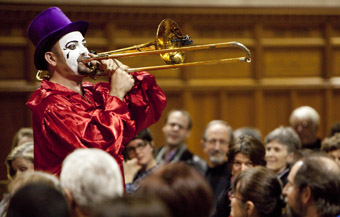
Perspective, Soundstream: Adelaide New Music Festival, Dave Palmer
photo Jia Zhuang
Perspective, Soundstream: Adelaide New Music Festival, Dave Palmer
SOFIA GUBAIDULINA’S CLOWN STEALS THE SHOW AT THE OPENING NIGHT OF ANMF. A TROMBONIST IN COSTUME ENTERS THE AUDITORIUM AND INTERRUPTS A SAXOPHONE QUARTET PERFORMING ON STAGE IN HER VERWANDLUNG (TRANSFORMATION). THUS BEGINS AN ARGUMENT, THE DIFFERENT INSTRUMENTS AND THE PLAYERS REPRESENTING OPPOSING MUSICAL AND CULTURAL FORCES, WITH THE RED-SMOCKED TROMBONIST, THE OUTSIDER, CHALLENGING THE ESTABLISHMENT.
In a program note, Russian composer Gubaidulina states that “the trombonist stands for a Russian archetype, the holy fool or yurodivy.” The yurodivy “plays the fool, while actually being a persistent exposer of evil and injustice.” The clown flirts with the audience—the people—to gain their favour as he attempts to disrupt the saxophonists.
Gubaidulina’s Transformation (2003) is a theatrical composition whose message has universal significance. Unable to suppress the formidable saxophonists, the clown sits dejectedly to remove his makeup while a cellist and a double-bassist take up the musical line. Trombonist Dave Palmer is splendid as the clown who ultimately joins the sax and string ensemble, abandoning his outsider identity by covering his costume and performing from the same score as the others who now accommodate him, developing a canon form to indicate the echoing of new ideas. The work ends with the solitary beat of a tam-tam by a performer-witness in a red shawl who has sat silently by throughout, patiently awaiting her moment, signalling a beginning rather than an end.
Adelaide is a city of many festivals, but until recently hasn’t had a dedicated new music event. The excellent program for this, the second Adelaide New Music Festival, spans a century of composition, attracting good audiences with outstanding performances. In opening the ANMF, former Adelaide Festival of Arts director and ANMF patron Anthony Steel noted how difficult it is to get audiences outside of the comfort zone of the Adelaide Festival.
ANMF Artistic Director Gabriella Smart’s theme for this ANMF is the sacred and profane, and a central character is the clown or fool, who also appears in the closing concert at Coriole Vineyards on the Saturday afternoon.
At St Peter’s Cathedral, Transformation was preceded by a performance for cello, choir, celeste and percussion of Gubaidulina’s Sonnengesang (Canticle of the Sun, 1997), which sets a text by St Francis of Assisi, pays homage to revered Russian cellist Mstislav Rostropovich and attests Gubaidulina’s own faith. In this fabulous work, the choir acts as the orchestra for what is in effect a cello concerto as well as a canticle, and stands in for parishioners. The percussionists rub the moistened rims of glasses that represent chalices, creating a whining sound that blends with the cello and soprano voices to create an ethereal effect. Tubular bells evoke the sound of church bells. Later, the cellist puts down his instrument and walks about the choir as he plays a flexatone with a bow, eliciting a responsory as part of the canticle and thus directing the choir, before returning to the cello to bring the work to its climax.
Sonnengesang is thus based on two distinct musical forms, actively linked by the cellist, and on sacred and profane traditions. Gubaidulina asks much of the soloists in her work, as musical performance is extended into dramatic performance with detailed stage directions. Netherlands-based Australian cellist John Addison, a Gubaidulina specialist, gave a spellbinding account of this complex and demanding piece, and the Adelaide Chamber singers under Carl Crossin were magnificent.
On the second night, Adelaide’s Zephyr Quartet gave a recital exploring Jewish musical traditions, including Argentine-born composer Osvaldo Golijov’s breathtaking Yiddishbbuk, Inscriptions for String Quartet (1992), a reconstruction of music to accompany a set of apocryphal Jewish psalms. The work unfolds as a series of dramatic gestures, with notes held long like screams, and moves on to fragmentary tunes that are frighteningly abbreviated. Also included were Adelaide composer Quentin Grant’s Klezmer Variations and Melisande Wright’s suite Lighter Shades of Pale, both of which foregrounded the unique Klezmer tradition with its seductive, danceable rhythms.
Melbourne’s Anthony Pateras and Robin Fox are internationally renowned but had never before performed in Adelaide. The third night was theirs, Pateras giving a mesmerising performance on prepared piano and Fox a wondrous rendition of his laser and sound show. They formed a dynamic duo to conclude with several short pieces for synthesisers, laptop and Pateras’ sampled voice, with Pateras manipulating the synthesiser as frantically as he had the piano.
On the Saturday there were morning and afternoon concerts in the Barrel Room at the delightful Coriole Vineyards, with a sumptuous lunch in between. The morning session comprised five exquisite short works by Australian and international composers: Pierre Boulez’s Anthèmes (1998) for solo violin (James Cuddeford), Tan Dun’s 1989 intensely introspective Traces for solo piano (Gabriella Smart), Adelaide composer David Harris’s Chinook (2009) for a trio of clarinet (Peter Handsworth), cello (Addison) and piano (Smart), Brett Dean’s Demons (2004, Geoffrey Collins, flute) and finally Hannah Kulenty’s A Fourth Circle (1994) for cello (Addison) and piano (Smart). Harris’s recent work is described as “expressive post-romanticism”, and in Chinook (one meaning of the term is ‘a warming wind’), he adroitly weaves tonal and chromatic lines and contrasting rhythms into a passionate and satisfying composition, highly resolved but with a delicious hint of uncertainty, like a complex rhetorical question. Kulenty’s is a stunning piece, emotionally overwhelming and brilliantly executed. Following a long piano passage like a tolling bell, the cello begins a series of questioning phrases that become incessant, using short, microtonally notated glissandi, crying imploringly—why? why? why? An intense crescendo is then slowly relaxed, with the glissandi curling downward. I was speechless for some time afterwards, so affecting were the writing and the performance.
In the afternoon was a single work, Schoenberg’s classic Pierrot Lunaire of 1912, which, though it is the earliest work in the festival, seems to draw together the threads of the previous four concerts—it was Schoenberg who championed chromaticism; it features the clown who is alienated from society and it speaks of tragedy and loss. Schoenberg set 21 poems to music, to be delivered using sprechgesang, a form of declamatory speech-like singing, in which the reciter slides into and out of notes. Greta Bradman’s performance as Pierrot was outstanding, and she was ably supported by a wonderful ensemble of Smart, Cuddeford, Addison, Collins and Handsworth under the firm direction of Pierrot expert Charles Bodman Rae.
This ANMF comprised an exemplary program of local and overseas works that reflect music’s recent development, thoughtfully curated by the indefatigable Gabriella Smart. Audiences benefited from detailed program notes, gaining a much expanded musical awareness. Especially, we heard music that also needs to be seen, recognising that the playing of an instrument is the enactment of a theatrical role.
Soundstream Adelaide New Music Festival, artistic director Gabriella Smart, Adelaide, Aug 19-22
RealTime issue #93 Oct-Nov 2009 pg. 49
© Chris Reid; for permission to reproduce apply to realtime@realtimearts.net
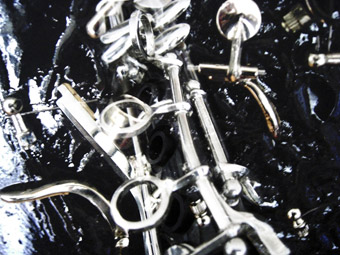
Brigid Burke, Scratching (video still)
courtesy the artist
Brigid Burke, Scratching (video still)
UNDER THE GUIDING HAND OF CHAIRMAN JAMES NIGHTINGALE, THE NEW MUSIC NETWORK HAS EXPANDED ITS CORE PROGRAM OF ESTABLISHED ENSEMBLES TO INCLUDE A RANGE OF CONCERTS BY SOLO ARTISTS AND EMERGING GROUPS OF CONTEMPORARY CLASSICAL MUSICIANS. NOT ONLY IS THIS PROVIDING PROFILE FOR NEWCOMERS BUT, AS MANY OF THESE ARTISTS EMPLOY MORE EXPERIMENTAL COMPOSITIONAL AND PERFORMANCE METHODOLOGIES, IT IS ALSO BEGINNING TO BLUR SOME OF THE PERCEIVED BOUNDARIES BETWEEN THE CONTEMPORARY CLASSICAL (DOT-BASED) CAMP, AND THE EXPLORATORY (IMPROV, LAPTOP, AUDIOVISUAL) GANG. TWO RECENT CONCERTS IN THE NEW MUSIC NETWORK MINI SERIES ARE INTERESTING ILLUSTRATIONS OF THIS.
solo perspective 2
Featuring Brigid Burke, Mark Cauvin and Michael Fowler, this concert offered three contrasting approaches to expanding the artists’ relationship with their instruments. The evening began with Burke who composes for clarinet and video. Her first piece, Island City (2009), is energetic, with sharp vocal utterances, sibilances, intricate clarinet trills and sustained split notes. It is accompanied by snapshots in a grid format of scenes from the coastlines of Victoria and Ichagaya in Japan and a live feed of a seahorse in a fishbowl. The effect is of faded and fragmented recall, where perhaps it’s not the event itself you recall, but rather the memory of the photograph.
Three Sounds on Buildings (2004) offers a more cinematic approach, the extended techniques applied to the B-flat clarinet completing the stark, yet somehow affectionate visual composition of old buildings, graffiti, corrugated iron textures and long pans taken from a train window. There is a sense of nostalgia, perhaps due to the work’s original conception in 1992 (for slides), and while a well-explored visual field, the composition of music and vision provides a satisfying narrative. The final two pieces, Roses will Scream (2007) and Scratching (2009), incorporate live video in a more essential way, overlaying live feeds to affect textures and transparencies on pre-recorded material, both photographic and hand drawn—an impressive feat of multitasking. Both pieces for bass clarinet explore the rich range of the instrument, finding an elasticity to its tone and timbre but with an agile, melodic touch. Brigid Burke’s compositional strategies and integration of visual elements make her performance quite unique.
Mark Cauvin is a man driven to explore every sonic possibility of his instrument, the double bass, thus Stockhausen’s Plus Minus Nr.14 (1963/2009), a graphic score of symbols and instructions, offers the perfect vehicle. In this performance you get a tangible sense of the performer as co-composer rather than interpreter of the work. There are very few pure notes, the interest lying more in the noisy artefact—the scrape, rattle and hum. However, rather than an improviser’s impulsive adventures with these sonorities each of Cauvin’s responses is deliberately extracted, measured and placed. Musician and instrument seem to be in an intense symbiotic relationship as Cauvin summons extraordinary sounds, the correlation of gesture and sound absolutely pure, non-theatrical, yet utterly engaging. Through such demanding material Mark Cauvin creates a sinuousness and continuity between jagged sounds and actions to deliver a mesmerising performance.
There is the sense that Cauvin is also co-composer in his second piece, David Young’s No More Rock Groynes (2009)—a small watercolour score interpreted through a prepared microphone applied to the double bass. Once again, notes with neat frequencies are abandoned, replaced by scratches, squibbles, squeaks, soughs and sighs—a study in how a large instrument can make small and subtle sounds.
The final soloist was Michael Fowler, a pianist also well versed in synthesiser programming and research into the intersection of architecture and acoustic design. Both his pieces explore the piano in duet with machine. The first, Downtime (2005) by Benjamin Boretz explores the interplay between piano and a pre-recorded midi-instrument track. It is spacious, the midi palette unfolding methodically from synthesised drums through to tuned percussion. Each ‘player’ takes turns exploring tones, timbres and the space between. The unaffected midi instruments seem so synthetic in comparison with the deep resonances of the grand piano, drawing our attention to the fundamental timbral nature of the sounds. In Reflections (1975) by Milton Babbit, the machine in question is the behemoth RCA Mk II, the first programmable electronic music synthesiser that few besides Babbit and his colleagues at Princeton University ever managed to utilise. The recorded machine offers a palette of ‘sounds of the future’ as envisaged in 1957, playing spiky polyphonic sequences impossible for human reproduction. Babbit was interested in the attack of the note and as Michael Fowler and pre-recorded material duel, the frequencies tumble over and crumble into each other in what essentially becomes an invigorating onslaught of notes. A fittingly vibrant end to the concert.
golden fur
Golden Fur is a relatively new collaboration between Melbourne musicians Samuel Dunscombe (clarinet, laptop), Judith Hamann (cello) and James Rushford (piano, viola), and they offered a nicely varied program of five pieces. Liza Lim’s Inguz (1998) for clarinet and cello is the perfect opener—both angular yet supple, as clarinet and cello drone slip around each other, their tonalities intriguingly intermingled into an all new sounding instrument. Trio No. 5 (2009) commissioned by the group from Kate Neal, is similarly well suited, allowing the trio to explore high energy, gestural playing, with cycling fragments, replete with dramatic pauses and eruptions. (The program note does suggest that the group explores ‘theatre and ritual’—perhaps a little overstated for some crisp gestures and the plastic wreath that adorns the clarinetist’s locks.)
Rushford’s interpretation of Music for Piano with Slow Sweep Oscillators (1992) by Alvin Lucier is in keeping with the choices of Michael Fowler, however this work focuses on psychoacoustic interplay. As piano resonances cut through the pure sine tone to produce swirling and beating effects, the sound becomes thick and tangible. Rushford’s touch is gentle and evocative allowing the beauty and meditative nature of the piece to come to the fore.
The two final works utilise graphic scores. The first, Parallel Collisions (2008) by Marco Fusinato (both a sound and visual artist), employs a series of visual provocations and stopwatches. It appears from the similar timbral and rhythmic responses (and the title) that each musician plays a musical gesture parallel to the image, which I found a little unsatisfying, particularly as the audience doesn’t get to see the visual stimulus. While I don’t need to see a notated score to experience the music, the rhetoric the group employs about the ‘intersection of visual arts and music’ suggests that the audience might benefit from some sharing of the visual element.
For Jaap Blonk’s Transiberian Part 2 (2001), the trio take to the floor, Rushford playing an amplified viola, Dunscombe a laptop and Hamann laying the cello down for some beating. Listening to their jagged, raspy exploration, I can’t help wondering if it would be more interesting—more organically cohesive—if the musicians threw away the score and simply improvised. It’s not that the sounds irk me, rather I wonder if corraling them into the structural conceit of the visual score makes for the most interesting use. But I have to out myself as being from the no-dots music camp, part of the reason I found the explorations by the musicians in these two concerts particularly engaging and challenging. They revealed the increasing slippage between current contemporary classical and exploratory sound and music practices—a trend that thankfully the New Music Network appears more than eager to encourage.
New Music Network, Solo Persepective 2: Brigid Burke, Mark Cauvin, Michael Fowler, Aug 16; Golden Fur: Samuel Dunscombe, Judith Hamann, James Rushford, Sept 6; Recital Hall East, Conservatorium of Music, Sydney
The New Music Network is calling for concert proposals for the 2010 Mini Series, deadline Nov 30, 2009; www.newmusicnetwork.com.au
RealTime issue #93 Oct-Nov 2009 pg. 50
© Gail Priest; for permission to reproduce apply to realtime@realtimearts.net
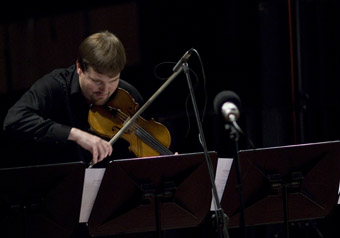
Soloist Graeme Jennings, Elision Ensemble
photo Marc Grimwade
Soloist Graeme Jennings, Elision Ensemble
RICHARD HAYNES MAKES THE E-FLAT CLARINET TALK IN HIS ENCHANTING RENDITION OF MICHAEL FINNISSY’S MARRNGU. IN THE YOLGNU DREAMTIME TRADITION MARRNGU IS THE POSSUM MAN, AND FINNISSY’S WORK IS ABOUT MARRNGU’S STORY, A STORY TOLD IN MUSIC RATHER THAN SPOKEN WORD.
Finnissy’s 1982 composition resembles speech in its lilting, dramatic tones, gathering in intensity and emotion as the story unfolds, the linear phrasing mimicking an emphatic story-teller. Though smaller and higher pitched than the more common B-flat clarinet, the E-flat clarinet has a rich, creamy sound that is particularly evocative in suggesting the human voice. Haynes builds deep, complex character into the music, and his playing of this demanding work is effortless and beguiling.
Elision concerts are like no others—showcases of exquisitely crafted works for solo instruments or small ensembles that push the limits of instrumental performance. This evening was set out as two one-hour concerts, each of five short works written between 1981 and 2009. The selection especially showed how instruments can express the human voice and tell a story.
The first concert opened with Tristram Williams’ solo trumpet performance of Liza Lim’s Wild Winged-One (2007), which Lim reworked from her opera The Navigator. The trumpet represents the Angel of History, which, according to the program notes, is a “half-human half-animal bird figure of prophecy and witness.” Williams creates a language of sound forms, combining breathing through the trumpet with scatty motifs to form a kind of declamatory speech. This was followed by Richard Barrett’s inward (1994-95), a kind of dialogue that opens with gently tinkling percussion (Peter Neville) followed by a long, lyrical exposition for flute (Paula Rae). Again the performer’s own voice is heard through the instrument. The dialogue is ultimately an internal one, a troubled soliloquy culminating in a long, high exclamation.
For Jeroen Speak’s Silk Dialogue VI (2007), scored for string quartet, E-flat clarinet, flute and five snare drums, the six performers are seated in a semi-circle, and between each is a drum they beat periodically to mark each section of the work. These forceful junctures frame the music as a series of discrete, almost visibly geometric shapes, culminating in a drum crescendo as if concluding a story told in exquisite drawings. The E-flat clarinet part leads the work, and Speak’s writing for it is persuasive—it was commissioned by Haynes, who is again brilliant, and, for me, Silk Dialogue VI is the centrepiece of the evening. The writing is finely crafted and the threads are densely woven yet light and airy, creating musical forms that swirl around. The conductor, Hamish McKeich, holds it all together wonderfully.
The first concert concluded with another extended solo work—Roger Ramsgate’s Ausgangspunkte (1981-82), a very intense piece for oboe that requires a herculean effort from the performer, Peter Veale. The work is complex and detailed, requiring almost as much concentration from the listener as from the performer.
The second concert opened with Benjamin Marks’ Perdix (2009) for trumpet and vibraphone, though the latter comes in only towards the end, gently cooling a very heated trumpet solo. The writing is agitated but quizzical, again a kind of soliloquy, but calm is restored at the conclusion. This is followed by Graeme Jennings performance of Liza Lim’s Philtre (1997) for solo Hardanger violin, a more introspective piece that exploits the unique resonances that emerge from the violin’s sympathetic strings.
Richard Barrett’s Wound (2009), for violin, cor anglais, E-flat clarinet and cello, was evidently influenced by the paintings of Francis Bacon in which the action is framed within the canvas. The violinist stands opposite the other performers in animated exchange with them, and, for me, the composition posits the violin as interviewee and the other instruments as inquisitors, or perhaps the violin as a bird and the others as its cage. The human voice proper reappears in Robert Dahm’s absorbing work the flesh is grammar (2009), for a wind and brass septet that includes contraforte, a reed instrument that produces the deepest notes. The text in the work is whispered or spoken by the performers, combining with densely layered instrumental textures to produce a juicily corporeal effect. Your attention shifts back and forth between the compositional structure and the instrumental timbres and resonances, with the personality of each instrument becoming a character in a play.
In many works, the performer complements the composer by developing novel techniques to realise new musical forms and new aesthetics. Elision concerts are precious opportunities for the creation and performance of innovative music by the best composers. They demand virtuosic playing and reward committed listening.
Elision Ensemble in Session, live broadcast, Iwaki Auditorium, ABC Centre, Southbank, Melbourne, July 28
RealTime issue #93 Oct-Nov 2009 pg. 51
© Chris Reid; for permission to reproduce apply to realtime@realtimearts.net
AS PART OF THE LIQUID ARCHITECTURE FESTIVAL’S 10TH ANNIVERSARY, I WAS COMMISSIONED TO TRAVEL ALONGSIDE THE ARTISTS TO EACH OF THE PARTICIPATING CITIES AND WITNESS THE PERFORMANCES, ATTEND FORUMS AND TAKE PART IN INFORMAL DISCUSSIONS, WHILST SHARING MY THOUGHTS ON THE LIQUID ARCHITECTURE BLOG AS A MEANS OF INCREASING THE DIALOGUES BROUGHT ABOUT BY THE EVENT.
This initiative came to be in response to the dissatisfaction of Liquid Architecture organisers and artists with the level of critical feedback generated following past festivals. In touring, I learnt that such critical exchanges exist, but sadly are not often formalised or committed to print.
I saw the entirety of Liquid Architecture and in a new light, as a multifaceted event. I witnessed several very different festivals across Australia, reflecting the collaborative nature that founding director Nat Bates often mentions when discussing Liquid Architecture. It was also clear to me that after 10 years the festival has entered a phase of reflection and self-critique.
The multifaceted nature of the festival raises many questions; on the road with LA10 the vibrancy of sound arts and exploratory music practices in Australia was evident. Tura New Music in Perth, ROOM40 in Brisbane, Alias Frequencies and Plum Industries in Sydney, On Edge and The House of Falcon in Cairns as well as Cajid Media in Central Victoria were co-producers with Liquid Architecture based in Melbourne. They brought their own organisational practices to the hosting of the international artists toured by Liquid Architecture. It should be noted, however, that LA10 was one tier of what these organisations do yearly (often collaboratively, across states). So, beyond providing international artists, what additional role does Liquid Architecture play?
Over the 10 years that Liquid Architecture has grown as a brand, a certain stability and perhaps expectation of an aesthetic and presentation standard has developed. It is safe to say that the festival’s scope is not (and would not claim to be) an accurate account of all exploratory sound practices currently engaged in globally. International performers travelling to the festival tend to be European (and to open an argument that I must start and end here for the sake of brevity) male, and often of certain European avant-garde music traditions that perhaps reflect the tastes of the Melbourne organisers.
It could be argued that the true variety in the festival’s programming is the assortment of local artists. The usual international component of Liquid Architecture is likely to be, as one friend noted in passing, “men with machines.”
So for many it’s disappointing that Liquid Architecture’s palette of performers reflects not so much a survey of international contemporary practice (as perhaps the Melbourne International Biennale of Exploratory Music in 2008 did more successfully) as appearing to be a specialist music organisation supporting a particular tradition.
However, the festival has created greater access to experimental music than other events. This is not true of all the states that Liquid Architecture travels to, but the attendance at this year’s North Melbourne Town Hall concerts proved that 10 years has helped develop an audience that wouldn’t be accommodated at the numerous smaller events occurring constantly in Australian underground music scenes.
At a forum organised by Within Earshot, a collective of RMIT University Fine Art (Sound) students, there was a lively debate surrounding dissatisfactions with the first Town Hall concert. The point was made that for new audiences, the concert did not present a varied program of what is truly taking place in contemporary exploratory music cultures both in Australia and abroad. For first timers, it would have shown merely one (rather Euro-centric) take on the sonic arts. Does this require the festival to be the provider of a perhaps impossible survey? Is it about the festival miscommunicating its motivation? Festival co-founder and director Nat Bates often states in conversation that if the festival causes disagreement amongst patrons leading to them starting their own event, that would be a success. But for LA’s new (and growing) audience, does such a view carry weight? Yes, there are plenty of new events being organised constantly by those who wish to get people thinking about sound. But, LA 10’s satellite events at Horse Bazaar and the Within Earshot for RMIT students did not feel like a considered part of the festival.
The very fact that Liquid Architecture has grown into a major, national event reveals that the exploratory sound cultures of its focus are not as niche as once thought. It was my sense in traveling with the festival that the transition from Liquid Architecture’s point of conception as a vessel for presentational opportunity to its current incarnation, happened too quickly for the festival organisers to keep pace. Certainly, I gathered a sense of dividedness as to what LA10 was trying to deliver. The organisers themselves might be in two (or more minds) about it. The festival’s funding too, does naturally provide expectations about what Liquid Architecture should deliver.
LA’s directors are working hard to consider not simply avenues of improvement but how to solidify Liquid Architecture into a stable, pertinent incubator for a critical exchange on sound arts. There are other opinions about what Liquid Architecture could be, but so long as these thoughts remain word of mouth perhaps we will not witness much change.
Liquid Architecture 10, June 24-July 12, www.liquidarchitecture.org.au
RealTime issue #93 Oct-Nov 2009 pg. 52
© Jared Davis; for permission to reproduce apply to realtime@realtimearts.net
AS CHRIS REID WRITES IN HIS REVIEW OF THE SOUNDSTREAM NEW MUSIC FESTIVAL (P49), SOME MUSIC HAS TO BE SEEN AND NOT JUST HEARD. BRISBANE-BASED TOPOLOGY’S EAST COAST TOUR GAVE US A LIVE, WORKING BAND WITH A CASUALLY THEATRICAL AND JAZZY SPONTANEITY YOU MIGHT NOT BE EXPECTING FROM THEIR NEW CD, BIG DECISIONS, WHICH OFFERS OTHER PLEASURES. SYDNEY’S HALCYON DELIVERED A MORE FORMAL CONCERT WITH AN OPERATIC INTENSITY IN WORKS WITH BIG AMBITIONS AND VISIBLY COMPLEX INTERPLAY BETWEEN PERFORMERS.
Robert Davidson aside, Topology’s musicians are an unassuming bunch onstage, but the bassist’s amiable mc-ing, occasionally miming to the voices of Australian politicians in his Big Decisions: The Whitlam Dismissal (2000) and having the audience chant “We want Gough!” on cue, add fun to the occasion. The concert opened with Bernard Hoey’s Chop Chop which briskly marshalled a big band sound from small forces. After John Babbage’s lyrical tenor sax realisation of a Pat Nixon aria from John Adams’ Nixon in China (from the Topology CD Perpetual Motion Machine), Hoey’s viola improvisation on Davidson’s Exteriors (a response to Southern Indian temple architecture) ranged through meditative warblings to passionate flourishes supported by tabla-ish taps on Davidson’s double bass. Babbage’s witty arrangement of Cold Chisel’s Cheap Wine starts out 50s cool jazz and then proves Topology can rock.
The concert centrepiece, Big Decisions, was at once entertaining and chilling (it never fails to vividly remind me of that fateful November 11th). Other works on the program were not familiar but excited interest: Babbage musing on the genome (X174; 2003); Davidson dextrously exploiting the Australian-American rhythms and twang of an ex-Brisbane Christian fundamentalist, Ken Ham, who’s now big in the USA (Generation after Generation; 2008); and another Davidson work, Round Roads (2008). The latter was triggered by a bicycle ride in Canberra that recalled childhood life there including a bushfire, the music oscillating between sweet reflectiveness, potent piano-bass propulsion and some dramatic sax interpolations.
The Sydney duo, Halcyon (soprano Alison Morgan, mezzo-soprano Jenny Duck-Chong) gather composers, instrumentalists and other singers around them to create distinctive, inventive concert programs. Extreme Nature featured bold new works from expat composers recently returned to Australia, Elliott Gyger and Nicholas Vines.
Gyger’s From the Hungry Waiting country (2006) draws on Australian poems (mostly of an older generation: Harwood, Stow, Riddell, Hart-Smith, Buckley, Hope) and Near Eastern religious texts in response to “a profoundly ethical dimension to the emerging ecological crises” (Gyger, program note). Morgan and Duck-Chong were joined by soprano Belinda Montgomery and mezzo Jo Burton to execute the demanding interweaving and layering of texts, surprising glissandi and humming, buzzing insectile vocal noise. Genevieve Lang’s harp entwined beautifully and at times dramatically (buzzing too and twanging) with the singing, making the instrumental interplay with the four superb voices the highlight of the work. It was fascinating to watch the exchanges between these artists, heightened by the various re-groupings of the singers, with the harpist a logical extension of the line-up rather than as sidelined accompanist.
Save for the final text, AD Hope’s Australia (an odd choice, Gyger admits, but deployed to target political rather than intellectual poverty), making sense of the poems is hard work and best left until a recording is made available. Countering Hope’s bitterness, the work ends moving from an almost staccato rendering of lines that then flow into neat harmonies, with an almost Swingle Singers’ jazziness, and a final, musing lyricism. From the Hungry Waiting Country is a complex, consuming work, at once grim and beautiful.
In their onstage intermission dialogue, Gyger and Vines discussed the relationship of their music to “large masses of text.” There was agreement that their approach is “not directly semantic…not every word will be understood, but the work will be ‘semantic’ from a different direction [as] a lattice of reference, starting with poetry that is already complex.” It was suggested that “words are musical regardless of meaning” and that “the poem is a kind of music.”
Nicholas Vines writes that his Torrid Nature Scene (2008) “is at its core a squelchy, lusty romp” but one intended to counter the technologising of our lives and values. In the dialogue with Gyger, Vines said he thought “lush” was not a word typically associated with Australia, but that he wanted to create “a febrile density” in his work, and so he does. The text, a poem by Andrew Robbie, is already dense with ideas and images, and Vines adds nine instrumentalists to engage with Morgan and Duck-Chong. After the opening Wagnerian flourish we are introduced to a sonic world that is certainly lush, rich in operatic soaring, quackings, glides, post-orgasmic gasps, relished words chewed over, and ringing, starry bursts of voices and ensemble as one. In memorable, intense, sustained passages for one singer, the other counters with an undercurrent of noises evocative of nature and the body’s own musical otherworld. Torrid Nature Scene is almost overwhelmingly dense on a first hearing, but its strange beauties are many (its hyper-literary text best left impressionistic). Extreme Nature was an exhilarating if demanding concert, its cogency in no small part the contribution of conductor Matthew Coorey.
At the 2009 Classical Music Awards, Topology picked up the prize for Outstanding Contribution by an Organisation for its inventive 2008 series of collaborations at the Brisbane Powerhouse. Topology will appear with Taikoz and Karak at the Enmore Theatre, November 27, www.enmoretheatre.com.au.
Topology, Sound Lounge, Seymour Centre, Sydney, Aug 20; Halcyon, Extreme Nature, Verbrughen Hall, Sydney Conservatorium of Music, Aug 7.
RealTime issue #93 Oct-Nov 2009 pg. 52
© Keith Gallasch; for permission to reproduce apply to realtime@realtimearts.net
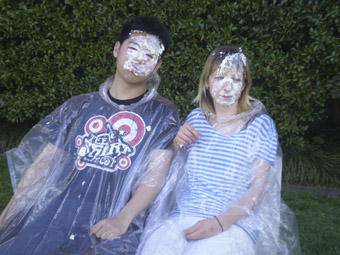
Pie, spat+loogie with Willoh S Weiland
image courtesy and copyright the artist
Pie, spat+loogie with Willoh S Weiland
SINCE ITS INCEPTION IN 1992 PRIMAVERA HAS BECOME ONE OF THE MOST HIGHLY ANTICIPATED SHOWS IN THE MUSEUM OF CONTEMPORARY ART’S YEARLY PROGRAM, OFFERING A SELECTION OF WORKS BY AUSTRALIAN ARTISTS UNDER 35—A PROMISE OF THINGS TO COME. YET WHAT HITS YOU ON ENTERING PRIMAVERA 2009, IS THE GALLERY’S SLIGHTLY DEPRESSING RESEMBLANCE TO AN ART STUDENT STUDIO—THERE IS A CIRCLE OF USED AND ABUSED CHAIRS, PHOTOS STUCK TO THE WALL, FOOD SCRAPS AND A NONDESCRIPT TIMBER CONSTRUCTION.
This held-together-by-masking-tape look is after all a signifier of our visual arts times but it hasn’t until now made much of an impact on the clean-cut Primavera experience. This year, guest curator Jeff Khan has conceived an exhibition that feels different from its predecessors.
Khan, who is known for his artistic direction of Melbourne’s emerging and experimental arts festival Next Wave, scattered around the city from underpasses to art spaces, has (not surprisingly) focused Primavera 2009 on interdisciplinary and expanded practices that engage social connectivity. But selecting artists for a major art institution exhibition who “propose a departure from fixed studio practices and exhibition-focussed styles of art making,” (Jeff Kahn, catalogue essay) can be as problematic as it can be progressive.
One of the highlights of Primavera, the performance project Pie (2009) by collaborative duo spat + loogie (Kat Barron and Lara Thoms) with Willoh S Weiland, serves as a key example. Dressed as waiters on the MCA lawn spat + loogie invite whoever is game to sit with various curators who have been recruited for the task, for one to one 10-minute discussions. The duo offer inspiration by providing a ‘menu’ of accessible and witty topics that invite probing questions into the nature of contemporary art, including “Is skateboarding art if you slow it down?” and “Are these tourists making video art.” Offering participants the opportunity to throw a cream pie in the curator’s face at the conversation’s conclusion, spat + loogie ensure that each pays the price for stuffy art-speak or meaningless waffle.
But blink and you’ll probably miss it. Taking place just five times over the course of Primavera and with only a few tokenistic cream pies and photos in the gallery, Pie raises the wider issue of how performative or ephemeral practices can sustain a satisfactory and much needed presence within the institutional sphere. The beauty of Pie is that it values its participants and engages art goers and random passersby alike, but it makes for a sadly disappointing experience for the majority of Primavera visitors who will simply miss out.
In contrast Christopher LG Hill and Andy Best both explore the social act of art making via collaborative projects that result in substantial gallery exhibits. Hill investigates ideas of value and exchange through collaborations with his art peers that often generate sculptural installations, such as Clique (2009) in Primavera. Clique consists of a democratically arranged ring of modified, almost anthropomorphic chairs interspersed with subtle sculptural assemblages. As if standing in for their makers they reflexively symbolise the collaborative process and open dialogue that created them. A reading bench covered by art publications completes the seating circle, implying that gallery visitors aren’t excluded from the clique but can engage in its ‘exchange’ of information, but with no way to respond this is a purely symbolic, one way system.
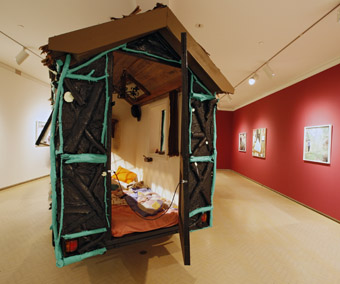
Oom Unit (2009), Andy Best
image courtesy the artist
Oom Unit (2009), Andy Best
Best’s practice revolves around a semi-fictional art community called Oom—a small group of young trendy artists (his friends) who get sloshed and smoke spliffs, make naive paintings that appropriate cult symbolism, play in the woods and sleep in caravans. His installation in Primavera blurs the distinction between documentation and promotion and includes grainy mobile phone photographs, access to the Oom website and, as the centrepiece, the Oom Unit (2009), a small caravan made of logs, housing an unmade bed littered with peppermint tea, sesame snaps and Mentos—think “Tracy Emin quits the London scene to become a gypsy.” It appears that Best and his friends’ exploits and artistic output are products of Oom in two respects—they arise from collaboration and are also part of the Oom ‘brand.’ But as with all branding you have to wonder if there is substance behind the rhetoric, for instance, just how these hippy student clichés provide “genuine alternatives to current conventions”, as the wall text states. I’m left unsure.
The artists’ installations aren’t as compelling as the territory they explore conceptually and performatively. The symbolic ‘aftermath’ of their social connections—Hill’s mismatched chairs and Oom’s cramped sleeping arrangements—are tellingly empty.
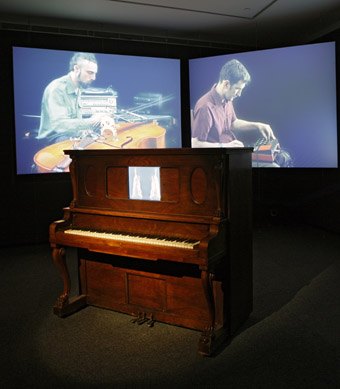
Autonomous Improvisation V.1 (2007), Wade Marynowsky
image courtesy the artist
Autonomous Improvisation V.1 (2007), Wade Marynowsky
Wade Marynowsky and Michaela Gleave offer more satisfying experiences. Avoiding the challenges of non-autonomous art, Marynowsky’s aptly named Autonomous Improvisation V.1 (2007) recasts Sydney’s live performance community into a B-grade horror movie spectacle (RT79,p24). With digital candelabra, warped sound styling and ominous lighting, he improbably combines automated computer technology and 19th century gothic kitsch. Eerily tinkering keys on an automated pianola activate a network of computers that reanimate 37 recorded performances in real time. A red-nosed clown, a didjeridu player, a flamboyantly pink-wigged and otherwise naked hula hoop-er and some seriously absorbed Mac noisicians are just some of the characters who appear in stilted bursts and in randomised sequences across three screens. The result is schizophrenic. As non-linear, surreal narratives emerge, the individual improvisations lose their autonomy, creating an entertaining and provocative metaphor for ‘community.’
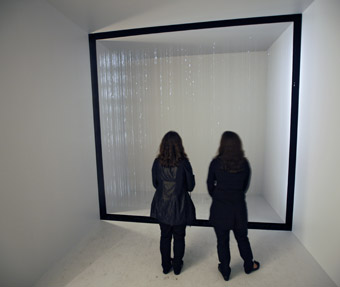
Raining Room (Seeing Stars) (2009), Michaela Gleave
image courtesy the artist
Raining Room (Seeing Stars) (2009), Michaela Gleave
The outer appearance of Michaela Gleave’s Raining Room (Seeing Stars) (2009)—the aforementioned non-descript timber construction—belies the presence of a romantic and bewitching phenomenon that surprises the visitor once inside. There, continually falling, harvested rain drops glisten and flicker like diamonds in the dark. But Gleave engages our senses beyond just sight—the pitter-patter sound evokes a comforting, archetypal memory of hearing rain on the roof. You can touch or walk through the water, while outside the looming cubic construction is imposing and awkward in the gallery space. Made for more than housing a saccharine illusion, the exposed nuts and bolts of the external architecture and visible rain-making apparatus ask us to consider the entrenched infrastructure that distances urban dwellers from a connection with the natural world.
The remaining works in Primavera are comparatively unassuming but reward contemplation. The result of Christine Eid’s research into taxi-drivers in Lebanese-Australian communities combines the languages and methods of both social history and the visual arts. Wall-mounted rearview mirrors and taxi lights bearing drivers’ names verge on the literal, while the accompanying short film Transit (2006), is a sensitive and emotional account of Eid’s father’s experience as a taxi-driver.
Kinetic artist Ross Manning creates everyday automata from playful junk assemblages. Neo-Luddite Pyjama Party (2009) for example, is a mess of tangled wiring, barely balancing fans atop Jenga-like piles of scrap timber and precariously swinging projectors that, via a carefully interconnected system creates an alluring Aurora Australis-like visual effect from refracted and mediated light. Manning’s confusingly complex yet lo-fi constructions wryly invite us to question our reliance on the ‘invisible’ technologies that permeate modern life.
Rather more serious in tone is Western Australian artist Roderick Sprigg’s installation Mechanical Nuisance (2008), an investigation of masculinity within isolated farming communities. Using discarded safety mechanisms from agricultural equipment, Sprigg has constructed a dining table modelled on the one in his family home but that darkly resembles a sort of torture chamber. Together with video projections of himself at work and his grandfather playing the harmonica, Sprigg’s installation sombrely suggests that despite isolating and arduous work, these men feel happier out in the fields than in their own homes.
Jeff Khan’s signature on this show is clear in the strong thematic association between works, playful cross-contamination (between Hill and Gleave’s works) and the somewhat risky inclusion of performative and non-autonomous art forms. The show proposes an exciting new future for Primavera as a platform for dynamic practices—both artistic and curatorial. While overall the work in Primavera 2009 offers less of the wow factor than past shows (recall Soda_Jerk’s epic Astro Black in 2008, or Martin Smith’s achingly honest and delicately defaced photographs in 2007), this community-minded grass-roots Primavera is more of a grower.
Primavera 2009, curator Jeff Khan, artists Andy Best, Christine Eid, Michaela Gleave, Christopher LG Hill, Ross Manning, Wade Marynowsky, Roderick Sprigg, spat+loogie with Willoh S Weiland; MCA, Sydney, Sept 9-Nov 22
RealTime issue #93 Oct-Nov 2009 pg. 53
© Josephine Skinner; for permission to reproduce apply to realtime@realtimearts.net

Wienie Collapse 1965-1983: Bibbidi Bobbidi Boutique, Downtown Disney: “Beautiful prima ballerina dancing in white dress with red light shining from below. Black cloak spread out, about to wrap it around her. She is stepping towards you on the stag
VISITORS TO PRIMAVERA 2008 AT SYDNEY’S MCA MAY RECALL MARCUS CANNING’S PINK WIENIE—A 6 METRE HIGH SILICON CASTLE THAT COLLAPSED UNDER ITS OWN WEIGHT AND BECAME, IN ONE REVIEWER’S WORDS, “A GRANDIOSE POOL OF FAILURE.” FROM THE DEBRIS, REARRANGED, AUGMENTED AND PHOTOGRAPHED, CANNING HAS CREATED WIENIE COLLAPSES, A BODY OF ABSTRACT ‘MEDITATIONS’ ON LATE CAPITALIST CONSUMPTION AND COLLECTIVE CONSCIOUSNESS.
The word ‘wienie’ in Canning’s titles refers less to the ‘immature penis’ or Viennese sausage than to Walt Disney’s term for the iconic castle at Disneyland’s centre. The term is still used by Disney creators to describe the “visual magnet” at the heart of an attraction, and by film crews for the sausage-waving technique that guides stage dogs through a scene. Canning’s luscious inkjet prints mounted on aluminium feature a kaleidoscopic array of forms, complemented by a selection of verbatim Rorschach Test data gathered from Nazi war criminals prior to the Nuremberg trials. These quotations are intrinsic to the works, while the individual titles all reference real Disney castles and their locations, as well as the European architectural follies that inspired them.
Canning’s prints are striking in their lurid spectacle, textural detail and the near-invisible surface on which their folded, wedding-cake richness is overlaid in hot pink, white, and glossy black. The mirrored arrangements seem 3D despite—or perhaps because of—a textural quality as smooth as glass. The wall-mounted Rorschach Test quotes point to a range of interpretive possibilities: “Two gremlins busy with human vertebrae”; “Two pink mice climbing up a tree”; or this one: “Skin of an animal, such as you would see on the floor of a lady’s room. The lady who owned it altered it by adding feathers. Only a lady would do this.”
Nowhere is there a Rorschach quotation to suggest the obvious: Wienie Collapses is easily read as a set of lushly prepared allusions to female genitalia. The lengths gone to to elide this possibility sometimes appear extraordinary, for example: “A funny bear fur spread out…It is alive and represents Bolshevism over-running Europe.”
To create Wienie Collapses, Canning mixed quantities of sump oil, hair gel, sugar and liquid soap into the remains of Pink Wienie to form what he calls “psychotropic landscapes”, which were then photographed and manipulated to create symmetrical configurations. The materials reference some of consumer culture’s most ubiquitous substances; oil and sugar providing potent symbols of what might be termed ‘western decadence.’ The work follows on from Canning’s earlier preoccupations with late capitalism, explored through video, installation and sculpture, such as the creepy Dough Boy video (1999) or Midas (2006), which featured a revolving planet formed from plastic trophy heads.
Conceived as the world economy was going into meltdown, Wienie Collapses explores a literal and theoretical terrain that cleverly weaves the playfully phallic ‘wienie’ into a seductive commentary on excess, folly and material desire. The annotation of the collapsed balloon castle’s photographed detritus with Rorschach quotes draws further associations between consumption, desire and mass psychology, as well as teasing out questions about the meaning and interpretation of art—ultimately another ‘consumer’ product.
Anyone who’s ever seen a vagina at close range will recognise in Canning’s images the clitoral shadows, the tucks and folds, the sense of ragged symmetry and satiny textures. But Canning insists this wasn’t his intention. At most, he acknowledges “the straight-up irony of a glistening pink castle, with all its inherent embodiments of phallic monumentality and mentality across western history, ultimately collapsing into a series of very polymorphic psychotropic works…”
At the same time, “There was definitely an attempt to evoke a sense of a grotesque anatomy, an uncanny body—but a surrogate or artificial body that is corrupted and mutating.” A brave statement, given the historical (and spurious) western binarising of nature–femininity–chaos–corruption versus culture–masculinity–order–reason.
Wienie Collapses fuses a lush array of ideas and a cornucopia of visual intrigue, cleverly critiquing late capitalism’s folly around the anchoring trope of the collapsing wienie. The series certainly fulfils Marcus Canning’s aim of containing “enough teeth, barbs, hooks…to maintain a tension over time, but at the same time fit the profile of a product range…that would hover in a space between attraction and repulsion…”
There’s a juicy irony in this combination of commercial intent and cultural commentary, especially given the central symbol of the must-have ‘wienie.’ Arisen from the detritus, Wienie Collapses is not so much “a lobster pie with decorations” or “a substance taken out of an operated knee”, as a flamboyant, laughing phoenix.
Marcus Canning, Wienie Collapses, Goddard de Fiddes Gallery, West Perth, Aug 7-28
RealTime issue #93 Oct-Nov 2009 pg. 54
© Urszula Dawkins; for permission to reproduce apply to realtime@realtimearts.net
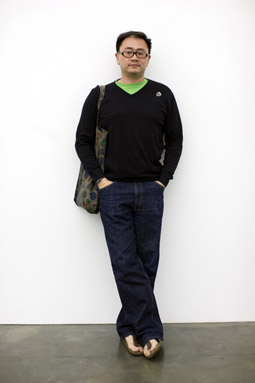
Emil Goh
photo courtesy Jason G Lewis
Emil Goh
THE SAD NEWS ARRIVED AT THE REALTIME OFFICE IN LATE SEPTEMBER OF THE SUDDEN DEATH OF THE TALENTED AND GREGARIOUS NEW MEDIA ARTIST EMIL GOH IN SEOUL.
Born in Malaysia, Emil graduated from the University of Newcastle and went on to study Photography and Sculpture at Sydney College of the Arts and in the late 90s earned his Master of Fine Arts at Goldsmith College, University of London. For many years, he moved between the big cities of Asia, Australia and Europe. We ran into him last year in Sydney’s Chinatown at an opening at Gallery 4A (Asian Australian Artists Association) of which he was a founding member.
After London, Emil spent time in Hong Kong and in 2003 was awarded an Asialink residency to Seoul, a city he came to love and where he eventually settled. Of late, he’d exhibited widely, taught art and design at a number of Korean arts institutions and was working on a range of art and design projects, among them design-it-yourself meditation pods.
An artist obsessed with ephemerality and the everyday, Emil’s output was substantial. In 2005 he showed at the Jakarta International Video Festival and in Seoul: Until Now in Copenhagen. His work was included in Mix-Ed at Sherman Galleries, 2004, in Location Location, at the Australia Centre for Photography, Sydney, 2003, and in 2004 he participated in the Busan Biennale at the Busan Metropolitan Art Museum. Emil had residencies at London’s Hayward Gallery, Hong Kong University, the Chinese Arts Centre in Manchester and SSamzie Space, Seoul.
We recall with pleasure Emil’s work, Between, at the old Performance Space in Redfern. Displaying his customary intimacy and lightness of touch, it comprised 360º video panoramas he had made by perching his rotating miniDV camera on window sills to reveal a 180º view of the inside of a familiar room in two different cities and the view outside. At the time he described the impetus for the work thus: “My entire childhood was spent moving all over Malaysia when my father was transferred for work. It was kinda fun growing up in so many different houses. As a result, I’ve been fascinated how people live ever since.”
This fascination extended to online lives in Emil’s MyCy series made in Korea, the city that became the focus for his work. “What makes MyCy so interesting is the miniroom, one of the main features of a Cyworld Minihompy (homepage). It’s a blank room a user can decorate so in essence it becomes their online ‘living room” or any other type of space they desire. On the surface, it seems trivial, but it’s a reflection of life in Seoul as a young person. Most live with their parents till they get married and the home in general is exclusively for the family, not a place for socializing. So the miniroom is the public manifestation of one’s perfect ‘private’ space. Hence my fascination for domestic living situations has extended to their online versions and the pairing allows me to explore both landscapes.”
Seoul, it seems, was a city made for Emil with its super high speed broadband and where, he wrote, “updating your Minihompy everyday is de rigueur…Korea is a very young and evolving economy. Highly developed parts of the city were rice fields 25 years ago. The city is changing very fast, and observing the adaptations and the process of transition are at the core of my work/research. I guess you could say I am doing a kind of study in the manner of a documentary project.”
His documentation took him on some winding paths, gathering friends and colleagues along the way. One of these says: “He was collecting pictures of the city. According to his latest report he had over 49,000 in his hard-drive. He could spend days riding his GPS-enhanced bike while taking shots of buildings, people or just different types of kimchi. I swear I saw him photographing every single dish we ordered at restaurants. He collected all sorts of mobile phones just for the pleasure of understanding how they work. He even got an iPhone when it was not possible to use it in Korea just to play around with the UI.” http://arduino.cc/blog/?p=333
Fittingly, the record of Emil Goh’s considerable artistic achievement is well archived at http://www.vwfa.net. A prolific poster, it’s wonderful as well to read and see on the net the myriad manifestations of this remarkable artist in his own words and images and those of the many others whose lives he touched. Keith & Virginia
RealTime issue #93 Oct-Nov 2009 pg. 54
© Keith Gallasch & Virginia Baxter; for permission to reproduce apply to realtime@realtimearts.net
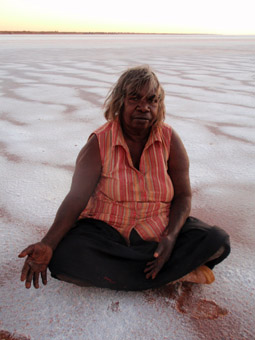
Yuwali on location
courtesy Contact Films
Yuwali on location
SINCE FIRST APPEARING ON THE ABC’S RACE AROUND THE WORLD SERIES IN 1997 (THAT ALSO THREW UP THE GREAT SATIRIST JOHN SAFRAN), BENTLEY DEAN, USUALLY IN COLLABORATION WITH ANOTHER DIRECTOR, HAS MADE A SLATE OF UNFLINCHING DOCUMENTARIES FOCUSING ON SOCIAL JUSTICE ISSUES AROUND THE GLOBE.
In 2001 he began working for SBS’s Dateline and became captivated by South America (directing Anatomy of a Coup in Venezuela and The Siege in Peru) before turning his lens back to Australian issues with the AFI Award-winning The President Versus David Hicks and, one of my favourite documentaries of recent years, A Well Founded Fear, which follows a number of refugees who, rejected by the Australian government, are forced to return to their home countries, often under threat of violence or possible death.
Dean’s latest film, Contact, with co-director Martin Butler, is the story of an Aboriginal woman Yuwali and her Martu tribe of 20 women and children, the last remaining clan living in the isolated Percival Lakes, who in 1964 are ‘discovered’ when they come into contact with white men for the first time.
These “white devils”, as Yuwali calls them, are getting ready to launch a rocket from Woomera and plan to use the Martu land as a “dump area” for crash debris, believing it to be uninhabited (terra nullius, yet again). Terry Long and Walter Macdougall, native welfare patrol officers, were appointed to scour the deserts, looking for any signs of life, armed with cameras. Long says, “We didn’t expect to find anyone out there”, but they soon discover middens and traces of fires and the search is on. The directors have been busy in the ABC archives unearthing amazing footage: the women’s first shy and fearful approach is captured on film (and in photographs); but there are also also preparations for the rocket launch—enormous wide load shipping containers carried on trucks through small country towns and into the bush.
Dean beautifully evokes the stark contrast between a civilisation excited by technological advancement, building and launching satellites into space, where nothing stops for progress, and a community that still hunts and gathers, using dingoes as guides, living ‘entirely off the land.’ Yuwali, seeing cars for the first time, thinks that “big rocks have come alive”, rolling around her camp. When the men arrive at night, the women think they are being chased by monsters (the cars’ headlights scary eyes) and they disappear silently into the landscape, beginning a game of cat and mouse where, intriguingly, the white men become the trackers, searching for clues, following footprints. The women call on the spirits to send in torrential rain, which arrives the next day, washing away their tracks. The officers are forced to hire two Aboriginal men who speak local language (and can move quicker than a bogged truck) to find the women and convince them to leave the desert. Long is a candid subject who admits, “the political scene was quite beyond us” and the rocket launch eventually goes ahead, with the women and children still caught in the desert, huddled terrified watching a fireball in the sky, their ankles roped so they can’t run away.
What’s refreshing about Dean’s documentary is that it’s told from the dominant perspective of an Aboriginal woman. Yuwali was 17 when the first contact was made and is now a feisty 62 with a startling recall for detail. Usually, when we’re told of the first landings of settlers in Australian history, it’s the Aboriginal perspective that’s often missing or sidelined, difficult to trace. Here we have the unique opportunity to hear what Aboriginal women thought first-hand when they encountered whites invading their territory (“A monster is coming. Run, run!”). Yuwali describes the men as “cannibal beings”; she’s terrified they’ve come to eat her. We also get a strong sense of what the land—the “big serpent place” with its Dreamtime stories—means to the Martu women, and Dean’s sublime cinematography translates the beauty of this majestic and quiet place (a fresh water spring in the middle of a salt lake), in contrast to the white men’s vision—a place for dumping waste.
Dean also jumps at the chance to subvert the original ethnographic-style footage—traditionally used to subjugate and classify Aboriginal people—so it becomes instead a tool for empowerment. The women re-enact the story in situ, voicing their memories while hiding in bulrushes, or walking through the desert, and by the documentary’s end, the footage is replaying on an outdoors screen as the women sit around a campfire watching with their families. They have earlier laughed to see themselves so culturally removed from where they are today: “We’d be too embarrassed not wearing clothes…without a hairbelt…Even then she had a big bum.”
But there are always reminders of what has been lost. The wrenching shots of the women and children (the youngest six months) being carted away from their land—”no men to protect us”—into the back of trucks and arriving naked and frightened in Jigalong Mission, 200 kilometres away, are shattering. They’re told, “Don’t even think about going back.” But in this documentary, at least, they are able to return for a while, to where they “left their hearts back in country”, to reclaim their Western Desert land, a sense of shared history and spiritual stories.
Contact was co-winner (with Safina Uberoi’s A Good Man) of the inaugural Australian Documentary Prize at the 2009 Sydney Film Festival, winner Best Direction of a Documentary, Australian Directors’ Guild Awards and has been selected for the International Documentary Film Festival Amsterdam.
Contact, directors Martin Butler, Bentley Dean, producer Martin Butler, cinematographer Bentley Dean, editor Tania Nehme, music Antony Partos; 78 minutes; distributor Contact Films Pty Ltd. ABC Content Sales: www.abc.net.au/abccontentsales
RealTime issue #93 Oct-Nov 2009 pg. web
© Kirsten Krauth; for permission to reproduce apply to realtime@realtimearts.net
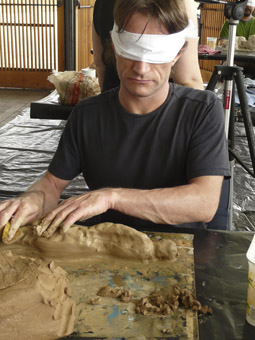
Jonathan Duckworth, from Thinking Through the Body, Bundanon Trust, Bundanon
photo Catherine Truman
Jonathan Duckworth, from Thinking Through the Body, Bundanon Trust, Bundanon
Every now and then an image, a theme or an issue materialises as an edition of RealTime takes shape, spookily permeating its pages. Everywhere in RealTime 93 it’s the body: shrinkwrapped (Shrink, cover), mimicking (Chuncheon International Mime Festival), apocalyptic (Black Marrow), ecstatic (Miracle), regional (On Edge), indigenous/cosmopolitan (Burning Daylight), reversing (Hye Yeon Nam), participatory (Tank Man Tango), punk (We’re Living on Dog Food), doubled (Geminoid Hl-1), superhuman, and as performance engine (Run), music (Soundstream) and land (Garma). Neither fetishistic nor narcissistic, these explorations (Thinking Through the Body) and performative states of being are indicators of art as lived in the body, locally, globally and interculturally.
RealTime issue #93 Oct-Nov 2009 pg. 1
© RealTime ; for permission to reproduce apply to realtime@realtimearts.net

Autonomous Improvisation V.1
Wade Marynowsky
Autonomous Improvisation V.1
Since its inception in 1992 Primavera has become one of the most highly anticipated shows in the Museum of Contemporary Art’s yearly program, offering a selection of works by Australian artists under 35—a promise of thing to come. This year guest curator Jeff Khan, known for his artistic direction of Melbourne’s emerging and experimental arts festival Next Wave, scattered around the city from underpasses to art spaces, has (not surprisingly) focused on interdisciplinary and expanded practices that engage social connectivity.
But selecting artists for a major art institution exhibition who “propose a departure from fixed studio practices and exhibition-focussed styles of art making” (Jeff Khan, catalogue essay) can be as problematic as it can be progressive.
One of the highlights of Primavera, the performance project Pie (2009), by collaborative duo spat + loogie (Kat Barron and Lara Thoms) with Willoh S Weiland, serves as a key example. Dressed as waiters on the MCA lawn spat + loogie invite whoever is game to sit with various curators who have been recruited for the task, for one to one 10-minute discussions. The duo offer inspiration by providing a ‘menu’ of accessible and witty topics that invite probing questions around the nature of contemporary art, including “Is skateboarding art if you slow it down?” and “Are these tourists making video art?” Offering participants the opportunity to throw a cream pie in the curator’s face at the conversation’s conclusion, spat + loogie ensure that each pays the price for stuffy art-speak or meaningless waffle.
But blink and you’ll probably miss it. Taking place just five times over the course of Primavera and with only a few tokenistic cream pies and some photographs in the gallery, Pie raises the wider issue of how performative or ephemeral practices can sustain a satisfactory and much needed presence within the institutional sphere. The beauty of Pie is that it values its participants and engages art goers and random passersby alike, but it’s disappointing that the majority of Primavera visitors will simply miss out.
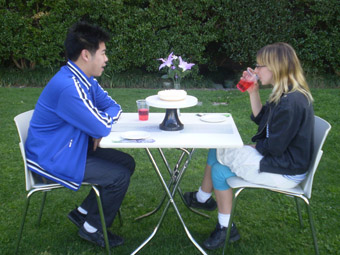
Pie, Primavera 2009, MCA
spat + loogie
Pie, Primavera 2009, MCA
In contrast Christopher LG Hill and Andy Best both explore the social act of art making via collaborative projects that result in substantial gallery exhibits. Hill investigates ideas of value and exchange through collaborations with his art peers that often generate sculptural installations, such as Clique (2009) in Primavera. Clique consists of a democratically arranged ring of modified, almost anthropomorphic chairs interspersed with subtle sculptural assemblages. As if standing in for their makers they reflexively symbolise the collaborative process and open dialogue that created them, while Best’s practice revolves around the documentation and promotion of a semi-fictional art community called Oom—a small group of young trendy artists (his friends) who get sloshed and smoke spliffs, make naive paintings that appropriate cult symbolism, play in the woods and sleep in caravans. His installation in Primavera includes grainy mobile phone photographs, access to the Oom website and, as the centrepiece, the Oom Unit (2009), a small caravan made of logs, housing an unmade bed littered with peppermint tea and sesame snaps—think “Tracy Emin quits the London scene to become a gypsy.” However, the artists’ installations, symbolising the ‘aftermath’ of their social connections, aren’t as compelling as the territory they explore conceptually and performatively.
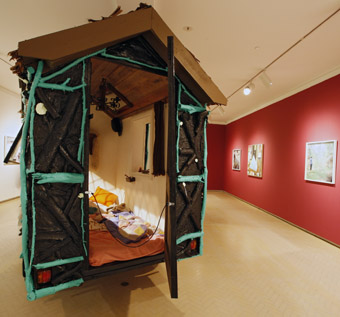
Oom Unit, Primavera 2009, MCA
Andy Best
Oom Unit, Primavera 2009, MCA
Wade Marynowsky and Michaela Gleave offer more satisfying experiences. Marynowsky’s Autonomous Improvisation V.1 (2007), re-casts Sydney’s performance art community into a B-grade horror movie spectacle. With digital candelabra, warped sound styling and ominous lighting, he improbably combines automated computer technology and 19th century gothic kitsch. As individual improvisations appear in stilted bursts and in randomised sequencing across three screens, surreal narratives emerge that create an entertaining and provocative metaphor for ‘community.’
The outer appearance of Michaela Gleave’s Raining Room (Seeing Stars) (2009) belies the presence of a romantic and bewitching phenomenon that surprises you once inside. There, continually falling, harvested rain drops glisten and flicker like diamonds in the dark. But beyond simply housing a saccharine illusion the exposed nuts and bolts of the external architecture and visible rain-making apparatus ask us to consider the entrenched infrastructure that distances urban dwellers from a connection with the natural world.
The remaining works in Primavera are comparatively unassuming but reward contemplation. The result of Christine Eid’s research into taxi-drivers in Lebanese-Australian communities is wall mounted rear view mirrors and taxi lights bearing drivers’ names. While this verges on the literal, the accompanying short film, Transit (2006), is a sensitive and emotional account of the experiences of the artist’s father as a cab-driver.
Kinetic artist Ross Manning creates everyday automata from playful junk assemblages that produce alluring and colourful visual effects from refracted and mediated light. His confusingly complex yet lo-fi constructions wryly invite us to question our reliance on the ‘invisible’ technologies that permeate modern life.
Rather more serious in tone is West Australian artist Roderick Sprigg’s installation Mechanical Nuisance (2008), an investigation of masculinity within isolated farming communities. Using discarded safety mechanisms from agricultural equipment, Sprigg has constructed a dining table that darkly resembles a sort of torture chamber. Together with video projections of himself and his grandfather at work, Sprigg’s installation sombrely suggests that despite isolating and arduous work, these men feel happier out in the fields than in their own homes.
Jeff Khan’s signature on this show is clear in the strong thematic association between works, playful cross-contamination (between Hill and Gleave) and the somewhat risky inclusion of performative and non-autonomous art forms. The show proposes an exciting new future for Primavera as a platform for dynamic practices—both artistic and curatorial. While overall the work in Primavera 2009 offers less of the wow factor than past shows, this community-minded grass-roots Primavera is more of a grower.
A longer version of this review will appear in RealTime 93.
Andy Best, Christine Eid, Michaela Gleave, Christopher LG Hill, Ross Manning, Wade Marynowsky, Roderick Sprigg, spat+loogie with Willoh S Weiland, Primavera 2009, curator Jeff Khan, MCA, Sydney, September 9-November 22
Images are courtesy the artists and the MCA
RealTime issue #92 Aug-Sept 2009 pg.
© Josephine Skinner; for permission to reproduce apply to realtime@realtimearts.net
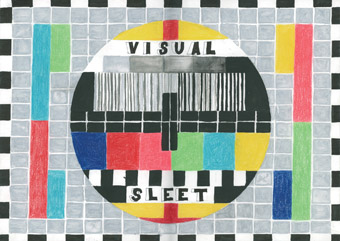
Elvis Richardson, still from TELEVISUALS: SALUTE ELVIS
image courtesy the artist & Hugo Michell Gallery
Elvis Richardson, still from TELEVISUALS: SALUTE ELVIS
At Fremantle Arts Centre, Come Hither Noise invited multi-sensory reactions with sound, video and visual art from eight Australian and international artists, as part of the Totally Huge New Music Festival. Aimed at creating aural, visual and spatial juxtapositions, Come Hither Noise encompassed music, new media, installation and a range of 2D and 3D forms.
Mark Brown’s Detritical SFPS deployed giant, antique fire extinguishers salvaged from the old South Fremantle Power Station, complemented by a speaker issuing distorted instructions for their operation and a screen displaying monochrome footage from the derelict site. The extinguishers, resonating to a tone set by Brown, sang like hot water pipes while flakes of old paint danced on the distorting speaker. Brown is interested in sites of decay and ruin, and his “spatial-sonic atmosphere” suggested the monumental qualities of the defunct building. The occasional intrusion of mysterious piano tinklings—actually emanating from a different work in the same room—inadvertently hinted at nostalgia and drew attention to the musicality of Brown’s sounds.
Sound crossover was sometimes problematic, and most so for Sriwhana Spong: the afore-mentioned piano sounds formed part of Spong’s The Birds, an experimental collaboration in which a photograph inspired a 21-second music piece by Godfrey de Grut, in turn inspiring a collage by Simon Oosterdijk and Kelvin Soh. Here, the three elements seemed not so much to cohere as to be linked by theme and process.
Playful, cohesive and illuminating, Ross Manning’s two works gave differing insights into relationships between sound and movement. In Dissonant Rhythm a length of plastic clothes-line strung between electric fan motors was set into spinning motion by viewer movement. The resulting standing wave patterns struck intermittently at sets of PVC-coated wire prongs, mounted like improvised, giant kalimbas on the wall. Chaotic by comparison, his Alpha Waves was a fascinating jumble of cables, sensors, cardboard vanes, gaffer tape and fans that created moving, pulsing relationships tied to a phasing bass drone.
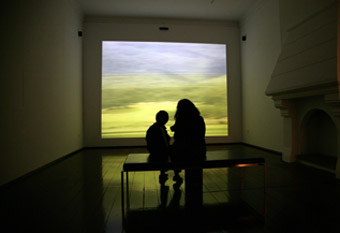
John Conomos, still from Lake George (After Mark Rothko)
image courtesy the artist & Roslyn Oxley Gallery
John Conomos, still from Lake George (After Mark Rothko)
John Conomos’ Lake George (after Mark Rothko) was one of a number of works that suggested the resonance of sound and sight in the landscape. Featuring a slowed-down soundtrack of moving vehicles, wind and water, the slow-panning video of Canberra’s Lake George was a shifting blur of colours, resembling a Rothko canvas. A “tribute to the long take”, it evoked an eerie, mysterious landscape, and the soundtrack made passing cars and trains integral to, rather than imposed on, this coloured, moving world.
Inspired both by obsolete and new technologies, Elvis Richardson’s hand-drawn animations and ‘copyright free’ soundtrack combined in a small-screen exploration of the old-fashioned TV test pattern, TELEVISUALS: SALUTE ELVIS. Richardson’s work was mesmerising in the way that bad ads are. Over the changing coloured squares and lines, pointed anagrams of the work’s title popped up—VISUAL SLEET, STEAL US LIVE, IT VALUELESS and many others. It was worth tolerating the collaged, Looney-Toons-meets-talkback soundtrack in order to see what clever word play would appear next.
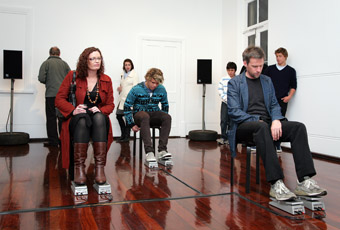
Thomas Meadowcroft, Monaro Eden
image courtesy the artist
Thomas Meadowcroft, Monaro Eden
Berlin-based Thomas Meadowcroft’s soundscape Monaro Eden consisted of recordings from both inside and outside a V2 Monaro engine. The subtle, surround-sound work generated a sense of the car’s hum through a landscape as well as its internal rhythm. Somewhere amid tonal variations and harmonics—which visitors adjusted using foot pedals—strains of violin seemed to impinge. Whether this was part of the work is unclear, but certainly the MGM fanfare belonged to the adjacent TELEVISUALS, not Meadowcroft’s homage to Holden’s classic car.
For the four-minute video, Twist, Sam Smith combined sampled filmed landscapes with a wistful soundtrack, more musical accompaniment than aural plane. Tins of ‘green screen’ paint revolved like cheap-advert invitations or alien spaceships. The work playfully deconstructed the artifice of screen technologies, but the mood was less of parody than melancholy; its deliberate clunkiness seeming to reinforce a poignant lament for lost technological innocence.
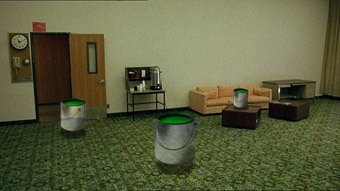
Sam Smith, Twist
image courtesy the artist
Sam Smith, Twist
An archival hospital image and wall-mounted statement stood in for Richard Crow’s Imaginary Hospital Radio, available online at ABC Classic FM, in which synthesised crackles and rumbles morph into cheery birds, soft voices and weird machine sounds. Footsteps, clicks and rattles evoke trolleys rumbling down long corridors; the changing arrays of precise, analogue sounds subverting the notion of ‘hospital radio’ designed to keep patients ‘happy’.
The works of Come Hither Noise, diverse in approach and impetus, together provided a substantial survey of current sound/visual art from Australia and beyond. Subtle linkages became apparent: the landscapes evoked by Conomos, Meadowcroft, Smith and arguably Brown; the music-like elements from Smith, Spong, Crow and Manning. More than a listening exercise, the exhibition combined subtlety and playfulness, displaying a unifying concern with aesthetic balance over dissonance. It also issued an invitation to think, integrating sound firmly into the ‘art’ experience and engaging the intellect through the under-used medium of the ears.
Come Hither Noise—an exhibition of sound works, artists Mark Brown (Aus), John Conomos (Aus), Richard Crow (UK), Ross Manning (Aus), Thomas Meadowcroft (Aus/Germany), Elvis Richardson (Aus), Sam Smith (Aus), Sriwhana Spong (New Zealand), curator Jasmin Stephens, Fremantle Arts Centre, Fremantle, Aug 1-Sept 20
RealTime issue #92 Aug-Sept 2009 pg.

John Kilduff, Let’s Paint TV
photo courtesy of the artists
John Kilduff, Let’s Paint TV
electrofringe 2009
Now up to its 12th incarnation, the recently announced program for Electrofringe 2009 leaves no doubt that its agenda to celebrate the emergent and extraordinary within the media arts landscape remains firm. There are over 55 events including artist and project presentations, panels, screenings, gigs and exhibitions. Highlights are many, including Temp° Sauna, a mobile DIY sauna built in Civic Park by Mika Meskanen (Finland); the collaborative multimedia mayhem of John Kilduff’s Let’s Paint TV (US); large scale projections over Newcastle’s cityscape by Suburban Giants; and an attempt to soundproof the city by Lauren Brown. The gigs are particularly varied, ranging from the Kontakte, a concert by Ensemble Offspring with Pimmon at the Newcastle Conservatorium, to the usual rowdy TINA Showcases at the Cambridge Hotel, to Quiet Appreciation sessions at Renew Newcastle Church.
What distinguishes Electrofringe most is its emphasis on skills development and this year you can learn how to create your own virtual world through OpenSim with Andrew Burrell; make plastic sing with Guillaume Potard; explore telepresence with S.W.A.M.P (US); and hack your mobile phone with Christian Haines (US). There’s also a plentiful supply of panel discussions, with several focusing on tactics for survival for endangered media artists. And if that’s not enough, Ben Denham may actually be able to convince you to fly! But there’s even more—Electrofringe is but one of five festivals in that magnificent monster, the This Is Not Art Festival, which will be celebrating its 10th birthday.
Electrofringe & This Is Not Art, Oct 1-5, Newcastle, NSW http://www.electrofringe.net http://www.thisisnotart.org/
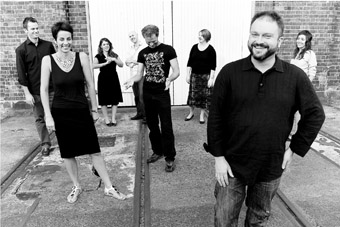
Ensemble Offspring, Electrofringe 2009
photo courtesy of the artists
Ensemble Offspring, Electrofringe 2009
wayfarer v 2: urban agents, melbourne
Media artist Kate Richards and performer Martyn Coutts are taking their locative, multiplayer media game, Wayfarer, to Melbourne after successfully premiering version 1 for Performance Space at Sydney’s CarriageWorks (http://www.realtimearts.net/article/issue81/8720). Version 1 was played by audiences tracking and directing a group of performers. In version 2, this time on the streets, the audience who sign on become the performers.
In the artists’ words, “teams of urban agents armed with mobile phones…will create and enact socially responsible experiences—large or small, planned or improvised including art projects, urban renewal, improvisation and drifting, liminal explorations, parkour and skate, gifting, green living/carbon neutrality/light footprint, flash mobs—anyway and anywhere they want to engage ethically and positively in the city. Videos of the experiences are steamed from players’ mobile phones directly to the Wayfarer website. Here web visitors, futurists and expert commentators in the field of social media will view, discuss and vote on the videos and drive a broader discussion about social responsibility.”
For information and to register to play, go to www.wayfarer.net.au or info@wayfarer.net.au; Arts Centre, Melbourne, Oct 26-31, Nov 2-7
andante workshop, melbourne
Tashmadada, Open Channel and ACAPTA are inviting physical theatre practitioners, actors, dancers, circus performers, production personnel, riggers, multi-media artists, musicians and costume and set designers to Andante, a 10-day workshop with Younes Bachir, actor and collaborator with the Spanish performance company La Fura dels Baus. The workshop will culminate in a public performance. “Younes will expose the participating artists to his personal experience with Furas dels Baus of the different dramatic, plastic and spatial skills involved in the realization of their performances.” In his 15 years with the company he has participated in developing a performance language, Furan, “based in the synergy between disciplines and the coexistence of different techniques and perspectives to theatre.”
Andante, Open Channel Shed 4, Docklands, Melbourne, Nov 4-14;
For more information contact Deborah:info@tashmadada.com; or Gail: gailkelly@acapta.net
lynette wallworth: connected by light, ABC TV
A documentary on an Australian new media artist is a rarity indeed, so it’s heartening to see that ABC TV will be screening Connected by Light. The film documents the artist’s career and creations with a focus on her exhibition, Duality of Light, at Adelaide’s Samstag Museum early in 2009 as part of the Adelaide Film Festival and scheduled for the 2010 Sydney Festival. ABC1, Sept 22; ABC2, Nov1,10pm
rong rong and chinese photography
If you were intrigued by Dan Edwards’ account of the first major photographic gallery in China in RealTime 92 (http://www.realtimearts.net/article/issue92/9512), you’ll want to read the full interview with Rong Rong, co-director of Beijing’s Three Shadows Photography Art Centre. (http://www.realtimearts.net/article/issue92/9557).
lucas abela: the interview
In RealTime 92, Gail Priest and Dan Edwards reported on Lucas Abela’s visit to China where he toured with his first band, a collaboration with Chinese artists. In the interview with Priest (http://www.realtimearts.net/article/issue92/9556), Abela elaborates on his Asialink residency and where it will take his work in Australia.
RealTime issue #92 Aug-Sept 2009 pg.
© RealTime ; for permission to reproduce apply to realtime@realtimearts.net
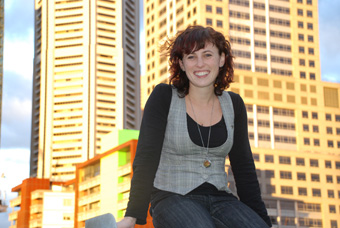
Emily Sexton
Emily Sexton, the Melbourne Fringe’s Creative Producer, recently introduced me to highlights of the 315 programmed shows, emphasising the festival’s local character (80% of the acts are Melbourne-based); the year-round evolution of each program; and the pro-development approach to nurturing artists. It’s a rational model for improving the roulette spin that comprises the fringe festival experience for brave audiences.
Selected groups, mastering the art of self-producing on the run, are offered free rehearsal space and 20 hours each of mentoring from leading artists and programmers like choreographer Lucy Guerin, Melbourne International Arts Festival director Brett Sheehy and Rawcus’ artistic director Kate Sulan. The realisation of the mentoring program is aided by The Arts Centre’s Full Tilt program.
Independent artists frequently work against great odds, so any help is bound to lift the calibre of their work and, in turn, benefit the festival. As well, a sense of community is built across the year, says Sexton, through forums on touring and producing and informal Friday afternoon chats, palpably reducing the sense of working in isolation.
From the list of artists and companies Sexton and I discussed, and some she enthusiastically filled me in on, like bettybooke, I made a shortlist of shows that looked attractive, if more for their form than alleged content (never a good guide), or from names I recognised from the ranks of newly emerging talent.
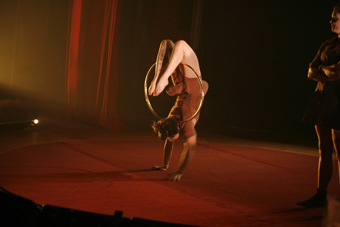
Jess Love, And The Little One Said
photo © the artist
Jess Love, And The Little One Said
Established performers include scary funsters, the Snuff Puppets, who will present their “cabaret club gone mad” show, Snuff Club, and circus provocateurs The Candy Butchers premiering a new solo work, titled And the little one said. Also in the physical theatre realm, Skye Gelman (of Scattered Tacks fame, http://www.realtimearts.net/article/issue90/9431) will premiere Asleep in a Secret: “Poetically stuttered personal stories about the reality of living in a storage cupboard…Anti-theatrical circus and abstract slide projection.”
It’s intriguing to see a Live Art category in the program—the open-ended ‘form’ is spreading. Here it includes the idiosyncratic bettybooke, an ensemble who alternate between making theatre works and “[e]xploring ways to allow audience members to find a point of relaxed engagement, involvement and activity in the imaginal and real worlds unfolding before them” (http://www.bettybooke.com). In the 2009 Fringe they’ll work with pedestrians, mobile phones and iPods. Elsewhere inventive writer-performer Willoh S Weiland will curate The Mapping Room, “an evolving installation” incorporating live art, SMS, drawing, video “and a lecture series to explore notions of scale and temporality.”
In Letters to Isaac, “multi-platformed neo-troubadour Roxby Greenstone” will present “a melodrama told in 18 short letters delivered via text, radio and online.” In a performance-installation mix, Sydney’s Tiger Two Times will welcome audiences into the self-contained “fake nature” of the urban world before letting the “outside” in.
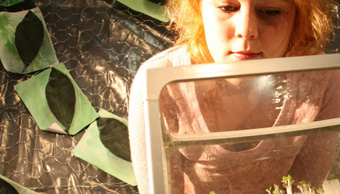
Tiger Two Times, Nature League
photo © the artists
Tiger Two Times, Nature League
The performance program includes A Bit of Argy Bargy, comprising two contributions from leading young playwright Tom Holloway. First he’s part of a team who’ve developed an unlikely vaudevillian approach to a demanding subject in The Suicide Show. He’s also written And no More Shall We Part, about a 30-year old marriage, to be performed by Dennis Moore and Margaret Mills and directed by Martin White. In Attract/Repel, Ming-Zhu Hii and the Melbourne Town Players will address race and identity, ‘them and us’, while Elbow Room (also appearing in the Brisbane Festival’s Under the Radar with their award-winning There) present a new work titled a tiny chorus. Renowned for their re-workings of classic plays, Hayloft will premiere something quite different, Yuri Wells, an intimate solo performance about “an aged care nurse living in solitude.” Hmm.
Doubtless these performances will, in varying degrees, provide welcome antidotes comics and cabarets, while the live art works will lead audiences into newly foreign territory where anything can be performative, including themselves. Russian roulette?
2009 Melbourne Fringe Festival, Sept 23-Oct 11
http://www.melbournefringe.com.au
RealTime issue #92 Aug-Sept 2009 pg.
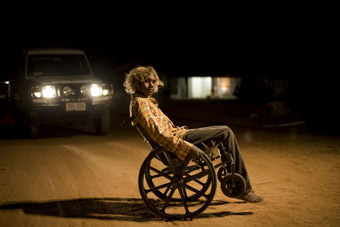
Rowan McNamara as Samson, in Samson and Delilah
photo by Mark Rogers
Rowan McNamara as Samson, in Samson and Delilah
[This introduction was originally written in 2009 with some minor updates in 2012. Links will continue to be added to the list below. Eds.]
Thanks to an abundance of talent, inspired Aboriginal leadership and responsive film schools and government funding bodies, Australian Indigenous filmmaking has grown from of a handful of early works in the 1980s into a steady output of award winning short dramas and documentaries from the 1990s to the present.
Individual filmmakers have been aided in successive stages of their careers by the Indigenous Branch of the Australian Film Commission (now Screen Australia) with advice, workshops, funding and the regular release and marketing of clusters of short films, the Drama Initiative Series. More than a few filmmakers have gained experience and inspiration working with CAAMA Productions (Central Australian Aboriginal Media Association) in Alice Springs, one of several Aboriginal-led media organisations.
Sydney’s Metro Screen and FTI (Film and Television Institute, Fremantle, Western Australia) have, over many years, triggered filmmaking careers through training and mentoring. FTI, with the ABC, has produced several collections in their Deadly Yarns series of short films. State film bodies have contributed funds towards the making of numerous Indigenous films, while the Adelaide Film Festival invested in the making of Samson and Delilah.
Tracey Moffat (Bedevil, 1993), Rachel Perkins (Radiance, 1992) and Ivan Sen (Beneath Clouds, 2002) made their acclaimed feature films across almost a decade; these few were precursors to what now seems likely to be a wave of features, four premiering in 2009 alone—Warwick Thornton’s Samson and Delilah, Richard J Frankland’s Stone Bros and Rachel Perkins’ Bran Nu Dae and Ivan Sen’s Dreamland. 2011 saw the release of Beck Cole’s first feature film Here I Am premiering at the Adelaide Film Festival (which also featured Stop(the)Gap, an exhibition of international Indigenous art in motion) and also Ivan Sen’s Toomelah.
Not every filmmaker aspires to make narrative feature films: many will continue to focus on creating finely crafted, idiosyncratic short dramas and documentaries, and a small, but significant number, are now involved in exploring the potential of animation and digital media.
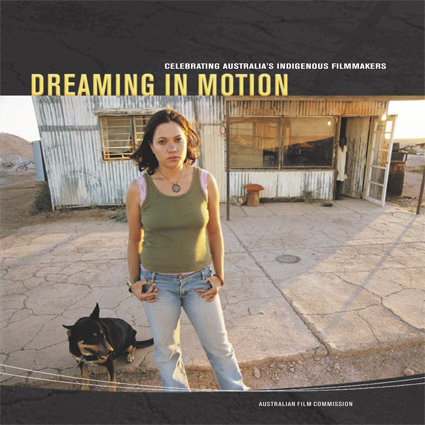
Dreaming in Motion
In 2007, RealTime edited and produced, Dreaming in Motion, A Celebration of Australian Indigenous Filmmakers. The book was published by the Australian Film Commission. It includes a brief history of Indigenous filmmaking and detailed profiles of 26 filmmakers along with production credits, festival screenings and awards. You can download the book as a PDF here. Alternatively, copies (including DVD) are available free of charge by emailing publications@screenaustralia.gov.au.
In OnScreen, our film and digital media supplement, RealTime has extensively reviewed Indigenous films and interviewed the filmmakers. The following is a selection going back to 2002.
Keith Gallasch
commentary
broken mothers in the blind spot
kathleen mary fallon: the blind side, jedda, night cries, blessed, australia
RealTime issue #98 Aug-Sept 2010 p28
for and by the community
gem blackwood: u-matic to youtube: indigenous community filmmaking
RealTime issue #98 Aug-Sept 2010 p32
Editorial: lessons from the indigenous sector
dan edwards
RealTime issue #67 June-July 2005 p18
interviews
hope & survival in the back of a van
dan edwards: interview, warwick thornton, mother courage, acmi
RealTime issue #113 Feb-March 2013 p22
a life retrieved
oliver downes: interview, beck cole & shai pittman, here i am
RealTime issue #103 June-July 2011 p13
the making of samson & delilah
keith gallasch: warwick thornton interview
RealTime issue #90 April-May 2009 p24
a filmmaking life
lisa stefanoff: interview with beck cole
RealTime issue #74 Aug-Sept 2006 p19
what the listener sees
lisa stefanoff talks with sound recordist & director David Tranter
RealTime issue #75 Oct-Nov 2006 p15
feature film
real life on the edge
oliver downes: ivan sen’s feature drama, toomelah
RealTime issue #104 Aug-Sept 2011 pg. 35
dreaming unanimity
keith gallasch: rachel perkins’ bran nue dae
RealTime issue #96 April-May 2010 p20
eddie & charlie, kings of the road
keith gallasch: richard j frankland’s stone bros
RealTime issue #92 Aug-Sept 2009 p28
the seeing ear, the hearing eye
keith gallasch: warwick thornton’s samson and delilah
RealTime issue #90 April-May 2009 p23
the story of a story
keith gallasch: beck cole, the making of samson and delilah
RealTime issue #93 Oct-Nov 2009 p28
playing by the rules
sandy cameron: ten canoes
RealTime issue #73 June-July 2006 p18
language as simple as a look
mike walsh: beneath clouds, ivan sen
RealTime issue #48 April-May 2002 p13
adelaide film festival 2011
indigenous media art: complex visions
tom redwood: stop(the)gap, adelaide film festival, samstag museum
RealTime issue #102 April-May 2011 p23
the magical meeting of cinema & media arts
keith gallasch: here i am, beck cole, tall man, vernon ah kee, tracey moffatt, stop(the)gap
RealTime issue #102 April-May 2011 p21,22,25
living cultures, moving images
stop(the)gap: international indigenous art in motion
RealTime issue #101 Feb-March 2011 p30
message sticks festival
finding the words
jane mills: message sticks film festival
RealTime issue #86 Aug-Sept 2008 p23
breaking the silence
dan edwards: message sticks
RealTime issue #62 Aug-Sept 2004 p23
new blak films
dan edwards
RealTime issue #56 Aug-Sept 2003 p18
colourised festival
the medium as the message stick
erik roberts: colourised festival 2005
RealTime issue #69 Oct-Nov 2005 p20
mirrors on aboriginality
erik roberts: colourised festival 2003
RealTime issue #56 Aug-Sept 2003 p18
caama
CAAMA: from the heart
lisa stefanoff
RealTime issue #67 June-July 2005 p19
short film & animation reviews
animating dreaming into action
danni zuvela: big eye aboriginal animation from canada & australia
RealTime issue #91 June-July 2009 p26
hybrid lives, hybrid dreams
keith gallasch sees some deadly yarns from fti
RealTime issue #85 June-July 2008
the art of the short short
keith gallasch looks into the AFC’s bit of black business
RealTime issue #81 Oct-Nov 2007 p23
small tales and true
simon sellars asseses australian short film at the melbourne film festival
RealTime issue #81 Oct-Nov 2007 p19
the art of 5-minute statements
sarah-jane norman: deadly yarns, abc-tv
RealTime issue #67 June-July 2005 p23
life behind a curtain
keith gallasch: maya newell’s richard, angie abdilla’s wanja
RealTime issue #88 Dec-Jan 2008
films making culture
michelle moo
RealTime issue #68 Aug-Sept 2005 p33
michael riley
michael riley: photographer & filmmaker – part 1: spirit, land, image
dan edwards takes in the NGA riley retrospective
RealTime issue #76 Dec-Jan 2006 p20
michael riley part 2: the films—buried histories
dan edwards reflects on the NGA riley retrospective
RealTime issue #77 Feb-March 2007 p15
obituary: michael riley
djon mundine oam
RealTime issue #63 Oct-Nov 2004 p53
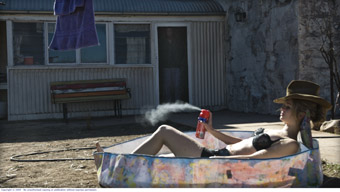
Maeve Dermody, Beautiful Kate
Rachel Ward’s short feature Martha’s New Coat, created as part of the then AFC’s 50 Minutes From Home series—which also nurtured Matthew Saville (director, Noise) and Jessica Hobbs (Love My Way; Curtin)—proved she had a talent for unearthing the often unbearable darkness of being a teenage girl in troubled times.
With a feature-length film to play with, Ward continues the theme but broadens it to include a dying patriarch Bruce (Bryan Brown), his dissociated writer-son Ned (Ben Mendelsohn), returning after 20 years to the farm where his sister and brother died tragically, a devoted younger daughter Sally (Rachel Griffiths) and Ned’s girlfriend, the firecracker Toni (Maeve Dermody), who manages to spark off everything she touches.
Australian and New Zealand films have been preoccupied with girls on the cusp; think The Year My Voice Broke, Rain, Heavenly Creatures, Somersault, Caterpillar Wish, Puberty Blues. But Beautiful Kate breaks seriously fresh new ground by exploring taboo territory: the sexual attraction between teenage brothers and sisters. This time they’re not closeted up, like Flowers in the Attic, but occupy a dewy-hued flashback narrative, a garden of earthly delights that Ned tries to resist but, in the end, can’t. The central beauty Kate (Sophie Lowe) is, as you’d imagine, as fresh as a daisy. Her body is lithe and dances through the film, silhouetted against the harsh sunlight, upside down spinning on a Hills Hoist, naked in the dam at night. At times, her face emerging luminous from within the darkness, she becomes one of Bill Henson’s subjects, and his influence is everywhere in the gorgeous framing and use of light by first-time feature cinematographer Andrew Commis, who creates Kate's ghostly spirit via Ned’s point-of-view; she looks good enough to eat.
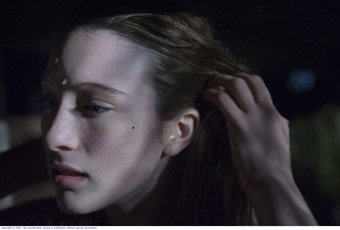
Sophie Lowe, Beautiful Kate
Beautiful Kate is also intensely erotic: the house, the heat, the sense of longing, that shuddering desire and sensory arousal of fourteen-going-on-fifteen, and the way that period captures you, stays in your memory, triggered by smells and sounds, the interplay of light and shadow. The flashbacks work this way too: Ned veers off into reminiscences about Kate almost against his will as he touches things around the rooms of a house that, judging by the decor, hasn’t changed much since his mum died. The clever narrative addition of Ned's much younger girlfriend Toni brings his lingering lust to life in the present, a tangible trace of Kate, as she flaunts her naked body around the verandah, or under the nose of Bruce’s National Party campaign poster (a reminder of his father’s failures). Toni is perhaps a suggestion of what Beautiful Kates may grow into in an uncompromising environment—tough-as-nails, manipulative, dating older men, only really happy performing to an audience—and possibly this is what Ned sees in her. This character could have been grating but Dermody brings a no-bullshit delivery and humour that brings some relief to the emotional drought the other characters are experiencing.
The film seems like a return home for the actors alongside the characters. As if Brown, Mendelsohn and Griffiths have been waiting for this dilapidated cottage in the Flinders Ranges to call them together as family. Brown and Mendelsohn gradually reveal a tenderness at their stubborn masculine cores that builds the tension—Brown reaching a vulnerable place beyond his usual surly laconic style—and it’s to Ward’s credit that her direction is enhanced at every turn by keeping things subdued. She joins a number of actor-turned-directors like Matthew Newton (Three Blind Mice) and Serhat Caradee (Cedar Boys) confident working with the nuance of performance. As she explains, “The back of a shoulder shuddering with emotion is more effective than in-your-face blubbering. Rebecca Smart tracing the line of a tear down Bryan’s face in The Shiralee (we never see his face) is an exquisite example…” (The Shiralee, miniseries, director George Ogilvie,1987).
Rachel Ward’s first feature is an outstanding debut. Beautiful Kate is a film that demands reflection and repeated viewing. It’s what comes together when you get a strong script, exacting casting, clever direction, a great soundtrack by Tex Perkins and a desire to confront audiences with something new and unsettling.
Beautiful Kate, based on the novel by Newton Thornburg, director, screenplay Rachel Ward, producers Bryan Brown, Leah Churchill-Brown, cinematography Andrew Commis, editor Veronika Jenet, composer Tex Perkins. Beautiful Kate featured in competition at Sydney Film Festival and is screening nationally.
RealTime issue #92 Aug-Sept 2009 pg.
© Kirsten Krauth; for permission to reproduce apply to realtime@realtimearts.net
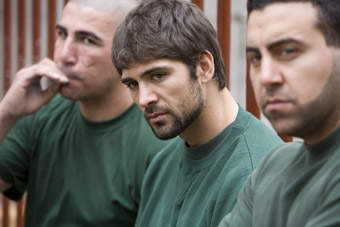
Cedar Boys
There’s been much criticism of Australian films recently: that they’re too highbrow; too rural; that they don’t attract audiences west of Sydney's Newtown. But a TV series like SBS’s East West 101, David Field and George Basha’s controversial feature film The Combination and, now, Serhat Caradee’s Cedar Boys are trying to redress the balance. Set in Sydney’s south-west suburbs, they concentrate on the challenges confronting contemporary Lebanese-Australian communities. Cedar Boys has been well received critically and, equally important, achieved popular approval, picking up a Sydney Film Festival Audience Award earlier this year.
Caradee graduated from AFTRS in 2000 and made a number of successful shorts including Bound, which won the Dendy Award for Best Short Film at the Sydney Film Festival. Cedar Boys (which he also wrote) was developed as part of Screen Australia’s Indivision Lab and it seems that this program is finally beginning to bear fruit; it’s a script that appears to have been carefully nurtured and fine-tuned. Caradee has a great ear for dialogue and as we’re cruising the streets with the three central characters—Tarek (Les Chantery), Sam (Waddah Sari) and Nabil (Buddy Dannoun)—we get real insight into men who are constantly under surveillance: by parents, police, a community deeply suspicious of anyone ‘of Middle Eastern appearance’ after the September 11 attacks and racist targeting by the Howard government. Tarek might be 24 but still lives at home with his parents and little sister, his mother continually asking where he’s going, what time he’ll be home, why he’s spending so much money. His older brother Jamal (played by the intensely charismatic Bren Foster) is in jail and his mother tries futilely to control Tarek’s movements, to stop him going down the same path. It's the film’s greatest irony that the hope his brother will be freed makes Tarek compromise his strong moral code and consider crime as an option.
A number of critics have compared Caradee's vision with Martin Scorsese's and there is that sense of a life lived alongside these fellas, of men drawn to crime as the only means to rise above their menial jobs (Tarek works as a panelbeater and is constantly denigrated by his boss; Nabil cleans apartments for those who can afford all the luxuries he can only dream of and scheme about). Sam is apparently doing well (financially at least) but he is taking risks dealing drugs. Caradee mentions the direct influence of Scorsese on the project’s early development: watching Mean Streets and Goodfellas, he wondered why the men he knew, living on the streets of Sydney’s south-west, weren’t appearing on Australian screens.
It must be something to celebrate for the main actors to be cast in a film that doesn’t portray them as one-dimensional bad guys, terrorists, gangbangers or clowns sending themselves up. Chantery comments, “It’s not a mockery…Every time people see Lebanese or think Lebanese they think Fat Pizza. It’s nothing like that. And that’s what I loved about it.” The script has an added dimension by adding Tarek’s love interest Amie (Rachael Taylor, star of Hollywood blockbuster Transformers) and her eastern suburbs friends. This creates the opportunity to explore the underlying racism encountered daily by Lebanese-Australian men: routinely barred from entry into nightclubs (unless accompanied by beautiful Australian women), or their appearance queried at parties in richer suburbs, unless they have a stash of pills for sale. But Taylor’s presence also highlights the film’s main weakness. Her performance is stilted against Chantery’s lovely melancholy—he knows she is forever out of reach—and she just seems too glamorous; the relationship never captures the dramatic tension that the men create between themselves almost effortlessly.
Serhat Caradee’s film is an intelligent and heartening low-budget feature delving into the rarely seen onscreen Lebanese-Australian subculture, exactly the kind of film Indivision Lab should be supporting. His extensive use of locations over a 26-day shoot, and the new Red 4K camerawork (the graininess suits the characters) by Peter A Holland, means the film often has a documentary fluidity as the characters drift through the streets. While the pace is at times uneven and some of the actors outperform others, the strength of the dialogue, the convincing main ensemble cast (particularly Chantery) who deliver it and the detail in recreating their edgy world, make Cedar Boys a powerful first tryout. Let’s hope it starts to get westie (and other) audiences into the cineplexes to see Australian cinema.
Cedar Boys, writer, director Serhat Caradee, producers Jeff Purser, Ranko Markovic, Matthew Dabner, editor Suresh Ayyar, production designer Claire Granville, director of photography Peter A Holland, composer Khaled Sabsabi.
www.cedarboysthemove.com
RealTime issue #92 Aug-Sept 2009 pg.
© Kirsten Krauth; for permission to reproduce apply to realtime@realtimearts.net
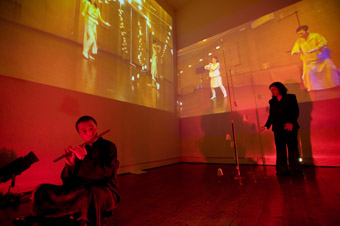
A Nest of Cinnamon
photo Damian Vincenzi
A Nest of Cinnamon
Cross-cultural collaborations can produce surprising hybrids, especially so when the resulting collision is one of Australian-Greek, Chinese and Japanese cultural and aesthetic practices. Angela Costi, poet and performer, quietly confronts her audience dressed in a spiffy yet heavily symbolic black suit. In contrast to this rather business-like cloak of death, musician Wang Zheng Ting, covered in an azure silk gown, solemnly holds before him an enigmatic imbroglio comprising grained wood, labyrinthine finger holes and a stainless steel mouthpiece. It’s a musical instrument the like of which I have never seen, and the wail that it produces is reminiscent of a flightpath borne of great pain.
The driving motif behind A Nest of Cinnamon, a work in progress, is the phoenix; which is appropriate really. Resurrection, or the release of human consciousness from its earthbound location in order to reshape itself elsewhere might very well be a type of ‘creative development period’ in and of itself. Time, space and matter compressed into an eternal present, cross-cultural arts practice is similarly characterised by a Borgesian premise, ie what if..?
Creative development showings are potentially testing for all concerned, particularly so here. The Japanese offering, rather than being performed live, is a video presentation of work completed in Japan some months earlier. It’s more perplexing that Stringraphy, the performance troupe who transform gallery space into acoustic installations that screech with the sounds of global transmission, is the basis for this performance’s rhythmical component. Consequently, the rhythms of the overall performance are simultaneously live, pre-recorded and split between watching bodies move through space and hearing the pre-recorded sound of Stringraphy’s musical instrument. Of course, the rhythms of video and live performance are very different. Digital sound and what the audience hear as Stringraphy pluck decentered lengths of monofilament stretched and threaded through polystyrene cups can in no way compare to the sound and active rhythms of Stringraphy’s ensemble members seen projected on a rear wall as each moves through a gallery space. A dilemma to be sure, but one that teases at the brain in the same way a prototype model of Stringraphy’s installation cum musical instrument does: one constructed in real time centre stage by the creators of Nest of Cinnamon in order to familiarise this Australian audience with the presence of the monofilament and styrene confabulation that can also be seen onscreen.
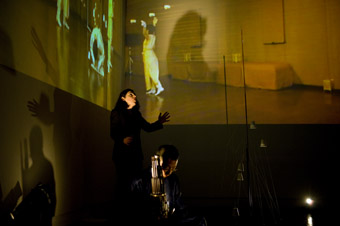
A Nest of Cinnamon
photo Damian Vincenzi
A Nest of Cinnamon
And yet I sense that all is well in this performance. In spite of the difficulties in understanding the context of this work there occurs a moment onscreen when a Stringraphy ensemble member steps forward and utters something in unintelligible Japanese. Almost immediately, the oblique rhythms of Angela Costi’s poetic presence and the piercing tremolo of Zheng Ting’s metal and wood imbroglio coalesce with Richard Vabre’s subtle shifts in red, orange and yellow light. This shift in complexion is less to do with external stimuli and more a case of individual perception. I can now see how this performance might integrate, once in its completed state. The intricate rhythms of Stringraphy’s global transmitter will, like all successful collaborations, intermingle and underpin Costi and Zheng Ting’s reflection upon the resurrecting spirit. From Canterbury-Bankstown to Reservoir, via Beijing and Okinawa, the story of what was once called migration is still one of people incinerating the past for the purpose of igniting a future. The global flow of human traffic is still, and forever will be, consistent with the resurrecting myth that is the flight of the phoenix.
A Nest of Cinnamon: a work in progress, dramaturg, director Christian Leavesley, poet-performer Angela Costi, sheng performer Wang Zheng Ting, Stringraphy Ensemble: Midori Yaegashi, Mitoko Shinohara, Momo Suzuki, Kiku, lighting Richard Vabre, producer Keiko Aoki, Global Japan Network; Arts House Meat Market, Melbourne, June 19
RealTime issue #92 Aug-Sept 2009 pg.
© Tony Reck; for permission to reproduce apply to realtime@realtimearts.net
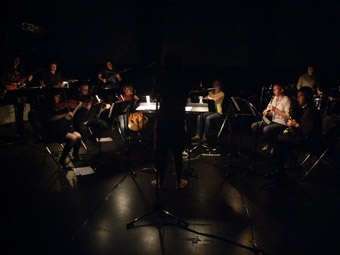
Chronology Arts Ensemble playing Alex Pozniak's Illuminations
Formed in 2007, Chronology Arts is a new force in contemporary art music in Sydney, promoting and producing the creations of young composers with its young ensemble. The group is adding breadth and complexity to a new music scene in which groups as diverse as Ensemble Offspring, Halcyon and Song Company and adventurous New Music Network concerts stimulate an audience greedy for new challenges as well as opportunities to reflect on 20th century innovations that live on.
Chronology Arts will announce its 2010 program on September 4. Back in May, I attended its Gradations of Light concert in CarriageWorks' vast Bay 17. Undaunted, Chronology Arts filled the space with new music, light, responsive video art and ideas and, in Andrew Batt-Rawden's Rise—Gradation from Darkness to Light, moved musicians around and through the audience.
Rise emerges from a cello singing high against dark percussion. Other instruments are added, playing first from behind the audience and then joining the initiators in a rich texturing and swelling of sound with violin, viola and bird-like flute. The ensemble is supple, enveloping, accelerating like wind. A saxophone warbles. The pulse quickens into an aberrant march and then a strange dance, dwelling on an affecting flute passage, rising to ecstatic saxophoning, like the full glare of the sun. The world fades in a slow release breathed in long, sustained notes, the musicians ambling back into the dark. On a small screen in the stage foreground, coloured shapes have reconfigured themselves mysteriously in designer Ed Saribatir's Light Instrument, apparently in direct response to the played score.
Composer Batt-Rawden writes in his program note that sun-rise inspired the work, providing a metaphor for “facing our demons, rising to new challenges.” The result is, as he writes, something “of a primordial ritual…that touches on our cognitive-animal strength.” “Appollonian” might be an apt description for a work suggestive at once of a primal reality but at the same time one blessed with a sunny rationality—there's lucid construction, a sense of occasion and moments of intense feeling but with an optimism that elegantly eschews high drama.
Melody Eötvös' cool Figure Seven contrasts starkly with the warmth of Rise. It's “based on six digitally created creatures from a software program designed to map out evolutionary processes. Each section unfolds from a collection of pitches derived from a 'grid' of 36 squares superimposed over each picture (6 pitches along the y axis and 6 along the x axis). Therefore the subtle changes in the pitch collections mirror the gradual evolution of the images.” This is a work at once stark and delicate, its quietly insistent pulse relieved by pizzicato, downward glissandi and lyrical erhu phrasings (from Nicholas Ng), integrating an intriguing meme to this strand of Modernist evolution.
Ng's own work, Light channels: on circulation and percolation, is inspired by an 8th century Chinese text on alchemy, specifically “the flow of light energy through certain passages or channels in the human body.” The erhu is at the centre of the composition, again framed by Western instruments and tonalities. Gonging and glissandi, some striking, deep, flowing saxophone and jaunty flute and clarinet lines provide rich interplay. In a second movement solo, the erhu, increasingly and fascinatingly distorted, is amplified dramatically against pre-recorded sound (not unlike deep breathing and percolation) suggestive of physical interiority. The work then becomes almost meditative before dancing to a finish.
If there was a lot to take in aurally in Light channels, there were also visual demands. In the first movement, three large screens behind and above the musicians revealed a Rorschach-like triptych of initially abstract shapes folding in and out of themselves and gradually revealed to be a meditation on a tree, splitting, fusing and evolving. It's a work by Christopher Fullham that could stand on its own; here it seemed aptly complementary. In the second movement, clouds drifting against blue sky and criss-crossing each other proved less engaging if providing a kind of visual bass line in their quiet monumentality.
In Illuminations Alex Pozniak aims to generate “an elastic interaction of cells of material across the ensemble…with the instruments and instrumental section (winds, strings, electric guitars) negotiating different degrees of cohesion and liberty in textures that represent light as a dynamic source of energy.” The work opens with high whistlings and a growing sense of vibration replete with tumbling sax notes and rapid flute runs, high strings and guitar harmonics. Three electric guitars swell the scale of Illuminations, each soloing distinctively while accompanied by the other two, ranging from austere lyricism to a chugging slo-mo heavy metal and artful feedback before being joined by the balance of the ensemble in a beautiful collective drift to silence.
Scott Morrison's video response to Illuminations comprises unfocused lines—black, grey, white—running in vertical parallels and then intersected by horizontals. It's a gentle, unhurried work, serenely accompanying the growing passion of the score rather than mimicking its intensity.
Gradations of Light was a satisfying multimedia experience: an ambitious concert built thematically around light (actual and metaphysical) but also, for the most part, dextrously realised in inventive staging and engaging projections. Conductor Morgan Merrell calmly ensured that the ensemble ably managed the numerous demands of these welcome new compositions.
Works by Alex Pozniak will be the focus of a September 8 concert at Sydney University's Manning Bar, and the 2009 Chronology Arts season will end with a concert titled Playing in Tongues, December 9 at the Sydney Conservatorium of Music.
Chronology Arts, Gradations of Light, composers Andrew Batt-Rawden, Melody Eötvös, Nicholas Ng, Alex Pozniak, conductor Morgan Merrell, flute Jane Duncan, clarinet Toby Armstrong, saxophone Andrew Smith, viola Luke Spicer, cello Eleanor Betts, viola/violin Victoria Jacono, erhu Nicholas Ng, guitars Matthew McGuigan, Zane Banks, Matthew Kurukchi; CarriageWorks, Sydney, May 15; www.chronologyarts.net
RealTime issue #92 Aug-Sept 2009 pg. web
© Keith Gallasch; for permission to reproduce apply to realtime@realtimearts.net
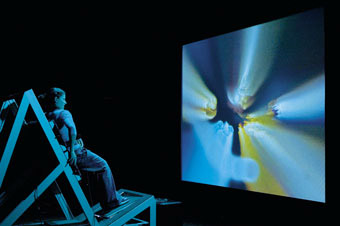
transmute collective, Intimate Transactions (2005)
photo David McLeod
transmute collective, Intimate Transactions (2005)
Keith Armstrong is a leading Australian artist with an integrative and collaborative mastery of diverse practices and media. Since 1993 he has created site-specific electronic art, networked interactive installations, performances and art-science collaborations, shown successfully here and overseas.
Central to Armstrong’s work is the notion of “embodied media”, which has taken his work and the creations made with Transmute Collective beyond conventional text and mouse-based interactivity into the potent realms of sensory and perceptual responsiveness.
Armstrong is currently exhibiting as part of Bathurst Regional Art Gallery’s Showing Off, a large-scale new media art survey exhibition curated by Daniel Kojta, running August 7 to September 20, 70-78 Keppel St, Bathurst, NSW. www.bathurstart.com.au
Transmute Collective’s acclaimed networked interactive installation, Intimate Transactions, now touring for Visions of Australia, completes its journey by connecting participants between the Albury and Dubbo Regional Galleries through physical action and empathetic virtual engagement. September 18-October 18.
A recent work, Knowmore (House of Commons) will appear in Montreal at the Elektra media arts festival in May, 2010.
A new large-scale interactive work, Triple Bypass, “based around the cultural dimensions of climate change”, has first stage funding from the Inter-Arts Office of the Australia Council. The work’s focus underlines Armstrong’s ecological interests—not only environmentally but in terms of the way that “scientific philosophical and ecologies…influence and direct the design and conception of new artworks.”
Documentation and images from Armstrong’s works, including those with Transmute Collective, along with research and writings can be found on his website: http://www.embodiedmedia.com.
interactive re-futuring
keith gallasch talks to keith armstrong
the ecology of interaction
greg hooper: intimate transactions
between research, philosophy & documentation
barbara bolt: intimate transactions, the book
interactive mysteries
greg hooper: shifting intimacies
animating the interactive spin
greg hooper: knowmore (house of commons)
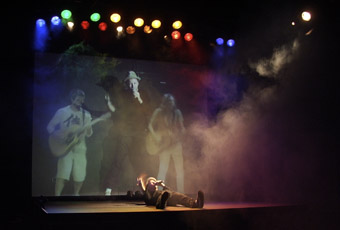
David Eastlake in Ben Knapton’s Gaijin
courtesy of the artist
David Eastlake in Ben Knapton’s Gaijin
NOW THAT I WORK IN A UNIVERSITY, I MIGHT BE TEMPTED TO DESCRIBE ARTIST-LECTURERS AS SOMETHING LIKE THE ANTS IN ESCHER’S MÖBIUS STRIP 11, MANY OF WHOM INDUSTRIOUSLY AND TENACIOUSLY FULFIL THEIR OBLIGATIONS TO BE OUTSTANDING PRACTITIONERS (IE RESEARCHERS), EXEMPLARY TEACHERS AND IMPECCABLE ADMINISTRATORS, WITH ANY SPARE TIME BEING FULLY INVESTED IN THE LIFE OF THE COMMUNITY.
In fact the relationship between the academy and the professional arts sector might well be understood in terms of overlapping spheres of influence and effect, a möbius strip or infinite surface without boundaries. Artists become lecturers and students become artists, who then become lecturers, not that that’s the only possibility of course, but it’s the one that I’m concerned with at present.
Of course artists who are lecturers are academics who get paid, and are therefore undeserving of sympathy. Students who are yet to be artists or lecturers have to pay, while artists who are neither students nor academics must find other means of survival. Either way, a lot of time goes into working in order to get the time—and the money—to work at either being an artist or becoming an artist, and if not an artist, a richly fulfilled contributing member of society with a deep appreciation for culture and the arts.
promise & reform
In education, as in the wider community, the election of the Labor Government has promised many, many things; not quite as much as promised by the election of Barack Obama—transfiguration is not on the agenda—but substantial change nonetheless. Key among the anticipated changes is the long anticipated ‘education revolution’, which according to the Minister for Education, Julia Gillard and Kim Carr, Minister for Innovation, Industry, Science and Research, promises “unprecedented reforms across the higher education and innovation sectors in response to the Bradley Review of Australian Higher Education and the Cutler Review of the National Innovation System.” While ‘reform’ may well be a word to strike terror into the hearts of those many academics who have spent the past decade or more engaged in apparently endless reform, restructure and reinvention, there seems no doubt that a revolution is underway, and as with all revolutions there will be winners and losers. Creative arts educators rarely expect to win (unless they work at NIDA), but with years of chronic advocacy and resource fatigue behind them, there is cautious optimism that gains may be made in this new era (sic).
the demand-driven model
If Group of Eight universities have slammed the Bradley Review as “a roadmap to mediocrity”, the view from other universities seems to be that the current government has indeed laid the foundation for a coherent education policy from early childhood onwards. UTS Sydney’s vice-chancellor Ross Milbourne was quoted as saying that the Bradley review was the best he had seen on the sector: “We need a great university system, not one or two great universities” (The Australian, Feb 18, 2009). What is truly unknown, however, is the impact and effect of the shift from a supply-driven model of education to one built on demand, meaning that from 2012 student enrolments will be uncapped, and students will have the right to vote with their feet. Esteem factors, proximity, flexibility, the calibre of course offerings and student experience will all play their part in this transformed educational landscape, as will the actual capacity (staffing, infrastructure, resources) of universities to respond to the potential enrolment explosion. The tension between quantity (numbers of student enrolments) and quality (the calibre of the teaching and learning experience) is unlikely to go away any time soon.
For practice-led creative arts courses, often precariously positioned within the university, it is difficult to imagine how this might play out. On the one hand, secondary students are typically conservative, with anxious parents understandably focused on vocational outcomes; but on the other hand, enrolments in university art schools across all disciplines have been steadily increasing in recent years, even if this does not match the exponential growth in media and communications areas. The shift to what’s described as a more “student centred system underpinned by a national regulatory and quality agency which will enable an extra 50,000 new students to commence a degree by 2013” (Senator, the Hon Kim Carr, Media Release, May 12, 2009) clearly indicates that the shift will be seismic. I would suggest, however, that for most artist-academics, the tension between teaching and learning on the one hand, and practice-led research on the other is likely to be exacerbated rather than eased. This may be less a matter of priorities within the universities themselves than the capacity of individuals to fulfil competing roles effectively, that is, without detriment to either their own research (art) practice and/or to those of their students. The quality question is indeed the elephant in the room, but that presumably is what the Excellence in Research for Australia (ERA) project is designed to address.
era challenges
The ERA scheme, initiated by the current Federal Government following on from the previous government’s Research Quality Framework (RQF), has foregrounded, yet again, key issues relating to the nature and calibre of research in the creative and performing arts within Australian universities. Concern around the status and recognition of the work of artist-academics as research has been fraught since the amalgamation of specialist arts training institutions into universities as part of the Dawkins Reforms of 1989. Ongoing and intense work by advocates within the creative arts higher education sector has seen that argument won—at least in rhetorical terms—within some but certainly not all universities and within the Australian Research Council (ARC). At a day-to-day level, however, as in the wider community, the research credentials of artist-academics may well be marginalised given competing priorities in areas such as medicine, the environment or technological innovation. And even now, it seems that art as the object of scholarly research, which is publication friendly in the traditional sense, is far better understood within the academy than research which is either ‘practice-based’ or ‘practice-led.’
So will ERA remedy these problems? The definition of research as used by the ARC, proposes research as “the creation of new knowledge and/or the use of existing knowledge in a new and creative way so as to generate new concepts, methodologies and understandings.” ERA indicator descriptors similarly state that, “This definition of research is consistent with the broad notion of research and experimental development (R&D) as comprising creative work undertaken on a systematic basis in order to increase the stock of knowledge, including knowledge of humanity, culture and society and the use of this stock of knowledge to devise applications.” For those artist-academics whose work reflects these research principles, this is no doubt welcome recognition, even if there is still a way to go before such understandings are implemented comprehensively throughout the university sector.
coded creativity
The ARC is currently conducting the first of the ERA trials with assessment of the Humanities and Creative Arts cluster being submitted in August with outcomes due in December. Universities everywhere are up to their eyeballs collating data in what one of my colleagues describes as the ‘Eternally Revolting Activity.’ As a consequence, all ‘research-active’ staff have been required to define their current areas of research using up to three Field of Research (FoR) Codes. For those of you unfamiliar with the fascinating details of this process, most creative arts activities come under FoR code 19. Within Division 19 there are six groups: 1901 Art Theory and Criticism; 1902 Film, Television and Digital Media; 1903 Journalism and Professional Writing; 1904 Performing Arts and Creative Writing; 1905 Visual Arts and Crafts; and then a big jump to 1999, which is “Other Studies in Creative Arts and Writing.”
In this context, it’s worth mentioning complementary initiatives undertaken from within the sector; in particular, an Australian Learning and Teaching Council (ALTC) funded initiative conducted in partnership between the Australian Council of University Art and Design Schools (ACUADS), the Victorian College of the Arts (VCA) and Sydney College of the Arts (SCA). “Future-proofing the creative arts in higher education: a scoping project for quality in creative arts research training” is headed up by Su Baker and Giselle Kett at VCA and Brad Buckley at Sydney College of the Arts. The project aims to survey the current state of doctoral programs in the creative arts in Australian universities and to investigate corresponding programs in a sample of overseas universities. Interestingly the study has already identified that models most compatible with the creative arts may in fact be more aligned to the experimental methods of the sciences than the interpretive and reflective approaches in the humanities.
So this tells us something of the brave new world that students who become artists who become lecturers have to look forward to. Conversely, those who choose to move away from the academy and support themselves as practitioners in the wider community may well be looking towards another new Federal Government initiative called ArtStart.
artstart
The new ArtStart—not to be confused with the NSW Government initiative of the same name for young people aged between 12 to 24 years—is designed to assist graduate artists including filmmakers up to 30 years of age make the transition from study to career. New funding of $9.6 million over four years suggests that this is a program the Government is taking very seriously indeed, particularly when you consider that it sits alongside another four year program also administered by the Australia Council called, “Opportunities for young and emerging artists” or OYEA—don’t you just love the acronyms?
OYEA is a government initiative that provides $6.6m over four years (2008-09 to 2010-11) to build the skills and experience of young and emerging artists through six pathways including creative residencies and commissions with major performing arts companies; artist-run initiatives; national mentoring programs, work placements for young producers; a bi-annual program of interdisciplinary mentored residencies in partnership with Byron Bay’s Splendour in the Grass Festival; and The Program, described as “an online, open arts community that provides a public-facing, social networking space for young audiences to engage with Australian arts.” A perhaps predictable add-on, given both the Australia Council Chairman and its CEO’s history with the organisation is a Young and Emerging Artist’s Award with the Australian Business and the Arts Foundation.
what kind of start?
You have to ask yourself how ArtStart will differentiate itself. It seems, talking to Australia Council staff, that the program is still very much a work in progress. It’s probably easiest to say what it’s not. It’s not another grant-giving scheme. It’s not about artists making new work. It’s not about subsidising their living costs. On the other hand it is about supporting them to buy the goods and services that they may need to establish their careers. It is about getting set up either to gain employment or to generate income. This could look something like the Run_Way scheme previously offered by the New Media Arts Board, which provided opportunities for artists and artsworkers to travel, learn and develop new skills, but it might equally support the hire of rehearsal and/or studio space, the purchase of essential equipment or allow someone to employ an accountant. One of the critical details yet to be nutted out is how to avoid ArtStart funding being counted as income and taxed accordingly. Neither funding nor industry bodies have had much success negotiating with the Australian Taxation Office over the years, so it will be interesting to see how that one pans out.
up to & after 30
It is extraordinary to think that amounts of $10,000 will be made available to around 200 artists a year, and while the question might reasonably be asked, is $10,000 sufficient to kickstart a career, anecdotally it does seem that graduating artists are more likely to continue as practitioners if they have the opportunity to make work during the first three years following their graduation. With around 16,000 creative arts students graduating annually, there is no doubt that mechanisms are needed if young and emerging artists and arts professionals are to go on to grow a robust and dynamic arts sector. It is fantastic that so many opportunities are being made available to young and emerging artists and it would be ungenerous to gripe. Nevertheless, you have to wonder what happens to artists when they turn 30, still a pretty young age for an artist. And what about all those hard working and tenacious mature to senior practitioners, whether working individually or collectively, who may have the time but not the money, or who have the money but not the time, and in what ways might our world be transformed if we were able to give more thought not simply to their financial survival but to their capacity to make art?
but is it a revolution?
There is no doubt that reform is essential. As the Bradley Review identifies: “Twenty years ago Australia was one of the first countries to restructure to enable wider participation in higher education. The results of those changes made it a leader internationally in the movement from elite to mass systems…There are now clear signs that the quality of the educational experience is declining; the established mechanisms for assuring quality nationally need updating; and student-to-staff ratios are unacceptably high.”
Australia is arguably not only reforming its higher education sector but reinventing itself through a welcome return to diversity and access for Indigenous people, people with low socio-economic status, and those from regional and remote areas. At the same time, initiatives such as ArtStart and OYEA are offering wonderful opportunities for young and emerging artists that should see many enabled to make the transition from university to professional practice.
What is not yet clear is whether Labor’s education revolution encompasses the creative arts in any meaningful way. We know that children who have access to arts education are uniquely advantaged, as a quick glance at any private school curriculum will tell you. A revolution would see all children and young people, no matter where they live, where they come from, and what school they attend, enabled to participate in an ongoing and systematic form of specialised arts training, understood as equally essential to their development as literacy, numeracy and sport. Should that prove to be the case, Australia might well achieve its education revolution, fulfill its social inclusion agenda, and change the world. Imagine that!
Image note: David Eastlake, Gaijin, photo courtesy of the artist. Writer QUT Creative Industries PhD student Ben Knapton, winner of the ADSA Philip Parsons Prize for outstanding Masters practice-led research, from which his performance work Gaijin emerged.
RealTime issue #92 Aug-Sept 2009 pg. 1
© Sarah Miller; for permission to reproduce apply to realtime@realtimearts.net
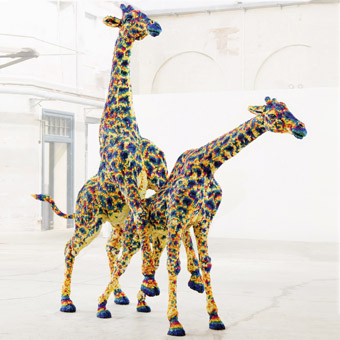
Belle Brooks, University of Sydney, Typing “Giraffe Sex” into Google Yields Ungodly Results 2008
Hatched 2009 National Graduate Show
Belle Brooks, University of Sydney, Typing “Giraffe Sex” into Google Yields Ungodly Results 2008
FOR MANY YEARS THE AUSTRALIA COUNCIL’S GRANT GUIDELINES INCLUDED A LONG LIST OF THINGS THAT THEY WOULD NOT FUND. THEY STILL DO, BUT NOW THE LIST IS A LITTLE SHORTER. WHILE FUNDING IS STILL NOT GENERALLY AVAILABLE FOR THE ACADEMIC ACTIVITIES OF UNDERGRADUATE AND POST-GRADUATE STUDENTS, ONE OF THE THINGS THAT HAS DROPPED OFF THE LIST IS THE EXPLICIT EXCLUSION OF ‘ACADEMIC RESEARCH.’ THIS IS, PERHAPS, A RECOGNITION THAT A GOOD DEAL OF ART PRACTICE THESE DAYS FUNCTIONS WITHIN A RESEARCH PARADIGM, WITH QUITE A LOT OF IT GOING ON IN AND AROUND ART SCHOOLS THAT ARE NOW EMBEDDED WITHIN THE UNIVERSITY SECTOR.
It’s part of a shift that has been going on for a couple of decades, along with the gradual expansion of research based higher degrees in the visual arts. Accompanying this has been the long on-going debate around the treatment of art practice as a form of academic research, which has entered a new stage with the initial trials of the new Excellence in Research for Australia (ERA) framework.
But something else has also happened over the last decade, perhaps producing a quite different practice paradigm. Since the introduction of the GST and related tax reforms, artists have been increasingly obliged to function explicitly as small businesses. In this context, art has to pay its way: it’s a business activity as much as a purely creative, critical or research activity. And while bodies like the Australia Council used to expect artists to have a few years practice under their belts before they applied for funding, support is now increasingly being directed at the emerging artist immediately following the completion of an undergraduate degree.
artstart
The recently announced ArtStart program falls broadly within this model, adding a further $9.6 million over four years to the more than $6 million allocated last year for emerging artist programs. As the Arts Minister’s press release of May 12 2009 put it, ArtStart “offers one-off grants to help graduates start a business as professional artists.” At the time of writing the detail of the grant conditions remains unresolved, but the program—to be administered by the Australia Council—will be offering grants of up to $10,000 to emerging artists under 30. While the ArtStart policy had originally been linked to the issue of artists on welfare, the announcement of the program focussed attention on the fact that “many emerging artists are forced to rely on their own resources and part-time jobs to subsidise their careers.”
ArtStart has generally been welcomed within the visual arts community, but there are concerns about its capacity to deliver. As the Chair of ACUADS and Head of the University of Tasmania’s School of Art, Professor Noel Frankham, puts it, “I doubt very much that $10,000, useful as it would be, is going to achieve the goals articulated for the program—assuming tax exemption, I estimate that it would buy rental of studio space for a year, but an artist still has to pay home rental, buy food, and art materials.” In this respect, it is worth noting that the cross-subsidisation of artists’ practices is not restricted to emerging artists, with the 2003 report on artists’ working lives, “Don’t Give Up Your Day Job”, indicating that over 60% of professional practicing artists work additional jobs, many of them in teaching.
a career: when?
In the light of this, Associate Professor Donal Fitzpatrick Head of Art & Design at Curtin University in Western Australia notes that while “any financial support would be welcome, it has to be thought through in relation to needs.” How, for example, does ArtStart compare to venture capital models that operate in other areas of the creative industries? And what about the increasing numbers of artists with higher degrees, how do they fit the policy framework? As Fitzpatrick sees it, with the increasing focus on practice based research degrees “there needs to be more consideration of the development of career paths in the pivotal couple of years after art college.”
This is an issue that also concerns Noel Frankham. “A program that focuses on graduating students under 30 is likely to miss many of the most serious, talented and worthy new graduates”, he says. “Increasingly, those with a serious commitment to establishing a viable professional art practice are undertaking research masters and doctoral programs (often both), meaning that they are highly likely to be over 30 when they embark on exhibition careers.” This introduces a further, and perhaps less palatable problem, which relates to the issue of career outcomes for undergraduates. As Frankham notes, “whilst investment in bachelor degree graduates is likely to be useful, it is less likely to be an investment in long term practice as artists, as most bachelor degree graduates from art schools do not apply their qualifications and skills to earning their income from creative arts practice; they use their degrees well, but not as artists.”
era: creativity as research
With regard to ArtStart and the Excellence in Research for Australia (ERA) project, Noel Frankham cautions against “making too direct links between programs for measuring the quality of academic research in the creative arts (ERA), and those aimed at supporting professional practice (ArtStart).” They are, he says, “complementary but un-related.” However, a tension remains, not least because of the lack of distinction between academic and professional arts activities, with ERA now counting artists’ exhibitions, curated projects and exhibition catalogues as valid research outcomes within the university system.
This is a very significant development for those artists who work in academic institutions, as well as for the schools and departments in which they are employed. As Donal Fitzpatrick puts it, the creative arts were previously “viewed as an afterthought, something that you add on to the broader sweep of academic work and research which was done elsewhere in the university.” But the new framework of ERA changes this, treating creative work as part of the research output of art schools, having an impact on funding, and “our status within the university”, says Fitzpatrick. “From my perspective there is much to be gained from normalising creative outputs as research within universities and the culture more broadly”, he says.
One strand of this new development is the increasing significance of the ‘practice based’ research higher degree, the impact it might have on how art practice is understood and the role it might play in artists’ career development. Another is the significant shift in how the new research framework treats issues such as peer review and ‘publication.’
peer review before or after the event?
How will the existing visual arts infrastructure play a role—from art magazines to art galleries, not to mention existing funding agencies (like the Australia Council)? As Su Baker of the Victorian College of the Arts notes, “we see peer review at many levels within the artworld, but this hasn’t been well understood at ARC (Australian Research Council) level.” At the same time, “there have been mixed messages regarding the issue of counting Australia Council grants as research outputs.” Similar issues may also emerge around how exhibitions in different gallery contexts are treated, or more particularly how decisions are made regarding the selection of work for exhibition. As Donal Fitzpatrick notes, one key issue is ERA’s shift in focus “from peer esteem to quality assurance.” “In the case of the visual arts this means that what comes prior to the ‘event’ (exhibition for example) becomes of paramount importance and what comes after is much less so…This is a massive shift for creatives to get their heads around”, he says. “All of their career paths till now have been driven by a review culture of endorsement that comes after the event, not the (peer review or selection) processes before the event.”
What this difference highlights is the structural change that a research based visual art practice may generate, with academic artistic advancement being based on peer decision making within the academy, irrespective of the response of critics, curators, or the market. While the implementation of ERA is seen primarily as an issue for artists working in academic institutions, it does have potential implications for the sector as a whole. While it is important for artists working as academics to have their work properly valued within the university context, we also need to carefully examine how this might impact on other aspects of the artworld. As we already know, there is no neat and easily identifiable relationship between critical and commercial success. In light of this we might also consider the possibility that significant academic achievement may not provide a ready framework for the establishment of the sort of viable arts business that programs like ArtStart aim to support.
RealTime issue #92 Aug-Sept 2009 pg. 4
© Peter Anderson; for permission to reproduce apply to realtime@realtimearts.net
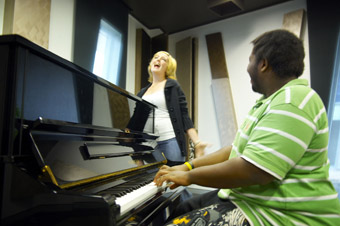
Amy Rodd, Jeremiah Mutagubya, James Cook University
photo Rob Parsons
Amy Rodd, Jeremiah Mutagubya, James Cook University
AUSTRALIA IS ALLEGED TO BE IN THE MIDST OF AN ‘EDUCATION REVOLUTION.’ BUT HOW DO HIGHER EDUCATION TEACHERS AND RESEARCHERS IN MUSIC SEE THEMSELVES AND THEIR INSTITUTIONS ADAPTING TO AND BENEFITING FROM THIS CHANGING EDUCATION LANDSCAPE? BECAUSE OF THE CONTROVERSY SURROUNDING VARIOUS ASPECTS OF THE EXCELLENCE IN RESEARCH FOR AUSTRALIA (ERA) SCHEME AND ITS IMPLEMENTATION, I OFFERED ANONYMITY TO CONTRIBUTORS TO THIS ARTICLE. RESPONSES COME FROM 12 ACADEMICS IN FIVE STATES: SEVEN WORK AT UNIVERSITIES, THREE AT CONSERVATORIUMS AND TWO ACROSS BOTH. THEY REPRESENT POPULAR, CLASSICAL, WORLD AND NEW MUSICS AND MUSIC EDUCATION.
At one stage the Australian Federal Government funded 20 categories of research output, including creative research. This ended when an independent audit identified inconsistencies in 45% of claims. The result was a decade during which just four categories of research were recognised: authored books, peer reviewed journal articles, fully refereed conference papers and book chapters. In February 2008, the Federal Labor Government announced ERA, a new research framework with a 2009-10 budget of AUD$35.8 million. Full implementation of ERA is scheduled for 2010.
In 2008, Julia Gillard said of the Education Revolution: “For the first time in many years, Australian Universities will have a Federal Government that trusts and respects them. A government which understands the formation of knowledge and skills through teaching and research is the indispensable—absolutely indispensable—precondition for the creation of a stronger economy and a more confident and equitable society.”
While the reaction from contributors was generally positive, there is a perception that the government lacks understanding about education and research. Aligned with this is scepticism. One music educator, only too aware that the recommendations of the 2004 National Review of School Music Education have still to be implemented, added, “rhetoric does not always meet reality so I look forward to finding out how this position will be enacted…” The timing of the proposed initiatives was also cause for concern: “most of it is to come closer to the next election.”
Theoretically, the creative arts will benefit enormously from ERA’s recognition of creative works in four categories: Original (creative) works in the public domain; Live performance works in the public domain; Recorded (performance) public works; and Curated or produced substantial public exhibitions, events or renderings. In line with this, contributors commented on changes to the ways in which music academics and faculties are thinking about creative practice and research. As one Head of School explained, “The inclusion of the creative arts in the data collection of research outputs is critical for the arts sector of higher education to feel fully franchised and not always having to argue the case”. However, she went on to warn:
“This ERA trial will test the Australian Research Council (ARC) and the government’s commitment to the inclusion of creative arts in the higher education system, and it will test the creative arts academics in their capacity to step up and make a sound and rigorous system for evaluating quality. Having said that, this mania for auditing is putting huge imposts on universities and individual researchers, and if the government really trusted us they would not put us through so much of this micromanagement.”
In terms of ERA’s immediate impact, two distinct pictures emerge. The first includes the institutions that have not previously recognised creative research. Many of these institutions have “no systematic approach to the collection of this material.” In these, artist academics “have been completely demoralised by the many years of non-recognition of creative outputs.” This has often resulted in a creative practice separate from academic life, or the abandonment of creative practice altogether in favour of traditionally notated research: “I have neglected my arts practice in favour of written research because I never thought anything would change.”
In contrast, institutions that have recognised creative research despite its exclusion from the national research agenda are ideally positioned to engage with ERA. First, much of the required evidence has been collected. Second and perhaps most importantly, internal recognition has enabled academics to integrate their creative practice into their academic profiles, prioritising it as one might any other form of research.
There is a need to ask why creative practice has to be justified as equivalent to traditional scientific research rather than being recognised in its own right. Aside from the fact that writing about one’s creative practice can contribute positively to that practice, “not all creative artists want to view their practice as research.” There is also scepticism as to how ERA will evaluate creative practice and how it will compare with traditional research such as journal articles: “Without knowing what kind of recognition will be given to creative practice outputs it is difficult to get over-excited about the re-inclusion of creative output”. Many academics will find their creative practice attracting attention for the first time: “People who haven’t submitted their creative works over the years are [being] encouraged to do so.” Some faculties are mindful that creative practice has yet to be accepted or understood within their own institutions, adding an internal battle to the national one: “the university has to modify its systems and attitude.”
The process of making creative work eligible for funding under ERA is far from simple, requiring a range of evidence in a format that can be stored digitally. Academics are facing not only the collection of evidence relating to each work, but the challenge of collecting data “when the rules change after the period that is being assessed.” For the 20% of outputs subject to peer review within a research code, each must provide a 250-word statement that describes the research background and questions, contribution to new knowledge, and significance of the research. The complexities of this were brought home to me as I attempted to write a background statement on the originality and research behind the performance of a 19th century viola concerto!
journal ranking
The ranking of journals is contentious across almost all disciplines and is not restricted to Australia. With news of the European equivalent ERIH (European Reference Index for the Humanities), the editors of 55 European journals published a joint editorial in which they described the scheme as “putatively precise accountancy…entirely defective in conception and execution”. “Great research”, they argued, “may be published anywhere and in any language. Truly ground-breaking work may be more likely to appear from marginal, dissident or unexpected sources.” The editors predicted that ERIH will lead to “fewer journals, much less diversity and [will] impoverish our discipline.” They have asked the compilers of ERIH to remove their journals from the list, concluding: “we want no part of this dangerous and misguided exercise.”
Many of the same concerns were expressed by academics here, who feel that “the consultation was too short and not wide enough”, leading to “reputable journals missing from the list entirely” and bias towards traditional areas of research. One academic described the rankings as a “seriously vexed problem and one that needs solving to have any credibility.” Moreover, she questioned “the enormous waste of effort that these processes have to exert”. Given that we are in the ERA data collection period, I asked whether the rankings are already influencing academics’ choice of journals. One contributor said, “I am largely defiant… and publish where I think what I have to say will best reach its intended audiences, which ranges from top-ranking to non-peer-reviewed outlets.” For others, however, rankings are certainly influencing journal choice: “I have modified the fora in which I publish to those that are more highly regarded.”
Direct pressure from universities is a key factor in these decisions; some universities will only reward articles ranked B or higher, and there are obvious implications for promotions. One contributor commented, “I have applied for study leave next year and have been advised that if I don’t say that the work I produce will be submitted to A or A* journals then my chance of getting study leave will be greatly diminished.” In short, it is likely that “the journal ranking will see some journals disappear and others have an even longer response time to article submission.” With the almost certain demise of many unranked or lower ranked journals, including many ‘regional’ journals, publishing will be much more difficult for those new to traditional research, and those publishing in new, interdisciplinary or emerging research areas.
legitimised creativity
On a more positive note, ERA will potentially give artist academics “more confidence to consider their work as a legitimate part of their academic jobs.” It will promote “stronger links between practice and reflection” and will encourage “more activities that combine research and music-making.” The fluidity of approaches engaged by creative researchers is potentially of great benefit to the academy, whether or not the outcomes are documented in traditional narrative form. Thus, ERA also has the potential to “educate others in the academy about the innovative and expansive field of art.”
artstart
The ArtStart initiative will be delivered by the 2009-10 Federal Goverment Budget. The scheme is designed to assist graduate artists up to the age of 30 make the transition from study to career. With an allocated budget of $9.6 million, the program will run for four years and will be administered by the Australia Council. 200 grants of up to $10,000 will be awarded each year, with the first round to be advertised soon. According to the Australia Council, general information, draft guidelines and funding categories are “not yet available.” The only contributor to have heard about ArtStart was a Head of School with a visual arts background.
Not surprisingly, contributors are positive about the scheme “even if it provides one more opportunity before a tougher life begins.” However, eligibility is an issue: “it would be good to have some specific information about the eligibility of performing arts in this scheme. It currently reads as having a creative rather than a performing arts focus.” Without more information, the rest is merely speculative: for example, how will new graduates compete with 29-year-old artists with established track records? Will some genres be disadvantaged in favour of postmodern or ‘high’ arts? Are the performing arts with their collaborative and ensemble structures eligible for funding? ArtStart and ERA have much in common in terms of uncertainly, and only time will tell whether their impact is negative, positive or indifferent.
See Editorial—Journals under Threat: A Joint Response from History of Science, Technology and Medicine Editors. Reproduced in Historical Records of Australian Science, 2008, 19, ii-iv. www.pubmedcentral.nih.gov/articlerender.fcgi?artid=2629173
Heartfelt thanks to the twelve academics who contributed such frank accounts of academic and creative life, and to other colleagues across the arts who offered their insights and wisdom.
RealTime issue #92 Aug-Sept 2009 pg. 6
© Dawn Bennett; for permission to reproduce apply to realtime@realtimearts.net
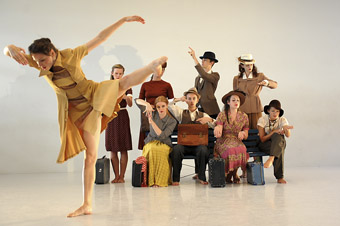
dancers from Link Dance Co,
WAAPA, performing Chrissie Parrott’s new work Reaching Veldrada, 2009
photo Christophe Cantano
dancers from Link Dance Co,
WAAPA, performing Chrissie Parrott’s new work Reaching Veldrada, 2009
TWO INITIATIVES THAT WILL DETERMINE SOME OF THE SUCCESS OF THE RUDD GOVERNMENT’S COMMITMENT TO AN ‘EDUCATION REVOLUTION’ AS FAR AS PERFORMING ARTS GRADUATES, ACADEMIC ARTISTS AND THEIR INSTITUTIONS ARE CONCERNED, ARE THE EXCELLENCE IN RESEARCH FOR AUSTRALIA (ERA) INITIATIVE AND ARTSTART.
An aspect of ERA (which will assess research quality within Australia’s higher education institutions) that met with approval from all interviewees for this article was the explicit inclusion of practice-led research in the submission guidelines. As Maggi Phillips, Coordinator of Research and Creative Practice at Western Australian Academy of Performing Arts (WAAPA) says, ‘it’s the first time they’re envisaging artistic practice being accepted as research, so fundamentally, the concept is right.”
Clare Grant is Lecturer in Performance in the School of English, Media and the Performing Arts at the University of New South Wales (UNSW}. Questions are still to be answered regarding how the new ERA system will pan out, she feels, but she is optimistic about its implementation. “As a practitioner, my main goal is to try and get new performance makers out there into the world. It means a lot of keeping up with what’s happening, and occasionally giving dramaturgical support to young people on various kinds of projects.” In the past, Grant says, this had to be done in addition to other commitments demanded of her position. Under the new guidelines, the way UNSW views her work obligations is now more in accord with how she has always understood her role, she says. Her mentoring and dramaturgical work will be recognised, reducing the stress of having to justify time spent in this way.
Jonathan Bollen, Senior Lecturer in Drama and Honours and Postgraduate Co-ordinator, Drama at Flinders, is unsure whether ERA will bring improvements for the artist-academic. Because, he says, ERA is simply a mechanism to allocate resources to universities. Whether there is a positive impact will depend on how universities do their reporting. “ERA may provide a box you can tick for performing arts, but whether it will change how the work is valued in institutions and the ease with which it is undertaken is still unclear.”
peer review complications
Maggi Phillips believes that, on balance, ERA is a positive development. The problem, she says, is in the evaluation method. Peer review is “a very complicated and expensive exercise when looking at everything throughout Australia and all universities.” Research output will be also assessed under the more traditional system, including journal citations, in which practices as diverse as performance, poetry and lighting design will come under the same code. How successfully these methods will evaluate research output, she believes, is yet to be seen.
Peter Hammond, Head of Performing Arts and Lecturer in Theatre at the University of Tasmania (UTAS), is enthusiastic about ERA, believing the changes will “put creative arts on the table and upfront” and he is hopeful that the new system will mean more money filtering into performing arts education. He anticipates problems with the peer review aspect of the assessment, however, particularly for performing artists in remote areas. “What constitutes peer review if those artists are in isolation?” He also found a significant drawback in the initial ERA trial for the humanities and creative arts cluster” “It has been very limiting for us …we have to decide which 20% of outputs are a genuine representation of our creative and research work. I have found that quite difficult, to leave certain artists out and to justify the inclusion of others.”
Will Peterson, Head of Drama and Theatre Studies, Monash University, while concurring with the inclusion of practice-base research, sees potential problems with the peer review aspect of evaluation. Because of the relatively small pool of viable performing arts courses, there exists a high degree of familiarity between practitioners, making anonymous, objective assessment difficult. He also believes that the discipline code system discourages interdisciplinary research and scholarship. His research, for example, might be published in Asian studies, cultural studies or anthropology journals, all of which fall into another discipline code. Under ERA, he says, performing arts academics will be rewarded “for staying in our own little field.”
artstart
Graduate artists are the focus of ArtStart, which aims to assist them establish their practice and support their transition from study to career. The Australia Council will administer the program, with 200 successful applicants per year over four years receiving up to $10,000 each. Are grants of this type the best way to help graduating artists and how are performing arts institutions already supporting students with the transition to the industry?
National Institute of Dramatic Art Director and CEO Lynne Williams hopes to further expand what she calls “the pathways into industry” already offered by NIDA. A new initiative was launched this year called Springboard, where recent graduates can collaboratively apply for an opportunity to develop a performance project. The successful groups have access to NIDA’s rehearsal and performance spaces, assistance in technical and marketing areas and a small amount of funding. There are also plans for a mentoring program where graduates are linked up with alumni in their field. Recently, NIDA has attracted Federal Government funds to support a feasibility study into an enhanced program of postgraduate courses and other continuing professional development opportunities for the arts and entertainment industry to further ensure successful and sustainable careers.
Will Peterson remembers how crucial it was for his development as an artist to have the opportunity to develop a work in his early years and would welcome a grant that would facilitate a similar experience for today’s graduates. “You get really hungry when you’ve had that experience once. You will do almost anything to ensure it continues.” He does, however, have concerns for mid-career artists, no longer “flavour of the week”, who also struggle to secure ongoing funding for their work.
Jonathan Bollen, too, welcomes the $9.6 million earmarked for emerging artists and wouldn’t like to see any of this money siphoned off for older artists, because “I teach young people, and I’m interested in the work they do, that’s where my investment is.” In general, he says, ArtStart looks good, particularly if it supports young artists working with each other rather than seeing their skills and ideas incorporated into established companies.
While Peter Hammond supports grants for graduate artists he would like to see the money tied to an educational purpose or a marketing outcome. UTAS’s company, CentrStage, utilises staff from the school of visual and performing arts, professional performers and graduates. Current students also gain valuable experience and training by crewing CentrStage shows. Hammond would like to see CentrStage in a position to expand their one-year salaried apprenticeship program for a selected graduate.
The Monash University Academy of Performing Arts Graduate Theatre Ensemble, under artistic director Peter Oyston, likewise gives students, who are admitted annually by audition and interview, “experience in creating professional theatre and learning industry practices to provide them with a realistic threshold into the performing arts industry as directors, dramaturgs, producers and performers.”
Maggi Phillips believes the transition from education to industry is very difficult “especially for dance and theatre.” However, she’s concerned that the money to finance grants such as those proposed may mean funding falls away in other areas. “For example, if that means that companies and the arts infrastructure are not supported properly… you might have young artists ready for transition but there’s no work to go to.” Rather than offering individual ArtStart grants, a case could be argued, she says, to instead fund programs like WAAPA’s graduate dance company, Link, which BA students can apply to join in their honours year and which Advanced Diploma students can use to convert to a BA.
Clare Grant broadly supports grants to help emerging and graduate artists, but also points to the success of companies like PACT Theatre in developing the practice and skills of young artists and is keen to see the support and funding it gets continue. However, she says, each year several young artists graduate from UNSW without developing links with projects such as PACT’s and they, especially, may well benefit from a grant that provides them with the space and time to consolidate their work.
Clearly, there’s enthusiasm among academic-artists about ERA but much has yet to be resolved about peer review procedures and the scheme’s artform categories—where, for example, does interdisciplinary work, so central to the arts these days, fit? It seems unwise to place limits on creativity at the very moment you acknowledge it as research. ArtStart has also had a broadly positive response, but given the collaborative nature of much theatre and dance, and various schools’ establishment of graduate companies, the value of implementing small, individual ArtStart grants will need serious consideration.
RealTime issue #92 Aug-Sept 2009 pg. 8
© Maryrose Cuskelly; for permission to reproduce apply to realtime@realtimearts.net
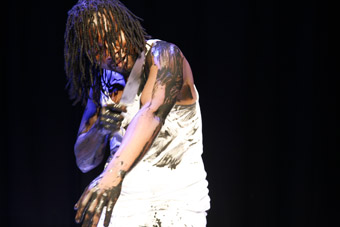
Alexander C Bede, SCRUB
photo Christa Holka
Alexander C Bede, SCRUB
EAST END COLLABORATIONS—A PARTNERSHIP BETWEEN QUEEN MARY, UNIVERSITY OF LONDON AND THE LIVE ART DEVELOPMENT AGENCY—CELEBRATES ITS 10TH ANNIVERSARY THIS YEAR. THE OCCASION WAS MARKED BY A LIVE ART WEEKEND AT QMUL INTRODUCED BY SUSANNAH HEWLETT’S ‘JINGLE’, “PROUD TO BE PRESENTING”, AND HOSTED BY THE INDEFATIGABLE TAMMY WHYNOT (LOIS WEAVER) IN FEATHER BOA AND PLATINUM WIG.
Day one features artists who performed at previous EEC platforms and is their opportunity to reflect on subsequent development. A common refrain is how making work is contingent on myriad factors—money, space, mood, context, opportunity…I like the simplicity and honesty of Sheila Ghelani’s video Grafting and Budding…still, about the process of revising a piece for different contexts. Composed of close-up shots of a hand resting on a diary page, interspersed with stills, it trips along to Colin James’ catchy “Five Long Years”, also acting as effective documentation of the original performance—apple halves skewered and clipped together, placed in Barnett Newman-like zip markings of blood and spice.
Conversely Emma Wolukau-Wanambwa’s Documentation of Cooper House—no doubt a beautiful work as a mixed-media installation—suffers from the absence of the artist and/or lack of contextualisation. Richard DeDominici contributes Plagiarismo! Redux, a comic, accessible slide-lecture on plagiarism (“Which came first: the swan or the police van?”). More conceptually sophisticated though are Angela Bartram’s Untitled, a lecture on her work (Spit and Lick; Licking Dogs) and Oreet Ashery’s video installation Back in Five Minutes. Bartram’s footage of herself and various dogs engaged in mouth-to-mouth licking is underpinned by a theoretical enquiry around notions of abjection and the anti-social mouth and succeeds in making viewers very uncomfortable; whilst Ashery explores disappearance and otherness.
The second day includes discussions, advice sessions (Everything You Wanted To Know About Live Art But Were Afraid To Ask) and this year’s platformers. The range is impressive: from work openly dealing with ‘issues’ to the sensory seduction of Poppy Jackson’s Untitled where, amid birdsong, smells of melting wax and poster paint, a woman with red bunting wrapped round her wrists balances on a birthday cake in the yellowy light of a summer’s day. Incarceration—Lisa Wright’s caged girl-as-mannequin lit by strobe lights—also stuns. Sian Robinson-Davies’ Disguised as Things is a witty, economical work about becoming inanimate in the context of liveness. At its start we’re handed plastic flowers to throw at the stage when performers take their bow. Format: a man reads the sign he holds (“the lamp”) and a woman becomes it (wearing a shade on her head, trailing a flex, reading a newspaper). This continues: “the jacket”; “birdie”; “the mirror”; “the apple tree”. The last is “the vase” in which both performers drink water then bow….Still life that won’t stay still or a lecture in semiotics?
In a Britain with newly-elected, neo-fascist Euro MPs, Alexander C Bede’s dissection of race, SCRUB, feels especially pertinent. There is a black coffin filled with what looks like white tissue and a table laid out with a selection of cleaning implements: sponges, towels, wire wool, a knife, bleach. Black and white grow more sinister: the white-suited, lone black performer, his bare arms coated in black paint, scrubs away to make himself lighter. When he asks us to pass him something, no-one wants to move, unwilling to be complicit in this bleaching game. The spoken text (about the need to be whiter for better prospects) is redundant: the smell of bleach suffusing the room and Bede’s reddening skin are powerful enough.
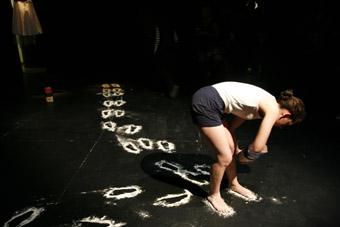
Rachel Mars, Unto Us A Child Is Born
photo Christa Holka
Rachel Mars, Unto Us A Child Is Born
Rachel Mars’ unashamedly feminist Unto Us A Child Is Born also impresses. Entering the space, I’m asked “Luke Skywalker or Princess Leia?” As Skywalker, I receive a packet of self-raising (rather than plain) flour labelled “Grip me.” Mars asks if anyone has ballet dancers in the family; muses on the difficulty of reconciling a desire for femininity with self-identification as a tomboy; longs for weightlessness without the need to be lifted. The text shifts: conversational, funny, confessional, statistical, self-deprecating, quasi-poetic (she calls Baby in Dirty Dancing a “befrocked snowstorm of soft focus”) till she is climbing a rope ladder in high heels and a netted white dress. “If you could just lift your own weight”, she says, hanging impressively from a bar in the rafters. “It’s very close to theatre”, someone mutters (an accusation levelled at Rose English years ago, so Mars is in good company).
Another performer to look out for is Martin O’Brien. Unlike Ben Connors & Holly Darton’s Couple or Jungmin Song’s A Reel to A Reel which test audience endurance, O’Brien’s durational work Repetitive Strain Syndrome is utterly compelling. Legs taped together, he stumbles on gold lamé heels across a floor littered with a plunger and bits of coal-like faeces whilst a zealous dominatrix in a gimp mask sets tasks and abuses him. When she hands me a wooden pole, I nudge his waist. Another viewer is more vigorous, appears to have discovered his sadistic streak. Occasionally, a musician twangs an electric guitar or O’Brien stops to describe a gruesome punishment—the scold’s bridle, the stocks. Sex game or act of torture, it’s a real tour de force.
In an inspired installation, Lindsey Price and Francesca Millican-Slater’s Ed Venture’s Quintessentially English Tea Room honours the nation’s legendary attachment to tea. I am seated with strangers, my order taken by a uniformed waitress. Place mats encourage writing on the tablecloths, suggesting “the weather” and “tea stories” as suitable topics of conversation; I unwrap a personal message: “first love.” Sipping loose-leaf Earl Grey from patterned china and indulging in cup cakes, we talk about the performances we’ve seen so far. An opportunity to network in a relaxed way, the tearoom is a joyous antidote to the homogenous chain café. One of my tea companions wonders whether this piece is symptomatic of a recession-friendly genre of performance where the viewer-participant is treated more gently. Quite possibly. For me it sums up East End Collaborations: a site of nurture and debate from which I, like live art, emerge re-energised.
Queen Mary University of London and the Live Art Development Agency, East End Collaborations 2009—Tenth Anniversary Platform; Queen Mary University of London June 5, 6, www.thisisliveart.co.uk
RealTime issue #92 Aug-Sept 2009 pg. 10
© Marie-Anne Mancio; for permission to reproduce apply to realtime@realtimearts.net
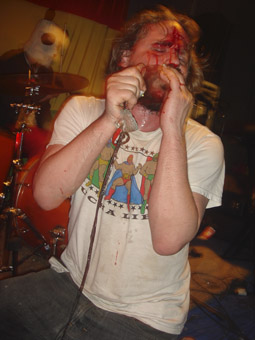
Lucas Abela, Yang Yang (in panda suit), Rice屎Corpse
photo courtesy the artists
Lucas Abela, Yang Yang (in panda suit), Rice屎Corpse
TONGZHOU IN BEIJING’S FAR SOUTHEAST HAS BECOME SOMETHING OF A HAVEN FOR MUSICIANS GRAVITATING TO THE CAPITAL FROM ALL OVER THE COUNTRY. THEY ARE ATTRACTED BY TONGZHOU’S CHEAP RENTS AND BEIJING’S THRIVING ROCK SCENE, CENTRED ON A HANDFUL OF CLUBS LIKE MAO LIVE, DOS KOLEGAS, D-22 AND YUGONG YISHAN.
Punk-influenced rock is Beijing’s staple musical diet, but local venues host an eclectic range of events, including talks, films and avant-garde music performances. It was this burgeoning scene that prompted Sydney-based noise musician Lucas Abela, famed for his aural onslaughts on a miked and effected pane of glass, to apply for an AsiaLink residency. The result was Rice屎Corpse–an improvising band with Abela on glass, Yang Yang on drums and Li Zenghui on piano. (‘Rice corpse’ is the literal translation of the Chinese character for ‘shit’). They had four rehearsals, two of which were recorded providing the material for Mrs Rice, a CD co-released by Abela’s own Dual Plover label and Subjam through its experimental wing Kwanyin, run by Yan Jun, a dynamic force in the Beijing experimental scene. The trio then proceeded on a 10-city tour of China: Beijing, Tianjin, Yinchuan, Lanzhou, Xi’an, Chengdu, Guangzhou, Changsha, Wuhan and Shanghai.
Abela was very strategic in his approach to the project. He chose China for his residency because “when you’ve got 12 grand to spend and you want to get a lot out of that money I thought China would be the go. But I was interested in China as a place—politically, socio-economically, ethnically—all sorts of strange things are going on there. So I got Yan Jun from Subjam to host me. The thing that I like about self-initiated residencies is that it shows that I have initiative and drive, but also, I’m the only person in competition for it!”
Abela had a clear vision that he needed a drummer and a pianist. With Yan Jun’s help he teamed up with drummer Yang Yang, a well-known figure in the scene recently described by Time Out Beijing as the “spiritual leader” of the Tongzhou community. He presides over the noise band Mafeisan, often performing with a bag over his head (and for this tour in a panda suit). Finding a pianist proved more difficult, however owner of Sugar Jar records Lao Yang recommended Li Zenghui, currently a solo saxophonist and part of the duo Hetao shi (Walnut Room). Li had played keyboards in bands when he was living in Qingdao, a resort town on China’s east coast, where coincidentally Yang had also spent some formative years playing in experimental rock bands before gravitating to Beijing.
Abela was interested in the piano and drums forming a rhythm section. “I think I aurally hallucinate when I play, because I’m hearing all sorts of things. I’m always playing along with this imaginary band in my head. In this instance I’ve got this real band, and they’re outwardly influencing me. I’m hearing them and I’m following a rhythm or following a change of theirs. It added new elements—made me play in different ways.”
The tracks on the CD Mrs Rice were recorded at the very nascence of the group, during their first rehearsals. “All the tracks are completely improvised. I was only there for a month and in the first couple of weeks I was trying to get the band together. When we finally got together we only really did four rehearsals [of which] two were recorded and edited down to the album. There are a couple of other tracks that I wanted to put on the album. I mixed them and finished them but Yan Jun from Subjam said ‘the album’s too long, you should just make it tighter, it’ll have more impact.’ I don’t usually think that way, but he was completely right and taking those tracks out made a much more cohesive record.”
Jun offered good advice—Mrs Rice is a concise, punchy album. While Abela was looking for a format that would let him ‘play lead’, the piano and drums are far from just backup. There is a real sense of shared exploration across the tracks, and more dynamic range than the all out splatter mayhem that one usually expects from Abela. As they shared little to no spoken language, the sense of the artists getting to know each other musically is particularly strong and engaging. Yang Yang says “If you ask me whether language itself is a hindrance or a barrier, of course language would help. But every musician uses music to communicate.”
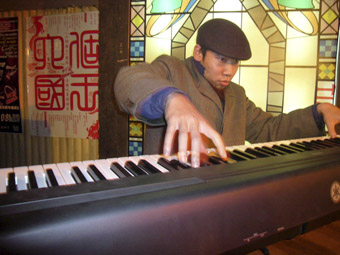
Li Zenghui, Rice屎Corpse
photos courtesy the artist
Li Zenghui, Rice屎Corpse
Abela had toured to four cities in previous visits, but the Rice屎Corpse tour extended further into northern and western China, thanks to the band’s personal networks. Abela says “the circuit is growing, there are lots of live houses. There’s less for the kind of stuff we’re doing, but there’s just so many cities there. Things that you wouldn’t even look at on a map and are probably bigger than Sydney. If you splintered even 1% of the population, there’s still a decent touring circuit for the bands in China—especially for the punk bands.” However for experimental musicians, it’s still hard to make a living, and audiences are only just developing. Yang describes reactions: “It was more or less the same, but the audience was divided into three categories. First were those who left as soon as we started playing. The second stayed to the end and then said, “That was dog shit!” The third got excited. But the number who got excited was very few…because experimental music has only just started in China, so most people don’t know about it.”
With increased attention on the underground music scenes, I asked Abela if there was any truth in the press predictions around the time of the Olympics, that Beijing is becoming the new Berlin? Abela says: “It could become a Berlin type scenario for foreigners who could easily move in and live off nothing, but they probably won’t make money as musicians. There’s more happening on a nightly basis than in Sydney, which is saying something…But I think they do it a lot harder in Beijing than the Europeans.” An important distinction is that while the Chinese government tolerates experimental music, there is no institutional support in terms of arts grants or even community radio. In fact the national media still doesn’t support rock music, let alone experimental acts, with only traditional folk and Mandarin pop music permitted. Yang says pragmatically: “Experimental music has nothing to do with Beijing. It has something to do with the universe. It is immortal. I do the music here because I live here. The Beijing audience is more or less the same as in other cities, [but] Beijing provides many chances to perform. In other cities there is no chance. Here you can get information and opportunities.” Li offers a more poetic view of the potential: “Beijing has fresh air for music. In other cities there is no fresh air.”
For Abela, the band experience was particularly important for developing the perception of his glass playing as not merely a freak show but a serious musical pursuit. “I’ve been playing glass since 2003, but from a technique I’ve been developing since the late 90s. I see it as a new instrument. I vibrate the glass, press it against my lips and hum and vibrate this sheet, I can’t think of another musical instrument that works in that way. It’s not wind, I’m not blowing through it; it’s not percussion, I’m not hitting it; it’s not strummed; I’m like vvvvhhhhh—just vibrating the sheet. One of the reasons why I wanted to move into a band context was to show off its musicality, which no one really sees when I play it because I’ve got very discordant taste.” However, after initially deciding to not complete each show with his signature glass smashing and face gashing, he couldn’t help himself. “It’s not just for the shock of it. It just seems the right way to finish a show. It’s at the heightened point when I’m feeling good and I get a rush and bang… and there’s the trickle of blood across my face [he giggles]. I love that.”
Because of the language barrier, Abela was unsure as to how the band experience was for Li and Yang. Both admit that musically they are fixed on their own trajectories, so while the collaboration was interesting, it did not so much affect their personal music making. But like all good exchanges, the effect is more far reaching than just the art. Yang says: “In terms of my music there’s been no influence, but in terms of life there’s been an unpredictable effect…” Li, a man of few words, sums it up best: “We miss Lucas.”
See also a full interview with Lucas Abela; and a review of Mrs Rice
Rice屎Corpse, tour November 2008; Mrs Rice CD, Dual Plover/Kwanyin-Subjam 029, 2009
Thanks to Wang Yi for her assistance in translating Dan Edwards’ interview with Yang Yang and Li Zenghui
RealTime issue #92 Aug-Sept 2009 pg. 12
© Gail Priest & Dan Edwards; for permission to reproduce apply to realtime@realtimearts.net
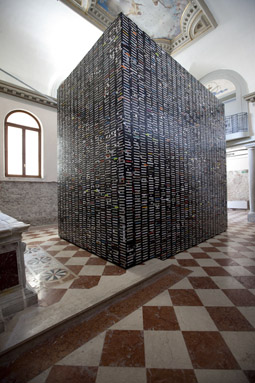
Claire Healy, Sean Cordeiro, Life Span
photo Alex Davies
Claire Healy, Sean Cordeiro, Life Span
THE VENICE BIENNALE IS THE MOST PROMINENT INTERNATIONAL SURVEY OF NEW ART. UNLIKE OTHER BIENNALES, HOWEVER, THE RATHER OUT-DATED IDEA OF THE NATION IS THE FOUNDATION OF ITS ORGANISATIONAL STRUCTURE. PAVILIONS THAT STILL REPRESENT THE POLITICS OF NATIONALITY OF THE 20TH CENTURY ARE CLEARLY A BURDEN FOR MANY CONSCIENTIOUS ARTISTS RAISING QUESTIONS ABOUT DISPLACEMENT, BORDERS AND THE IMPACT OF HISTORY ON THE FUTURE OF THE WORLD. NOT SURPRISINGLY THEN, THE MOST INTERESTING WORK AT THIS YEAR’S BIENNALE IS FOUND WELL OUTSIDE THE NATIONAL PAVILIONS OF THE GIARDINI.
off-site projects
Except for Ken Yonetani’s Sweet Barrier Reef, a rather dull comment on the effects of consumerism on nature, the Australian off-site project Once Removed curated by Felicity Fenner offers a refreshing insight into the predicament of displacement. Undoubtedly part of the show’s appeal is the extraordinary location, the Ludoteca, formerly a convent in a prime position between the Giardini and the Arsenale. At the entrance is a chapel, where Claire Healy and Sean Cordeiro present their impressive new work Life Span. 195,774 VHS tapes are stacked into a neatly arranged plinth, responding boldly to the religious architecture of the space. What is immediately striking is the weight and solidity of this monument, an exaggerated reminder of the obsolete material packaging of globally circulated screen fantasies. But the artists also reflect on the passing of time and its multiple scales; neither the crumbling walls of the old church nor the black plastic surfaces of the tapes can speak of eternity. The combined running time of these tapes is the average human’s life span when VHS was released, 66.1 years. Thinking of how many hours of pornography fill the monolith, the idea of this content flashing before one’s eyes at death is also staggering. The rumours around Venice before the opening were that the Australians had ‘video porn’ on show. Needless to say, Once Removed has been well attended.
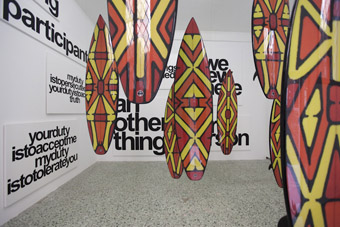
Vernon Ah Kee
photo Alex Davies
Vernon Ah Kee
Also at the Ludoteca, Vernon Ah Kee works with several dialogues between iconic Australian cultural references and their dark histories. In his video work, Cant Chant, he tells a fairytale of Aboriginal surfers reclaiming a break, juxtaposed with allusions to racial alienation and the violence of Australia’s Indigenous history. In the next room, the beautifully painted surfboards that appear in the video are hung from the ceiling as if lynched, conversing with provocative black and white wall texts such as “first person” and ‘“hang ten.”
Other standout off-site events include Unconditional Love at the Arsenale Novissimo, organised by the Moscow Museum of Modern Art. On display at this wharf venue is the extraordinary video panorama by AES+F, The Feast of Trimalchio, as well as a handful of other Russian up and comers all grappling with the future of affection in a hypersexual world.
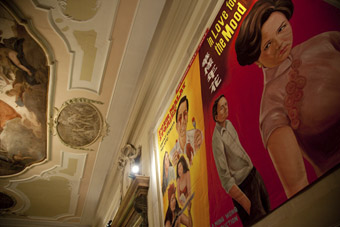
Ming Wong, Life of Imitation
photo Alex Davies
Ming Wong, Life of Imitation
Ming Wong’s solo show, Life of Imitation at the Singapore Pavilion, transforms an old Venetian palace, Palazzo Michiel Brusa, into the artist’s own quirky vision of the defining moments of Singaporean cinema with new work as well as archival materials. Often performing himself, Wong reconstructs the plural veneers of Asian language and identity in a series of re-invented multi-channel video installations, such as In Love for the Mood. Promotions painted by Singapore’s last surviving movie billboard painter, Neo Chon Teck, renegotiate the appropriated video content and the artist’s seemingly inexhaustible interpretations of the history of human melodrama.
These off-site pavilions and collateral exhibitions can be difficult to find in the labyrinthine alleyways of Venice, but away from the hype of the Arsenale and Giardini, they are truly highlights of the biennale.
giardini pavilions
For most exhibitors in the main pavilions, grappling with national identity is part of the brief. Shaun Gladwell’s slickly presented MADDESTMAXIMVS is no exception. Gladwell’s rapid ascent to international success has not been without criticism, but his solo exhibition at the Australian Pavilion does rise to the challenge of the biennale, transporting visitors to a particularly Australian time and space. Before they even get there, Biennale-goers are hooked, pausing at the promotional posters lining Venice’s canals of a leather-clad and helmeted Gladwell cradling roadkill in the searing Australian desert; “Is that a real kangaroo?”
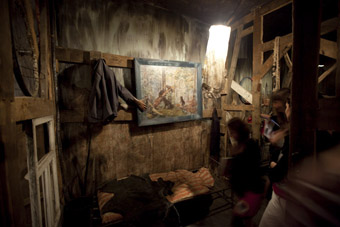
Gosha Ostretsov, Art Life or the Torments of Creation
photo Alex Davies
Gosha Ostretsov, Art Life or the Torments of Creation
For taking viewers on a journey to the unfamiliar and ridiculous, the best pavilion is the stylised Victory over the future. In reference to the Futurist opera Victory Over the Sun, Russian curator Olga Sviblova has chosen ironic artists who deal with the way representations of the past can reveal the future. The first room is filled with the utopian drawings and poetic texts of Pavel Pepperstein. Dated earnestly into the next few thousand years, the work appears like a set of souvenirs from somewhere we can never visit. In the basement is the biennale’s only haunted house, Gosha Ostretsov’s Art Life or the Torments of Creation. Hands emerge from otherwise empty coats and rhythmically rock creepy scenes of rural life. A phone rings, but the voice on the other end quickly hangs up in a panic. A mechanical mannequin (presumably representing the artist) sits at a wooden desk, inexhaustibly sketching in dim lamplight. No doubt about it: the Russians know how to make the future seem spooky, yet oddly hilarious.
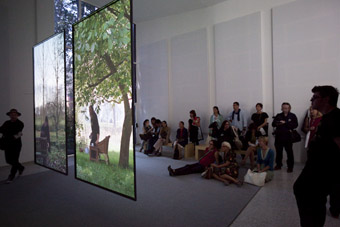
Fiona Tan, Disorient
photo Alex Davies
Fiona Tan, Disorient
The othr pavilion not to be missed is The Netherlands, dedicated entirely to the work of Indonesian-born Fiona Tan. All three of her video works are outstanding, but it is Disorient, a two-channel projection that draws the crowds. The work takes as its departure point the original texts from the 13th century voyages of Marco Polo. These point to video montages of contemporary daily life across Asia and the Middle East, covering the same territories as Venice’s most famous merchant, but representing a more complex reality with which the European empire, even with all its trade and adventure, has never come to terms. Marco Polo’s symbolic commodities still exist—indigo, spices, oil, silk—but Tan places them in the context of contemporary violence, poverty and exploitation, documenting ragpickers sorting through the waste piles of India and American soldiers intimidating Iraqi civilians. This is more than a nod to the colonial history of Europe. Tan’s work also shows that, if we really look, within the subject-artist relationship are all the ugly and intimate contradictions of continuity and change.
making worlds
Daniel Birnbaum, the Biennale’s 2009 director, defines his curatorial concept with the title Making Worlds, attempting to credit the methods and strategies of artists everywhere. The massive group exhibition includes the work of over 90 artists. The theme may be vague (how could an all-encompassing global artistic vision be anything else?), but the selection of work is extraordinary. While there is dialogue between artists, it is refreshing to see that there is no universal language here.
Outdoors, in the beautiful Giardino delle Vergini (Garden of the Virgins), is a maze of site-specific interventions by younger artists such as Miranda July, who gently teases her audience with colourful invitations of poetic self-portraiture. Chinese artist Chu Yun’s Constellation No. 3 is just as whimsical; a glorious universe of flickering stars in a darkened room, revealing itself on closer inspection to be created by the familiar flashing indicator lights of fridges, kettles, microwaves and fax machines.
The overall impression of the biennale is predictably sensational and generalised. Such a quantity of art arranged under the clumsy classification of nations may be impossible to be otherwise. But within its component parts, scattered throughout Venice, appears a scale of specificities showing that artists of the world may, in fact, not have so much in common after all.
The 53rd Venice Biennale, June 7-Nov 22
RealTime issue #92 Aug-Sept 2009 pg. 14
© Alexandra Crosby; for permission to reproduce apply to realtime@realtimearts.net
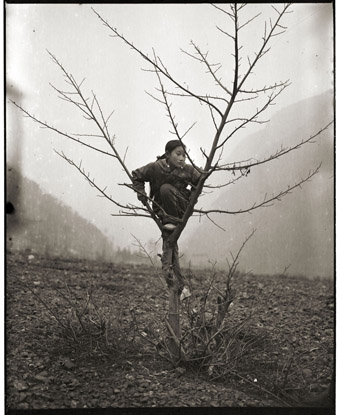
Girl and Tree, 2006, Adou
photo courtesy the artist
Girl and Tree, 2006, Adou
GIVEN THE ATTENTION AFFORDED CHINESE CONTEMPORARY ART OVER THE LAST DECADE, IT’S REMARKABLE HOW LACKING THE NATION IS IN PHOTOGRAPHIC INSTITUTIONS. “ON THE SURFACE CHINA SEEMS TO HAVE AN ABUNDANCE OF PHOTOGRAPHIC HISTORY. BUT IN FACT IT DOESN’T HAVE ITS OWN FOUNDATION OR SYSTEM—THERE ARE NO PHOTOGRAPHIC MUSEUMS, ARCHIVES, OR COLLECTIONS”, ASSERTS PROMINENT CHINESE PHOTOGRAPHER RONG RONG. “BECAUSE CHINA LACKS THESE THINGS WE WANTED TO START AND SLOWLY BUILD THEM UP, SETTING UP A PLATFORM TO INTRODUCE PHOTOGRAPHY TO A BROADER AUDIENCE.”
With this aim in mind, in June 2007 Rong Rong and his wife Inri created the Three Shadows Photography Art Centre on the north-eastern outskirts of Beijing. A custom-built complex designed by Chinese artist Ai Weiwei, the centre has staged a series of innovative group and solo exhibitions highlighting current trends and talent in China’s emerging photographic art scene. The centre is much more than just a gallery however. A darkroom, digital studio, library, café and living quarters for four visiting artists round out what Rong Rong hopes will become a focal point of dialogue between China and the international photographic community. “We have already had six or seven foreign artists come through here”, he says. “They can produce work and use the library and darkroom, but the most important thing is to communicate with local artists.”
laying foundations
When asked why Chinese photography lags behind other visual art forms, Rong Rong replies thoughtfully. “Photography became an independent artform very late in China. Maybe this has something to do with the Chinese system, because photography has always served the government. In recent years it’s become a bit better, but previous work had no artistic value.”
To the extent that Chinese photography has an artistic tradition, Rong Rong has been a key player since his pioneering work in Beijing’s ‘East Village’ in the early 1990s. An abandoned industrial area on what was then the fringes of the capital, the East Village was briefly home to an artistic community that created works now legendary in the annals of Chinese contemporary art. In 1993 Rong Rong set about documenting these activities with his camera. His images constitute the only record of performances such as 12 Square Metres (1994), which saw artist Zhang Huan sit naked in a squalid public toilet for an hour smeared in honey and fish oil, attracting an ever-growing swarm of flies.
After the East Village was broken up by police in mid-1994, Rong Rong moved to another Beijing fringe dwelling at Liulitun (Six Mile Village). He was eventually joined by Japanese photographer Inri, whom Rong Rong met while exhibiting in Tokyo in 1999. They commenced a fruitful, intensely autobiographical artistic partnership, their creations including a beautifully mournful series commemorating the demolition of their Liulitun home in 2003.
While Three Shadows has provided Rong Rong, Inri and other established local photographers with a more permanent artistic base, seeking out and encouraging younger artists is central to their aim of building a Chinese photographic tradition. “My own experience tells me that in a certain period of your career, being encouraged or complimented by others is very important, as is the chance to communicate with other artists”, comments Rong Rong. To further this goal, the annual Three Shadows Photography Award was launched last year with a call for entries that attracted nearly 300 submissions. Judged by an international panel of curators and critics, first prize comprised a cash endowment of RMB 80,000 (around AUD$14,500).
The centre’s curatorial team initially planned to select eight to ten finalists, but narrowing the field proved difficult. “When we saw how many good works there were, we eventually settled on 31,” says Rong Rong. The finalists’ work was unveiled at an award ceremony and exhibition entitled Points of Impact: China Through the Eyes of Young Photographers on April 25 this year.
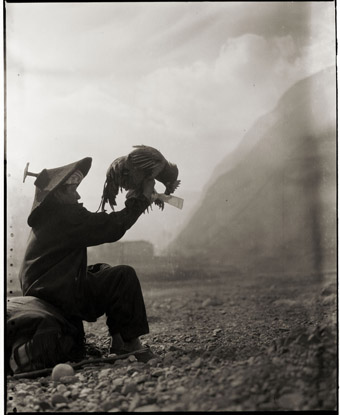
Witch and chicken, 2006, Adou
photo courtesy the artist
Witch and chicken, 2006, Adou
inner worlds
Like Rong Rong and other photographers of the 90s generation, the young artists on display in Points of Impact eschew broad social or political concerns, instead focussing on what Rong Rong describes as “their inner world.” In this sense the work of the Three Shadows Award winner is typical.
Ostensibly Adou’s winning series focuses on the Yi ethnic minority living around Da Liang Mountain in Sichuan. It’s difficult to convey the atmosphere of the large, highly textured black and white prints, and unfortunately reproductions do not adequately capture the nuances of Adou’s style. Unlike many earlier Han photographers, he does not attempt to romanticise a ‘primitive’ minority culture, nor is his work in any way an ‘objective’ ethnographic study. Rather, his images appear as fragments from a traveller’s dream. Faces emerge with sudden clarity while others remain hazy and indistinct, lingering on the edge of memory. The inclusion of photographic ‘faults,’ such as bubbles, flares, scratches and smudges—products of Adou’s habit of using expired stock—furthers the impression of an intermediate zone between past and present, reality and the imagination.
While talent scouting in southern China, Three Shadows curator Zhang Li discovered Adou selling his prints on the roadside. Back in Beijing, Rong Rong was immediately struck by the images. “I feel Adou’s work has the weight of time and history in it”, he enthuses. Rong Rong persuaded the unknown artist to reprint his photographs using hand-processing techniques, accentuating their foggy, textured quality. Adou’s appearance in Three Shadows’ Outward Expressions, Inward Reflections exhibition in 2008 marked his gallery debut.
In addition to the main Three Shadows Award, the Japanese Shiseido Foundation provided a RMB 20,000 (around AUD$3,600) prize to an emerging Chinese female photographer, which went to Beijing-based artist Zhu Hongling. Her set of eight slightly grainy black and white images of scenes around China were by turns amusing, grotesque and horrific.
Horse Head, Hebei Province, depicts an animal’s severed head lying on an empty patch of ground, its frozen lips stretched back in anguish. The sense of life’s frail impermanence forms a moving contrast to the blank, timeless observance of the surrounding hills. In opposition to this austere vision, Fat Woman on a Beach, Qingdao depicts an overweight lady facing a shoreline packed with bathers—an immodest picture of over consumption in a severely crowded land.
The most effective of Zhu’s images is Elephant Acrobat, Beijing, depicting a lone animal seen from afar, balancing on a stool in a sandy expanse below a hill. Apart from two small trainers looking on, the landscape appears devoid of human life, until tiny figures observing the scene from the hillside become gradually discernable. The photograph conveys a sense of loneliness as well as absurdity, like the forgotten remnant of a long departed circus.
Not all the works on display were of the same quality. A prize of US$5,000 and a fellowship provided by the USA’s Tierney Foundation went to Jiang Pengyi, whose colour photographs of abandoned objects on tabletops lacked the generative appeal of the other prize winners. Liu Yuan’s prosaic colour shots of buildings and nature strips were similarly uninspiring.
Despite the varying quality of the finalists’ work, many have attained a surprising maturity given their youth and China’s lack of support for the photographic arts. The talent unearthed by the award demonstrates the importance of an institution like Three Shadows in a nation where governmental controls and a newfound thirst for wealth leave little room for the idealistic pursuit of art over commerce. Crucially for the ongoing development of Chinese photography, Rong Rong and Inri have created a space where local and international photographers can exchange ideas and celebrate a plurality of styles free from obligations to state ideology.
Points of Impact: China Through the Eyes of Young Photographers, Three Shadows Photography Art Centre, Caochangdi, Beijing, People’s Republic of China, April 25–July 26
See a full interview with Rong Rong
RealTime issue #92 Aug-Sept 2009 pg. 16
© Dan Edwards; for permission to reproduce apply to realtime@realtimearts.net
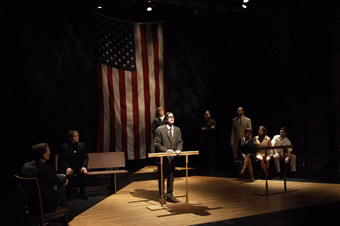
The Trial of the Catonsville Nine, The Actors’ Gang
photo Kim Zsebe
The Trial of the Catonsville Nine, The Actors’ Gang
LYNDON TERRACINI, SOON TO TAKE UP THE POSITION OF ARTISTIC DIRECTOR OF OPERA AUSTRALIA, HAS INVIGORATED QUEENSLAND’S ARTS FESTIVALS. HE QUICKLY REALISED THE DEMANDING VISION FOR A STATEWIDE, PARTICIPATORY EVENT, THE QUEENSLAND MUSIC FESTIVAL, IN 2001 AND RAPIDLY INCREASED THE NUMBER OF REGIONAL CITIES AND TOWNS PARTICIPATING IN 2003 AND 2005, ENTHUSING AND CAJOLLING MAYORS AND COMMUNITIES AND INTRODUCING THEM TO LEADING ARTISTS FROM ACROSS AUSTRALIA AS THEIR COLLABORATORS. THE LEGACY LIVES ON IN MANY OF THOSE TOWNS. TERRACINI ALSO GAVE THE CONSERVATIVE BRISBANE FESTIVAL A NEW LEASE OF LIFE, BROADENING ITS SCOPE TO INCLUDE MULTIMEDIA AND SITE WORKS, POLITICAL DISCUSSION, NEW MUSIC THEATRE AND A FRINGE SEASON, UNDER THE RADAR, REPRESENTATIVE OF A NEW WAVE OF YOUNG CONTEMPORARY PERFORMANCE MAKERS.
miracle in brisbane
A work central to Terracini’s 2009 Brisbane Festival program is Miracle in Brisbane, directed by Rhoda Roberts and featuring 25 Aboriginal, Torres Strait Islander and other artists, including Aaron Fa’Aoso, Deborah Mailman, Djakapurra Munyarrayan and Casey Donovan. The work, a largely wordless opera, “with music, dance and ceremony”, by Italian composer Giorgio Battistelli (of Experimentum Mundi fame), concerns homeless Indigenous people building a shantytown “on country” in Brisbane’s outskirts and at odds with developers. As you’d expect of Battistelli, the music of Miracle in Brisbane will in part come from the sounds of the performers constructing the shantytown to the accompaniment of The Queensland Orchestra and the Canticum Chamber Choir. Battistelli describes the opera as a “‘voiceless’ protest against inhumanity [that] highlights the incontrovertible rights of marginalised people to stake a claim in a world that ignores them.” His theme is hope.
Rhoda Roberts explained to me that Aboriginal people have long had a connection to the land on which Brisbane is built, and yet when they live on or visit it they’re seen as fringe dwellers or homeless— “We’re not, that land is our home.” When she visited Giorgio Battistelli in Milano she sensed a similar relationship between locals and the land and a “sense of purpose” that went with it. She saw the Milano performance of Miracle with its huge cast and was “struck by the expressiveness of the work, the way the music was embodied.” Roberts says that staging an opera will be a first time experience, for her and most of her talented cast, but clearly she looks forward to the creative opportunities it offers.
Battistelli’s open-ended approach to his opera has allowed Roberts to construct a local narrative for the work, a romance between an Italian cane-cutter immigrant (another marginalised figure, played here by a visiting Italian tenor) and an Aboriginal woman. The story unfolds against the construction of the shantytown with the “music of found objects and body percussion”, the voices of developers and the enforced silence of Aboriginal people.
On the festival’s ideas front, the hope theme is sustained in the person of this year’s guest Mary Robinson, former President of Ireland (1990-97) and United Nations High Commissioner for Human Rights (1997-2002). Her talk is titled: “Creating a World without Poverty: Social Business and the Future of Capitalism.” The hope inherent in fighting for one’s beliefs is portrayed in the Los Angeles-based Actors’ Gang performance of The Trial of the Catonsville Nine. It’s about the prosecution and trial of Catholic priests and activists in 1968 who burned draft cards with napalm in protest against the Vietnam War.
new circus
Innovative new circus in the program is represented by two works. Regarding the Joy of Others, is a premiere from Brisbane’s globe-trotting CIRCA, performed on the giant Brisbane gasometer at Newstead Riverpark by aerialist Chelsea McGuffin to a sound score by Lawrence English and direction by Yaron Lifschitz. L’Oratorio d’Aurélia, from French company L’Oratorio is a fantasy inspired by images from the Middle Ages with actress and acrobat Aurélia Thierrée: “Body parts disengage and even disappear, only to be knitted back together again, puppets attack their masters, while clothes, furniture and clattering toy trains come alive.”
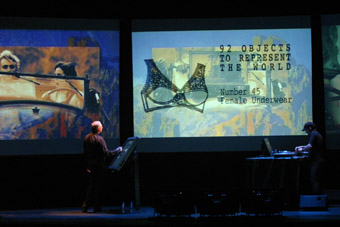
Peter Greenaway, Tulse Luper Suitcases
peter greenaway
With DJ Radar (Serge Dodwell) and electro-acoustical composer Huibert Boon, Peter Greenaway presents his major and much-travelled, large plasma touch screen work, Tulse Luper Suitcases. It’s a technical and aesthetic creation that allows the artists to VJ “the life of the Welsh writer and perennial prisoner Tulse Luper who archived his entire life in 92 suitcases.” There’ll also be a retrospective of Greenaway’s films and he’ll deliver a lecture on his documentary, Rembrandt’s J’Accuse.
total nowhere emotion expansion
In a 2009 festival innovation audiences will be able to view a media art exhibition, Total Nowhere Emotion Expansion, either online via the festival website or live at a mobile media art gallery, once a semi-trailer, travelling within Brisbane and South East Queensland locations. The eight international artists include Australians Darren Sylvester and Jemima Wyman (whose eerie video works featured recently at KickArts Gallery in Cairns) and the Philadelphia-based Ryan Trecartin, maker of a much praised feature-length video work I-Be Area, described by the New Museum, New York, as narratives that “ricochet between characters and actions, gleaning information and enacting existential dramas at hyper-speed. His characters, all constructed collaboratively with his actors, include independent avatars, people composites, culture collectors, and cyber queers—all twisted and true emblems of what the artist calls ‘a potential part-cyber today’” (www.newmuseum.org).
The full Under the Radar fringe program will be announced this month, but advance notice includes Sunny Drake’s Other-wise, Robert Millet’s Vodka & Truth, and Genevieve Trace’s misuse of a comma. Drake’s experiences as a queer/transgender individual, a traveller, a romantic, a teacher and a performer are central to his solo performance in a festival that argues for freedom, often from unexpected angles.
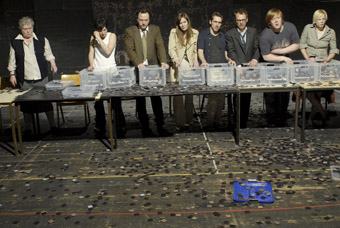
Pornography, Deutsches Schauspielhaus Hamburg
photo AT Schaefer
Pornography, Deutsches Schauspielhaus Hamburg
melbourne international arts festival 2009
Brett Sheehy’s first Melbourne Festival is strong on visiting contemporary performance, theatre and dance if low on Australian content relative to the Robyn Archer and Kristy Edmunds years. Berlin-based Sasha Waltz and Guests in their long-awaited first Australian visit will perform two works: the celebrated Körper (RT90, p10) and a dance-opera Medea with one singer, coloratura soprano Caroline Stein, text by Heiner Muller, music by Pascal Dusapin played by the Melbourne Symphony Orchestra and Vocalconsort Berlin, 17 dancers and video by Waltz. Deutsches Schauspielhaus Hamburg’s production of British playwright Simon Stephen’s Pornography comprises seven narratives about Britain under attack from both terrorism and “the pornography of the everyday.” Belgian company Le Salon’s much anticipated Peeping Tom fuses theatre, dance and song (from mezzo-soprano Eurudike De Beul). Like Stephens’ Pornography it portrays a culture in decline, here exemplified by a family falling apart and revealed in images alternatively melancholic, savage and surreal.
‘Surreal’ is always apt for most things written by Lally Katz. In Apocalypse Bear Trilogy (directed by two of its performers, Luke Mullins and Brian Lipson) for Stuck Pigs Squealing, the internet has absorbed all memory and conjured up a seemingly amiable bear to help you out in any difficult circumstance. Perhaps the bear is a metaphor for the net—wilder than we think or an accident just waiting to happen. Another lateral look at the everyday is stage designer and installation artist Anna Tregloan’s The Dictionary of Imaginary Places, for Store Room Theatre with sound composer and designer David Franzke. Tregloan and Franzke’s work together on the Bell Shakespeare Venus and Adonis and Ranter’s Holiday is evidence of a potent creative partnership. For the new work, the pair rode trains, recorded conversations and “shaped and edited them into poetically built theatre which complements them with startling visuals and extended physicality.” Real life gets another look-in in Vanessa Van Durme’s Look Mummy I’m Dancing, a frank personal account of gender change in 1970s Belgium.
Peter Greenaway will present his 20-minute multimedia installation Leonardo’s Last Supper replete with large screens, soundscape and a reconstruction of the table, from the painting, where Christ announced that one of his disciples would betray him. In Melbourne’s Planetarium, writer-performer Alicia Sometimes will bring together poets, sound and video artists (Ai Yamamoto, Lawrence English, Nat Bates, Mim Whiting, Rob Kennedy, Chris Nelms) and science writer John Gribbin for reflections on the cosmos. For a different look at light, our writers in Vancouver and Hobart recommend UK artist Ray Lee’s immersive and surprising installation, Siren (RT91; RT90)
The festival will premiere a new Black Arm Band work, dirtsong, that ambitiously sets texts by the Miles Franklin Award-winning Indigenous novelist Alexis Wright to music alongside traditional and popular songs from Ruby Hunter, Shellie Morris, Archie Roach, Dan Sultan, Kutcha Edwards and Lou Bennett.
Chunky Move once again reveals its openness to innovation, this time in Black Marrow by collaborating internationally with leading young choreographers Erna Omarsdottir (Iceland) and Damien Jalet (Belgium), Australian/Icelandic composer Ben Frost and lighting designer Nicholas Pajanti with set and costumes from Belgian visual artist Alexandra Mein. Set in “a place where civilisation has not quite arrived, or has ceased to exist long ago” Black Marrow focuses on extreme states and “undefined aspects of human identity.”?More on Black Marrow in RealTime 93.
The temporal displacements and projections of Black Marrow, Pornography, Elemental, Apocalypse Bear Trilogy and The Dictionary of Imaginary Places along with Black Arm Band’s meeting of past and present and the forensics of Korper, Medea and Leonardo’s Last Supper suggest, for festival-goers, a high likelihood of altered states of mind—about society now and the artforms with which we explore it.
Brisbane Festival 2009, Sept 12-Oct 3, www.brisbanefestival.com.au
Melbourne International Arts Festival, Oct 9-24; www.melbournefestival.com.au
RealTime issue #92 Aug-Sept 2009 pg. 18
© Keith Gallasch; for permission to reproduce apply to realtime@realtimearts.net
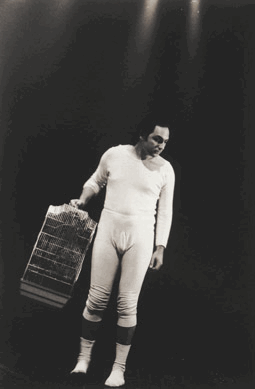
Jeff Stein, Cross Cuts, Performance Space, 2002
photos Heidrun Löhr
Jeff Stein, Cross Cuts, Performance Space, 2002
THE ATMOSPHERE AT HEIDRUN LÖHR’S SHOW AT CRITICAL PATH IS REVERENT, “ALMOST SPIRITUAL” SOMEONE SAYS. IT’S BEEN A WHILE SINCE I’VE ATTENDED AN EXHIBITION WHERE THE OPENING NIGHT AUDIENCE HAS TO BE PRISED AWAY FROM THE WORKS TO HELP THEMSELVES TO DRINKS.
Heidrun Löhr is acknowledged as the pre-eminent photographer to Sydney’s performance scene and tonight she invites us to see our shared history through her eyes. The vast expanses of the Drill Hall are moodily lit by projections. On hanging scrolls, 20 years of dance/performance history slips by in some 700 slides shown singly and in digital sequences. Her selection begins with Leisa Shelton’s The Girl Who Could See Air at the Toy Factory in Leichhardt (1989) and concludes with Running Behind Times (2009), a work she’s creating in collaboration with performer Rosie Dennis in the St James Railway tunnel. Four gently humming slide projectors are formally positioned on a line of plinths down the centre of the room. Composer Gail Priest’s delicate “Memory Machines” enhances the collective reverie.
In 2007 Heidrun Löhr received a two-year Australia Council for the Arts fellowship to catalogue and digitally transfer her photographic archive. Earlier this year, as the inaugural Artist in Residence at Critical Path she and director Margie Medlin hatched the idea of exhibiting an instalment from the archive representing an important part of the contemporary history of dance/performance in Sydney.
Equally surprised at the response to the installation Löhr modestly suggests, “A lot of the audience was also in the images so there were lots of personal memories and more collectively of the performance community…and the sound held it all together.” I ask how she decided on the installation format. “My archive is based on slides and negatives and film—analogue technology. Of course, I switched to digital some years ago, but it occurred to me it would be interesting to have both technologies together because the archive has changed enormously over the last few years as well. Also at that time Russell Emerson at the Department for Performance Studies told me he’d just got hold of 13 slide projectors that some other university department had thrown out. I thought, great, I’ll use those!”
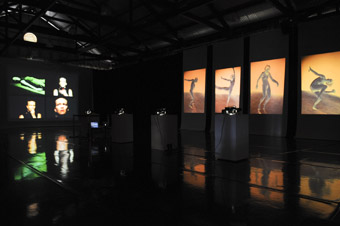
Fiona Malone, Ros Crisp in Projections, Heidrun Löhr
photo Heidrun Löhr
Fiona Malone, Ros Crisp in Projections, Heidrun Löhr
“I wanted to have the images not on the usual projection screens. The Drill Hall is so high and I thought it would be beautiful to have a scroll hanging down. Always the idea was to work with sequences and with single images. Gail came in and taped the sound of the projectors and we talked about nostalgia. The rhythm was important to me—the rhythm of the slide show and the rhythm of the sequences.”
Asked how she selected from so many possible images, Löhr replies, “I had a look at the Drill Hall and I thought I could do something incredibly small or very big. I decided on big. Big prints are expensive so I thought about projections, also because performance is a very ephemeral art. With projections you turn off the electricity and it’s all gone. So it somehow seemed appropriate. My choice was always based on movement. That was the focus that eventually held it together.
“For me it also has to do with performance photography. I don’t (simply) document so much as interpret a work. I decided to include a number of blurry images, the ones that aren’t usually printed or published, so a broader audience is not seeing them. As a photographer I’m working with light and the performers leave traces of light and the more they move the more traces there are. And, of course, I work with the lighting designer because I work with his or her light. Also I wanted to show more than one image of the work of one dancer or performer. For instance, you see Jeff Stein at Performance Space in Cleveland Street in 2002 and then again at Night Time in 2008 at CarriageWorks. In some of the sequences there’s just a small time lapse in between the development of a movement or gesture and sometimes the movement is quite ferocious.
“There’s a sequence of photographs from Force Majeure’s Already Elsewhere (2005) with the dancers on a roof. While I was photographing the dress run, I had the shutter open for quite a while. So you see the bodies travelling through space and time. They become quite abstract. There’s a certain beauty in it. Perhaps it’s also a desire on the part of the photographer to move away from reality. We always somehow need reality, not like a painter who can just make something up.”
Another spin-off from the Archive Project for Löhr is a developing interest in animation. “I’m working with Rosie Dennis and also with Nikki Heywood. Within 5 days, I took about 3000 images in the apartment where Nikki’s mother used to live until she had a number of falls and had to move into a nursing home” (see page 55).
We talk about the future of the Archive. “It was fantastic to have the fellowship. When I wrote the proposal, I was not aware how time consuming it would be. I’m working in collaboration with the Fisher Library and the Department for Performance Studies. Over those two years I have continuously gone through the proof sheets. I started with 2000 but then I went to 1990. Each year has five or six folders. In each folder there are approximately 100 films, 100 proof sheets, 35 images each. Between 1 and 6 will be good ones. I choose the images I think are interesting, ‘representing’ the work and then I write all the information. The problem has been finding someone to scan these images in because the archive will be digital. We’ve found someone in Adelaide who can do it but it’s quite expensive so the Fisher Library will need more funding. So I created this brochure on The Archive Project to go out to potential sponsors like Nikon—I’ve used a Nikon camera all my photographic life. I have about 500 images we will send to Adelaide and these 500 slides or digitalised negatives plus digital material will act as a trailer on the library’s website. All this will hopefully happen by the end of the year or early next year.” For the time being the archive is held at the Department for Performance Studies.
Heidrun Löhr’s archive is of great historical and educational importance, her striking images evidence of Löhr’s deep connection with the work she has lovingly photographed over the decades. Of course, she continues to do so as the pages of RealTime regularly attest. Its documentary function aside, the collection also represents a powerful body of work from a significant Australian artist.
Projections, The Archive Project Heidrun Löhr, Critical Path, The Drill Hall, Sydney, May 13-17
RealTime issue #92 Aug-Sept 2009 pg. 20
© Virginia Baxter; for permission to reproduce apply to realtime@realtimearts.net
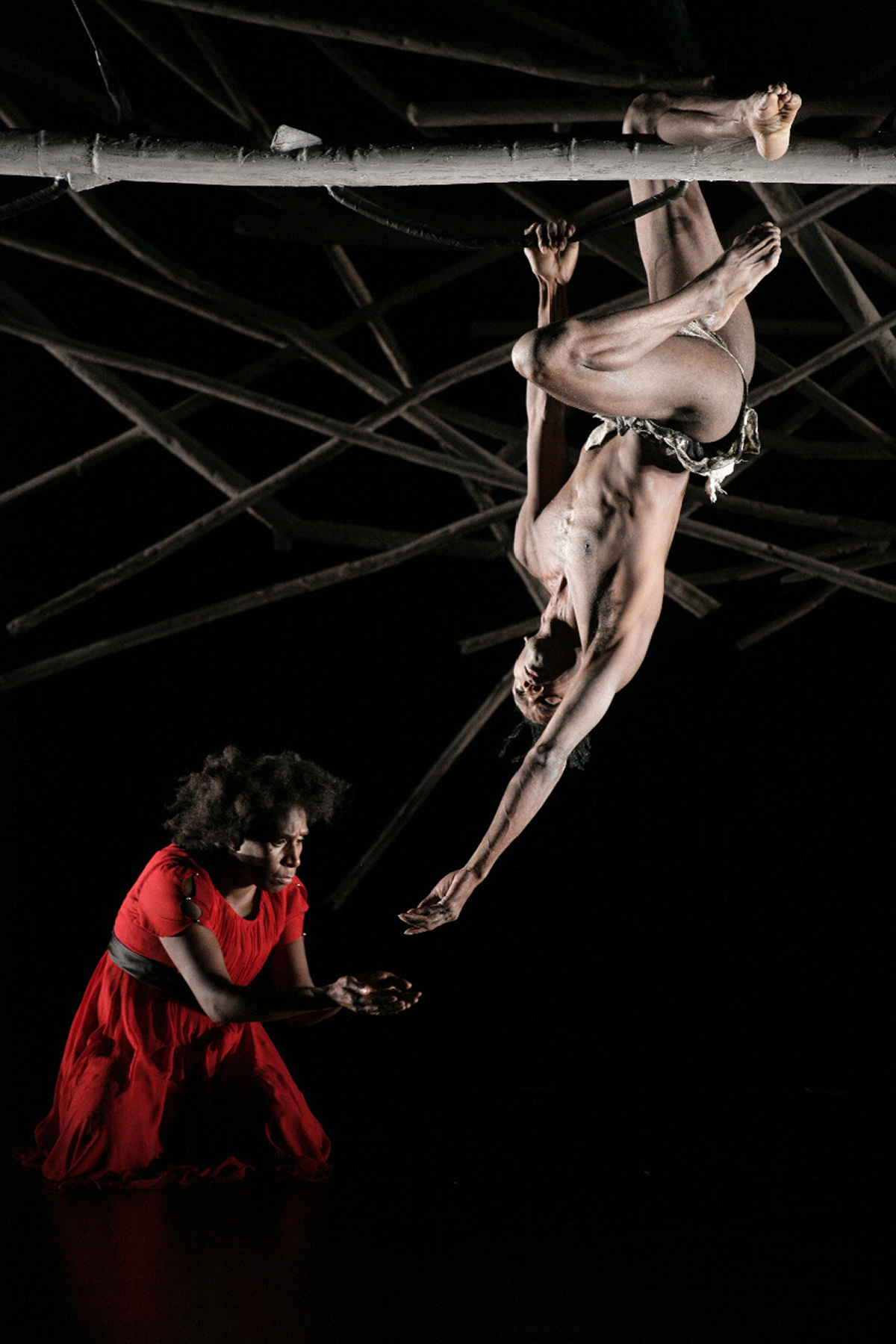
Elma Kris, Patrick Thaiday, Mathinna, Bangarra Dance Theatre
STEPHEN PAGE HAS BEEN ARTISTIC DIRECTOR OF THE 20-YEAR-OLD BANGARRA DANCE THEATRE SINCE HE WAS 25. “I CAN’T SAY IT’S BEEN A FLAWLESS 20 YEARS”, ADMITS A PHILOSOPHICAL PAGE. “BUT I THINK WE’VE PLAYED THE CARDS WE WERE DEALT PRETTY WELL. WE’VE BEEN HONEST PLAYERS; NEVER GOING INTO DEBT, FULFILLING OUR CORE FUNDING RESPONSIBILITY TO TAKE OUR DANCE INTO RURAL OR REMOTE COMMUNITIES AND OUR 20% FOR INTERNATIONAL TOURING.
“It’s overseas we regularly sell out 1,000 seat venues—and help to get the Australian Ballet into the Chatelet (in Paris)! But, back home, there’s no signage at The Wharf saying Bangarra Dance Theatre; it just says Sydney Theatre Company and Sydney Dance Company! Perhaps we’re a little too national for our cultural masters in NSW?”
The Stephen Page who’s just a little chunkier than he was as a kid from Brisbane, dancing with first the National Aboriginal and Islander Skills Development Association (NAISDA) then the SDC, may have “given up on his ego 10 years ago”, but he’s not given up on his feistiness.
Interestingly, 10 years ago Page was just about at the peak of his fame. He’d already done the Atlanta Olympics flag hand-over to Sydney with its memorably mad roos on bikes; he was poised to choreograph and co-direct the Awakening segment of the Sydney Olympics with “one thousand old myalls from the Desert” and Donny Woolagoodja’s amazing Wandjina rising from the earth; and he was about to be delivered the Artistic Directorship of the 2004 Adelaide Festival. And Bangarra was involved in all of them—you don’t get Stephen Page without his clan. It’s just a crying shame that we couldn’t have had that 2004 festival without the baggage left over from Peter Sellars’ chaotic 2002 festival. Page’s hands were tied. Which, in a sense they have been since birth. Page’s Aboriginality is both his total raison d’etre and a cross to bear. We talked far more about that than dance; dance is easy compared to “negotiating the cultural protocols between North and South—sharing all the mind-fuck stuff with the full-bloods and really digging into the wonderful complexity of Aboriginal culture. White people are always resisting that complexity—it’s so much easier to kill it off.”
“But it is an effort to maintain that complexity”, Page continued, “the protocols especially…things like whether Djakapurra (Munyarryun, the Yolgnu leader from Arnhemland who was cultural consultant to Bangarra for many years and went on to star in the Olympics Opening) could sing a healing song with no proper dance connection, with lights and with the wrong costumes. But working for the survival of our culture is what we have to do. And it’s worth it when a company like the Commonwealth Bank comes aboard as a sponsor of Bangarra to learn something about the protocols from us—dealing with cultural respect.”
Then came the old feist again: “I knew from Ochres I’d got it right.” Didn’t we all? I caught that breakthrough work during its initial five-day tryout showing in 1994 and raved: “(It) simply blew the socks off as it slipped so comfortably from the domestic to the mythic—and back again—making dancers invisible in the internalised intensity of their performance, then transforming Arnhemland’s chalky ochre shield against the evils of the night into ordinary urban make-up as they re-humanised” (Sydney Review, Nov, 1994).
Last year, Page must have continued to get it pretty right—his work, Mathinna about the young 19th Century Tasmanian Aboriginal girl, torn between two cultures as the Governor’s wife took her in, has just won Helpmann awards for Best Choreography, Best Dance Work as well as Best Original Dance Score.
How come Stephen Page himself isn’t just as torn between two cultures—torn and then spat out? It’s often reported that the “great robber in the making from the Bronx of South Brisbane” (his own words) turned his life around with a single visit to Yirrkala in Arnhemland—’discovering’ traditional Aboriginal culture in the hands of the Yunupingu, Marika and Munyarryun families. In fact, Page wants to make it clear that his full-blood father’s family from the Munaldjali clan of the Yugambeh tribe, once at Beaudesert—not to mention Nunukle cousins on his Mum’s side—often gathered for fishing, campfires and music, and, above all, stories. “They weren’t traditional myths”, admits Page, “but we found out where the landmarks were. They were rekindling what had been taken away—with nuances of the spiritual connections.”
“The politics came later.” Page was referring to his time at NAISDA, where the students all wore black, red and yellow headbands, went on many marches and pickets, and had lectures from Charlie Perkins, Gary Foley and the Bostocks. Even the dance was political in the hands of Black American modern dance-trained tutors like Carol Johnson and Cheryl Stone. “They were using art as a medicine, or an ingredient in their politics.”
But what Page calls his “solid roots” came from the North. “Philip Lanley from Mornington Island was the first Djakapurra—creating a melting pot out of an honest exchange of culture.” But the Yirrkala connection had started for Page even earlier, in 1984, and there’ve been four stays since. “We still send our young dancers to Dhalunbuy to knock some of the wonderful arrogance out of them. And we went to the Torres Strait recently—taking some of their stories back to them in dance. Afterwards, the old people cried, thanking us for hanging on to their stories so that their kids would want to inherit them.
“We’re a little satellite pod entrusted with their stories—taking them into the 21st century. That’s what matters—not the Kennedy Centre or the Chatelet. If we lose that circle of connection, we should close down and head for the sacred cave.”
The North/South connection doesn’t always work, of course. Several of the tutors simply “couldn’t hack” living in the city. And even such an assiduous worker on the protocols as Page finds himself “still discriminated against by the traditionals today—we’re not really Black enough for them. They see the stories being stolen from them. But I belong to the heritage of this land—it doesn’t matter that I’m not a full-blood. What matters is where I come down on the big debate today—is the Black perspective equally valid to the white one? Why was my old Dad—the best concreting man in South Brisbane—never given the chance or the money to develop his own business? He still thinks he has to work today to validate himself, and he’s 80.”
“And why is the Australia Council so hopeless with Indigenous art? It’s just a commodity for them—the Australian identity to wave like a flag overseas. But what is the essence of Oz without it? OK, membership of AMPAG (Australian Major Performing Art Group) has given us security and the potential to follow our own dreams. But it’s bloody challenging to make up all those business plans!”
Page would rather channel his energies into Fire, the retrospective work that tours the East coast August to November to celebrate the 20th anniversary of Bangarra (a word meaning “make fire”). “How do I pay homage to 100 dancers and more than 30 clan elders who’ve been our history?”, he wonders. None more so than his brother Russell—who, like David the composing brother actually preceded Stephen into Bangarra—but died at the height of his powers. “We can only show him on screen, sadly”, explained Page. “But we’ll have a Black Gala at the Opera House, and bring all the others back.”
“I need to use the celebrations to bring our people together”, he concluded. “Our politicians are just so exhausted living a schizophrenic life fighting white power. We need to get Black leaders together four times a year—we need to talk. Because Bangarra’s with AMPAG, for instance, I never talk to Lydia Miller (Director of Aboriginal & Torres Strait Islanders Board in the Australia Council). I don’t know why there are no sister dance companies for Bangarra across the country, no [sister theatre and music companies]?…Why doesn’t Aboriginal culture get more than multimedia? Why am I one of so few who are fortunate enough to be able to create in my own cave, with a stream of youngsters wanting to tell their own stories to me, now that I’m the elder?”
–
Bangarra Dance Theatre, Fire, Sydney Opera House, Aug 28-Sept 26; QPAC, Brisbane, Oct 7-10; Civic Theatre, Newcastle, Oct 30-31; Playhouse, Arts Centre, Melbourne, Nov 6-14; Canberra Theatre Centre, Nov 20-21
RealTime issue #92 Aug-Sept 2009 pg. 22
© Jeremy Eccles; for permission to reproduce apply to realtime@realtimearts.net
The Federal Government’s Excellence in Research for Australia scheme, which will, for purposes of promotion and funding, credit artist-academics for their creations, and the ArtStart initiative, which will fund recent creative arts graduates towards realising their careers, are both still formative but will be quickly implemented. They have been welcomed with a mix of relief, optimism, scepticism and anxiety by academics and artists. As the writers for our 2009 arts education feature quickly discovered, it is going to be difficult to have ERA evenly applied, or for peer review criteria and methodologies and journal rankings to be uniformly agreed to. Then, for the performing arts there’s a need for ERA to recognise the importance of collaboration and interdisciplinary practices—some of our interviewees propose a science or social science team-based research model rather than a humanities-based one. Flinders University has been working on developing a collaborative postgraduate feature filmmaking model. Anxiety over ArtStart is focused on a national arts infrastructure inadequate to meet the long-term employment needs of ArtStart grant recipients, once over 30 years of age, and the thousands graduating annually in creative arts, let alone older artists working hard at survival. Meanwhile the issue of artists on welfare and their standing with the Australian Taxation Office will remain unaddressed, supplanted by yet another grant scheme. The creative arts seem set, at long last, to be formally recognised in the tertiary education sector, but is there an ‘arts industry’ and the arts infrastructure sufficient to support those it nurtures? On the other hand some of our respondents fear that ArtStart will too easily adopt identifiable goals around ‘business’ and ‘vocation’, neglecting, as one academic puts it, the requisite ‘meaninglessness’ of art. ERA and ArtStart represent very welcome, major changes in Federal Government attitudes to the arts but, as ever, the significance will reside in their implementation.
RealTime issue #92 Aug-Sept 2009 pg. 1
© Keith Gallasch; for permission to reproduce apply to realtime@realtimearts.net
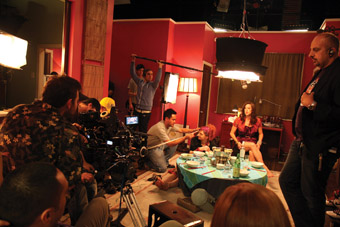
students from AFTRS and NIDA on the set of their co-production, One More Day
courtesy of Australian Film,TV and Radio School
students from AFTRS and NIDA on the set of their co-production, One More Day
IT’S WHAT COULD BE CALLED AN `INTERESTING’ TIME FOR THE LOCAL FILM INDUSTRY, WITH THE NEW PRODUCER OFFSET IN OPERATION AND SCREEN AUSTRALIA UP AND RUNNING. BUT HOW IT’S ALL GOING TO WORK AND WHAT IT’S GOING TO PRODUCE IS STILL TO BE REALISED. THIS PERIOD OF UNCERTAINTY IN THE LOCAL INDUSTRY IS REFLECTED IN THE FILM INDUSTRY AS A WHOLE, WHERE BIG CHANGES ARE BEING BROUGHT ABOUT BY TECHNOLOGY, THE GLOBAL FINANCIAL CRISIS, AND EVEN BY THE WAYS IN WHICH PEOPLE EXPERIENCE FILM.
It’s not surprising, then, that the screen production education sector is also experiencing a sense of change. At two conferences in July the topics centred on new methods of assessment, new terminologies, ways of using the new technologies and ways of working with the new ERA (Excellence in Research for Australia) regime for universities which credits academic staff for their creative output. The sector’s relationship with the industry, and the need to establish a better dialogue between the two, was also highlighted.
aspera: beyond the screen
Beyond the Screen, the 2009 conference of the Australian Screen Production Education and Research Association, held in Adelaide, is ASPERA’s annual forum for academics within the Australian screen production field to discuss shared issues and exchange ideas. As the outgoing president Leo Berkeley said, “since it began in 2004, the ASPERA Conference has had a major impact on the profile of screen production education…(bringing) into sharp focus the scale and significance of a discipline that had previously been receiving far too little attention.” With screen production programs now forming a major component of the tertiary creative arts sector, co-convenors Alison Wotherspoon and Jennifer Stokes talked about “the balance ASPERA strikes between industry, research, teaching and learning” and the opportunity it presents to look at the way “screen and media courses are multiplying and converging in many universities, the challenges we are facing as creative practice researchers, and the impact of the economic downturn on often fragile budgets.”
media arts congress
At the Media Arts Congress, held in Melbourne, a panel discussion was held to address the way in which practice-led researchers could have their creative works recognised under the new ERA regime. Senior Lecturer Alison Wotherspoon, from Flinders University, says that it seemed from the discussion that “finally everything was working towards an understanding of film as creative work, of practical outcome research.” However, she wonders whether such research “should be more aligned with the social sciences, where everyone is part of a team, and everyone’s name is on the project. Film, as a collaborative medium, would seem to fall more naturally into that alignment.”
assessing creativity
The problem of assessing image-based work, generally considered to be subjective and therefore difficult to measure and evaluate, is something that is being addressed by several projects, especially a large-scale one headed by Dr Josko Petkovic from Murdoch University, in which a team of researchers from five ASPERA institutions will test 45 short productions from 19 film schools. Currently, students in Australian film schools have a qualitative form of assessment; the aim is to “accumulate a body of evidence that will demonstrate in quantitative and qualitative terms that evaluation of creative works is as consistent as evaluation conducted in traditional discipline areas.”
Associate Professor Gill Leahy from UTS (University of Technology, Sydney), in her paper at the Media Arts Congress, argued that it’s possible to establish guidelines for assessing screen production works, group work, peer review standards, festival and publication standards, that equate with more conventional scholarly output. She compared and contrasted criteria used to assess creative work at four universities in a preliminary study, working towards a model for criteria for the assessment of screen-based work.
As Alison Wotherspoon says, “there is a need to establish criteria by which to evaluate film—it needs to have some sort of peer review process. Where written work has publication in peer-reviewed journals, film could use acceptance by festivals, events, awards. But such criteria need to be quantified, to establish the standard expected for an MA, or a PhD.”
The relationship between the screen production education sector and the industry is one that needs to improve. Wotherspoon, as newly elected president of ASPERA, argues that universities could play a larger role, especially in connection to research in an industry that is seen as statistics rich but research poor. She says that ASPERA believes there should be a role for universities in industry research; with18 universities teaching screen-related courses, they could identify issues relevant to the industry, and students could approach them as graduate projects.
As Wotherspoon says, “it’s interesting that research in the film industry into relevant areas seems to be lacking; TV has got its act much more together, especially about audience research and about what the audience wants.” (Screen Australia has just announced details of its marketing support to the industry, but there doesn’t seem to be any research planned into audience and, especially, into the disconnect between Australian audiences and Australian films.)
skills shortage
Gill Leahy comments that Richard Harris, CEO of the South Australian Film Corporation, said at the ASPERA conference that what the industry really needs is first assistant directors and continuity and make-up people, and that universities are not supplying them. She believes that what are really needed are mentorships and attachments to such specific areas. “They could work very well, as the students would be insured by their university while they are still students, which could allay some costs.”
Alison Wotherspoon agrees. As she says, “the industry wants people who’ve been trained, but there’s no money in training, and the organisations that used to train large numbers of young people—the ABC, Film Australia—don’t do so any more. But if universities and the industry developed a more integrated relationship, part of an honours year could be an internship, whereby the student could learn the craft, and the university would cover the insurance. We need to have conversations about these possibilities, get recognition from the industry that this would be a sensible and mutually rewarding development. It’s understandable that people are still threatened by the idea of free labour (although the industry has always operated with a system of attachments and learning-on-the-job placements), but the industry has an ageing workforce; this is an issue that has to be addressed.”
the phd feature film
While students in screen production courses have always made short films in various formats, the production of feature films is a new and emerging trend. Flinders University has a practice-led low budget feature being made by three PhD students. The project addresses a number of different research questions about writing, financing and how such a project would work in the university environment, and the making of the film will contribute towards the doctorates. The three main people involved are working as writer, director and producer, and each has a separate area of research, while a number of undergraduates who work on the project will also be credited. As Wotherspoon explains, “this model has the potential to develop into a PhD program, using different mixes of participants.” As she says,”universities provide great models for student creative collaboration; at university you can try something and fail, and what you learn from that is important, you learn to make something better. But that failure is not exposed to public scrutiny.”
new formats, new audiences
However, Wotherspoon doesn’t agree that emphasis should only be on feature films. She argues that, “there is a greater need for screen content than ever before, but it covers a wide range of content style, use and format. Theatrical release might still be the jewel in the crown, but there’s an ever-increasing, younger audience which has a very different relationship with the screen, and what they want is woefully under-researched and little known.”
Wotherspoon also argues for the importance of the craft of making educational and training documentaries, which are actually more in demand in the new world of online education. “If a short film on an issue fills a need, it can go on being used for a long time, and can eventually be seen by far more people than a feature film”, she says.
aftrs transformed
The Australian Film, TV and Radio School is well into the first year of the dramatically changed course structure that accompanied the school’s move to Fox Studios. AFTRS Director of Screen Content Graham Thorburn says that the changes have really transformed AFTRS, “the energy and activity is amazing.” He reports that students are currently making a feature film [pictured above]; “81 students volunteered, it was shot in their four-week break (on the RED camera) and is currently being edited, with an October 26 screening planned. All NIDA’s graduating students have a speaking part (and that was a challenge!), and it is made up of four stories with an overarching connection.”
AFTRS is including in production and small business courses its analysis of the producer offset and how it works. “We see the division in the industry becoming more pronounced, with high budget productions, often with some overseas money, using a Hollywood style production method, and a low budget, very local production style. So we’re trying to teach how to make compelling stuff for less money”, Graham Thorburn says, adding that AFTRS should exist alongside and complement industry experience.
“We’re concentrating on story, without ignoring AFTRS’ traditional contribution to technical excellence. Our focus is on finding and developing great screen storytellers. The writing course restructure (divided into intermediate level and advanced) has made it more accessible to people with life experience, and this year’s intake included a number of people with existing credits as novelists or journalists, who already could write.” That’s for the intermediate program, which is six-months part-time taking place in Sydney, Brisbane and Melbourne. “The idea is for them, when they’ve finished the intermediate level, to go off and do some work, and come back when they’re ready to enter the advanced level.”
AFTRS is about to appoint a national director for its Open Program. Graham Thorburn says, “we want the courses to satisfy the demands we know are out there, demands from both television and film, for the specific skills that are needed. We’re hoping that some courses will start later this year all around the country, but there will be a big summer school in Sydney.” AFTRS new foundation diploma is at more of an entry level, and has 52 students this year, probably 100 next year. “It’s constructed around intense two week workshops—before you’re ready to decide what specific role you want to follow— and it’s not discipline based but provides a focused look at specific aspects of filmmaking—things like story and audience, character, script and performance, juxtaposition and rhythm, distilling the essence of ideas.”
Thorburn adds, “We’ve been approached by some universities to discuss the possibilities of students doing the AFTRS foundation diploma and then going into the second year of a related university course. Otherwise, we anticipate our foundation diploma graduates will go off and work in the industry, and come back to AFTRS when they’re ready to specialise.”
the future: symbiosis
Clearly, with the impact of ERA, the growth of creative post-graduate and film school student feature filmmaking alongside work in new formats, there is potentially a richer interplay between the tertiary education sector and the film industry. It will require discussion, negotiation and, within universities, a realistic approach to the complexities of peer review of creative output.
RealTime issue #92 Aug-Sept 2009 pg. 23
© Tina Kaufman; for permission to reproduce apply to realtime@realtimearts.net
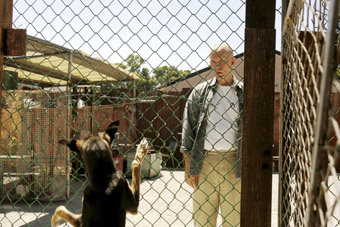
John Malkovich, Disgrace
JM COETZEE’S 1999 BOOKER-WINNING NOVEL DISGRACE HAS, LIKE MOST OF HIS WRITINGS AND LECTURES (READERS TEND TO HAVE A LOVE/HATE RELATIONSHIP WITH THE WRITER), DIVIDED AUDIENCES WITH ITS PORTRAYAL OF A BITTER, AGEING ACADEMIC, DAVID LURIE, FORCED TO RESIGN AFTER AN AFFAIR WITH A STUDENT. RUNNING FROM CAPE TOWN IN THE HOPE OF WRITING AN OPERA ON BYRON (RATHER THAN OUT OF ANY FEELING OF WRONG-DOING; THE DISGRACE COMES LATER), LURIE VISITS HIS DAUGHTER LUCY, LIVING ON AN ISOLATED FARM, AND EXPERIENCES THE DEVASTATING EFFECTS OF AN ATTACK BY THREE LOCAL MEN WHO RAPE HER, BEFORE SETTING HIM ALIGHT WITH METHYLATED SPIRITS. IT’S A WORLD WHERE WHITE SOUTH AFRICANS ARE THE OUTSIDERS LOOKING IN, DEPICTED AS ‘OTHER’, ALMOST A PLAGUE ON THE LANDSCAPE.
Director Steve Jacobs and writer-producer Anna Maria Monticelli acquired the book rights early on and the resulting film, shot on location in South Africa, is beautifully adapted and directed, restrained and subtle (after the same team’s vivacious La Spagnola) with Malkovich given the difficult task of bringing his masked character to cinematic life—without the help of a voiceover. From the opening scene I was worried about the casting. We always seemed to be approaching Malkovich from behind. As he peered out through vertical blinds in his bourgeois apartment or delivered lectures on Byron to zoned-out students, the camera was placed as if hiding from him, zooming in on the back of his head. All I could think about was Being John Malkovich, where the characters took the funpark ride of a lifetime into the portal of Malkovich’s brain. While Spike Jonze and Charlie Kaufman’s film remains a favourite, it has almost spoiled forever any power Malkovich had over me as an actor—that effete voice, the soft lisp, the limp walk. And here, Malkovich at first appears to be being-John-Malkovich-being-David-Lurie, but as we both warm up he inhabits Professor Lurie and almost makes him sympathetic—easier without the novel’s access to the inner-workings of Lurie’s bleak-mindedness (there’s a portal I wouldn’t want entry into).
He remembers Melanie, on the first evening of their closer acquaintance, sitting beside him on the sofa drinking the coffee with the shot-glass of whisky in it that was intended to—the word comes up reluctantly—lubricate her.
Lecherous academics have become clichés in literature and film. They usually have beards, wear tweed and read Wordsworth (cue opera music in background) and Coetzee pleads guilty in some aspects to the lecturer-as-pretentious-wanker label. Isabel Coixet’s Elegy (also based on a novel, by Philip Roth), released earlier this year and starring Ben Kingsley and Penélope Cruz, broke the mould, exploring the dynamics of such a relationship with finesse and empathy for both points of view. In Disgrace, things are more clumsy, both on the page and on screen. Lurie’s motivation for the affair with his student, Melanie, is unclear beyond the obvious; she’s young and beautiful. But as they make love she’s portrayed as unyielding, stiff; there’s no sense that she’s a willing participant. And perhaps, what Lurie doesn’t want to articulate, is that this conquest is the first step along the path to a self-destruction he craves anyway. The later scene where he meets Melanie’s younger sister (and we’re talking young here), Desiree, has an undercurrent of unease with his lascivious longings bordering on paedophilia. While he’s apparently visiting the family to apologise and gain some sort of redemption, in the book at least it’s clear that meeting this young girl carries for him a real erotic charge.
This recycling of power within relationships—given, taken away, renegotiated—is beautifully paralleled in Lucy’s story (a sharp performance by newcomer Jessica Haines who outmanoeuvres Malkovich in her film debut). While Lurie is misogynistic in tone when describing women in the book, his expression of love for his daughter is different. When she is raped (and, in the end, pregnant) by local men—one of whom Lurie soon discovers is a neighbour—he struggles to understand how she can remain working on her farm, alone, and bear a child springing from such deep hatred. It’s difficult for the audience to witness too, as it stems from a complex argument about race and responsibility in post-Apartheid South Africa. Perhaps you need to have lived there to fully comprehend it, but Haines’ performance has a robustness that suggests some hope for her and an acceptance of her plot (the one she tends in darkness so she can sell flowers at the market).
He would not mind hearing Petrus’ story one day. But preferably not reduced to English. More and more he is convinced that English is an unfit medium for the truth of South Africa. Stretches of English code whole sentences long have thickened, lost their articulations, their articulateness, their articulatedness. Like a dinosaur expiring and settling in the mud, the language has stiffened.
For Lurie, who specialises in language as a scholar of Romantic poetry, the prosaic words of Lucy and Petrus (Eriq Ebouaney) continue to evade him. Petrus is probably the novel’s most intriguing character; in the film he’s evened out by Ebouaney’s performance, a calm soul. A local who has helped build Lucy’s farm and tend her dogs, he’s now working on his own patch, but also claims one of the boys who raped her as family and refuses to turn him over to police or accept responsibility. Each conversation between Lurie and Petrus reveals a gulf of philosophy; there’s no bridge here. Petrus accepts absolutely what is; Lurie is always positioned in the future, wanting things to change and adapt. Lucy manages to straddle the distance between them but her position seems the most tenuous as we near the end: bitterly tragic in the book; with an uplifting edge in the film.
With Samson and Delilah, Last Ride, My Year Without Sex, Mary and Max, and now Disgrace, it’s been a strong year for Australian features. Coming up is another literary adaptation, Bruce Beresford’s, Mao’s Last Dancer along with Bob Connolly’s political thriller Balibo and Ana Kokkinos’ Blessed. It looks like the AFI Awards this year are hotting up to be a real competition, with more than one serious contender vying for the prizes.
Disgrace was one of three Australian films in competition at Sydney Film Festival and is screening nationally. The film won the US $200,000 Black Pearl prize for best narrative film at the 2008 Middle East International Film Festival (MEIFF) in Abu Dhabi, the US $18,000 New Talent Competition at the Taipei Film Festival and the Prize of the International Critics (FIPRESCI Prize) for Special Presentations at the 2008 Toronto International Film Festival.
Disgrace, adapted from the novel by JM Coetzee, director, producer Steve Jacobs, screenplay, producer Anna Maria Monticelli, producer Emile Sherman, cinematography Steve Arnold, editor Alexandre de Franceschi, original music Antony Partos
RealTime issue #92 Aug-Sept 2009 pg. 24
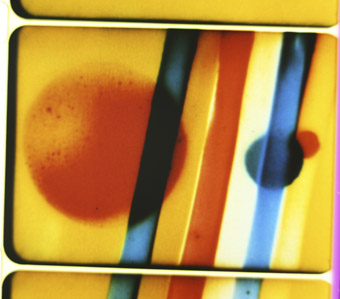
film still from Colour Flight, 1938, Len Lye
courtesy of the Len Lye Foundation, the Govett-Brewster Gallery and the New Zealand Film Archive
film still from Colour Flight, 1938, Len Lye
THE AUSTRALIAN CENTRE FOR THE MOVING IMAGE’S NEW LEN LYE SHOW IS FRAMED—IN MORE WAYS THAN ONE—BY AN INSTALLATION RADIATING COLOURED LIGHT OVER THE ENTRANCE TO GALLERY 1. AN ENLARGED PANEL OF ILLUMINATED HAND-WORKED FILM, ITS DAZZLING DOTS AND DYNAMIC DIAGONALS ARE A PORTENT OF THE UR-FORMS CRISS-CROSSING THIS EXHIBITION, AND A PERFECT SYMBOL OF THE ARTIST’S LIFE-LONG QUEST TO “FIGURE MOTION.” THE CAREFUL PLACEMENT AT THE START OF THE VIEWER’S JOURNEY INDICATES THE THOUGHTFULNESS THAT HAS GONE INTO THE CURATION OF THIS SHOW, AND THE VISITOR’S CONSEQUENTLY RICH EXPERIENCE.
Assembled by senior ACMI curator Alessio Cavallaro and Tyler Cann of the Govett-Brewster Gallery and Len Lye Foundation the exhibition offers an unprecedented opportunity to experience this New Zealand-born artist’s remarkable oeuvre, which spans hand-made and ‘scratch’ filmmaking; animation, documentary and advertising films, painting, drawing, textiles, photography, poetry, and, spectacularly, kinetic sculpture.
Experience is a key word here: the visitor, guided on a tour through the mind of one of the 20th century’s greatest artists, is distinctly encouraged to respond to these works, aesthetically and intellectually, but also physically and intuitively. Across time and through a variety of media, the journey revisits key thematic refrains of figuring motion; Lye’s personal theories of “individual happiness now”; and stylised formal archetypes emanating from what he called the primitive “old brain.”
After passing the multi-coloured frame enlargement, the visitor enters the gallery’s first space, housing drawings, the artist’s famous ‘doodles’ and paintings. Not only are these confident works exceptionally well-preserved, they are arranged throughout the space so as to subtly guide the viewer from the artist’s early sketches, across the tools and other illuminating biographical ephemera, through batiks and paintings which, in turn, give way to the ‘sculpture garden’, featuring some of Lye’s most renowned kinetic sculptures. Three of these—Rotating Harmonic (1959), Zebra (1965) and Moon Bead (1968)—have been especially reconstructed for this major retrospective. Well-behaved (on my visits), a 16mm film projector runs film on a loop, bathing the inner space in golden flicker and underscoring the whole experience with another low, mechanical hum. Our eyes are led to Lye’s photograms (camera-less photographs created by directly placing materials onto film and exposing them) to his animation and advertising films, and back around through the sculpture garden’s spindly structures, until we finally come to the dark cave at the end housing the digitally-beamed scratch films.
The sculpture garden is a beautifully low-lit forest of gently swaying steel stems, sighing and whirring and reverberating, sprouting and shivering. A constant, complex strobe is created by the motion of these “tangibles”, as Lye called them, which carve the exhibition space up into the radial, fanning and spiralling shapes so characteristic of his work. Visible from most parts of the exhibition, and frankly amazing when you’re inside it, this weird womb is also the exhibition’s heart, and in some ways its brain centre, as it’s here that the show’s truly show-stopping magic happens. Motorised sculptures embark on performances at regular intervals (Lye had a very keen sense of the duration of his kinetic art). Huge but gentle, with stainless-steel rods fitted tightly into a socket like stems in a flower vase, a fountain of metal rods unfurls overhead like an enormous space-age bouquet. On one visit, I observe a group of adolescents stumble backward from Fountain III’s (1976) towering arms to get a better view, their expressions rapt, faces striped with intermittent light (I am amazed that they appear to be guardian-less, suggesting that a group of boisterous teenage boys came of their own accord to see a modern art show, but then again, this is Melbourne, and more importantly, this is Len Lye).
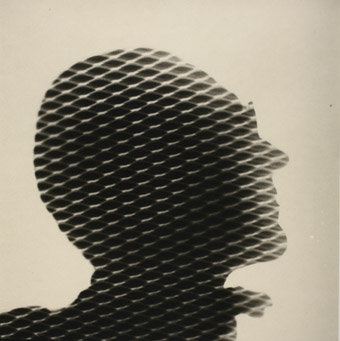
photogram, Le Corbusier, 1947, Len Lye
courtesy of the Len Lye Foundation and the Govett-Brewster Art Gallery
photogram, Le Corbusier, 1947, Len Lye
In contrast to the Fountain’s gentle swathes, Blade (1959-1976) begins as a cork ball on a springy stem setting up a light, rhythmic tapping on a length of steel. Not unlike a rectangular saw, Blade’s ‘receiving’ element begins to wobble, at first gently, then with increasing violence and sonority. As the pounding becomes more urgent, the blade buckles, complains and resonates, setting up a deep wave that ricochets throughout the room and seems to pass through my sternum each time. As the sculpture’s motions become more frenzied, and the blade is bent forward by progressively more explosive thrusts, I can’t help sneaking a peek at the transfixed teens to see if they are clued into this evidently erotic undulation. (Yes, they are). Their blushing sniggers are soon joined by the knowing chortles and outright belly laughs of other patrons. At the culmination of Blade’s performance, as ball and blade slowly return to resting state, there is one of those precious group moments that sometimes happens in the temporary community of an art gallery, as everyone simultaneously lets out an embarrassed cough and disperses abruptly. Fortunately, there’s a nearby escape into the sanctity of the scratch films in the screening room.
With Lye’s handmade films, the eyes are bombarded with “waves, stripes, blobs of violent tints, suggesting tartan, bandanna, boarding house wallpaper, fruit salad, chromatic spaghetti and an explosion in a cocktail bar” (as a reviewer in London’s Daily Mail said on the release in 1935 of A Colour Box). While the film work remains as mesmerising as ever, for many visitors who may be familiar with this, the show’s real enchantment is the way those same formal concerns are expressed across different materials and media. Lye’s practice is rigorously, even obsessively consistent: the same sensual, swirling, fraying, spraying, spreading shapes recur in paint, stencilled or incised onto film, doodled over paper, and given breathtaking mechanical form in the tangibles. The curators’ careful selection and juxtaposition of Lye’s work in the show establishes a sympathetic space for conversation between these works, enabling viewers to draw their own connections between his forms, obsessions and commanding achievements.
Biographer Roger Horrocks’ informative lecture highlights Lye’s artistic interest in notions of empathy, making it especially obvious that the ACMI exhibition too revolves around this concern with, and also within, Lye’s multiform practice. Cavallaro modestly agrees that “as curators, we spent time trying to really empathise with his work, thinking about ways to hopefully yield the most sympathetic resonance with the viewer.
“This was a somewhat tricky thing to do as, of course, Lye worked across so many mediums, and there was such a range of expression. So we thought what we would do was to try to present the work as sections, each self-contained, yet interrelated with others and able to be experienced in an integrated way. We could really ‘open up’ the work, and reveal his approaches and, invariably, connections between mediums. To do so in a way that is not didactic, more in a way that enables the visitor to experience this work on a more intimate and more personal scale, was our challenge.”
The question of the appropriate empathetic arrangement of the array of materials preoccupied much of the curators’ time in the exhibition’s planning. Tyler Cann first encountered Lye as a young art student under the influential modern art historian-critic, Yves Alain Bois, whose promotion of Lye opened the young scholar’s eyes to kinetic art developments beyond the Euro-American sphere. Cavallaro was first exposed to Lye’s work through the extraordinary scratch films, marvelling at their dynamic synchronisation and, he says, “totally captivated by their elegant simplicity; the less is more approach.”
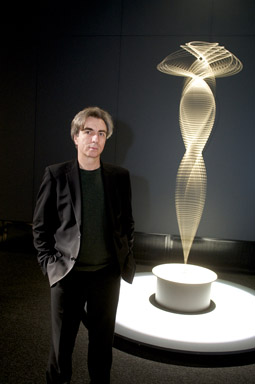
Alessio Cavallaro with Len Lye’s Zebra, 1965
photo Nolan Bradbury
Alessio Cavallaro with Len Lye’s Zebra, 1965
When I ask if he was tempted to foreground the films more, he agrees that the films are “bewitchingly beautiful” and that ACMI “could have zoomed in on that aspect alone, and it would have been fascinating—there are easily enough films by Lye that could fill Gallery 1.” However, as Cavallaro puts it, “Lye’s such a polymath, such a multimedia artist, such an artist of the 21st century—in other words, very much a contemporary artist, exploring a range of media—that the show wouldn’t have done him justice as an artist if just focused on the films.”
In particular, Cavallaro says, there was a pressing need to explore “Lye’s motion ideas with great intensity: how he applied them, how he experimented with them, and ultimately how he presented his notions of composing with motion.” To do this meant an emphasis on the “obvious connections between one medium and another, direct connections between all the work, cross currents and cross energies reverberating throughout the space. That’s one reason why we have the scratch films at the end of the journey.”
The beat of African drums from the seminal, much-loved Free Radicals (1958) is deliberately allowed to seep through and affect—or more correctly, infect—the gallery space with its urgent, primal rhythms. Len Lye would have loved this, I’m sure; he said he wanted to ensure that “the shoulder blades and thigh sinews of the gallery-goer got the resonant message” his work communicates. On seeing these “white ziggle-zag-splutter scratches on black 16mm film…in quite doodling fashion” (Lye), the visitor, everywhere constantly reminded of the kineticism of the human body, is virtually impelled to move (fortunately there is lots of space in the screening room!). This little cinema provides a dedicated space for the absorbed contemplation of these works, a fitting conclusion to the exhibition’s dazzling trip through the artist’s life and work.
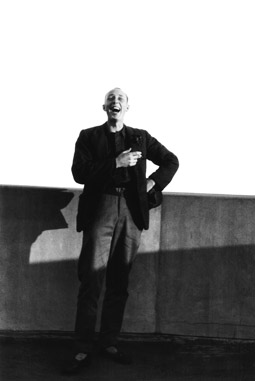
Len Lye in Sydney
photo Mary Brown. Image courtesy of the Len Lye Foundation and Govett-Brewster Art Gallery
Len Lye in Sydney
“As you leave the exhibit”, Cavallaro advises, “as you’re going up the escalator to exit, look back over your shoulder at the show and see what that different view does for you.” I did, as others should, for the ultimate conclusion to the journey: as you ascend and the show recedes, the birds-eye view reveals the topography of an amazing little universe—a kaleidoscopic Lye-land—pulsing and dancing and in a mosaic of swaying steel, light and sound.
ACMI, Len Lye, curators Alessio Cavallaro, Tyler Cann, presented by the Australian Centre for the Moving Image in collaboration with the Govett-Brewster Art Gallery (New Plymouth, New Zealand), and with the support of The Len Lye Foundation and the New Zealand Film Archive; ACMI, Melbourne, July 16-Oct 11; www.acmi.net.au/len_lye.aspx
RealTime issue #92 Aug-Sept 2009 pg. 26
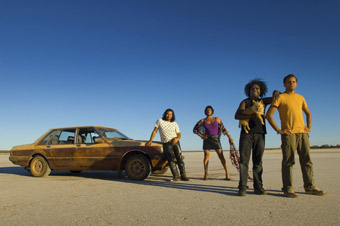
Stone Bros
THERE’S SOMETHING ODDLY FAMILIAR ABOUT RICHARD J FRANKLAND’S FEATURE FILM, STONE BROS. IT HIT ME AFTER THE SCREENING. IT’S PRISCILLA, QUEEN OF THE DESERT, BUT IN ANOTHER UNIVERSE. IN PRISCILLA, A TRIO OF TRANSVESTITES HITS THE ROAD, LEAVING THE CITY FOR AN ALIEN LAND, CENTRAL AUSTRALIA, WHERE, WITH VARYING DEGREES OF SUCCESS, THEY REDISCOVER THEMSELVES. IN STONE BROS, THE WELL-MANNERED EDDIE TOO LEAVES A FRUSTRATING CITY WITH HIS ANARCHIC COUSIN CHARLIE, BUT HEADING TO “COUNTRY”, HOPING TOO TO CONFIRM A SENSE OF SELF.
This might seem the inverse of Priscilla’s journey, but Eddie is likewise carrying a burden—he looks too much like a “whitefella” and is desperate to confirm his identity. Not only that, Charlie has sold Eddie’s jacket, thereby losing a sacred stone held in trust which Eddie must now regain on a journey beset by misadventure and some very strange encounters.
Frequently on the trip people are not what they first seem or are in states of transformation. A hitchhiking, rock guitarist turns out not to be exotic Italian but plain Ozzie; a depressed drag queen (Bangarra Dance Theatre composer David Page) is revealed to be a cousin; a wedding host turns out to be Mary G (Mark Bin Bakar); a prison officer (Peter Phelps) reads bad anthropology and transforms into a naked New Age Man; and a cute little dog becomes a wild-eyed monster, kin to the killer rabbit in Monty Python and the Holy Grail but, in the end, nicer. Even the stone turns out to have a purpose more pragmatic than spiritual. And then there are lessons in fidelity and controlling anger and learning to love.
Writer, activist and performer Richard J Frankland’s film credits include the award-winning documentary Who Killed Malcolm Smith (1993) and the intense short drama No Way To Forget (1996), based on the filmmaker’s experience as a field officer with the Royal Commission into Aboriginal Deaths in Custody. No Way To Forget was selected for Un Certain Regard in the 1996 Cannes Film festival and won the AFI Award for Best Short Film. Another award winner was his moving short drama, Harry’s War (1999), about an Aboriginal soldier killed in Word War II.
Frankland’s tautly constructed short films don’t prepare you for Stone Bros, a laidback stoner road movie with bursts of farcical energy, angst both comic and serious, sentimentality and high drama, a few too many B-grade jokes and more themes than you can point a stick at. Finely photographed by Joe Pickering across a range of landscapes and graced with a huge variety of acting styles (Luke Carroll’s Eddie provides a well crafted centre), Stone Bros barely coheres at times. But as a welcome antidote to the morose Priscilla and a more pertinent account of Indigenous culture, and not least as an all too rare Aboriginal screen comedy, it’s fascinatingly original when not downright irritating. Stone Bros could achieve cult favour but, better, it might set a precedent, encouraging more comic visions of this country’s complex cultural realities.
Stone Bros, writer, director Richard J Frankland, actors Luke Carroll, Leon Burchill, David Page, Valentino del Toro, Peter Phelps, director of photography Joe Pickering, production designer Sam Hobbs, editor Meredith Watson Jeffery, music Shane O’Mara, producers Ross Hutchens, Colin South, Media World Pictures, distributor Australian Film Syndicate; www.stonebrosmovie.com.au
RealTime issue #92 Aug-Sept 2009 pg. 28
© Keith Gallasch; for permission to reproduce apply to realtime@realtimearts.net
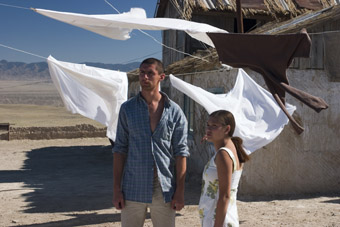
Wild Field
PLAYING IN ALL MAINLAND STATE CAPITALS FROM MID-AUGUST THROUGH TO SEPTEMBER, THE 2009 RUSSIAN RESURRECTION FILM FESTIVAL BRINGS A VERY MIXED BAG OF RUSSIAN CINEMATIC TREATS TO OUR SHORES. TYPICALLY OBSCURE METAPHYSICAL DRAMAS LINE UP ALONGSIDE A BRASH AMERICAN STYLE NAVAL BLOCKBUSTER WHILE SUBVERSIVE BLACK COMEDIES SHARE THE FLOOR WITH (WAIT FOR IT) A RAUNCHY TEEN MUSICAL. ALWAYS KEEN TO KEEP AN EYE ON THE DIVERSE AND RAPIDLY CHANGING TRENDS IN RUSSIAN CINEMA, I WAS PRIVILEGED TO GET AN EARLY GLIMPSE OF THIS YEAR’S SELECTION.
wild field (dikoe pole, 2008)
No doubt the artistic draw card of this year’s festival is Wild Field, a quiet, unusual and very beautiful film directed by Mikheil Kalatozishvili. Forever introduced as the grandson of celebrated Soviet director Mikhail Kalatozov (director of the 1958 masterpiece The Cranes are Flying), Kalatozishvili is himself an accomplished and very talented filmmaker, and in Wild Field he has made his first significant critical success. Scrupulously based on a script written by the late Aleksei Samoriadov and Petr Lutsik, the film presents a gentle and fleeting metaphor of the contemporary Russian dilemma: which road to take after communism.
Set in and around a medical outpost in the endless Kazakh steppe, Wild Field presents a miscellaneous band of post-Soviet yokels and their health problems as seen through the eyes of regional doctor Dmitri Morozov (Oleg Dolin). Dmitri, known as Mitia, is a peaceful man himself, content to tend to the needs of his clinic and make do with a far from ideal situation. But for a GP the problems of others are never far away and though he does his best to keep things in order, Mitia inevitably finds his life upturned by forces beyond his control.
An intangible film, like dust through the fingers, Wild Field has a light but also curiously haunting resonance. With an elegant flow of images (wonderfully shot by Petr Dukhovskoi) Kalatozishvili carries the audience along, gently, into the dreamlike intimacy of Mitia’s life and the surreal vastness of the Kazakh steppe. From its opening shot Wild Field teeters, like a many great Russian lyrical films, between realism and dream in the fields of parable and metaphor. Some reviewers have described the film as a work of ‘magic realism’ (like a Marquez novel displaced into the epic landscapes of Asiatic Russia) and this is perhaps a useful comparison. As with many Russian films of the past 50 years, Wild Field seems to be trying to negotiate with the troubled nation’s past through a filter of imagination, dream and fantasy, in an attempt, perhaps, to reclaim it. Though certainly less demanding than last year’s masterpiece, The Banishment, Wild Field is an obscure political-metaphysical gem that should not be missed by anyone interested in new Russian cinema. It has received a host of international awards, including Best Film at Portugal’s Estoril Festival, the Art Cinema Award at Venice and the Critics Award at Kinotavr.
morphine (morfiy, 2008)
Coincidentally, Wild Field isn’t the only “doctor in the Russian wilderness” story to feature at this year’s festival. There’s also Morphine, a subversive black comedy that makes you wonder just how much more great material is out there. Directed by Alexei Balabanov (cult director of Brother [Brat, 1997]), Morphine is based on the autobiographical reminiscences, Notes of a Young Doctor, by the great Soviet author Mikhail Bulgakov (The Master and Margarita)
Set in an eventful 1917, though with barely any mention of the revolution, Morphine follows the experiences of Mikhail Polyakov (Leonid Bichevin) as he arrives in a remote provincial town to take up a post as resident physician and surgeon. Anxious, handsome and hypersensitive, Mikhail is besieged on arrival by the kinds of health problems that destroyed Napoleon’s ranks. After contact with diphtheria, the young doctor soon finds himself with more than a casual addiction to morphine—and that’s where the real problems start. A sick man tending to the sick, Mikhail’s descent is gradual, but inevitable, until his total abandonment to despair and madness.
For the first 20 minutes of Morphine you could be forgiven for thinking that director Balabanov has grown out of the shock-tactic tendencies of his earlier films. Such is the stylistic refinery of this period piece (though with early hints of eccentricity) that it assumes the tone of a good-natured literary adaptation, of the kind institutionalised by the BBC. But fear not, because Morphine’s provincial period setting serves merely as a pretext for the doctor’s increasingly bizarre medical experiences. Once at the surgical table, the film really kicks into gear with painstaking and very imaginative recreations of Bulgakov’s detailed medical descriptions. Though at times astonishingly gruesome (sensitive viewers should close their eyes at the first mention of amputation), Morphine’s graphic portrayals never slide into gratuitous horror. The result is a surprisingly original, if not altogether profound, experience of life in early 20th century Russia, something akin to Chekhov’s Ward Six meets Gunther von Hagens. And if that doesn’t tickle your fancy, what does?
admiral (admiral, 2008)
Of course, a festival like the Russian Resurrection isn’t only for fans of the unusual and the subversive. It’s also a place where Australian audiences can get a taste of more popular Russian films. And that’s where Admiral steps in. Epic in scope, it’s the latest in a growing line of domestically targeted Russian blockbusters. Produced by Channel One studios and distributed internationally by Fox, the film broke all box office records in Russia last year.
Here in Australia, festival audiences will probably want to see Admiral on the basis of its director Andrei Kravchuk’s previous film, The Italian. It is perhaps necessary, then, to point out that few films could be less like The Italian than Admiral. Where Kravchuk previously explored the experiences of an orphan child with gentle intimacy, in Admiral he embarks on an action packed, heroic reconstruction of the life of White Army commander, Admiral Aleksandr Kolchak. A key counter-revolutionary figure in the Russian Civil War, he has remained a martyr for nationalist resistance to Bolshevism. Here we see him portrayed not only as a national hero but even a spiritual one, virtuous to the bone.
Less than subtle in its ideological allegiances, Admiral has sparked serious criticism from the liberals in Russia, who have been so bold as to question the film’s historical authenticity. Indeed, as an ideological statement, Admiral presents a provocative indication of the growing nationalist fervour in Russia. For 80 years Russians had to sit through Bolshevik propaganda, and here we see the backlash, a Potemkin from the officer’s point of view.
hipsters (stilyagi, 2008)
Another Russian director to make a very sharp U-turn is Valery Todorovsky, director of the action thriller Vice which played at last year’s festival. This year Todorovsky greets festival audiences with the colourful and epileptic Hipsters, a teen-pop-musical that will make both Russian adolescents and cultural anthropologists jump for joy.
Set in the post-Stalinist cultural “Thaw” of the mid-1950s, Hipsters uses song, dance and teenage love to educate its audience about a unique period of Soviet history, when brief glimmerings of American jazz and cool hair shone in the totalitarian state. Pinned squarely against the soulless machine of Bolshevism, Hipsters reveals, like Admiral, an overtly negative mythologizing of the Soviet state. The dreaded Party is here represented as a kind of comic book ‘evil empire.’ It is indeed a revelation to realise that the target audience of this film, Russian teenagers, will never have lived a day under the Soviet regime, the surest sign of the all-consuming tide of history.
2009 Russian Resurrection Film Festival: Palace Cinema, Como, Melbourne, Aug 19-26; Chauvel Cinema, Sydney, Aug 20-31; Palace Centro Cinema, Brisbane, Sept 3-9; Cinema Paradiso, Perth, Sept, 10-16; Palace Nova, Adelaide, Sept 10-16; www.russianresurrection.com
RealTime issue #92 Aug-Sept 2009 pg. 30
© Tom Redwood; for permission to reproduce apply to realtime@realtimearts.net
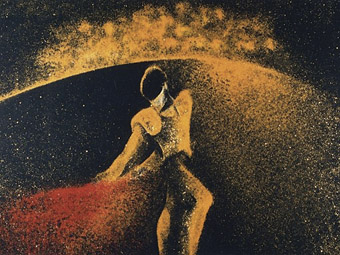
Carmen Torero
IN ITS 9TH ITERATION, THE MELBOURNE INTERNATIONAL ANIMATION FESTIVAL’S PROGRAMMING POLICY CONTINUES TO BE BRAVE AND ADVENTUROUS, AND THIS RESULTED IN ANOTHER DIVERSE SET OF PROGRAMS. THIS YEAR, THE BOAST WAS THAT MIAF SCREENED OVER 400 FILMS SELECTED FROM OVER 2,000 ENTRIES, SPREAD OVER 40 PROGRAMS AND REPRESENTING OVER 30 COUNTRIES. THAT’S A LOT TO ABSORB IN JUST SEVEN DAYS AND, AS ALWAYS, WHILE SOME SELECTIONS MAY BE A LITTLE UNDERWHELMING, THERE ARE ALWAYS UNRESERVED CLASSICS AT EVERY TURN. I MEAN THAT BOTH HISTORICALLY (MIAF TAKES GREAT CARE TO PRESENT AN OVERVIEW OF ACKNOWLEDGED GEMS FROM THE PAST) AS WELL AS INDULGENTLY: THERE ARE SO MANY MASTERPIECES BEING PRODUCED TODAY, AND MIAF, SEEMINGLY, GARNERS THEM ALL.
animating with sand
Each year, the festival spotlights a particular animation technique. In 2008, it was puppetry, which presented an excellent counterpoint to the industry’s surfeit of CGI. In 2009, it is sand animation, also promising. I was excited at the thought of a program dedicated to this laborious and visually stunning technique, which involves the manipulation of coloured powders (actual sand, most often, but also salt) over a light box, typically with hand brushes and air brushes. The program presented eight ‘classics’ and seven recent films, but the outcome was hit and miss. It seemed the form too often dictates the content because the technique necessarily involves swirling, dissolving imagery, generating too many twee scenarios (ponderous childhood reminiscing, dissolving memories) and a little too much navel-gazing, windswept hair and fluffy clouds.
A notable exception was Aleksandra Korejwo’s Carmen Torero (Poland, 1996; 3’45), based on Bizet’s Carmen. Korejwo’s skill is incredible, presenting a consistently mesmerising interpretation of Carmen’s interactions with the bullfighter, whose majestic cape-swinging movements through time and space engulf them both in great swathes of colour and grain (salt injected with dye in this instance, manipulated by animal feathers instead of brushes). Fur Mathilde (director Alla Churikova, Germany, 2009; 7’00) was also masterful, mixing a young girl’s (literally) black-and-white existence with her escape into the noise and colour of the city—some of the latter scenes are almost photorealistic, almost 3D, astonishing when you remember this is sand. But what I would really like to see in sand animation is a horror film. Imagine it, all that red powder and tenuous human forms —it would make for an excellent shower of blood, dissolving not into soft-focus memories but into traumatised brain tissue, skull fragments and exploded flesh. Just a thought…
internationals
There were 10 international programs: six mixed sessions plus tailored programs for digital forms, abstract films, long shorts and new Croatian animation. I enjoyed Bubblicious (Geoffroy De Crecy, France, 2008; 3’15), a film clip for Rex the Dog’s eponymous French house track, featuring a cut-out-style mutt rendered in 3D and singing the diva-like club anthem with serious attitude. Ridiculous, but infectious and super stylish. Two animations were distinguished by their hands-on technique. The Note (Hwang Bo Kumbyul South Korea, 2008; 3’30), about a letter that comes to life before the eyes of a child, is mesmerising, folding in on itself as ethereal bits of tracing paper prove to hold all sorts of secrets—morphing shapes, objects and scenarios barely held together by sticky tape…Almost like one of the family (Astrid Goransson, Sweden, 2008; 9’45) is bizarre and magical, with charcoal drawings on walls coming to life around a housewife in her kitchen, forming nested worlds within worlds that draw her deeper and farther away from the domestic.
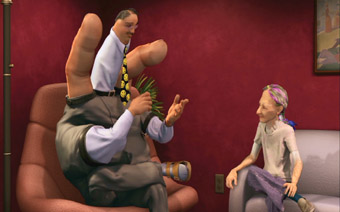
The Spine
The Necktie (Jean-Francois Levesque, France, 2008; 12’15) is a wonderful tale of Kafkaesque bureaucracy that pits our puppet hero against an internecine office conspiracy involving people who are nothing more than (again, literally) paper cut-outs. It’s an instructive example of form underscoring a story, rather than dictating it. Chris Landreth’s The Spine (Canada, 2009; 11’00), voted Best of the Fest, is a breathtaking combination of sketch artistry impressed onto CGI frames in a style Landreth has dubbed “psycho-realism.” According to the filmmaker, CGI makes animators lazy, able to cheat and do ‘incredible’ tricks without thinking; psycho-realism, then, tricks the audience into thinking the scene is reality, until everything collapses into disturbing surrealism. In The Spine, characters are trapped in a marriage counselling session as strips of flesh hang from their faces, while the lead character, free from his domineering wife, grows an actual, literal spine when initially he was just a blob of a man. Landreth is working on an animated biopic of HP Lovecraft, a truly exciting prospect. Other international highlights were to be found in the London’s Calling program, a blend of advertisements and short films showcasing the best of that city’s animation, including Marc Craste’s Varmints (UK, 2008; 24’00), which is truly warped in its mix of elements: dystopian sci fi, apocalyptic alien invasion and, yes, cuddly animals. City Paradise (Gaelle Denis, UK, 2004; 6’00) is an outstanding live-action/animation tale of a Japanese girl who visits London only to find a city even stranger than she is. It’s a really smart inversion of the standard Lost in Translation-style ‘foreignness’ attributed to places like Japan.
australian panorama
With only a few misfires, the Australian Panorama was true blue. Factoids and Slapstick (Doug Bayne, 2008; 4’15) was part of the BigPond/Screen Australia–sponsored Great Moments in History competition, in which animators were invited to consider “funny stuff that happened between the Big Bang and the end of time.” Ostensibly, it tells the story of Vlad the Impaler, but the animator steps into the frame to express doubts about the whole storytelling process—clever and fun. The Aussie Panorama screened two other films in this series, but they weren’t as good, relying on tedious toilet humour. There should be an unimpeachable, ironclad rule in film school, along with those other immutable maxims they teach about good story: “NO FART/POO/BUM JOKES. Ever.”
Be Famous and Die (Simon O’Carrigan, 2008; 4’45) uses simple techniques to deliver a deeply felt monologue about the peculiarities of Melbourne’s obsession with statues of famous people. Laura Stitzel’s fabulous The Roaring Tide (2008; 4’00), drawn in Roaring 20s deco style (all blocky, angular shapes and zoot suits) is, joyously, about shipwrecked passengers who simply refuse to admit the severity of their situation, insisting instead on partying and unadulterated hedonism. Bronze Mirror (Susan Danta, 2008; 7’00), voted best Australian film of the festival, was a worthy contender. Based on a Korean folk tale, it uses surreal CGI to depict rural folk in old Korea mesmerised by a ‘demon’ they’ve never seen before—themselves in a humble mirror. But perhaps Mutt (Glen Hunwick, 2007; 7’00), about a dog in the outback obsessed with his ball even though he has no one to play fetch with him, should have got the nod. The technique (rounded, grossly caricatured characters), the set design and the colour scheme are outstanding, and the story is just too funny, the poor dog’s antics lingering in the memory. It was one of two great Aussie canine stories, the other being Dog with Electric Collar (Steve Baker, 2008; 4’45) which uses a whip-sharp style—pulsating, fantastical and colourful—to portray a dog who just can’t stop barking, even under threat of painful death.
All up, the MIAF team, led by Malcolm Turner, have really settled into a good groove, with a programming style that delivers. Our local animators have also risen to the challenge, proffering a brace of films that stand up to scrutiny. Here’s to the future.
2009 Melbourne International Animation Festival, ACMI Cinemas, Melbourne, June 22-28; www.miaf.net
RealTime issue #92 Aug-Sept 2009 pg. 31
© Simon Sellars; for permission to reproduce apply to realtime@realtimearts.net
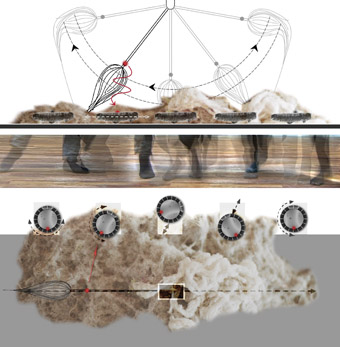
On Track, by Petra Gemeinboeck
courtesy the artist
On Track, by Petra Gemeinboeck
ANY NEW FUNDING OR INCREASED RECOGNITION FOR THE ARTS AND THOSE WHO LABOUR IN THEIR SERVICE IS CERTAINLY TO BE ENCOURAGED AND APPLAUDED. SO ARTS PRACTITIONERS AND ACADEMICS WILL WELCOME BOTH THE RECENTLY ANNOUNCED FEDERAL GOVERNMENT INITIATIVE, ARTSTART, AND THE INCLUSION OF CREATIVE WORKS IN THE 2009 ERA (EXCELLENCE IN RESEARCH FOR AUSTRALIA) DATA COLLECTION TRIAL CURRENTLY UNDERWAY IN AUSTRALIAN UNIVERSITIES. ALTHOUGH THEY ARE TARGETED TOWARDS DIFFERENT COHORTS OF THE CREATIVE ARTS COMMUNITY, BOTH SCHEMES WILL HAVE AN IMPACT ON THE EDUCATIONAL INSTITUTIONS THAT ARE OFTEN RELIED UPON TO PROVIDE A REFUGE FOR ARTS PRACTICE IN THIS COUNTRY.
Importantly, the schemes provide pathways for emerging graduate artists and recognition for the work of creative arts practitioners who double as educators and academics. That said, the reception given to Artstart and the ERA guidelines by those in the field is, quite rightly, tempered by concerns over unanswered questions and a caution borne out of past experiences. The elevation of the status of creative arts practice as a career path, as it applies in these cases to both graduates and those working within the Academy, inevitably comes at a cost. That cost is tied to the degree to which creative arts practice can be measured and audited by those who determine how funding and recognition will be allocated and rewarded.
artstart minus social security
Artstart will deliver $9.6 million over four years to be allocated as “one-off grants to help graduates start a business as professional artists.” The scheme will be administered by the Australia Council, with applications to be called for later this year. To date, no announcement has been made about the criteria which will be used to assess the applications. However, given that the scheme will cover visual artists, musicians, sound artists, filmmakers, writers and performers, the process will almost certainly take place outside the normal panel structure the Council uses when assessing funding applications. Grants of up to $10,000 will be offered to 200 applicants per annum. The grants differ from traditional arts funding in that they can be used for activities other than the production of works. So, for example, an artist might apply for funding to purchase expensive equipment or for the establishment of a small arts business. Artstart falls short of the Rudd government’s pre-election promise to “develop a ‘Social Security and the Arts’ policy that harmonises current Australia Council, Centrelink and the Australian Tax Office rules [as well as] determines the most equitable way to treat earnings and royalty payments for artists currently receiving welfare” (Arts Minister Peter Garrett’s 2007 New Directions for the Arts policy speech). That said, it must be counted as a step in the right direction.
artstart or jobstart?
Responses to the scheme from those I have consulted within the creative arts sector are mixed. Anna Munster, artist and Senior Lecturer at UNSW’s College of Fine Arts (COFA), points out that while “there’s a need for something at the lower end of the funding scheme…the ‘speak’ in which it’s couched suggests a kind of alignment with Jobstart.” She suggests that it might have been better to follow the UK model which allows artists to receive unemployment benefits for a period of time while working on an art project. Niall Lucy, Research Fellow with the Australia Research Institute at Curtin, concurs arguing that, “there’s a need for meaningful government funding of ‘meaningless’ arts programs, as opposed to all too predictable outcomes-based vocational training.” This kind of thinking can also be found in the National Association for the Visual Arts (NAVA) pre-election call for Labour to deliver on its promise to provide a “living wage” for two years after graduation for art practitioners engaged in professional activities.
for the moneywise & grant savvy
Artstart will certainly benefit those young people who are capable of tapping into revenue streams. Ross Gibson, Professor of Contemporary Arts at Sydney University, points out that “where there are young people in the arts who really, really need money, then there’s a need for Artstart. But the trick will be to find a way to make the scheme amenable to people who are not used to money, people who never grew up around money, people for whom money is not a part of their culture.” Ross Harley, Head of School of Media Arts at COFA, also notes that there is such limited funding for so many graduates. This reinforces the point that Gibson is making—the money savvy, grant savvy graduates are the ones who will benefit most from the scheme. All of those I spoke to agreed that these grants will certainly reinforce the need for educators to ensure that graduates understand how to take advantage of any government largesse directed at them. However, as Anna Munster points out, “There are not that many tertiary institutions that don’t expect some kind of ‘finished’ product as the result of a finished degree these days. But ones that serve students better provide less ‘vocational’ finished products. The best courses provide students with a set of mutable and flexible skills: critical thinking, project management, teamwork and cross-platform training (by which I mean encourage students to make work in pop bands, curate, write articles, build simple websites, coordinate live events and so on). These kinds of students don’t necessarily need Artstart but they will probably do very innovative things with it.”
art work after 30
There was also general agreement that some of the funding might well have been directed towards ensuring that once these artists reach 30 they can find sustained employment in the arts. Artist and RMIT academic, Martine Corompt says “it does seem sometimes that there is a constant support/celebration of emerging artists. But no matter how you prepare artists for the next 10 or 20 years there just aren’t enough teaching positions or commercial galleries to support them all. Perhaps there should be greater support for initiating new venues outside of the CBD (studios, galleries, performance spaces) which would create positions dealing with curating, management, administration and so on. The added benefit would be the transformation of districts/precincts in suburban or regional areas in need of rejuvenation.” As Ross Harley asks, “What happens after, when you’re a mid-career artist? Once you’ve received the ‘seed’ funding, should that then set you up to be self-sufficient?”
creative work: legitimate research
Corompt, Munster, Harley and Gibson, and many others like them, have been able to sustain themselves financially as creative arts practitioners through their work as creative arts educators. However, as Margaret Seares from the Council for the Humanities, Arts and Social Sciences (CHASS) points out, “the issue of the status and recognition of the work of academic artists, in terms of research, has been an often fraught one. The national system for collating, auditing and, ultimately, rewarding research outputs—known as HERDC—did recognise creative work for a time, but for the past decade this has not been the case. This has meant a degree of marginalisation for academic artists when the research performance of their university has come under discussion or review” (M Seares, “A new era for Creative Arts research”, www.chass.org.au/articles/ART20090430MS.php). This marginalisation has had a significant impact on the status and workloads of creative arts academics, tied as they are to demonstrable research performance. The inclusion of creative works in the 2009 ERA data collection trial is designed to directly address this issue by reinstating the recognition of creative works as legitimate research outputs.
Under the ERA guidelines, eligible research output types include original creative works, live performance of creative works, recorded/rendered creative works and curated/ produced substantial public exhibitions and events. Each work needs to be accompanied by a statement identifying the research component of the output, which must be made available in an institutionally supported repository (such as a university sponsored Research Bank). The statement must be a maximum of 250 words and must outline the research background of the work (field, context, research question), the research contribution of the work (in terms of innovation and new knowledge produced) and the significance of the work in relation to research excellence.
University based artists and writers certainly welcome these changes. Recognition of creative work as research is long overdue. That doesn’t mean, however, that those affected by these changes don’t have some reservations about whether the scheme will produce real effects. Darren Tofts, writer and academic at Swinburne University, notes, “There is still a lot of work to be done to change the research culture within many universities to acknowledge and accept that the creative arts do contribute to the intellectual and research capital of both the academy and society more widely.” Anna Munster agrees. “We have argued for years that creative works should at least count as research so here we finally have an opportunity to make that recognition happen. Hopefully, it will track and make visible the enormous contributions to research that artists do in fact make and put them in a more competitive position when it comes to applying for other kinds of external university income.”
creative limits
Ross Gibson remains circumspect. “[I]t will benefit artists who are keen or able to engage in some extra, fairly traditional routines of academic scholarship, adding some linguistic discourse onto their productions. The ERA probably won’t benefit artists who happen to teach in academies but who are not that interested in being the new-style creative arts academic. The rules are pretty clear—knowledge has to be made explicit and communicated. The arguments will occur over whether the creative art work, standing alone, is explicitly communicated knowledge. My reading of the national intellectual scene is that we’re nowhere near persuading enough people that this is true.” Niall Lucy believes ERA could also have the potential to “limit the possibilities of what may count as ‘creative’ work in terms set by university and Canberra bureaucrats.”
Artstart and the inclusion of creative works in the ERA are positive moves in the right direction for emerging artists and creative arts academics. Whether they take us closer to equitable, sustainable, workable outcomes for those working in the creative arts remains, for now, to be seen.
Image note: Installation layers in the form of a section, a video extract and a floor plan for installation work, On Track, by Petra Gemeinboeck, artist and Senior Lecturer in Interactive Media Arts at College of Fine Arts, Sydney. “A disaster-prone scenario unfolds as the protagonists, apparently set to clean, spill, interfere with and hinder each other, creating an ever more slippery mess in intricately choreographed ways.”
Thanks to Anna Munster, Martine Corompt, Darren Tofts, Niall Lucy, Ross Harley, Ross Gibson, NAVA, CHASS and Ricardo Peach (Inter-arts Office, Australia Council for the Arts) for their contributions to this article.
RealTime issue #92 Aug-Sept 2009 pg. 32
© Lisa Gye; for permission to reproduce apply to realtime@realtimearts.net
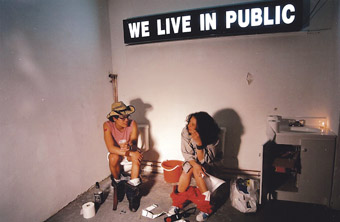
We Live In Public
IF THIS ARTICLE HAS A STRUCTURING ABSENCE, JOSH HARRIS IS ITS NAME. THE WARHOLIAN FIGURE BEHIND PSEUDO.COM, A WEBSITE THAT, IN ITS DAY, WEBCAST SHOWS ABOUT EVERYTHING FROM DEVIANT SEX TO MODERN ART BEFORE GOING BANKRUPT WHEN THE DOT-COM BUBBLE BURST (HARRIS LATER CLAIMED, IN A LETTER TO THE NEW YORK TIMES, THAT PSEUDO HAD BEEN “A FAKE COMPANY”, “AN ELABORATE PIECE OF PERFORMANCE ART”), WAS MEANT TO BE INTERVIEWED FOR THIS ARTICLE. BUT HARRIS IS NOT, AS IT TURNS OUT, A PARTICULARLY EASY MAN TO GET HOLD OF. INDEED, AS ANYONE WHO HAS SEEN THE FILM, WE LIVE IN PUBLIC, WILL ATTEST, HARRIS IS NOT AN EASY MAN, PERIOD.
Ondi Timoner’s award-winning documentary, which screened at the Sydney Film Festival in June and at the Melbourne International Film Festival in July, charts a decade in Harris’ life and work. And while Timoner is quick to point out that the film is less a portrait of Harris than an investigation of the potentially dehumanising impact of the internet on society, the image of the mercurial visionary/madman at its centre, while at times affectionate, is not always a flattering one.
When I call Timoner at her Los Angeles home, where she is packing in preparation for an intercontinental trip that will see her visit Europe and, for the second time in three months, Australia, she is quick to confirm the impression. “You’re calling me on a bad day in terms of my relationship with Josh”, she tells me. “I’m really frustrated with him right now.”
Timoner’s frustration with her subject has a lot in common with mine. Timoner, who looks a bit like Joan Allen crossed with a rock star (which for the filmmaker behind DiG!, the award-winning documentary about the neo-psychedelic bands The Brian Jonestown Massacre and The Dandy Warhols, probably shouldn’t come as a surprise) is frustrated about Harris’ constant refusals to be interviewed. Especially when getting the word out about the film is so important to its success or failure.
After the film screened at Sundance earlier this year, where it was awarded the Grand Jury Prize for US Documentary, Timoner says the question of distribution began to rear its ugly head. “It has been a real struggle to put this movie out in the right way—to put this movie out, period. Because of the current state of the economy, finding the resources has been a miracle.”
The centrepieces of Timoner’s film are two art projects spearheaded by Harris at the turn of the century: Quiet, which saw 100 artists live together for 30 days in an underground bunker wired with webcams, and We Live in Public, which saw Harris and his girlfriend wire their own home in the same way. The idea was to show the extent to which the internet would allow people their promised 15 minutes and the lengths they would then go to get it. Things went, in no uncertain terms, to shit.
The bunker turned into The Lord of the Flies and the New York City police were called in, Harris’ girlfriend left him alone in the fishbowl, traffic to the site went to hell, he went bust, and then experienced an almost inevitable nervous breakdown. While the point of both projects, to some extent, was to warn us about the path the internet was taking us down, the personal toll it took on Harris was something not even he had foreseen. “The whole cautionary tale aspect of Josh is something that I very much was inspired by in terms of making this film”, Timoner tells me. “I think there’s a price you pay for being a visionary or a genius or whatever you want to call it.”
Not that Timoner herself necessarily buys into Harris’ Orwellian view of the future and the role that the communications technologies will play in it. “Josh had a very dark and controlling, mad-scientist approach”, she says, “where he drives everyone over the edge a little bit, himself included…But that is not all that the internet is. I think it’s the most important tool we’ll have access to in our lifetime. It’s a really exciting time to be alive because of it. But as much as it allows us to self-organise and cut out the middle man—which really scares the shit out of our distributors, by the way—it does have the potential to be dangerous…The more connections we make outwards, the less we’re making inwards, with our families, with our friends, physically. And we’re doing that. We’re making that happen.”
Mostly, though, Timoner sees the internet and other interactive technologies as good things. In Sydney for the film’s Australian premier in June, she also attended the X|Media|Lab Serious Games conference, with Harris in tow, to discuss the impact of video games and other interactive technologies upon cinema (and, she makes perfectly clear, vice versa).
The meeting of cinema and video games might mean, for some, rich media and cross-platform projects like Chris Marker’s Immemory and Peter Greenaway’s The Tulse Luper Suitcases, respectively. For others it might mean films like Gus Van Sant’s Elephant and Tom Tykwer’s Run Lola Run which borrow the visual language and narrative structure of video games while remaining essentially cinematic works.
For her part, Timoner is interested in the way that the two forms, while maintaining their integrity in the face of hybridity, can engage in a conversation with one another. This is a conversation, she says, that stems from the work but takes place around it. Ideally, it will eventually branch out, moving beyond it and taking on a life of its own. “What you can do is create all sorts of elements around your film that people can engage with once it’s over”, she says. “That’s a kind of interaction, too.” For example, to coincide with the documentary which deals with climate change and economics (she is also working on a narrative biopic about the photographer Robert Mapplethorpe, in which Eliza Dushku will star) a Los Angeles-based company is designing an educational video game that will deal with many of the film’s themes. Timoner predicts “Kids aren’t going to be able to learn in a traditional education system for very much longer”. “It’s going to have to be interactive. It’s going to have to be fun, it’s going to have to be fast, and it’s going to have to be engaging.”
Inevitably, Ondi Timoner sees the interaction between cinema and video games, in whatever form it takes, as a way of getting people to think, and it is the impulse to do so that is ultimately at the heart of all her work. “I make films to inspire people to take action, whatever form that action make take”, she says. “To be conscious, to really go forth and do something with their lives, to create.” And this, of course, is ultimately political. “Next thing you know, people are walking around and living their lives”, Timoner says, “and they’re more apt to think critically about what they’re encountering, how they’re acting, all of that…That’s why I originally started making films; every film of mine has been about getting people to do that.…They’ve also been about groups and group dynamics, and about what people will give up to belong and make their lives matter. To some extent”, she says, “We Live in Public is about what we’ll give up for the attention and recognition that we feel when we go online. Obviously, it can be very exciting. Josh’s story is a warning shot.”
Director and producer for Interloper Films (Los Angeles), Ondi Timoner was a speaker at the X|Media|Lab Serious Games Conference, June 12-14; www.xmedialab.com
RealTime issue #92 Aug-Sept 2009 pg. 33
© Oscar Michaels; for permission to reproduce apply to realtime@realtimearts.net
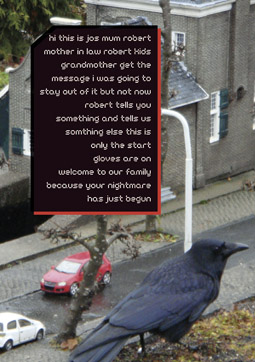
from CU The Presence of Co-Presence, Larissa Hjorth
courtesy the artist
from CU The Presence of Co-Presence, Larissa Hjorth
WE AL KNO HW 2 RIT N RECEV TXTS, ITS JST LIK MAKN A FONE CAL. BT SOM SMSS R MOR IMPRTNT THN OTHRS, LIK MST THNGS IN LIF, SOM MSGS STIL PACK A HEVY EMOSHNL PNCH
Larissa Hjorth’s CU: The Presence of Co-Presence explores the phenomenon of the Short Message Service or SMS from its humble origins as a means of communication for the deaf to a staple form of interaction amongst the growing number of ‘thumb tribes.’ The show is presented on CCP’s Night Projection Window; its translucent glass allows images to be viewed from either side. The exhibition takes the form of a 30-minute presentation that combines text messages with photographic images. The messages are not displayed for very long and are rear projected, so the best place to view the exhibition is from the footpath (or better still from the pub across the road).
The interesting thing about a work best viewed from outside the gallery is that the very exhibition becomes an embodiment of co-presence. Going to a photographic gallery only to stand out the front feels like being both there and not there, simultaneously inside and out. The text message also exemplifies this notion—the sender is present with the reader, yet still physically in the location whence the message was sent.
The text messages that Hjorth chose for the exhibition were compiled from those people had saved to their phones. Accounts of the emotions embodied in the messages were also provided to Hjorth by the recipients. From that, individual photographs were created and selected by the artist as a way to capture the emotional significance of each message.
In displaying these still photographic images as ‘moving’, the artist has the luxury of employing techniques like zooms and pans, to take the audience’s eye to areas of interest or significance. Some photographs appear at first as close-ups until zoomed out to reveal different stories. This was most memorable with the photograph accompanying the SMS “I want 2 C U”, which started with a close-up of a man and a woman in an embrace, then slowly pulled out to reveal them as part of a billboard advertising mobile internet.
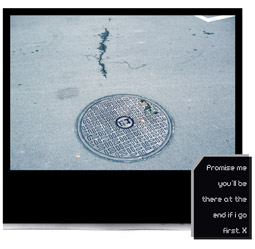
from CU The Presence of Co-Presence, Larissa Hjorth
courtesy the artist
from CU The Presence of Co-Presence, Larissa Hjorth
While the title of the show CU is a reference to the SMS shorthand of ‘see you’, when photographs start with a distorting close-up (CU, in film shorthand) another aspect of co-presence reveals itself—being in one place but seeing it from two different perspectives. A similar effect was achieved with a pan across the photograph accompanying the message “Promise you’ll be there at the end if i go first. X”, which tracked an oil filled crack as it snaked towards a manhole. These techniques also added another dimension to the emotional impact of the photographs, drawing our attention to details we ordinarily might not notice.
Accompanying the video display is an exhibition catalogue of short essays and creative pieces reflecting and expanding on the evolution and significance of the text message. Giles Lane looks at how closely linked the current Twitter craze is to the popularity of texting, while Darren Tofts pays homage to Alexander Graham Bell for inventing the telephone, the forerunner to SMS and other forms of co-presence.
Texting has become so ubiquitous because it provides people with another, possibly more intimate, way of communicating than speaking into the telephone. Sometimes there are things people would rather not say out loud, whether they are in a public place and do not want to broadcast their message or perhaps because it is so deeply personal they would rather not utter the words at all. This phenomenon has led to people saving certain messages, as they would love letters, to reread and remember forever…or at least until they get new phones.
Ultimately CU is more about the text message than the photography, however the conversation Hjorth develops between the two creates a real sense of the emotional importance that messages of any kind can have on a recipient. As Fee Plumley writes in the catalogue, it’s like the feeling you experienced when you received an affectionate note passed to you by someone in your high-school class.
Hjorth’s exhibition highlights a modern phenomenon that has captured the hearts and minds of millions of users—one is my 90-year old grandmother, Oma, who has not only taken to texting but has also embraced the shorthand that goes along with it. I’m still surprised every time my phone beeps with a message from her and even laugh out loud when I read it: “r u ok? hope 2 c u soon <3 om.”
Larissa Hjorth, CU: The Presence of Co-Presence. Centre for Contemporary Photography, June 5-Aug 1, www.ccp.org.au
RealTime issue #92 Aug-Sept 2009 pg. 34
© Jeremy Weinstein; for permission to reproduce apply to realtime@realtimearts.net
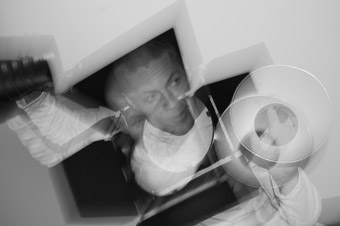
Daniel Belton
courtesy the artist
Daniel Belton
DANIEL BELTON IS A FILMMAKER AND CHOREOGRAPHER BASED IN SOUTHERN NEW ZEALAND WHOSE WORKS HAVE BEEN SHOWN AT NATIONAL AND INTERNATIONAL DANCE AND FILM FESTIVALS IN CHRISTCHURCH, OTAGO (WHERE BELTON RESIDES), EMPAC IN NEW YORK AND ELSEWHERE. BELTON FORMED GOOD COMPANY ARTS IN 1997, PRODUCING FILM, INSTALLATION AND LIVE PERFORMANCE.
Although the company’s output is diverse, its film work is pervaded by a sense of aesthetic historicism. Matchbox (2008), for example, draws on the imagery of the Bauhaus, Futurism, vaudeville, the films of Friz Lang and Buster Keaton. Earlier films allude to Albrecht Durer, Renaissance perspective and Commedia del’arte.
Belton acquired an interest in art history at an early age through his father, painter Peter Belton, who serves as designer on most of Good Company’s projects. Indeed, Belton considers the sculptural, painterly aesthetic of many of his films as representing a ‘return’ in his career. “I left high school with high marks in art”, he explains, “and I was heading to Canterbury University to study fine arts, but had auditioned for the New Zealand School of Dance. They called me up and said: ‘You’re in!’ I thought that while my body was young I should do this—and I could come back and go to art school later.” Belton graduated in 1990, subsequently dancing with many companies in New Zealand and internationally, including the Douglas Wright Company, Arc Dance and Tanz Gervasi, Austria.
In 1997 Belton settled in Dunedin in the south of New Zealand and founded Good Company. “I wanted to start making my own work, not only for theatre spaces, but to fuse the visual arts with dance, sculpture and kinetic art.”Good Company’s recent work can be divided into two main series. The most recent triptych culminated in Matchbox, growing out of the companion pieces Game (2004) and Reset (2006). These are the most closely related of Belton’s films, shot in misty, halo-infused black-and-white reminiscent of German Expressionist cinematography. Focused around the idea of a kind of combined puppet show and game-playing machine, figures interact by pushing buttons, arranging poles, dancing with each other or animating miniature figures and vaudevillian bands. Belton’s earlier trilogy—Soma Songs (2006), Seismos (2006) and After Dürer (2007)—dealt with problems of space and the articulation of line and form through movement within a set of virtual, perspectival frames, or across a multifaceted and effectively multidimensional sculptural object. Dancers crawled over planes and into inverted relationships, as in the upside-down works of MC Escher.
“I was originally drawn in to theatre by puppet shows”, Belton observes. “They are a filmic window. It’s like looking in the back of an old bellows camera. You open it up, it concertinas out, and it’s like there’s a little theatre in there, in the viewfinder. It’s a miniature proscenium arch.” Belton is keen to ensure that these relatively commonplace ideas about the relationship of film to theatre materialise in a complex—albeit still light and playful—mise en scène. The characters of Matchbox climb into and out of a graphed, perspectival space, its digitally added lines (provided by Jac Grenfell) converging on what would be the focal point for any one view. The performers are, in effect, rendered mechanical, inasmuch as they interact with the objects and materials presented to them by the flashing, almost Mondrian-like game device designed by Peter Belton.
“[This machine] is also like the sound box of a musical instrument”, adds Belton. A key part of Matchbox’s alluring blend of time and reference is to be found in the wound-down score produced by Grenfell’s digital decomposition of the music of Django Reinhardt and 1930s vaudeville. The game dings, crackles and pulses with these sounds, just as it produces pillars and squares, or offers spaces and lights with which the characters interact. Not only are several of these sonic and visual motifs coincident within Matchbox, but they perform the same dramaturgical function of rendering a machinic world of performance and of dancing from within an antiquated yet contemporary, partly-digitised format. Belton indeed goes so far as to shoot in digital video and reformat the image in 16 mm analogue film, even though in many cases his films are projected from a DVD dub.
It is this interest in bodies and forms whose motor force and activity seem derived from the logic of film and of the moving image, rather more than human, fleshy or three-dimensionally choreographic logic per se, which places Matchbox and its companion works close to the conceptual ideology of Bauhaus and Futurism. Like many dance film artists, Belton’s interest in the form originally derived from his work on archiving his own productions as well as from producing live multimedia pieces like the stage production Soma Songs (2005). “It was always frustrating because it was never like the live show”, Belton admits. “But then there was something in that loss, as well as in the discipline of locking down your reading to one visual frame.” Where some of Belton’s live performances have multiple points of interest and a circus sense of order tipping into chaos (Fellini-like, notably in Belton’s Commedia-influenced Soundings, 2001), his films are by contrast tightly focused on small groups in glowing, misty but well-defined hazes of light, or on crisp figures which stand out before a black background amidst architectural lines and shapes.
Recalling the ideas behind the extraordinary modernist marionettes and sleek, conical, monochromatically painted dolls designed by Sophie Tauber and Oscar Schlemmer, Belton insists that “working with the human body for film is like puppeteering. You craft a choreographic story with the bodies of the dancers you are working with, but in postproduction you revisit that. You can jump cut, speed things up, reverse things, slow them down, or you can layer them.” Although Belton generates much of the material which he films by giving tasks to his performers, and sees them as active agents within the process of developing the work, nevertheless the philosophy of his approach explicitly denies agency to the dancer-characters of his films. The figures who dance across his screen are not particularly human, or even necessarily embodied per se. They are formal devices within a larger mise en scène. In Matchbox in particular, the game-play set up by uncertainty over the categories of human versus non-human and agency versus puppetry produces the humour and narrative arc of the work.
In the end though, Belton’s preferred metaphor to describe his material is storytelling. “We’re storytelling beings”, he insists. “I try to make each film have enough layers to have many readings. With the way I choose my performers, I’m not trying to get a group of racehorses together. You’ve got people from all walks of life, different shapes and sizes. It’s about drawing them out and allowing them to offer as much as they can. The theatre is like an engine for telling [many] stories.” These narrative threads, forms, sounds and movements are unified through the medium of this machine, which gathers material along its lines of sight and sound, and then beams them out. “It’s like the sound box of a musical instrument”, observes Belton. “When you project film, you are projecting this information out. The soundbox from a guitar or a lute is also projecting sound out, and the theatre is projecting storytelling.”
Matchbox’s World Premiere was at the Otago Festival of the Arts, Dunedin NZ, October 2008. It was a finalist in the VideoDansa, Barcelona Prize 2009, IDN Festival, Barcelona, Spain and in the Official selection Dance on Camera Festival International Competition 2009, New York, USA.
Daniel Belton & Good Company, Matchbox, director, performer, editor Daniel Belton, co-producer, performer Donnine Harrison, performers Richard Huber, Caroline Claver, Courtney Poulier, Tim Fletcher, Emmett Hardie, Kilda Northcott, director of photography, animations, sound Jac Grenfell, lighting, animation Nils Stroop, holography Ozrac Densky, design Peter Belton & company; www.goodcompanyarts.com
RealTime issue #92 Aug-Sept 2009 pg. 35
© Jonathan Marshall; for permission to reproduce apply to realtime@realtimearts.net
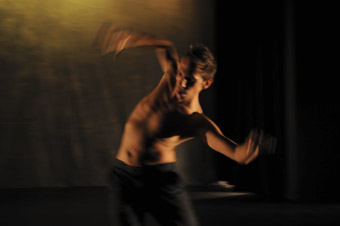
Martin Del Amo, It’s a Jungle Out There
photo Heidrun Löhr
Martin Del Amo, It’s a Jungle Out There
MARTIN DEL AMO IS UBIQUITOUS. HE POPS UP WILD HAIRED AND UNDIE-CLAD SO OFTEN ON THE SYDNEY UNDERGROUND DANCE LANDSCAPE THAT EXPECTATION IS FASHIONED BY FAMILIARITY. YET HE SURPRISES. HIS INSOUCIANT BELIEF IN THE INHERENT WORTH OF WHAT HE HAS TO SAY GIVES HIS WORK A TRADEMARK INTENSITY THAT RESULTS FROM THE PIQUANCY OF FASCINATION AND RESEARCH. WHATEVER DEL AMO IS INVESTIGATING, IT IS DONE WITH A FEROCIOUS AND METICULOUS ATTENTION THAT IS A LUST TO DISCOVER, UNCOVER AND REVEAL.
It is this lust that saves It’s a Jungle Out There from cliché. The work’s stated intention is to explore “the modern city as an ever changing organism.” Within such a topic lies potential for trite statements about regulation, hurried temporalities, frayed nerves and harried obedience. And Del Amo does make such statements. But he tempers predictability with the truths that emerge from research. He does not merely condemn ‘the city’ as a Gomorrah of undisputed self-interest; he also investigates it as a site of fertile possibility. Dance becomes embodied investigation and his body asks: what is it to exist in this landscape?
The invited opening night crowd warble in. Just sitting atop this diffuse murmur is another muffled voice. Del Amo is crossing the stage in straight lines, incessantly speaking numbers into a head mike. I am surprised by his modest and conservative clothing and tamed hair. Nearly corporate, neat, almost sharp. Gail Priest’s soundscape rumbles subterraneously and like the hum of a city goes almost unnoticed until it erupts into occasional porcelain scratches that hurt my teeth. In the black and grey space the numbers get louder and del Amo gets closer. The dancer’s shadows loom large and small, walking away from self. Numbers engorge themselves into ridiculousness then transform into pithy scenic descriptions. Del Amo’s voice remains incessant and constant, occasionally yelling to break the hypnotic patina. Now the script is akin to rapping, and rhythm is meaning. This first section is building with an almost foreboding rhythmic curve that stops me laughing at the very funny things he throws at us. As the performance unfolds this rise to climax and subsequent release will occur with regularity, even predictability, but it still works.
In his attention to detail, del Amo asks me to notice it too. In this opening section, walking is the dance. Each step is lovely. Each step is soft, loving the ground. Focused feet articulate bones, shifting in repetition and variation. In cities we walk. Cities make us walk. And this particular walking, slightly knock-kneed, sure but not bored, is both heartbeat and journey.
The climax rips apart the hypnosis of repetition. Lights flash and flare blindingly to shake us out of the zone. Almost reassuringly del Amo has removed his smart city shirt and his shadowed and naked torso swings and creaks like a rusty gate in the wind.
Section 3 presents as a lecture. Quietly del Amo brings out a microphone stand and delivers a monologue about a particular kind of urban agoraphobia where sufferers are compelled to build life-like models of the outside world inside the safety of their homes. Like so many of the artist’s observations, the potency resides in an admixture of disquiet and humour.
The disquiet tumbles into section 4 where del Amo runs and runs, round and round, carving the neverending figure eight pathways that now sit layered on the linear grids, mashing up space, making mess. To Priest’s repetitious pulse he runs backwards and forwards, he dodges, weaves, reaches, turns, twists, throws with a kind of focused anxiety rooted in the torso. The legs keep running. He sweats. I am getting warmer. And I realise that one of del Amo’s gifts is the creation of atmosphere through an embodiment that knows exactly why it is doing what it is doing and will keep on doing it. His use of repetition, development and variation allows these atmospheres to build through diffusion, thickening of temperature and sculpted temporalities.
As his breathing calms, section 5 develops into a square dance of negotiation: small steps forward, back and side create little lines of direct action. Restraint and constraint drive the performance down to mad quantum ruminations. Do the little red and green men who live in traffic lights change location? Do they talk to each other?
Emerging from this performance I am close to wordless. Like leaving a David Lynch movie, I don’t quite know where I am. The sensation is dreamlike, but not fuzzy. This dream is ripe with observational truth, clarities born of flesh, rhythm and atmosphere. It is not the clarity of intellect but of mindful body-in-place. This is because Martin Del Amo is a researcher. He does not seek to manufacture but to authenticate. He writes: “as part of my research for this piece, I conducted a series of excursions to heighten my perception of the city’s impact on the body. They included walking backwards through Sydney’s CBD, walking blindfolded along Parramatta Road during rush hour and crawling on all fours in the historic part of The Rocks.” From these bleeding-for-art excursions, blood, body, breath and rhythm speak.
Campbelltown Arts Centre Contemporary Dance Program, It’s a Jungle Out There, performer, devisor Martin del Amo, composer, live sound Gail Priest, lighting designer Travis Hodgson, designer Paul Matthews; Campbelltown Arts Centre, Sydney, June 25-27
RealTime issue #92 Aug-Sept 2009 pg. 36
© Pauline Manley; for permission to reproduce apply to realtime@realtimearts.net
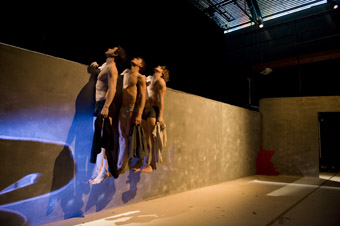
Nowhere Fast, Dance North
AN UGLY, GREY, DEAD END LIT BY A SINGLE STREETLIGHT AND OBSERVED BY THE COLD RED EYE OF A SURVEILLANCE CAMERA MOUNTED HIGH ON A WALL FORMS THE UNSYMPATHETIC SET OF DANCENORTH’S NOWHERE FAST. THE GRUBBY WALLS BEAR THE PENTIMENTI OF EARLIER TRAGEDIES—IS THAT A BLOODSTAIN IN THE CORNER?—BUT GIVE LITTLE ELSE AWAY. AS THE WORK UNFURLS THE SET FULFILS ITS PURPOSE, REPRESENTING BOTH THE OBSTACLE AND THE VOID AGAINST WHICH THE TWITTERING MASSES HURL THEMSELVES IN THE SEARCH FOR MEANING OR, AT THE VERY LEAST, SOME ATTENTION.
Nowhere Fast is Ross McCormack’s first full length choreography. The New Zealander has danced with the Royal New Zealand Ballet and Australian Dance Theatre, winning a Helpmann Award in 2004. He moved to Belgium to work with Les Ballets C de la B, and part of the idea for Nowhere Fast arose from the “urban loneliness” he observed living in the most densely populated country in Europe, as well as his concern for a generation experiencing “life at one remove” through a variety of new media. His principal visual influence is the work of American photographer Gregory Crewdson, whose meticulous set pieces reek of alienation within suburban ordinariness.
The musical score is the work of Jody Lloyd in his first foray into composition for dance. Much of it was developed in his studio, referencing McCormack’s rough ideas, Crewdson’s photographs, and DVDs of the work in progress. He spent the final two weeks prior to the show in Townsville working directly with the company, honing the atmosphere and pace of the varied soundtrack. It collages everything from ground shaking car stereo ‘doofdoof’ to Maria Callas to “squashed and pulled Hawaiian steel guitar”, solidly underpinning the action.
McCormack says he asked the six dancers to “put away technique to develop character, explore and express yourself emotionally.” The physicality, youth and raw strength of the Dancenorth ensemble rises to the task from the moment the work commences with a naked young man clambering over the wall to stand vulnerable and semi-exposed in the twilight. Initially, it’s as though D’Arcy Andrews, so unsure and awkward, has found himself there unexpectedly; and like the audience, is trying to figure out what’s going on. He pulls on underwear—dressing, undressing and clothes swapping are recurrent themes—and begins scrawling on the wall. Luke Hanna appears, fighting unseen demons, evoking Munch’s The Scream in his facial contortions and self-flagellation. Andrews observes tentatively, briefly mimics Hanna’s wild movements; Hanna licks Andrews, leaving a trail of bright blue across his body, but it is an arbitrary mark with no connection or empathy evident.
Hsin-Ju Chiu enters and Hanna and Andrews observe her warily as she primps and poses. Alice Hinde and Nicola Leahey join her and the three begin compulsively flicking their hair in unison, laughing flirtatiously but manically in a dance where the flicking becomes scruffing becomes violent scratching. The heels come off to be banged and dragged against the walls, but attention spans are short and Hanna is off tweaking the surveillance camera, and a shaking skinhead is emerging from the shadows, graffiti-ing the walls, chalk in both hands.
The shaking man, Joshua Thomson, draws, increasingly frenetic, leaping and circling rapidly, and suddenly he is a human compass, his head centred on the wall and his outstretched arms drawing a near perfect circle as he spins on the spot. He stops and turns, resting his back against the wall, arms still wide—a latter day Vitruvian Man for an instant, having just created a bespoke frame for his exact proportions. As he slathers his head with magenta paint, his eyes and veins popping, a shot rings out and Thomson convulses in death throes. Writhing in Goya-esque agonies, he then enacts suicide by decapitation, disembowelment, strangulation, in a distressing and relentless, but utterly compelling sequence.
Atop the wall perch the girls, a giggling trio, reaching toward Thomson, chirruping platitudes. “Awww, honey!”, croons Nicola Leahey inanely as the consummate Barbie doll. The incongruity of their responses reaches its height as Thomson opens his mouth to scream and they literally begin to drag him up the wall by his open mouth, before dropping him in a heap in the corner.
This scary juxtaposition of vacuousness and sheer muscle plays out in several scenarios within the work—another frantic sequence sees the group fling Hinde through the wall. They look at each other in silence. A dog barks in the distance. Andrews lamely attempts to reassemble the broken pieces of the wall to conceal Hinde’s inert form. Hsin-Ju holds out her mobile phone and films the accident scene. Leahey laughs and disrobes to divert attention to herself, running back and forth, dress on and off, posing against the wall art like a demented package tourist doing Rome in a day. The boys are momentarily amused before they too start running and stripping, looking off into the distance to see who’s observing them.
In the final sequence all the dancers perform a repetitive floor-slapping routine in unison, like a wordless prayer for connection. But, frustrated by their own clueless self-obsession, it is a one-step-forward, two-steps-back exercise in futility. A shirtless Hanna personifies their internal stasis by contorting his jawdropping physique into a state of semi-mobility, a marble Rodin under the white-blue light. All are as disparate in the end as they were in the beginning.
Nowhere Fast left some of its audience scratching for a storyline, accustomed as they are to the strong narratives in the works of former artistic director Gavin Webber. McCormack’s guest work taps the same vigour and grit the Dancenorth ensemble have become renowned for, perhaps less poetically, but to powerful, confronting and often unexpected effect. The disjointed feel of the piece; the frenzied action interspersed with loitering, watchfulness, imitation and self-conscious posing; the frustrated attempts at meaningful connection; all successfully capture the mood of an age where we are so busy media surfing in an effort not to miss anything that we are in danger of going nowhere, fast.
Dancenorth, Nowhere Fast, choreographer Ross McCormack, performers D’Arcy Andrews, Hsin-Ju Chiu, Luke Hanna, Alice Hinde, Nicola Leahey, Joshua Thomson, composer Jody Lloyd, lighting Natasha James, Townsville, July 1-5
RealTime issue #92 Aug-Sept 2009 pg. 36
© Bernadette Ashley; for permission to reproduce apply to realtime@realtimearts.net
KAREN THERESE’S THE RIOT ACT FOR CAMPBELLTOWN ARTS CENTRE IS A GRUELLING PORTRAYAL OF THE SYMPTOMS AND CONSEQUENCES OF SOCIAL DISADVANTAGE.
A conventional opening satirically trashes the caring rhetoric of politicians, bureaucrats and welfare NGO executives, their public platitudes eviscerated by a string of mobile phone calls they insist on answering. A subsequent media circus bribes the disaffected to perform badly, as expected, while behind the action huge projected graphs of crime rates and domestic abuse statistics in Sydney’s outer suburbs pulse by. Then everything changes. We’re transformed from our addicted media watcher selves into clinical observers of caged animals, society’s victims, in a world where time slows almost to a numb halt. The Riot Act has mutated into a largely mute, contemporary performance work where appalling states of being are doggedly examined.
This imploding non-time is interpolated with outbursts where the subjects abuse themselves and each other in acts sexist, racist and seemingly psychotic. Eventually a riot erupts from an apparently incidental trigger, igniting the fuel of accumulated pain and the delirium of insistent state surveillance. It’s a riot without an agenda, unplanned and with nowhere to go except more punishment and abjection—guilt confessed to the media, save for one dissenting voice.
The Riot Act offers neither small ‘l’ liberal comforts—there is rarely reassuring compassion in this non-society, rarely any reflection, sustained games, completed art—nor radical analysis. The riot itself is generalised: it doesn’t explode from a single motive—resisting or enacting racism in Cronulla or protesting police arrest in Macquarie Fields. Therese appears to be saying, specific trigger or not, the potential for riot is ever present given the abject states her subjects must endure. To amplify the danger inherent in this condition, she has chosen, in the style of Les Ballets C de la B, to convey a sense of real threat with performances that read like improvisation, unpredictable and sometimes visibly dangerous. But there is none of the Belgian company’s redemptive choreographic and musical collectivity. Therese’s performers are not allowed such spirit or virtuosity. It’s a risky strategy that inclines the Riot Act to one-dimensionality, melodrama (compounded by a point-scoring sound score) and formlessness. That said, the performances are passionately committed and, like a bad dream of a life you would not want anyone to live, the Riot Act worries at you weeks after you’ve peered into its darkness. The Campbelltown Arts Centre has boldly championed a challenging if challenged work.
The Riot Act, director Karen Therese, performers Matthew Day, Matt Prest, XX, Lalau Leo Tanoi, Latai Tauoepeau, Lizzie Thompson, design Mirabelle Wouters, Lara Thoms, sound design James Brown, Gail Priest, dramaturg Chris Mead, movement Kathy Cogill, video Scott Otto Anderson, lighting Paul Osborne, producer Annemarie Dalziel; Campbelltown Arts Centre, June 4-13
RealTime issue #92 Aug-Sept 2009 pg. 38
© Keith Gallasch; for permission to reproduce apply to realtime@realtimearts.net
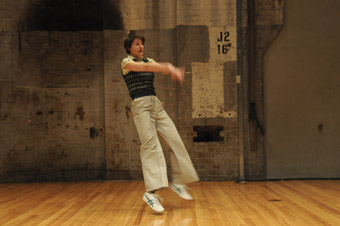
Rosie Dennis, Fraudulent Behaviour
photo Heidrun Löhr
Rosie Dennis, Fraudulent Behaviour
IS THIS THE REAL THING—ROSE DENNIS, IN A SHOW CALLED FRAUDULENT BEHAVIOUR, WITH WHITEBOARD, CHATTING AMIABLY TO US LIKE A RACONTEUR, LECTURER, STAND-UP THEORIST, FOR THE BEST PART OF AN HOUR? OR A FRAUD, A FAKE—NOT THE FAMED, REAL ROSIE DENNIS OF 20-MINUTE TOURETTE-ISH BOUTS OF QUICKFIRE POETRY AND SPASMS OF LOVE AND OTHER ANXIETIES.
This Rosie Dennis whiteboards Nietsche’s “We need lies in order to live”, rattles off a long list of everyday and sometimes very funny, lateral untruths that illustrate how we deceive others and ourselves and then breaks away to have a familiar word or two with a decoy duck in a bowl on a plinth. She inexplicably dances at length in loping, elegant strides and tight turns to Tom Waits. That seems innocent enough, unless she’s in a reverie, a private lie of being somewhere or someone else and ‘big in Japan.’
Next on the whiteboard is Herman Hesse: “There is no reality except the one contained within us; that’s why so many of us live unreal lives.” We are introduced, consequently, to an imaginary childhood friend, Elvira, who subverts the laws of physics and time and will take Dennis “to paradise one day.” This comforting lie segues into an account of a couple living out another, the ‘paradise’ of co-dependency. And on Dennis goes, delving into our snowdome reality (a sustained image both spoken and actual in the show) with a Paul Austerish intensification of coincidence and misconception as she recounts taking a long, perhaps potentially risky cab ride.
This other Rosie Dennis is an amusing then worrying confider, netting the sudden moments of self-awareness she prompts, trawling us with her into uncharted metaphysical outer space. By the end we might be missing the original manic Dennis a little, but this laidback substitute is just as scary, and possibly not a fraud at all, but the same person. Whatever, this new Rosie Dennis persona is an intriguing development, still evolving and not quite on top of her play with her puppet-ish props. But it’s lovely to be lied to so convincingly.
See our online producer Jo Skinner’s response to Fraudulent Behaviour, a video excerpt from the show and links to archived RealTime articles about Rosie Dennis.
Fraudulent Behaviour, performer, devisor Rosie Dennis, trumpet Simon Ferenci, Performance Space at CarriageWorks, June 11-12
RealTime issue #92 Aug-Sept 2009 pg. 38
© Keith Gallasch; for permission to reproduce apply to realtime@realtimearts.net
{$slideshow} THREE RECENT PRODUCTIONS MOUNTED AS PART OF THE VICTORIAN ARTS CENTRE’S FULL TILT PROGRAM HAD ME PONDERING THE SCIENCE OF INTERPRETATION. THE FIRST, A REMOUNT OF RED STITCH ACTORS THEATRE’S WONDERFUL RED SKY MORNING, WAS A BIT OF A SCHRODINGERIAN CAT. HAVING ALREADY SEEN IT IN ITS INITIAL INCARNATION AT RED STITCH’S TINY HOME IN ST KILDA, I WASN’T SURE HOW IT WOULD SURVIVE WHEN TRANSPLANTED TO THE BIGGER BOX OF THE ARTS CENTRE’S FAIRFAX STUDIO. I’M STILL UNCERTAIN WHETHER IT SURVIVED OR NOT.
red sky morning
I like to think the cat is alive. In Erwin Schrodinger’s famous thought experiment, we are meant to imagine a cat in a box along with poison which may be released without our knowledge. According to the physicist, the cat is both alive and dead until the moment the box is opened and, lo, we can observe the reality. Schrodinger wasn’t advocating the killing of cats, and I hope that nobody’s actually followed through with the experiment. But he was attempting to illustrate the limitations of a science that logically implied the possibility of incommensurable realities existing simultaneously. Which sounds to me suspiciously like art.
The play is, to my mind, one of the finest products of creative collaboration in years. It traces a day in the life of a family of three, all infected with a heart-wrenching depression that takes form in various ways. Mum suffers from a painfully realistic alcoholism that does away with simple clichés of the happy/angry/functional/dysfunctional drunk. Father is a painfully laconic figure whose inability to articulate his feelings has increasingly terrifying effects. Daughter’s teen frustrations make her a social pariah, unable to forge meaningful connections with her parents or peers. There is no obvious source for the dangerous black dog which menaces the family; its effects, however, are all too clear. Red Sky Morning is also very funny.
This is an astounding work of theatre that could only have resulted from an intensive association between its writer, director and performers over a long period of time. It’s exactly the kind of production I would want to see picked up by programs such as Full Tilt, allowing it to be exposed to a wider audience than Red Stitch’s considerable subscriber base alone. But of course I’m biased—having enjoyed its first outing so much, the cat is still alive for me. Transposing Red Sky Morning from a tiny St Kilda theatre to the sizeable Fairfax (which was itself curtained back to half its usual scale in order to maintain the tight forward focus of the original) may have reduced its effectiveness for newcomers, but I sincerely hope that this is a piece with a strong life ahead of it.
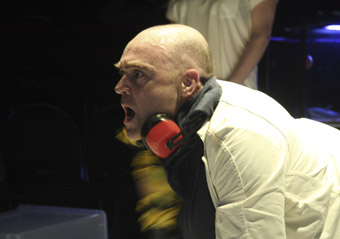
Simon King, Poet #7
photo Daisy Noyes
Simon King, Poet #7
poet #7
The second of Full Tilt’s most recent season of programmed works was a more difficult exercise. Ex-Melbourne playwright Ben Ellis has based himself in the UK for a number of years but his recent writing still has strong connections with the work he was producing here. One common thread is the use of apocalyptic scenarios: 2002’s Falling Petals saw the youth of a country town succumbing to a mysterious plague-like illness, while last year’s The Zombie State featured hordes of working-class undead ravaging Melbourne (RT88 online: www.realtimearts.net/article/issue88/9256). His theatre has often employed such imagery for political ends, to comment on the real dynamics and perils of contemporary culture. Like philosopher Slavoj Zizek, I’ve long been wary of the effectiveness of apocalypse as an ideological framing device—it’s all too easy (and disempowering) to imagine that radical change can only occur through a complete upheaval in society. Such scenarios, while undoubtedly terrifying, are seductive in the freedom from conventional morality and social bondage they envision, but are equally fantasies which deter us from imagining actual methods of altering the systems of power that presently exist.
Ellis doesn’t fall prey to this tendency, however, and Poet #7’s setting (or rather, settings) within a world that has undergone a cryptically-referred-to Armageddon are not accomplished simply in order to make crude comments on the problems of modern life. In fact, the setting would seem almost superfluous if it didn’t afford Ellis the chance to produce some wonderfully evocative poetry. The title of the piece refers to a poet recalled by one of the four narrators—a poet destroyed by a bomb blast while clasping the speaker’s hand, and which hand stays unwittingly clasped by the dazed speaker as he runs in terror from the scene.
We learn very little of the titular poet, and over the course of the play we don’t learn an awful lot of its characters either. Ellis’ script gives us four voices that each inhabit a different temporal zone. Though they’re related in various ways, it’s up to the audience to piece together a narrative from these fragmented chronologies. While it’s not unusual for theatre (or other art forms) to play with time in this way, it’s rarer to witness a work in which each character exists in complete temporal isolation.
Poet #7 is a fascinating experiment—appropriate given its lab-type setting and medical-procedural themes—but its consciously high level of formal stylisation will mean that any observer will come away with a different interpretation. Science knows, I haven’t found two people who can agree on what is actually supposed to have occurred in the piece, and responses have ranged from ecstatic to bored. Perhaps, in discovering the narrative ‘truth’ of the work, its aesthetic beauty loses focus—and vice versa. This variety of individual interpretations is itself a kind of Heisenberg Principle given dramatic expression. In any case, it’s the kind of boundary-pushing work seldom seen in a state arts centre.
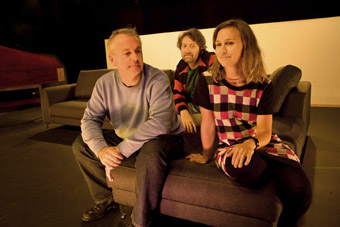
Affection, Ranters Theatre
photo James Boddington
Affection, Ranters Theatre
affection
Ranters Theatre’s recent works have been just as edgy, but as anyone who witnessed the brilliant Holiday will attest, their unique innovations are so thoroughly approachable that even the most wary of theatregoers will find themselves seduced. Affection isn’t as carefully crafted a work as Holiday, though it has developed from the same practices which informed that piece. It is styled as a hypernaturalistic series of conversations between people who appear as simply themselves—character, plot and backstory are dispensed with, and what we see is exactly what it is. This is harder to accomplish than it sounds. As audiences, we’re trained to look for deeper meanings, subtexts, the relationships and histories of the people we see onstage. Of course, we do this during Affection too, but the casual reticence of Ranters’ method makes us aware of our own role in constructing these narratives. Theatre no longer becomes a case of solving the mystery or finding the secret truth to a text, but instead forces us to consider that our own act of observing brings with it a history that massively affects our understanding of what we see. The Observer Effect, after all, isn’t limited to physics. Art is a science with infinite variables.
Red Stitch Actors Theatre, Red Sky Morning, writer Tom Holloway, director Sam Strong, performers David Whiteley, Sarah Sutherland, Erin Dewar, designer Peter Mumford; Fairfax Studio, June 3-13; Poet No. 7, writer Ben Ellis, director Daniel Schlusser, performers Edwina Wren, Merfyn Owen, Simon King, Georgina Capper, designer Meg White, sound designer, composer Darrin Verhagen, Martin Kay, Nick van Cuylenburg, lighting Kimberly Kwa, costumes Jemimah Reidy; The Black Box, June. 11-20; Ranters Theatre, Affection, text Raimondo Cortese, director, devisor Adriano Cortese, performers, co-devisors Beth Buchannan, Paul Lum, Patrick Moffatt, Anastasia Russel-Head, Heather Bolton The Black Box, Arts Centre, Melbourne, June 1-11
RealTime issue #92 Aug-Sept 2009 pg. 40
© John Bailey; for permission to reproduce apply to realtime@realtimearts.net
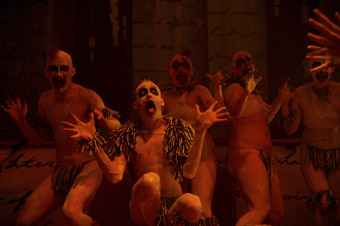
Calibans, Zen Zen Zo, Tempest
photo Simon Woods
Calibans, Zen Zen Zo, Tempest
THERE IS SOMETHING SWEET, ENTIRELY SINCERE, SOMETHING WHOLLY OWNED BY THE CAST AND CREW OF ZEN ZEN ZO PHYSICAL THEATRE’S ADAPTATION OF SHAKESPEARE’S THE TEMPEST THAT WEAVES ITS OWN SPELL. THE TEMPEST HAS BEEN DESCRIBED AS AN ATTEMPT TO ENVISION UTOPIA WITHOUT UTOPIANISM, AND THERE’S SOMEHOW AN OVERDETERMINATION IN THIS PRODUCTION THAT SEEMS TO BE SUITED TO THE NATURE OF SHAKESPEARE’S PLAY.
It doesn’t simply stem from the energy of the mainly young cast or the eclectic fusion of high art and pop culture tailored for young audiences, but from what can only be described as a residual faith in art on its ultimate borders where, as the critic Leslie A Fiedler points out, it becomes indistinguishable from sorcery. This production actually contemplates a transformation in the fundamental structures of everyday life, a concept that shouldn’t be so astonishingly novel nowadays when it seems nothing less will halt the headlong destruction of the planet. The Tempest is the most quotable of Shakespeare’s plays, including that one line about the whole globe dissolving, leaving not a rack behind.
Lynne Bradley’s director’s notes announce that the core message of the company’s version of The Tempest is that “it is every human being’s imperative to struggle for freedom—both political and personal.” All the characters, including Prospero himself, struggle to be freed from some kind of internal or external entrapment—to write, as it were, their own scripts. It is the courtiers and the politicians who are enmired. As we enter the space, we notice that visual director Simon Woods has writ large across the cavernous Concert Hall walls what look like reproductions from the Folio manuscripts, simultaneously creating the dioramic impression of waves round Prospero’s island and generating notions of the text as either a set of discourses or set in stone by claims made in the name of The Tempest’s timelessness and transcendence. Later on, with gesturing hands, Prospero will visibly underscore the demeaning irony of being trapped inside another person’s script against this backdrop. The Tempest is a play in which the word ‘strange’ is the most frequently used adjective, and we are inducted into this promenade style theatre by wandering among living statues, tableaux of the actors who are not simply still but emanate that ‘ferociousness of being’ that Rilke attributes to the presence of his angels. The atmosphere is ‘strange’, but it is we who are the strangers.
Zen Zen Zo aim to create total theatre, with “the spoken, physical, visual and aural texts all playing equal roles in imparting the meaning.” They are also a training institute, which accounts for their need for a large cast in order to incorporate students. Physical disciplines predominate, including the Suzuki Method, Butoh and Contact Dance. All three are usefully in there, but it is the Butoh movement adopted wholesale by the Caliban Chorus that amounts to a conceptual as well as physical tour de force. Zen Zen Zo has drawn from post-colonial readings of the play, and the Calibans are portrayed somewhat as the American Indian tribes encountered by English settlers in Shakespeare’s time (Pocahontas met Ben Jonson): almost naked, hair tufts and terrifying facial war paint. These Ur-Indians who are also Butoh exponents might seem a bridge too far, but they could hardly be real Indians. Caliban was part fish, already ersatz. They are the European Other everywhere who must be taught language (as Prospero teaches Caliban) as a technique of colonial rule. In fact, the Calibans are the fantasy of the Other owned up to, swallowed and vomited forth—quite horrifying in the permutations of their degradation by the insouciant in-comers to the island. I flinched. What was magnificent, in balance, was the log rebellion, the mass enaction of Caliban’s suggestion to his outlander co-conspirators, Stephano and Trinculo, that they stave in Prospero’s head. Dale Thorburn articulated Caliban’s position well.
Music is the foundation of The Tempest: “Sounds and sweet airs that give delight and hurt not.” The music makers on stage are Ariel and Prospero, cabaret artiste Emma Dean and classic actor Brian Nason, doyen of his own Grin and Tonic Theatre Company in Brisbane: natural collaborators in terms of the play. Offstage the composers were Emma Dean and Colin Weber. Dean is a physical dynamo, snazzy, a musical virtuoso (piano and violin) and, indeed, the flighty Ariel threading the show. Nason is the ground. Properly irascible as his Prospero is, as internally conflicted, he has a lute player’s touch on Shakespeare’s language. Even in the soundaround his performance chimed. His final exchange with Caliban—“this thing of darkness I acknowledge mine”—shone with heartbreaking lambency.
Zen Zen Zo Physical Theatre, The Tempest, director Lynne Bradley, visual director Simon Woods, performers Bryan Nason, Emma Dean, Dale thorburn, Jill Guerts, Alex Mikic, Jamie Kable, Jane Cameron, Luke Kerridge, Alice Flynn, Carolyn Eccles, Jess Samin, Natalie Bak, Brigid Blanckenberg, Caesar Cordovana, Jamie Kendall, Alison McGregor, Emma Bleanay, Harriet Devlin, Krystal Hart, Oliver Skrzypczynski, Lisa Worthington, composers Emma Dean, Colin Webber, lighting designer Jason Glenwright, costume designer Angela White, set designers Drew der Kinderen, Lynne Bradley, Luke Kerridge; Old Queensland Museum, Brisbane, June 2-July 1
RealTime issue #92 Aug-Sept 2009 pg. 42
© Douglas Leonard; for permission to reproduce apply to realtime@realtimearts.net
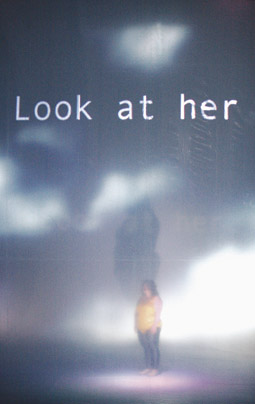
Food Court, Back to Back Theatre
photo Jeff Busby
Food Court, Back to Back Theatre
THE LAST TIME I SAW BACK TO BACK THEATRE, THEY WERE FRAMED BY THE CONCRETE PYLONS OF SYDNEY’S CIRCULAR QUAY RAILWAY STATION. IN THAT SHOW, SMALL METAL OBJECTS, THE SPECTATORS BECAME THE SPECTACLE—SITTING IN BLEACHERS IN THE CUSTOMS HOUSE FORECOURT—WHILE THE ACTORS EXPERTLY PERFORMED THEIR INVISIBILITY. IN FOOD COURT, HOWEVER, THE AUDIENCE SITS IN THE CONFINES OF THE OPERA THEATRE, ANONYMOUS AND UNSEEN, AS THE ACTORS ASSUME A SELF-CONSCIOUS HYPERVISIBILITY, COMPLETE WITH RED VELVET CURTAINS AND GOLD LEOTARDS.
Food Court begins with the three musicians from The Necks making their way down to the pit to take up their positions on piano (Chris Abrahams), double bass (Lloyd Swanton) and drums (Tony Buck). The opening notes sound out their instruments, each other, and the audience, two of whom cough in response. The red curtains open to reveal a wide and shallow stage with black drapes which part as a man carrying a wooden chair comes onto the stage. Soon he has set up three chairs and two gloriously, grotesquely overweight ladies in gold leotards (Rita Halabarc and Nicki Holland) join him. They parade like gymnasts at the end of a floor routine: arching, stretching, posing and mugging you might even say. Their glitzy leotards recall the circus or the freak show, where performers with disabilities have historically been placed, and for a moment we wonder whether this show will be any different.
The reply comes soon enough, as a thinner woman (Sarah Mainwaring) enters and seats herself, her hands shaking involuntarily. The other women interrupt their banal conversation—“Have you ever had a hamburger?”—to declare, for no apparent reason, “You’re fat.” Though the insults start with a false innocence—“I don’t want to upset you but…”—they soon come without apology: “You’re fat, you’re a fat lady, you’re disgusting, you’re embarrassing, lose some weight, she can’t even talk, learn to speak English.” The phrases are discomfiting not only because the text is projected onto the black curtains but also because they seem like comments the performers themselves might have heard over the years. When the surtitles falter momentarily it is as if the abuse has become literally unspeakable.
Without landing a single blow, the second act proceeds to unleash extraordinary violence. The black drapes part to reveal a scene behind a milky scrim, distorting the silhouettes behind it and making them seem far away. The music gathers apace as the two women, all the while screaming abuse, force the other to strip slowly and dance naked. When Mainwaring lopes elegantly across the stage, the lighting shifts and what was a black shadow becomes pink flesh as she oscillates to her own hidden rhythm, oddly beautiful. Someone steps in from the side, then another and another, and soon she is surrounded by a crowd standing and pointing at her. The image recalls a schoolyard, a desolate car park, and an asylum, all at once.
When the crowd leaves the stage, the scene shifts and we see a projection of a forest and sky that looks like a Bill Henson photograph. We are in the same liminal zone that his images occupy, though instead of being on the child/adult threshold we are on the border of the human/inhuman or what has been called in the context of Romeo Castelluci’s work (a possible influence) the human/dis-human. One of the characters even calls the victim an “animal person” as they proceed to brutally and relentlessly beat her. In the midst of this violence, there are absurd demands for intimacy: from one gold lycra’d lady to another; from a lonely man (Marc Deans) to the lifeless victim. The scene reaches fever pitch when the victim wrenches the following from her body (and lone letters simultaneously dance into words on the scrim): “Be not afeared. The isle is full of noises, Sounds, and sweet airs, that give delight and hurt not …” The lines are from Shakespeare’s The Tempest but by this time my febrile brain thinks of every island under the sun: the Island of Dr Moreau, Jules Verne’s Mysterious Island, John Donne’s “No man is an island”, Australia. This chain of thought is typical of the many associations that every image in Food Court creates. Finally, the back screen and scrim fall away, revealing a figure that is brave, humble and all too human.
The image fades, the music softens, and the retina starts to restore itself but the show offers little consolation; even during the curtain call one of the performers appears ill and walks off stage. She is not alone in feeling off balance—coming up into the night air I have a dizzying sense of the bends, a desperate desire to decompress. Compression is key to Food Court, which, like an elegant picture of barbed wire, depicts violence, beauty and tragedy in a single piercing image. Food Court pricks the conscience, senses, skin.
Back to Back Theatre and The Necks, Food Court, director, set design, devisor Bruce Gladwin, performers, devisors Mark Deans, Rita Halabarc, Nicki Holland, Sarah Mainwaring Scott Price, music by The Necks, set design Mark Cuthbertson, lighting design and technical direction Andrew Livingston, bluebottle, animated design Rhian Hinkley, sound design Hugh Covill, costume design Shio Otani; Luminous program, part of Vivid Sydney, Festival of Music Light & Ideas, Opera Theatre, Sydney Opera House, June 9-10
RealTime issue #92 Aug-Sept 2009 pg. 42
© Caroline Wake; for permission to reproduce apply to realtime@realtimearts.net
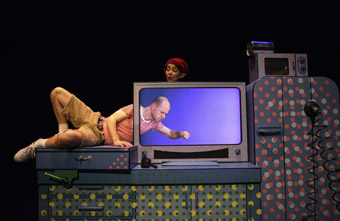
Jeff Michel, Sabrina D’Angelo, The Falling Room and the Flying Room, Terrapin Puppet Theatre
photo Sean Fennessy
Jeff Michel, Sabrina D’Angelo, The Falling Room and the Flying Room, Terrapin Puppet Theatre
TERRAPIN’S LATEST SHOW CONTINUES THE COMPANY’S INVESTIGATIONS INTO THE NEW REALM OF DIGITAL PUPPETRY. IN EFFECT WHAT YOU GET WHEN YOU SEE THEIR NEW SHOW, THE FALLING ROOM AND THE FLYING ROOM, IS A SORT OF EXPERIMENTAL THEATRE AIMED AT CHILDREN.
As with Terrapin’s Helena and the Journey Of The Hello, there are ‘Wow!’ moments where I was impressed by very clever devices and nicely thought through ideas. The strong, clear narrative drives everything: Samuel Paxton, a young lad with a lot of energy and imagination, is being somewhat ignored by his grumpy family, so he tackles their grumpiness, and his loneliness, by making a wonderful machine that contains special spaces—the falling room and the flying room. Sam makes his magical creations by ‘fixing’ old junk from the back shed. He’s a curious fellow who exhibits a streak of self-reliance and invention—he might even be an artist in the making.
Eventually Sam moves into the shed with a big screen he can crawl into and literally be on TV—transformed into pixels but still present. This is the digital puppetry terrain Terrapin is investigating—a highly choreographed effect whereby an actor’s arms can reach into a TV screen and be seen on it—like looking at someone reaching into a fish tank, or even climbing into it. Puppets drift in and out of this screen world as well in a deftly executed bit of theatre that excited me. It was pretty clever but, vital to the narrative, never an end in itself. Sam effectively discovers re-contexualisation as a way of of re-making the world and even making it a bit better, at least for him and his dysfunctional family.
In fixing all the broken stuff in the shed—magically making something better rather than simply restoring its former function—Sam repairs his family as well. They all get together and play with his crazy machines. The distant parents recall falling in love, remembering its importance and that doing things together is what a family does. There’s a kind of healing in this play about about human interaction that could be understood in the imagination-ruled world of an eight-year old child and by any adult.
The cast had a lot of work to do: Sam was brought to life by Jeff Michel while Sabrina D’Angelo played all the other characters including the family members and the elf Sabrina who guided Sam about, all the while never speaking or quite being seen by him. More than comic relief—with her silent asides—for a primary school audience, she seemed to me like the boy’s muse.
D’Angelo’s direct communication with the audience and Michel’s wandering into the auditorium reduced the somewhat distant staging at the Theatre Royal. The theatre is by no means cavernous, but The Falling Room and The Flying Room is an intimate show that wants strong contact with the audience to get the magic flowing. Luckily, the show is built to tour 40 schools across Tasmania, so up close is how most children are going to encounter Samuel Paxton, his family, his magic rooms and his sneaky elf pal in their endearing world.
Terrapin Puppet Theatre, The Falling Room and the Flying Room, director Frank Newman, writer Finegan Kruckmeyer, performers Sabrina D’Angelo, Jeff Michel, design Rachel Lang, puppets and props design Greg Methé, sound design, music Fred Showell, video animation Solid Orange, lighting designer Reuben Hopkins; Theatre Royal, Hobart, June 10, 11
RealTime issue #92 Aug-Sept 2009 pg. 44
© Andrew Harper; for permission to reproduce apply to realtime@realtimearts.net
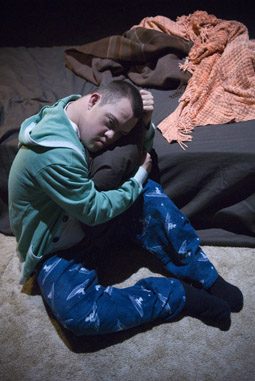
Andrew Pandos, Bedroom Dancing, Restless Dance Theatre
photo David Wilson
Andrew Pandos, Bedroom Dancing, Restless Dance Theatre
THE INTIMATE PRIVACY OF THE BEDROOM MAKES IT AN APPEALING—YET SOMEHOW DISARMING, EVEN UNSETTLING—SUBJECT FOR SPECTACLE. THE APPEALS OF EXPOSURE AND INSIGHT ARE GENUINE, BUT THE SENSE OF INTRUSION IS DIFFICULT TO SHAKE. BEDROOM DANCING FROM RESTLESS DANCE THEATRE EXHIBITED THE CONTENTS AND OCCUPANTS OF 15 BEDROOMS IN ADELAIDE’S GUTTED QUEEN’S THEATRE.
In the foyer, a video-installation from Lachlan Tetlow-Stuart invited spectators into bed with the cast. Spectators could snuggle up to a pillow and listen to sweet whispers from a speaker concealed within, while video projections of the performers one-by-one sprawled and rolled their way across the vertically-mounted double mattress. Inside the space, the audience were welcome to walk through and watch as bedroom scenes on adolescent themes were played out.
Evenly dispersed on squares of carpet—like booths in an exhibition hall, the beds were single and, for the most part, solitary. Their occupants were preoccupied with various choreographic tasks. Sleeping—even pretending to sleep—did not figure prominently in the work. Rather, the bedrooms were personal zones of retreat, their occupants engaged in world-making and connecting at a distance, communing with objects and media projections of stylised selves.
The mattresses and bedspreads—those soft, intimate technologies of comfort, warmth and enclosure—were, for the most part, misused and displaced. In one room, the bed itself was upended, the bed clothes spilling out in a twisted mess. In another upset gesture, the mattress became a trampoline in defiant memory of however many times a parent told us not to jump on the bed.
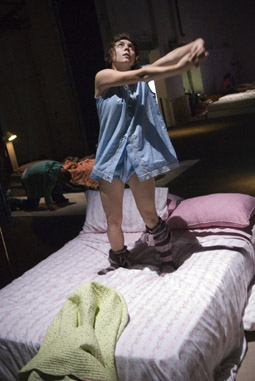
Kyra Kimpton, Bedroom Dancing, Restless Dance Theatre
photo David Wilson
Kyra Kimpton, Bedroom Dancing, Restless Dance Theatre
At an audio installation in the middle of the exhibit, one performer explained that “dancing in the bedroom is not what I usually do.” What distinguished each bedroom were the activities and technologies—some old, some new—of play and escape: a pair of dice, a jigsaw, some toy soldiers, a ukulele, a torch and a book, pencils and paper, travel magazines, a CD player, a radio, a laptop with Skype video-conferencing.
As a piece of dance theatre, Bedroom Dancing was a large-scale assemblage—a collaboration between 15 performers of the Restless Youth Ensemble and an artistic team comprising director Steve Mayhew, choreographer Alison Currie, designer Gaelle Mellis, sound artist Jason Sweeney and lighting designer Ben Shaw. It was also a project for a company in transition, initiated by outgoing artistic director Ingrid Voorendt and staged as incomer Philip Channells took up the role.
Presented as part of Come Out 2009, the Australian arts festival for young people, Bedroom Dancing attracted strong audiences over the course of a week. There were almost too many spectators at the performance I attended. Walking amongst the bedrooms and the crowd entailed an up-close relation of looking down at the performers’ work, which tended to individualise and isolate each bedroom as an exhibit in itself.
Instead of wandering from exhibit to exhibit, I found myself wanting to get down low and look across—to see and sense connections and relations across the array of bedrooms. But opportunities for a wide-angled, zoomed-out focus were difficult to grasp, until, cued by Sweeney’s sound work, the performance climaxed in a communal shudder.
Occasionally during the performance, some dancers visited each other’s bedrooms where they danced together for a while. These were welcome moments because they enacted a desire for contact to cut across the cell-like isolation of the exhibits. Prompted by memories of the adolescent loneliness evoked in this work, I felt a desire for more of these moments of connection across bedrooms.
Contact and connection are the hallmarks of Unreasonable Adults’ successful Gift/Back series. In its latest incarnation as part of Come Out, Unreasonable Adults invited young people to participate in the gift-exchange of supplying raw materials with which the artists make art. The artists called for gifts of a virtual, mediated or actual kind. Kids donated photos, drawings and paintings of themselves and their worlds. They also donated dolls, bears and cartoon characters, popsicle puppets, a clock, a billy cart and a large bag of rice, the names of some colours and some scraps of text. The artists’ undertaking was to use and respond to all they received.
The resulting mix-and-match process yields outcomes both inherently surreal and intimately connected to their audience. As an avant-garde approach to the making of art, the Gift/Back technique seems uncannily suited to a young audience. In creating opportunities for contribution, participation and recognition, it also models an artful ethic of re-use, re-cycling and re-invention which merits emulation.
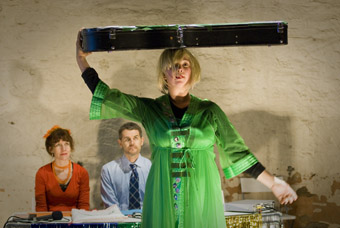
Julie Vulcan, Jason Sweeney, Kerrin Rowlands, Gift/Back, Unreasonable Adults
photo Sam Oster
Julie Vulcan, Jason Sweeney, Kerrin Rowlands, Gift/Back, Unreasonable Adults
At the performance I attended, the audience sat—cross-legged, of course—on squares of carpet in the Queen Theatre’s second space. We were addressed by the performers directly. The structural clarity of the work—with its step-by-step articulation of segments and an hilarious half-time break for orange slices and odour-ama—revealed an almost educational aptitude for engaging the audience in a process of aesthetic elaboration. I was taken by the work.
The look was colourful and bright. Three performers—Julie Vulcan dressed in orange, Kerrin Rowlands in green and Jason Sweeney in blue—performed a series of meditations on the value of colour in our world. Caroline Daish appeared remotely as an animated face. The set was as vibrant as children’s television. The mood was lively and engaging, the themes just slightly sinister.
Vulcan, addressing the audience in story-book mode, invites us to consider a world in which the colours orange, green and blue are replaced wherever they appear with dismal shades of grey. With excess affect, Rowlands dances in an apple-green negligee with a guitar case, the contents of which remain unrevealed. Intimate on live video, Sweeney tells a stick puppet story of lost children and croons a medley of blue tunes.
The work was intriguing, visually delightful and gently subversive with its imaginative narratives of abnegation and loss. The pleasures for an audience of young adults at the evening performance were apparent. The performers seemed ready to entertain, freshened perhaps by the afternoon performance to an audience of parents and children.
I attended the evening performance so I can’t say how the work played to children. But if I had taken a child or two I would have been grateful for their opportunity to participate in the artful reciprocity of Unreasonable Adult’s Gift/Back.
Come Out 2009: Restless Dance Theatre, Bedroom Dancing, devised and performed by the Restless Youth Ensemble, director Steve Mayhew, choreographer Alison Currie, design Gaelle Mellis, sound Jason Sweeney, lighting Ben Shaw; Queen’s Theatre, May 15-22; Unreasonable Adults, Gift/Back, Caroline Daish, Kerrin Rowlands, Fiona Sprott, Jason Sweeney, Julie Vulcan, Queen’s Theatre, Adelaide, May 29, 30
RealTime issue #92 Aug-Sept 2009 pg. 45
© Jonathan Bollen; for permission to reproduce apply to realtime@realtimearts.net
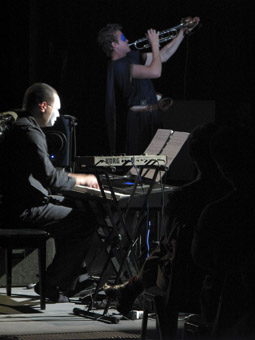
Michael Fowler, Tristram Williams, Act II, LICHT
photo SIAL Sound Studios (Lawrence Harvey)
Michael Fowler, Tristram Williams, Act II, LICHT
IN THE ATRIUM OF SYDNEY CONSERVATORIUM, A FANFARE DESCENDS FROM THE UPPER LEVELS, WELCOMING A MIX OF VISITORS AND AUDIENCES TO THE SMART LIGHT FESTIVAL’S STOCKHAUSEN PROGRAM, A DAY OF LIGHT. THE STARK MELODY, MARKED BY VISCERAL BREATH ACCENTS ON PICCOLO, ACCOMPANIED BY CLARINET AND BARITONE SAXOPHONE IS, HOWEVER, VASTLY DIFFERENT FROM A TRADITIONAL PUNCHY, OPTIMISTIC BRASS FANFARE. WHAT BEGINS IN THE ATRIUM CONTINUES ON IN AN UNRELENTING CYCLE, PUNCTUATED BY LONG SILENCES AND TURNING INTO A MUSICAL JUGGERNAUT, SEEMINGLY UNSTOPPABLE AND ALWAYS UNRESOLVED. THIS IS THE LICHT-RUFT (1995), THE EPIC FANFARE INTRODUCTION TO KARLHEINZ STOCKHAUSEN’S SEVEN-DAY OPERA CYCLE, LICHT (LIGHT).
An hour after it began, the fanfare did indeed prove to be unstoppable, as it continued to play while audiences were ushered into a small recital hall to hear two Stockhausen works performed by Ensemble Offspring. Setz Die Segel Zur Sonne (Set sail for the sun), delicately evolved from a contemplative opening ambience. Part of a series of text-based works titled Aus Den Sieben Tage (From the seven days, 1968), this piece was treated with necessary reverence by the performers. The works comprise vague yet poetic guidelines for improvisation, such as “play a note for so long/ until you hear its individual vibrations” and “…slowly move your tone/ until you arrive at a complete harmony/ and the whole sound turns to gold,/ to pure, gently shimmering fire.”
For a composer often identified as belonging to a European avant-garde known for treating every musical parameter with the utmost precision and detail, in this work Stockhausen demonstrates a fierce creativity and extreme openness in finding new musical terrain. In this rendition, the ensemble interacted through subtle sculpting of dynamics and blending of instrumental colour, resulting in a delicate balance and an ethereal quality, never dominated by an individual player.
Tierkreis (Zodiac, 1975), a series of melodies based on the signs of the Zodiac, represented a vastly different compositional approach, the melodic character a radical departure from the textural and atmospheric nature of the opening work. More traditional in comparison with many of Stockhausen’s works, and characterised by unusual scaleic materials and intervallic harmonies, Tierkreis was at times reminiscent of Stravinsky—sometimes haunting and simple, at other times driving and rhythmically complex.
Originally composed for three music boxes as part of a children’s theatre show, these pieces can be performed for any combination of suitable instruments. Ensemble Offspring’s rendition moved through a colourful array of instrumental combinations and playing techniques. Arranged for clarinets, flutes, percussion, piano, toy piano, accordion, melodica and celeste, this version was never dull as new sounds injected fresh energy into the piece throughout. Perhaps the most poignant moment was provided by the sound of a fragile solo music box, seeming all the more vulnerable when exposed by a single spotlight. There were dramatic elements too that breathed additional life into the performance—Clare Edwardes swinging a cowbell while walking through the space and Jason Noble marching around the stage performing a melody on his clarinet.
The creative interpretation of these works conveyed a sense of daring that seemed to be relished by Ensemble Offspring. This was a beautifully curated concert; the material well balanced and standard chamber music conventions interrogated.
The audience emerges into the Atrium, the LICHT fanfare continues. The juggernaut rolls on and already we sense the prolific, intense output of this composer.
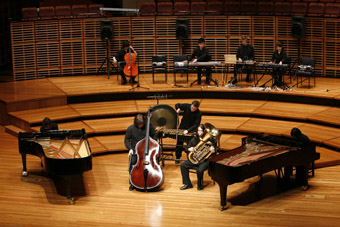
Licht
photo David Clare
Licht
Following Ensemble Offspring, The Song Company performed two works, taking us directly into the world of the opera, LICHT. The six-strong company were joined by six vocal students from the Conservatorium to perform Chor-Spirale, from Fritag aus LICHT (Friday of Light, 1994)—”six hybrid couples conceived as six candle flames unite into a single flame, spiralling up into heaven.” The use of glissandi and hissing added new colours to the conventional pallet of unaccompanied voices, and was executed with utmost precision under the direction of the curator of the Day of Light, Roland Peelman. As the piece evolved a solo bass and soprano moved respectively to the lower and upper extremes of their ranges. Towards the end, silences of increasing length added a new dimension, bringing with it a palpable tension.
From Sieben Lieder Der Tage (The Seven Songs of the Days), the Song Company then performed Montag aus LICHT (Monday from Light, 1986) adapted for six singers and piano. Each singer represented a day of the week and dressed in a corresponding colour. This visual element played out further as the singers, in two rows spread out across the stage, stood dead-pan waiting for their solos, all of which were delivered with dramatic poses or gesturing. Against this stark theatricality, the piano accompaniment—characterised by irregular rhythms and a chromatic spectrum of pitch material—maintained an ambling sense of flow.
The centerpiece of the day’s concerts was Act two from Dienstag aus Licht (Tuesday from LICHT, 1990-91), the Australian premiere of part of the cycle. In a darkened studio the work opened with an ominous electronic score. Drones, various timbres and occasional explosive gestures morphed and blended through an eight channel spatial mix, demonstrating Stockhausen’s remarkable skill in sustaining an homogenous texture over such a long duration. Perhaps this dark sound world is symbolic of the mountainside—the focal point in the story of the second act of Dienstag aus Licht.
Camouflaged by the similar pitch space of the electronic score, the sound of a trombone emerges from the mix and Lucifer, played by trombonist Ben Marks, enters. Moving around the stage, up one aisle, behind the audience, back down the other aisle and onto the stage again, all the while Marks performs fragmented phrases made more palpable by a set of gestures that point the trombone in different directions. The short phrases are punctuated further by occasional use of one of several mutes strapped to the player’s waist. It’s as if Lucifer is attempting to break through the mountain—the vast electronic score that continues to surround us. Although not presented in this modestly staged version, the mountainside is penetrated, revealing a metal wall. During a battle between Lucifer and Michael, played by trumpeter Tristram Williams, the wall disintegrates, revealing solid crystal.
A duet follows between the wounded Michael and Eva (Stockhausen’s variation on the biblical Eve), played by soprano Jess Aszodi. By now the electronic score modulates, allowing a greater depth of interaction between the performers and the score itself. Aszodi manages to successfully project her voice through a still very dense sound to blend with Williams’ trumpet. The unusual musical development of this extended piece was at times interspersed with extended techniques such as tongue clicks, whistling and inhalation sounds on the trumpet and might have been more succesful had Aszodi’s voice been amplified to bring greater clarity to these smaller sounds amidst the electronic wash. Nonetheless, her projection was remarkable under the circumstances. Both players conveyed a powerful stage presence through an extreme economy of physical movement.
The electronic score geared up once more and entered into another extended segue, this time in anticipation of Synthi-fou, a trickster figure who distracts the war-makers. Dressed in a multi-coloured robe and surrounded by a multi-synthesizer set-up, Michael Fowler performed this highly complex and intricate music with remarkable showmanship and ease. With manic laughter, over the top gestures and wide-eyed smiles, the eccentric performance culminated in Fowler standing to count down from 13, waving his hand with each count and slowing as he approached one. Synthi-fou’s broad pallet of sounds seemed to interact with and manipulate the electronic score, blending so well that it was, at times, hard to distinguish their source.
The fanfare, concerts, semi-staged opera extract and other events in Day of Light at the Con amply and admirably demonstrated over more than eight hours the epic nature of Stockhausen’s vision. Often the sheer duration of his works conveyed a force almost sufficient to intimidate even a curious and willing audience. As Andrew Ford remarked in his introduction to Ensemble Offspring’s program, Stockhausen’s creativity, now enjoying fresh recognition, was truly fierce and at his death in 2007, we lost a composer like no other.
Smart Light Sydney & Sydney Conservatorium of Music, A Day of Light at the Con, curator Roland Peelman, part of the Vivid Sydney Festival of Music, Light & Ideas, Sydney Conservatorium, June 6
RealTime issue #92 Aug-Sept 2009 pg. 46
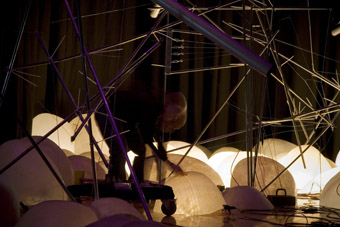
Plump, LA10 Sydney
photo Kazumichi Grime
Plump, LA10 Sydney
IT WAS SYDNEY LAPTOPPER ALEX WHITE WHO KICKED OFF THE FIRST CONCERT OF THE LIQUID ARCHITECTURE 10 PROGRAM AT CARRIAGEWORKS. HIS ARCHITECTURAL IMAGES WERE BUILT IN THE LISTENING SPACE FROM WHITE NOISE THAT ARRIVED, DISAPPEARED AND ACCUMULATED. IT WAS HARD TO LISTEN TO AT FIRST UNTIL HEARING ADJUSTED TO THE EMERGING SUBTLETIES WITHIN MULTIPLE SOUND-PIPES AND PULSES CROSSING TRAJECTORIES AND CAUSING A RUCKUS. VOLUME LEVELS WERE NOT HIGH BUT MY AUDITORY MEMBRANE STILL OSCILLATED WILDLY TO MAKE SENSE.
Surprisingly White had a couple of walk-outs but the work following him had most of us reaching for the ear plugs (supplied at the door) as West Australian musician Cat Hope alternately attacked and lulled the listener. Ear plugs were, however, no defence against an atmosphere pressurised and made tactile by imperceptibly low frequencies arising mysteriously from somewhere in the auditorium. Attuned perhaps to the ghosts of the funeral march Hope was interpreting, the body vibrated, depending on the particular frequencies she produced. These deep resonances were a long way from the silence notated (bars and staves only) by 19th century Chat Noir activist Alphonso Allais who inspired the work. He was long gone yet only traces of Hope’s physical presence were evident. Her apparition flickered across the video screen in indecipherably low-lit, live-feed images gradually providing clues to the nature of her concealment below the seating grid.
I found out later that we were hearing Hope’s bass guitar mediated by an array of effects and sub-woofer speakers. It was played variously by collisions with the seating superstructure or by simply coaxing sound out of it by more or less hitting parts of the instrument. This music was moving but not for the faint-hearted and many punters ran for it. The architecture felt the stress too with shockingly high pitched screams triggered in the lighting rig and mid-range metallic groans and murmurs vibrating in the seating structures. This Cat was playing the room, co-opting the building into her program and providing the most challenging work in this year’s Sydney concerts.
A little easier on the body was Bradbury. The image of a wax light was projected as beautiful bell sounds began the first of about nine pieces. Bradbury has a unique, recognizable style favouring short pieces and often re-moulding material into beats or reconfiguring field recordings into new contexts. One piece mixed a Jimmy Saville style TV shopping salesman and flat piano tones with delay drenched loops transforming from humour into a poignant statement about commercialism.
The clarity of Bradbury’s video projection was replaced for Thomas Köner’s piece by more obscured objects. It would take Imax technology for Koner’s projected images to successfully match up to the enormous spectrum of sound he created. The looped vision of a metro train journey and various ghostly humans superimposed onto similarly smeared locations became a puzzling distraction from the immersive engagement of his sound world. I greatly enjoyed the intriguing aestheticisation of the everyday via the overheard but indistinct human voices set amidst grand, airborne sonic gestures. At one point a passing jet seemed to have entered the space even though the expected decay of its passing was never realised.
Köner’s approach shared some aesthetic points with Asmus Tietchens who closed the Saturday concert. Tietchens as one of the innovators of electronic music in Germany has had an enormous influence on the form since the 1970s. He created a wonderland of sound, layering frequencies in a concerto supported by a riveting bottom end through to high-pitched ringing with occasional bursts from every register in between. Machinistic throbs were sunk into hypnotic ground and opposed by sudden fanfares which were then subsumed into the underlying pulses. The composition was very finely crafted, working with rhythmic oscillations and many unidentifiable and peculiar creations constantly reconstituted by Tietchens’ settings. Attention to detail was as delicate as the harpist’s stroke, one of the transitions dropping down into an almost inaudible range.
Unlike Tietchens and his colleagues of the men-at-tables ilk, Plump explored the sound qualities of a sculptural installation they had constructed over the five hours preceding Saturday night’s concert. It took up most of the performance area of the theatre. They played a surprisingly restrained set considering the scale of the instrument—a series of angular but asymmetrical suspensions of cable and scaffold-like aluminum. All this was complemented by a dozen or so randomly placed, mis-shapen light shades about the size of physio balls. Marc Rogerson controlled these from upstage by using hand-held arcing low-voltage contacts across a live power board. Philip Samartzis began with soft cricket whispers yielding eventually to many clangs and cries from Dave Brown’s bowing and tapping. Ringing, cello-like laments combined with electronic interpretations of sounds picked up from various contact points around the structure and processed by Samartzis. We could have been witnessing the capture of the musician by some terrible arachno-robotic figure as Brown provoked and stroked the beast variously by hammer and bow to produce ‘architectural’ music par excellence.
Opening the Saturday night concert alongside the imposing Plump sculpture, Somaya Langley was a diminutive figure in her suit of triggers and hanging projection surfaces. Her piece was, however, underwritten by some big ideas and the modulated swoosh and crash of her limbic sound-triggering produced some tasty sonic onomatopoeia.
Whirlpool (Chris Abrahams playing pedal harmonium and Kraig Grady on prepared vibraphone) followed Plump after the interval looking more austere but drawing from an enormous tonal pallette. Once acoustics had been contained by the ‘curtaining’ of the perimeter walls, the ringing began. Grady had repositioned the vibes’ metal bars unconventionally to create beautiful dissonances, enthralling beats and strange harmonies. They cut across and embedded themselves into the drones provided by Abrahams and it was hard to believe at times that they were both completely acoustic. Some of their discords struck disturbing resonances even in (or perhaps because of) the cavernous spaces of CarriageWorks. The piece was like an amalgam of gamelan with early Moog music as Abrahams demonstrated his penchant for extracting sonic modernity from pre-electronic keyboards.
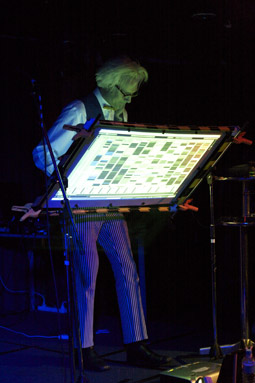
Marc Gunderson, LA10 Sydney
photo Kazumichi Grime
Marc Gunderson, LA10 Sydney
As compere Brent Clough noted, we were “sopping wet with sound” after these two concerts so it was hard to muster enthusiasm for DJ-driven music. But the 10th anniversary after-party at Hermann’s Bar (complete with a profiterole stack) also contained some unexpectedly exciting sound art. Best of these for me was Buttress O’Kneel (sic) who intervened with marvellous invention into some well-known pop using effects pedals to alter musical states in extreme ways. As ‘his’ androgynous mask and wig messed with our minds, his mix attacked Stairway to Heaven, the themes from Skippy and Sesame St not to mention the Australian national anthem—no cow was too sacred for deconstruction. This work would have easily fitted into the concert context—extraordinary found-sound noise art.
But it was the great humour of The Evolutionary Control Committee and the wonders of the “Vidimasher 3000” that rocked the room from the moment Mark Gunderson indicated that he had “got our attention.” He struck quite a figure with his Warholesque shock of peroxide hair and a goatee nearly reaching his sternum. Gunderson was attached to the Vidimasher 3000 via light triggers wired up to his fingers which controlled projected click buttons on a large canvas-like screen. In his capable hands this great showman DJ took us on an exciting journey via the most improbable combinations of songs. They were collapsed into Gunderson’s mixes in such a way that the uninitiated might assume them to be the originals: Led Zeppelin dueting with Hip-hop, La Belle with Dire Straits, Brittany Spears and Kermit the frog with the Jackson 5. All were twisted into a laudable and audible logic with other familiar beats and riff samples and subsumed into new creations with five or six layers of “copyright violations.” An exciting finish to a very sound weekend.
Liquid Architecture 10, Sydney directors Jennifer Teo, Shannon O’Neill, CarriageWorks, June 26, 27; Anniversary, Hermann’s Bar, Sydney University, June 27
RealTime issue #92 Aug-Sept 2009 pg. 48
© Tony Osborne; for permission to reproduce apply to realtime@realtimearts.net
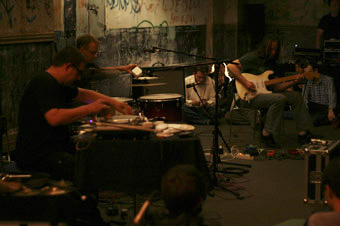
Perlonex, LA 10, Brisbane
photo Bryan Spencer
Perlonex, LA 10, Brisbane
NIGHT ONE. LONG NARROW ROOM, CUSHIONS ON THE FLOOR, A WELL DESERVED ROUND OF APPLAUSE AS LAWRENCE ENGLISH REMINDS EVERYONE THAT THIS IS THE 10TH ANNIVERSARY OF LIQUID ARCHITECTURE. A WOMAN AT THE FRONT DESK ASKS MY SON IF HE WANTS EARPLUGS. HE LEANS OVER TO ME AND ASKS, “WHAT SORT OF CONCERT NEEDS EARPLUGS?” ONE THAT IS, AT TIMES, FAR TOO LOUD. MAYBE AT TIMES LOUD ENOUGH TO CONSTITUTE ASSAULT AND LOUD ENOUGH TO CONTRAVENE APPROPRIATE CODES OF CONDUCT AS LAID DOWN BY SOMEBODY SOMEWHERE. I DON’T KNOW. WHEN IT GOT LOUD I CLOSED MY EARS, ALL THE BETTER TO HEAR ANOTHER DAY.
Perlonex (Ignaz Schick, turntables and electronics; Jörg Maria Zeger, electric guitars; Burkhard Beins, percussion) have been around for about a decade. Before things begin they ask for the air-conditioning to be turned off and then start soft, well below the noise floor the aircon had set up. Beins uses a small kit—drum, cymbal. He rubs something, maybe a rattle, around the drum head—friction drumming—and sets up a soft, sibilant drone. The rhythm is understated, a cyclical wave of changing amplitude. Cymbals hiss. Schick adds hints of electronics and underneath and barely perceptible Zeger plays a gently pulsed tonal wash on guitar. Homogenous ensemble playing, a single rich texture. Slow build up (unavoidable cliché of ambient music?), then ear-split into some ugly sounds, then slow relax. What’s the zeitgeist around this (pleasant ramps up to awful ramps down to release)? Is it disappointment? I thought life’d be good but it turned out nasty? Dunno, but there’s a lot of it about.
Asmus Tietchens and Thomas Köner each had solo sets on the second night. But on the first night they played together as Kontakt der Jünglinge. A no fanfare start. Crowd milling in the foyer hubbub and a drain gurgle looping a metrical pulse. Old school musique concrète, very tape, layers of field recordings and heavily processed/synthetic sounds. (Is there much of a difference between processed real and fully synthetic sounds now that sophisticated signal processing is a free download away?) The Stockhausen tradition comes through in the sequencing of quite abstract sound into coherent musical gestures. Volume is perfectly placed to let ambient and close miked recordings of different acoustics create spatial depth. Sub bass reminds us of the resonant properties of our body cavities. The bump and looping gurgle of the beginning comes back, decays into the noise floor of the air-conditioning. Exit.
Night the second. I arrive a little early to check out the two installations. Eugene Carchesio has a small piece, a few blinking lights in what looks like a jewellery display case. Unfortunately the piece gets lost in the space. Scott Arford has a sound+projection piece. Wide screen movies of bleached out and light-flared industrial scenes plus manipulated field recordings taken at the same industrial sites. The manipulation is minimal—underlying bassy drone, large metal doors being slammed, truck reversing beeps, chutes and engines. Each short piece is introduced by a black screen with a number—like a catalogue capturing industrial phenomena before it disappears.
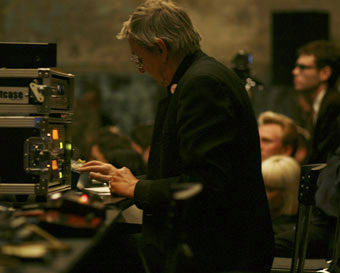
Asmus Tietchens, LA 10, Brisbane
photo Bryan Spencer
Asmus Tietchens, LA 10, Brisbane
Asmus Tietchens begins with filaments and layers of filtered noise. Occasional glitches burst then decay into hiss. Then the hiss slows to a crackle, drones give way and the crackle becomes marbles dropped into a jar. Each glassy plink dilates to become pitched and tonal. The smooth transformation of sounds, blended, layered and free-form looped; the varying scales of activity—from microsound to gesture to section—modulates our attentional focus into specifics and then away into layers of abstraction. Work that comes from a lifetime of listening and compositional refinement.
Thomas Köner presents video+sound in his solo set. A train slowly circles on an elevated track in a nondescript city—empty station to empty station. Unseen crowds murmur over a low and mournful tonal progression. The video floats, is blurred, solarised, fades in and out. Muted and grey, alien, slashes of garish colour; is the city real? Modelled? Second section and the sounds of mild explosions. People move slo-mo across the screen, outlined and hollow like cells under the microscope, sometimes they are opaque enough to hint at faces, the patterns of clothing. One person stands still for a while, slightly hunched, facing the camera, facing us. Implied accusation: Why are you there when we are here?
The setting looks architectural, but abstract, maybe a garden centre with stacked pots, maybe something completely different. It is hard to tell; there is obviously a meaning to the environment but that meaning is completely opaque—you just know there is a meaning there that you will never understand. It is as if one is profoundly outside, witnessing the residual echo of an unfathomable civilisation. More and more people appear, still ghostly, but now layering over each other. And instead of walking across the scene they start coming towards the camera, leaving traces of their paths, a history, glimpses of faces, parts and details, moving and layering until the screen looks like bitumen after the rain. Thunder cracks. Fade out and fade in to landscapes framed like a first-person homunculus staring out from the back of the skull. Fade again and back into the endless empty journey of the beginning. The train grinds to a halt, fades out, fades in to an urban wasteland. A child’s voice, an aimless dog. Clumps of stringy weeds and an abandoned access road, gravel pressed into the dirt. Traces of people walk past. The image fades one last time. A train sounds. A chord. Sub bass vibrates the room and is gone.
Liquid Architecture 10, curator Lawrence English, artists Joel Stern, Asmus Tietchens, Thomas Köner, Kontakt der Jünglinge, Jason Kahn, Perlonex, David Shea and Kristi Monfries, Plump (Dave Brown, Philip Samartzis, Marc Rogerson), Eugene Carchesio, Scott Arford; Brisbane Powerhouse, July 3-4
RealTime issue #92 Aug-Sept 2009 pg. 48
© Greg Hooper; for permission to reproduce apply to realtime@realtimearts.net
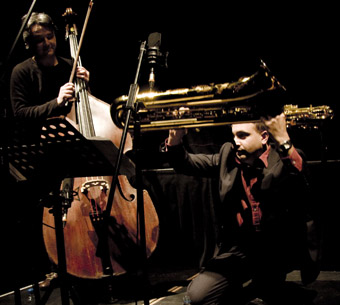
Mark Cauvin, Adam Simmons performing Syd Clayton’s “Yehudi”
photo Louise Cooper
Mark Cauvin, Adam Simmons performing Syd Clayton’s “Yehudi”
A DECADE IS A LONG TIME IN THE WORLD OF EXPERIMENTAL MUSIC AND SOUND, AND THE STAYING POWER OF THE ANNUAL LIQUID ARCHITECTURE FESTIVAL IS A TRIBUTE TO THE ORGANISERS, ARTISTS AND AUDIENCES WHO ENTHUSIASTICALLY SUPPORT IT. AROUND AUSTRALIA, THE ANNUAL LA SERIES OF CONCERTS, FORUMS AND WORKSHOPS SHOWCASE THIS FIELD AND ALSO CONTRIBUTE TO ITS DEVELOPMENT. IN MELBOURNE, LIQUID ARCHITECTURE CELEBRATED ITS 10TH SEASON WITH AN EXCELLENT PROGRAM OF NEW AND RECENT WORK BY LOCAL AND INTERNATIONAL ARTISTS, AND THE PRESENTATION OF SOME LEGENDARY PIECES, NOTABLY EDGARD VARÈSE’S POÈME ÉLECTRONIQUE.
friday july 10
The emphasis in the Friday night concert was on listening attentively in a darkened space, and it opened with the enchanting and gentle work of Hamburg-based Asmus Tietchens. Since he began in the mid-1960s Tietchens has become a senior figure in European sound art, working outside any specific genre and often collaborating with other artists. His piece begins almost inaudibly, simple lines drawing your attention, and soon you notice additional voicing bringing complexity and depth as you enter a relaxed state of awareness. The music seems spontaneous and fluid, and you forget how it is made and just absorb it. This is perhaps the hallmark of good sound art, indeed of any interesting sound. While technological change, such as the development of computers, has affected the process of making sound, in the best works musicality is retained.
A memorable performance by the established local duo of Anthea Caddy (cello) and Thembi Sodell (sampler) followed. Contrasting strongly with Tietchens’ subtle and understated ambience, Caddy and Sodell’s intense and expressionistic work is characterised by huge dynamics, strong textures and dramatic pauses. Theirs is a unique sound, blending acoustic and sampled elements and underpinned by strong live performance, adding a freshness that is sometimes absent from the calculated presentation of pre-programmed work.
Jason Kahn’s work appears to involve manipulating feedback to produce a dense and intense body of sound. His apparatus includes a sensitive microphone placed close to the skin of a bass drum mounted on its side, and a radio whose untuned static is fed into a synthesiser with the miked sound. Kahn sits in the middle of the auditorium within touching distance of the audience, and holds a steel plate or a small cymbal just above the drum skin, subtly changing the sound by moving the object slightly. Sitting one seat away, I was one of the few who could hear a little of the unmediated sound direct from these objects. This created a fascinating effect as the sound through the PA built up. The sound evolves only slightly and gradually during the performance, so you concentrate on subtle variations; Kahn’s poised minimalism was distinctly different from the complex works that preceded it.
Tietchens reappeared with Thomas Köner as the duo Kontakt de Jünglinge, whose name pays homage to Stockhausen, and whose music is again gentle and subtle, developing in complexity as it unfolds. Their work has a maturity born of decades of development and thought. Afterwards, LA Artistic Director Nat Bates aptly described their piece as work of “glacial delicacy and restraint.” The final work of the evening was a performance by Berlin trio Perlonex—electric guitar with effects pedals, percussion and an electronically mediated turntable plied with all manner of objects. Their carefully prepared piece began quietly and gathered in intensity, with the acoustic elements combining with multiple layers of morphed sound, again emphasising live performance.
saturday july 11
Whereas the program for the first night focused on aural experience, the second concert showcased the use of sound to support, or contradict, visual experience, and also looked back to the beginnings of sound art and experimental multimedia. First we were treated to a rendition of the late Melbourne sound artist Syd Clayton’s composition Yehudi (1968). As the audience filed into the auditorium, two people were seated at a small table near the stage, chatting. The audience waited and waited and eventually the two performers—Mark Cauvin (double bass) and Adam Simmons (bass saxophone)—picked up their instruments. The performance unfolded as a mixture of mime and unconventional playing, with nonsensical physical gestures, hoots and grunts and included a tea break in which the performers discussed the piece, boiled a kettle and asked audience members for a cigarette. This is comic theatre that comments seriously on the limitations of conventional musical performance.
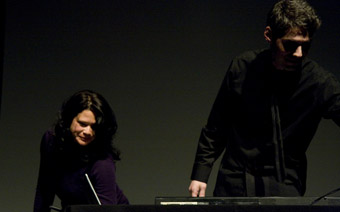
Kristi Monfries, David Shea; LA10 Melbourne
photo Louise Cooper
Kristi Monfries, David Shea; LA10 Melbourne
Another work with an historical thread followed—Kristi Monfries and David Shea’s video-sound work, the Art of Sampled Memory, that looked back at the work of Canadian experimental film-maker Arthur Lipsett. Lipsett edited the off-cuts of others’ films—mainly fragments of newsreels and documentaries—into collage works that critiqued contemporary society. Monfries and Shea re-edited Lipsett’s work and added their own sound to pay homage to his concept. Lipsett typically added sound that was irrelevant to the imagery to upset the relationship between the two, satirising the story. Monfries and Shea’s second work, Liquid Architects, commissioned by the festival for its 10th year, was a collage of videos of LA performances from previous years, showing visually enhanced fragments of performance with a contrasting sound overlay. In both works, Shea controlled the sound live, sitting centre-stage, positioning the artist as an active and visible element of the product. This was absorbing work.
Next was Thomas Köner’s moving, eloquent and very beautiful video and sound work La Barca. Köner, who performed in LA3 in 2002, has produced soundtracks for old silent films, and this work had the feel of decaying silent-film stock. The video slowly panned a deserted cityscape, shown in grey tones, positioning the audience as remote observers on a train moving inexorably through a post-apocalyptic world. Köner’s soundtrack is suitably dreamy and desolate, incorporating sampled voices and instruments. The evening concluded with a completely different audio-visual work, Plump (Marc Rogerson, Dave Brown, Philip Samartzis) ensemble’s performance involving a huge metal framework fitted with contact mikes and incorporating wires that could be bowed and plucked, set up amongst a series of sculptural forms illuminated from within and also connected to the mixer. The performer used an array of familiar objects to play this extended and highly tactile instrument.
sunday july 12
At the Melbourne Planetarium, the program included two engaging works by graduates of the RMIT University sound program, Que Nguyen and Lizzie Pogson, a delightful work by French pioneer of Musique Concrète and sometime LA associate Bernard Parmegiani, and Edgard Varèse’s Poème Électronique (1958). The afternoon concluded with Robin Fox’s very visual Photosynthesis (2004), created by feeding an audio signal into a cathode ray oscilloscope. Poème Électronique was a landmark work, developed for presentation in the Philips pavilion at the Brussels World’s Fair, combining synthesised and recorded sound with projected imagery in a purpose-built space designed by Xenakis and Le Corbusier to explore the possible relationships between sound, vision and architectural space. RMIT University senior lecturer Lawrence Harvey introduced this realisation of the work, outlining the background to the original project, its philosophical intent, and an overview of the history of sound art.
Liquid Architecture has grown from a student union event at RMIT University into a national festival that showcases the best national and international sound art (see Gail Priest’s interview with Nat Bates, RT91). The audience includes listeners at all levels of sophistication, and, importantly, artists and others professionally involved with the field. Paradoxically, presenting LA as a festival locates it within the mainstream, though sound art is energised by its experimental, critical and therefore marginal nature. So far, it has successfully operated on both fronts, complementing the range of contemporary concerts available while maintaining a critical distance. The internet now also provides a forum for dialogue and presentation, one with an almost infinite and thus unnavigable capacity. However the structured format of Liquid Architecture focuses programming and ensures vitally important curatorial direction. It is to be hoped that the festival continues to grow and develop.
Liquid Architecture 10, artistic director Nat Bates, Arts House, North Melbourne Town Hall, July 10, 11; Melbourne Planetarium, July 12
RealTime issue #92 Aug-Sept 2009 pg. 49
© Chris Reid; for permission to reproduce apply to realtime@realtimearts.net
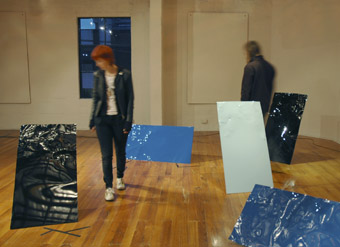
Space Shifter, David Chesworth, Sonia Leber, Conical Gallery
image courtesy the artists
Space Shifter, David Chesworth, Sonia Leber, Conical Gallery
AS YOU ASCEND THE NARROW STAIRS TO CONICAL GALLERY, YOU OVERHEAR A JUMBLE OF VOICES—SQUEALING, GROANING, CRYING, LAUGHING AND SINGING, SOMETIMES IN CHORAL HARMONY, SOMETIMES MIXED AND MORPHED, AND CONTINUOUSLY RISING AND FALLING. ONCE INSIDE, YOU ARE GREETED BY THE VISUAL ELEMENTS OF SPACE-SHIFTER—10 RECTANGULAR SHEETS OF METAL, EACH ABOUT 60 X 150 CM, PROPPED UP ON THE FLOOR AT AN ANGLE, EITHER SIDEWAYS OR LENGTHWAYS. FIVE PANELS ARE GLOSSY BLACK, THREE ARE A PALE OR MAYBE SKY BLUE, AND TWO ARE A DARKER BLUE. THE PAINT IS CAR DUCO, CLEAN AND SHINY, BUT EACH PANEL BEARS NUMEROUS DENTS AS IF IT HAS BEEN BATTERED FROM BEHIND WITH A SHARP, HEAVY INSTRUMENT, AND THE DUCO APPLIED AFTER THE BEATING TO SEAL IN THE MARKS.
In a corner of the gallery is an inverted metal bowl, about two metres across, tan or khaki in colour. Prior to painting, the bowl has also been dented and then roughly cut into 3 pieces to make it look cracked, like crockery or an eggshell or perhaps like a military helmet bearing fatal damage; and it is intriguingly bent at one edge to suggest it has been thrown vigorously into the corner of the room.
Space-Shifter thus presents a series of riddles for the viewer-listener. The sound comes primarily from four loudspeakers mounted high out of sight in the corners of the room, and the signal moves suddenly back and forth between the speakers, detached from any specific location. This dialogue is augmented by low rumbles that come from some of the metal panels, which turn out to have transducers attached, and even from the floor itself. Initially, you wonder if your presence is triggering the abrupt changes in the dynamics or direction of the sound (a strategy that is almost expected these days). But it turns out that you’re hearing a pre-recorded multi-channel tape loop of a choir (the Royal Melbourne Philharmonic Choir), and there is a large transducer attached to the floor that creates the subtle resonance you feel in your body. The work recreates the cacophony of the mind, recalling extreme emotional states. Ultimately, the sound is disembodied—shifting—so that, as you locate yourself in visual space you lose your bearings in aural space, creating feelings of uncertainty and even dread.
The metal forms initially seem disconnected from the sound. They occupy and disrupt the gallery space, drawing upon the idea of minimalist sculpture in the form of iconic shapes and colours. They suggest industrial fabrication bearing the signs of damage through misuse and abuse. The colours suggest fundamental substances such as oil, earth and air, or darkness and light, but represent a civilised world whose scars are painted over. And they are loudspeakers voiced as instruments, as is the gallery itself, to distort the sound. Overall, Space-Shifter functions as an audio-visual Rorschach inkblot in 3D. This is conceptual art that works in cycles of evaluative and experiential contemplation, testing the pull of our own subjectivity.
Visual artist Sonia Leber and composer David Chesworth have collaborated on numerous projects over many years, creating immersive environments, sometimes in public places, as in 5000 Calls (Sydney Olympic Park, 2000) and sometimes in the closed environment of the art gallery. They frequently use recordings of vocal sounds as an index of human activity and emotional reaction, sometimes recalling Hugo Ball’s Dadaist recitations at Cabaret Voltaire, and even the Tower of Babel. The Space-Shifter composition is best absorbed with eyes closed, even though this temporarily occludes the sculptural component of the work, as principal vocalists Jerzy Koslowski and Deborah Kayser contort their voices to create an intense aural drama. Ideally, you listen alone, but if other viewers are present, their whispering and shuffling merge into the soundscape.
In the program note for Space-Shifter, Leber and Chesworth suggest that the work is a psychogeography of voice and space. Psychogeography was a theme of interest to Guy Debord of the Situationniste Internationale movement of the 1950s, which critiqued urban life. Debord was especially concerned with the ways architecture locates and defines the individual in psycho-social space, a recurring theme in Leber and Chesworth’s art. Their notes also refer to our feelings of metaphysical anguish on hearing a disembodied voice, particularly a voice whose utterances make no sense. The human voice is the central element in this work, mimicking the tones of your own internal dialogue with all of its fears, desires, laughter and grief. The sound-track by itself is troubling enough, but the addition of the sculptural forms, signifying architecture that speaks, makes the work that much more harrowing.
Sonia Leber & David Chesworth, Space-Shifter, Conical Gallery, Melbourne, May23-June 13
RealTime issue #92 Aug-Sept 2009 pg. 50
© Chris Reid; for permission to reproduce apply to realtime@realtimearts.net
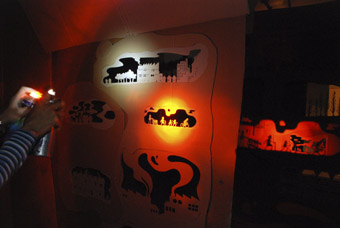
Ghost Train, Ned & Tom Sevil
photo Garth Knight
Ghost Train, Ned & Tom Sevil
“THERE GOES THE NEIGHBOURHOOD!”, TAUNTED THE US BLACK HEAVY METAL BAND BODY COUNT IN THEIR 1990 SONG, AN IRONIC TAKE ON THE PHENOMENON OF ‘WHITE FLIGHT’ IN AMERICAN CITIES AT THE TIME (THE SONG ALSO DRAWS AN ANALOGY BETWEEN THE PERCEIVED BLACK ‘ENCROACHMENT’ OF WHITE SUBURBS AND THE BAND’S ENCROACHMENT OF THE TRADITIONALLY WHITE DOMAIN OF HEAVY METAL).
The title thus frames this Performance Space exhibition squarely within the politics of contested space and the central role of race (and youth) in this contestation; it also widens the frame of reference beyond the here and now of Sydney, Australia, to shared histories and their legacy for contemporary urban living globally. This breadth of scope marked every aspect of the exhibition, from the range of artists and media, to the scale, both spatial and temporal, of many of the works. Participants hailed from across the globe, including Brazil, Spain, Denmark, US, Australia and Hungary; the range and scale of works was expansive: photographs, video, painting, installation, mapping, networked activities and performances, many either filling the gallery in innovative ways or overflowing it altogether through their presence in publication, on the web, or as external events extending over time. This scope was thoughtfully designed to reiterate the themes: spatial justice and the place of the artist in articulating and complicating these debates and strategies.
The curators (both members of an artists’ collective engaged in social and spatial mapping) did well to balance the push and pull inherent in capturing the complex and dispersed nature of the theme in a cogent and coherent exhibition. The gallery space itself is difficult, notorious for its cavernous dimensions that favour works of monumental scale, yet this very problematic appeared to be integrated and interrogated in the exhibition; the open and loose installation in the foyer of the CarriageWorks building echoed the grassroots/shopfront register of the theme, while also foregrounding the improvisational and small footprint approach taken by many artists practicing in this field. The publication of an accompanying book—which contextualizes the exhibition much more broadly than a conventional catalogue with historical essays on specific contested areas (including Redfern), interviews and theoretical discussions on both individual works and the wider issues around the impact of gentrification—is also an effective means of both containing and disseminating the themes. This is indeed an excellent anthology of benefit to a wide, interdisciplinary readership.
One of the most engaging works here was created by Australians Tom and Ned Sevil, aka The Evil Brothers, self-described as “divided by 5,000 kms of dirt and living on opposite ends of the country yet…connected through their checked [sic] history of making art on the street and their love of working in abandoned and forgotten spaces.” This ‘down home’ sensibility permeates their installation, Ghost Train, a simulated cityscape constructed out of cardboard. The viewer is invited to take a spray can that doubles as a lamp, and pick their way over tiny railway sleepers into what appears to be a dynamic shadow play of miniature city scenarios, although it is the viewer’s own movement (and imagination) that effectively animates these cut-outs. Through the simplest of technologies, and by also cleverly invoking the haptic, the work immersed the viewer in alternative perspectives of the city—a graffiti artist ‘writing’ the city’s underbelly at night, an urban planner constructing machines for living, a child playing ‘house’, a homeless person improvising a shelter. The work powerfully reminds the viewer of their own agency in creating and imagining urban spaces.
The construction/destruction of homeliness through the strategic occupation of space is also at the heart of the work by Chicago-based collective Temporary Services, whose interventions often take the form of public surveys designed to give voice to communities not fully consulted in the urban planning process. In Sydney, Temporary Services conducted a Public Sculpture Opinion Poll on Bower (2007-2008), the sculpture by Susan Milne and Greg Stonehouse installed on a prominent street corner in Redfern. Despite the creators’ participation in community workshops where local stories were gathered for integration into the work, the sculpture, described by one architect as “overscale and incongruous”, has polarized community opinion. Temporary Services, themselves without an agenda, in effect gave the complexity of the community’s response a compelling airing—with comments gathered on public clipboards and email installed in hard copy in the gallery or accessed on a dedicated website, the locals were heard in a far more public way, giving the viewer a fascinating insight into grassroots perceptions of the intersection between government, art and public space. One response read, “In my opinion this sculpture is inappropriate for the area. Those spikes and sharp edges suggest belligerence and seem to induce anxiety. Sharp edges, shooting projections, spikes are too aggressive for the area which has always been somewhat ‘on edge’” (May 15, 2009). The public debate facilitated by the artists’ intervention produced material worthy of serious consideration by policy-makers.

Shane Phillips & Noel Collett, 1992, from the series Conference Call, Brenda L Croft (in collaboration with Adrian Piper)
courtesy the artist
Shane Phillips & Noel Collett, 1992, from the series Conference Call, Brenda L Croft (in collaboration with Adrian Piper)
A strong self-reflexive impulse pervades much of the work in this exhibition, whose curators are also keenly aware of their own position in the politics of gentrification (including the argument that artists, through re-valorizing degraded spaces, often pave the way for the property speculation that accompanies ‘urban renewal’). This self-reflexiveness is particularly potent in the Spanish art collective Democracia’s video installation Images from the Welfare State (Smash the Ghetto) (2007) that features footage of the official razing of what was renowned as Europe’s largest shantytown, on the outskirts of Madrid. Democracia heightened the spectacular appeal of this event by projecting the images on three mural-sized screens and inviting the Sydney audience to sit on bleachers set up in the gallery, in the same manner as the original spectators watched the actual demolition. The work evokes the long history of the state smashing housing deemed unlivable under the auspices of regeneration—from the notorious implosion of Pruitt-Igoe to the massive pre-Olympic ‘clean-up’ of cities in the late 20th century, to the bulldozing of Palestinian settlements. But, perhaps more potently still, the work renders the viewer complicit in such destruction by foregrounding the visual pleasure we derive from watching such spectacle, with its intense drama and its promise of the ‘clean slate.’ As witnesses to the erasure of someone’s neighbourhood, we become aware of how the apparatus of spectatorship, while promising us complete immersion, instead distances us from this reality.
What renders these works so effective is their ability to transpose a complex set of ideas through a direct form of aesthetic engagement: the Holy Grail for art that seeks to be political. This exhibition was very successful in honouring the dispersed nature of artistic interventions in urban space, underlining the pressing nature of the politics of gentrification and reminding viewers of their own participation in these politics.
There goes the neighbourhood. Exhibition curators Zanny Begg and Keg de Souza, artists Daniel Boyd, Brenda L Croft, Lisa Kelly, SquatSpace, You are Here, 16beaver, Temporary Services, Michael Rakowitz, Claire Healy and Sean Cordeiro, Evil Brothers, Miklos Erhardt and Little Warsaw, Jakob Jakobsen, Democracia, BijaRi, and a re-enactment of Allan Kaprow’s Push and Pull: A furniture comedy for Hans Hofmann; Performance Space, CarriageWorks, Sydney May 23-June 17
RealTime issue #92 Aug-Sept 2009 pg. 52
© Jacqueline Millner; for permission to reproduce apply to realtime@realtimearts.net

Kissing Project (video still), 2009, Julie Traitis, Intimate Acts
photo courtesy the artist
Kissing Project (video still), 2009, Julie Traitis, Intimate Acts
THE SUBJECT OF INTERPERSONAL INTIMACY WOULD AT FIRST APPEAR TO BE A DIFFICULT ONE FOR CONTEMPORARY ART, SINCE GALLERY SPACES ARE SO TREMENDOUSLY CONTROLLED IN THEIR MECHANISMS OF PRESENTATION. LITTLE IS LEFT TO CHANCE, AS ARTISTS AND CURATORS CAREFULLY MANUFACTURE A RELATIONSHIP BETWEEN VISITORS AND ARTWORKS. IN PICA’S SHOW INTIMATE ACTS, THE BEST WORKS EXPERIMENT WITH THE LIMITS OF THIS CONTROL, AS THEIR PERFORMERS PLACE THEMSELVES IN AWKWARD SITUATIONS.
Thus in Smith/Stewart’s Mouth to Mouth (1995), Stewart is submerged in a bath, and is only able to breathe because Smith leans forward to exhale her own air into his mouth, between his bubbling outward breaths. It is this meeting of mouths that keeps Smith alive. In Patty Chang’s In Love (2001), two screens show the artist kissing her mother and father, their open mouths sharing an onion between them. Their faces turn from tears to disgust to something else, some undefined experience known only to the kissers. These works greet us as we walk into the show, and set an edgy standard. They evidence great control on the part of the performers, as they bring themselves into close contact with life-giving forces.
Such intensity is also at work within Futoshi Miyagi’s photographs of his meetings with internet dates, the Strangers series (2006). The photographs are taken in his date’s apartment or house, and show him in proximity to the stranger he has just met. In some images they are touching, in others he stares out the window or at the wall as if adopting the gaze of the stranger. These images are not, however, the kind of verite documentation that we might expect of a liberal lifestyle. The shots are instead tremendously composed, as the strangers assume postures for the camera. There is a sense of danger about Miyagi’s project that is ultimately controlled by intense performativity. Strangers and artist alike perform themselves, staging their own situation. It was Jean-Paul Sartre in Being and Nothingness who most succinctly described the self-consciousness of performing the self. Sitting in a park, he became conscious not only of being looked at, but of seeing the stranger who was seeing him. For Sartre personhood is founded on this interchange of gazes, in which the self is created in a performance that looks upon the other that is looking at oneself. There is a strange empowerment in this interval, a consciousness of self-consciousness that Sartre called freedom. In Miyagi’s photographs this freedom is visible in the postures that these strangers assume, postures that perform the freedom to be photographed by a stranger.
The other works in the show are less edgy and more conceptual, playing out various ideas in photography and the moving image. Smith/Stewart are represented once more by Intercourse (1993), a magnificent large scale video work. Spit passes between two massive screens, from one mouth into another. The scale of these mouths turn them into frightening, pulsing masses of flesh resembling giant insect predators, moving quickly to spit and swallow. By contrast Elise/Jurgen’s Convergence of our Perceivable Distance (2009) is a slow, deliberate piece. Jurgen’s shadow tries to keep pace with Elise’s video projection, as her body moves across a screen. In moments he catches up, obscuring her projection, leaving only darkness before she reappears. This is a subtly ironic work, as Jurgen’s success in merging himself with Elise would mean only darkness for the viewer. Instead, we watch Elise’s outline, her barest form in light.
Kelli Connell’s Double Life series (2002-2008) is manipulated so that the artist appears to be in a relationship with herself, in naturalistic images that simulate commercial photography. These are the classical poses of advertising, glossy magazines and websites. In one she is getting out of bed where her doubled body lies sleeping. In another she smiles at her double who languishes naked in the bath. Others are more romantic than erotic, as Connell stands forehead to forehead in front of the setting sun, or sits with herself in the alcove of a scenic window. In simulating such photographic cliches, Connell’s images recall the uncanny depersonalization of Cindy Sherman’s early work that reproduced the image world of Hollywood cinema. Connell is instead working in a digital era, in which images are created rather than reproduced, composed rather than posed. While Sherman’s work could just as well have been from an actual film, Connell’s doubling is self-contained, as if we are looking at a mirror that only looks back at itself. If Sherman’s photographs addressed the viewer’s gaze with its constructions of cinematic women, Connell’s doubles no longer need us, as they look only upon themselves or to a simulated world that is brighter than our own. Connell’s work is the product of a digital era in which reproductive technologies no longer require a machine operator, but are largely automated so that images circulate by themselves.
To make sense of the performance of self in a digital era we can turn to the performances of Julie Traitsis’ Kissing Project (2009), a record of a series of virtual kisses. Participants are asked to perform kissing for the camera as if with an invisible person. The camera faces the kissers directly, for long minutes, making the situation uncomfortable for viewers who must witness their intimacy directly. Sartre also anticipated this piece when he suggested that we only ever perform for ourselves, and indeed these performances tell us all too much about the participants. Various styles, techniques and approaches to kissing represent not so much the difficulty of performing oneself but its solitary satisfaction, as the closed eyes of the kissers allow them to escape into some fantasy or other. Flickering eyelids and tongues enact a consciousness of the self to the self. The Kissing Project casts a voyeuristic light on the rest of the show, as its performances of intimacy are unrehearsed, its performers vulnerable to our judgements.
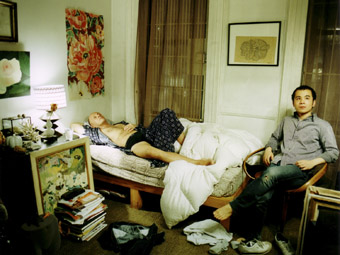
Strangers, 2006, Futoshi Miyagi; Intimate Acts
photo courtesy the artist
Strangers, 2006, Futoshi Miyagi; Intimate Acts
It is the sign of a successful exhibition when, like a good CD or LP, works try out different things but also cohere to some abiding style or concern. Curator Melissa Keys succeeds in playing out variations on her theme, such as doubling and kissing, keeping the viewer interested in the whole. Featured contemporary artists from around the English speaking world include the US (Chang, Miyagi), UK (Smith/Stewart), Australia (Traitsis, and from Perth, Elise/Jurgen). These are all young artists, infused with a generational optimism that was sadly missing in the Australian Centre for Contemporary Art’s 2008 show of the same name. While the works at ACCA spoke of impossibility and loneliness, the vibrancy of the PICA pieces turn impossible acts, such as kissing your parents, breathing another’s air, or doubling yourself, into performances that speak of care and love.
Intimate Acts, curator Melissa Keys, Perth Institute of Contemporary Art, June 18-Aug 2
RealTime issue #92 Aug-Sept 2009 pg. 54
© Darren Jorgensen; for permission to reproduce apply to realtime@realtimearts.net
version 1.0: this kind of ruckus
At an Induce workshop at the On Edge Festival in Cairns in July, David Williams of the performance group version 1.0 was adamant that the company does not make verbatim theatre. Rather, he says, it immerses itself in the epic official documents and media material pertaining to political crises (‘children overboard’, ‘wheat for weapons’) which it then distils, quotes from and transforms into surprising, often quite lateral, sometimes satirical images that encourage us to look twice at the contradictions and corruption too easily veiled by spin and the welter of the everyday.
After the extensive regional tour of their ‘wheat for weapons’ show, Deeply offensive and utterly untrue, the company has plunged into the creation of a new work “about gender, power, control and violence”, titled This kind of ruckus. The show investigates “the underside of domestic bliss…with commentary on the recent high profile sexual assault scandals involving Rugby League players.” The show will “reflect on violence within ourselves and our own relationships.” Williams says it’s not about Rugby League: players, officials, politicians, will not be named—a first for a version 1.0 show. The aim is “to open up a fissure in the culture with the possibility for public discussion, and then ask ‘How should we behave?’ The world permeates version 1.0 performances”, Williams adds.
The recent string of sports-related sexual assaults, inconsistent policing of domestic violence and “the horrible logic of public opinion” that believes a woman entering a pub for a drink has herself to blame if she’s raped, suggest for version 1.0 the many grey areas that remain in gender relations in public but also in private life. The company have researched couple therapy and looked at their own behaviour through improvisation, including for Williams, assessing his own relationship with female performers, how he moves, gestures and “when it’s not about me.” The collaborating artists are Danielle Antaki, Sean Bacon, Kim Vercoe, Paul Dwyer, Jane Phegan, Deborah Pollard, Gail Priest, Arky Michael, Christopher Ryan, Yana Taylor, David Williams, Neil Simpson. version 1.0, This kind of ruckus, Sept 4-12, Performance Space at CarriageWorks, Sydney, www.versiononepointzero.com; www.performancespace.com.au
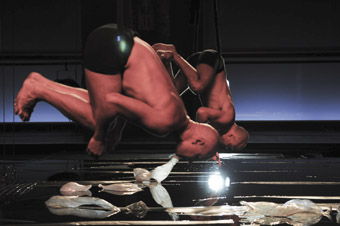
Dean Walsh, David Clarkson, MirrorMirror, Stalker, Parramatta Riverside Theatres
photo Heidrun Löhr
Dean Walsh, David Clarkson, MirrorMirror, Stalker, Parramatta Riverside Theatres
stalker: mirrormirror
Physical theatre company Stalker’s MIRRORMIRROR brings together artistic director David Clarkson and dancer-choreographer Dean Walsh with “their ghostly puppet counterparts” enacting life “from beginning to end—from the ground to the air—evok(ing) images of the spirits of our ancestors…” The pair share Irish Celtic and working class backgrounds. This exploration of “personal endings” is the third work in a Clarkson triptych: the first was Four Riders, drawing on the Book of Revelations; the second was Red, about scientific visions of the end of the world. Collaborators include set designer Joey Ruigrok, lighting designer Sydney Bouhaniche, puppet fabricator/sculptor Kassandra Boswell, composer Peter Kennard; Riverside Theatres, Parramatta, Oct 2-10; riversideparramatta.com.au.
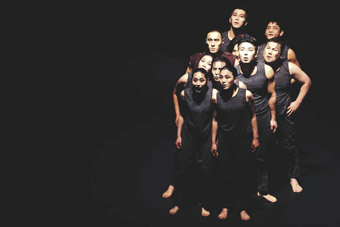
Woyzeck, Sadari Movement Laboratory, OzAsia Festival
photo Eun Sun
Woyzeck, Sadari Movement Laboratory, OzAsia Festival
2009 ozasia festival
The first announced events of the 2009 OzAsia Festival program are complementary, cross-cultural collaborations of a high order. Akram Khan will present bahok, originally a collaboration with the National Ballet of China, now performed by eight dancers—Chinese, Slovakian, Korean, Indian, South African and Spanish—with music by Nitin Sawhney. Into the Fire is a musical concert with dance: Paul Grabowsky and the Australian Art Orchestra will collaborate with South Indian Mridangam player Guru Kaaraikkudi Mani, members of the Sruthi Laya percussion ensemble and Bharatanatyam dancer Rajeskwari Sainat. Earlier versions of Into the Fire in concert and on CD have displayed a rivetting synthesis of traditional Indian music and adventurous western jazz with each maintaining their integrity. Khan’s bahok “aims to create a modern day utopian community. The performers meet in one of this globalised world’s transit zones and try to communicate, to share ‘the things they dream with’—their experiences, their memories of their original homes, the dreams and aspirations that made them move. They are carriers. They are bahok.”
Providing a welcome contemporary performance perspective are Melbourne-based dancer Yumi Umiumare in her new solo work, En Trance, and, from Korea, the only Australian season of the Sadari Movement Laboratory’s physical theatre interpretation of Buchner’s Woyzeck, performed with a set of dextrously deployed chairs—swung, danced, piled high—to the music of Astor Piazolla. OzAsia continues to be a rarity in Australia—a celebration of our relationship with our nearest neighbours and a sad reminder of the paucity of Asian programming in our major arts festivals. OzAsia Festival, Adelaide Festival Centre, Oct 3-17, www.adelaidefestivalcentre.com.au/ozasia
seam 2009: spatial phrases
The inaugural SEAM conference and workshops bring together architecture, film and dance to explore “ideas of movement across bodies and space.” Hosted by Critical Path and the University of Technology Sydney’s Centre for Contemporary Design Practice, the program includes a three-day Symposium with international speakers including architectural and cultural theorists Erin Manning, Brian Massumi, Andrew Benjamin and Pia Ednie-Brown. Commissioned installation projects and performances from local artists will be showcased and interdisciplinary workshops held at Critical Path. International artist talks will include choreographer UK-based Carol Brown, Marten Spangberg from Germany, UTS Design Head of School, Professor Lawrence Wallen and Dr Benedict Anderson, Course Director of Spatial Design at the University of Hertfordshire.
Works include Brisbane-based Jondi Keane and James Cunningham’s performance installation Tuning Fork (RT89, p32) and Sue Healey’s installation The Door, The Chair, The Bed and the Stair with architect Mark Healey, digital artist Adam Synnott and performer Nalina Wait. With four large screens, “the images [will] play with our perception of space, amplifying an emotional and physical response to specific architectural framing.” A video animation, Falling, by Nikki Heywood and Heidrun Lohr [see p20], comprises some 3.400 photographs and is based on the?experience of Heywood’s mother, who had several falls in her apartment. The artists write that “this gives us the possibility to explore, from a different and curious angle, the passing of time and the dynamics of a body literally collapsing inside and against an architectural space.” Richard James Allen and Karen Pearlman’s presentation, “Entanglement Theory”, will hypothesize “that a mash-up of Vedic spiritual philosophical ideas of multiple states of consciousness, multiple forms of body and multi-dimensional realities and the elemental beings that inhabit them, along with science fiction-like theories of quantum particle entanglement” can be explored through a mix of RealLife and Second Life. Critical Path director Margie Medlin’s Miss World installation (2002) also mixes the real and the virtual to “create new choreographies” using “the dancer’s movements to draw attention to the body in the changing face of cities and the culture of urban planning.” SEAM09: spatial phrases; Sydney, various venues, Sept 7-20, www.criticalpath.org.au/SEAM.html
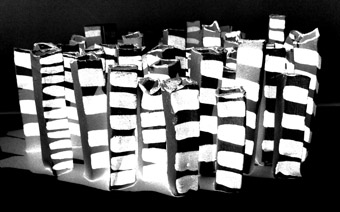
Triptych Primordial Landscape, painting by Jenny Mullet, Tandeera
courtesy the artist
Triptych Primordial Landscape, painting by Jenny Mullet, Tandeera
tandeera: indigenous projects
Three Gunnai/Kurnai artists from eastern Victoria have been working with leading Australian projection artist Ian de Gruchy to create the first indoor Koorie art projection exhibition, Tandeera (“place of rest”), in Melbourne. In a press release, de Gruchy explains that the installation “required the use of pre-digital technologies using orthographic film and programmed slide projectors to translate the artists’ work onto the black painted walls of the gallery.” The works meditate on “the themes of resting and healing post-apology…to soothe the soul.” Koorie Heritage Trust, 295 King St Melbourne to Aug 21.
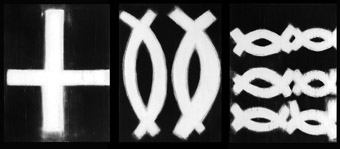
Landscape of Birds by Jenny Mullet from ceramic installation, Tandeera
courtesy the artist
Landscape of Birds by Jenny Mullet from ceramic installation, Tandeera
billy twinkle—requiem for a golden boy
Virtuosic Canadian puppeteer Ronnie Burkett returns to Australia, playing Melbourne’s Arts Centre (Aug 25-29), Geelong Performing Arts Centre (Sept 3-20) and Sydney Opera House (Oct 1-17). Meg Walker saw Burkett’s new show in Vancouver and wrote, “Compared with (his) last two works the tender and restrained Ten Days on Earth and the brutal, brooding Provenance the puppeteer and writer’s latest work is full of bustle and glitz. The plot demands it: Billy is a cruise ship entertainer who has just been fired for insulting passengers during his cabaret act puppet shows. Vain, middle-aged and full of self-loathing, the man in the dinner jacket needs a reason to carry on” (RT90, p5).
look out for…
For films with a difference, try the Melbourne Underground Film Festival (MUFF), August 22-30 or the Sydney Underground Film Festival, Sept 10-13. Sydney performance trio, post, will mount their wickedly funny and bizarrely intelligent new show, Shamelessly Glitzy Work, at Melbourne’s Arts House, August 13-15. Also at the Meat Market is live art duo Panther’s Playground, a New World Order where the audience get to be kids again if in some dark scenarios. Aptly for our self-conscious times, Adelaide’s Brink Theatre premieres The Hypochondriac (adapted from Moliere’s Le Malade imaginaire) August 5-22 at the Space Theatre. Under the banner Come Hither Noise, Fremantle Arts Centre is exhibiting works by artists from around Australia: Mark Brown, John Conomos, Richard Crow, Ross Manning,Thomas Meadowcraft, Elvis Richardson, Sam Smith and Sriwhana Spong; August 1-September 20.
RealTime issue #92 Aug-Sept 2009 pg. 55
© RealTime ; for permission to reproduce apply to realtime@realtimearts.net
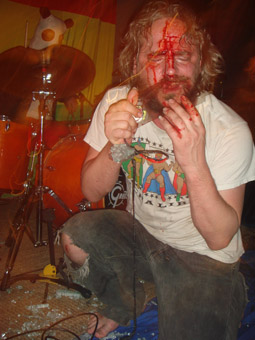
Lucas Abela, Yang Yang (in panda suit)
courtesy the artists
Lucas Abela, Yang Yang (in panda suit)
Lucas Abela, famed for his aural onslaughts on a miked and effected pane of glass, toured China at the end of 2008 teaming up with local musicians Yang Yang and Li Zenghui to form Rice屎Corpse. He also produced Mrs Rice a CD documenting this intriguing collaboration (see earbash review). Following is an edited interview with Abela about his experiences in China, how he developed his unique show, and life on the noise touring circuit.
Why China?
China. I guess was advantageous. I knew about Asialink, I didn’t think I’d get [a grant], but I figured I’d have a go. It was a toss-up between China and Japan.
I thought Japan would be good for you.
I’ve been to Japan 12 times as opposed to China three times, and have lots of good connections in Japan. Japan is not as expensive as it was…but when you’ve got 12 grand to spend and you want to get a lot out of that money China is a better go. And I was more interested in China as a place. Japan is sort of weird, but China is weirder—politically, socio-economically, ethnically. All sorts of strange things are going on there. So I picked China, and got Yan Jun from SubJam to host me.
The thing that I like about self-initiated residencies is that it shows I have initiative and drive, but also if I initiate one I’m the only person in competition…So I thought what’s a good reason to be in China? I have to work with the locals in some way, so I devised the idea of a band. It’s a band I’ve wanted to do for a while, but I’ve never got around to doing it. I’m trying to re-form it at the moment and we haven’t even got to rehearsals yet because when I’m here I’m just so cluttered and all over the place. But when I was in China I was doing nothing but the band.
And that’s the real beauty of residencies, you have to get away even to do something you could do in your own lounge room, so that no one bothers you.
It was easier to go Beijing, find these complete strangers and start a band. There was a beauty to that I thought, finding these complete and utter strangers. They were even strangers to each other. They knew each other from the scene but Li Zenghui is a saxophonist in the kind of Chinese NOW now world, while Yang Yang, the drummer, was more of a punk-ish drummer in the Boredoms tradition. The scenes cross like they do here, but they weren’t solid friends hanging out every day.
Jun [from Sub Jam] recommended Yang Yang to start with, but he said, “There’s no pianists. I can’t think of a single pianist in town that can do this job. Why do you want a pianist?” I had this thing in my head—pianist and drummer. When I first got there I went to this gig [at DosKolegas] which is a series of events Jun runs in Beijing. Li was playing saxophone there. I got to talking to another Yang, who runs Sugar Jar, the record store in the arts district, and he asked me if I was interested in doing an in-store gig. I found that there was piano in this shop. I said. “It would be great if someone played piano with me. Do you know any pianists?” And he told me that Li, before he took up the saxophone, used to play keyboards in bands as a teenager. And so I said I’ll take him.
Did you have a try with him playing the saxophone?
No, I hate the saxophone!
The timbre of your instrument and saxophone are kind of similar.
A sax would compete with me somewhat, and I also wanted rhythmic instruments. I wanted a piano played rhythmically which is how I instructed them. We sat down and they looked at me and I said you [stabbing gestures], you [drumming flailing gestures]. That’s how our communication was, besides a little calculator thing where I’d write in words like “staccato” or something like that and try to get some ideas across as to how I wanted the rhythms to flow. And then off they went.
I wanted to play glass lead and let them structure rhythm into my music that’s never been there before. Always when I play, I have this imaginary rhythm section in my head. I think I aurally hallucinate because I’m hearing all sorts of things. In this instance I got this band, and they’re outwardly influencing me as well and I’m hearing them and I’m following a rhythm or following a change of theirs. It added new elements to my playing. And I think it really shows on the album because it’s completely different to anything I’ve done before.
It’s amazingly cohesive. So in terms of making that material, are the pieces set now?
No, all the tracks are completely improvised. I had a three-month residency. I spent the first month touring towards China, then I had one month in Beijing and one month touring with the band. The first couple of weeks I was trying to get the band together and when we finally got together we only really did four rehearsals and, out of those, two were recorded and edited down to the album. Each rehearsal was about 70 minutes. The album became about 50 minutes. There are a couple of other tracks that I wanted to put on the album. I mixed and finished them but Yan Jun from SubJam, the co-label for the project, said “The album’s too long, you should make it tighter, it’ll have more impact.” I don’t usually think that way, but he was completely right and taking those tracks out made a much more cohesive record. Then we did a 10-city tour.
And the tour was all improvised?
The tour was all improvised.
Do you think that maybe the language barrier sutured the music more? Because the other avenues of communication were cut off, the playing was more intense?
I think we communicated better playing together than any conversation we had. Their English was very small, my Mandarin is dismal, so most conversation was “food, eat.” I’d just follow them around and we’d go to bizarre restaurants, and they’d just chat amongst themselves. I was more the isolated one.
So there’s a regular touring circuit in China?
The circuit is growing. There are lots of live houses but less for the kind of stuff we’re doing. There are so many cities there that you probably wouldn’t even look at on a map and are bigger than Sydney. If you splintered off even 1% of the population, there’s still a decent touring circuit for the bands in China. Especially for the punk bands.
So is Beijing the new Berlin, because of the underground scene.
There’s talk about that. There’s a whole scene wrapped around a place called D22, in the arts district in Beijing, which has been opened up by New Yorkers, in the university district. This is the venue famed for unlocking bands like Car Sick Cars and P.K.1.4. Sean Tenzenmen is licensing their work in Australia, and they’re doing good business. I guess they’d be considered the new Chinese underground. It was getting more focussed leading up to the Olympics with people looking for side stories and picking up on the underground Chinese rock scenes.
They were talking about it as the new Berlin or a hub, but I wouldn’t describe it that way. I think they do it a lot harder in Beijing than in Europe. There are Europeans who are famously well paid and make a living out of their music. [As for] my band members, Yang Yang has left the country once and gone to Nepal. Li has never left the country. Li got evicted during our tour and had nowhere to go at the end of the tour. They’ve got no money and music is definitely not their prospect. It could become a Berlin type scenario for foreigners. Foreigners could easily move in and live off nothing, but they probably won’t make money as musicians. Though there’s still probably more happening on a nightly basis than in Sydney, which is saying something.
So how did it open up your practice?
Doing the band really opened my ears to a different way of playing that I wasn’t getting in my solo shows. I definitely want to move forward with the idea of playing with bands, so I want to recreate that here. I found out about this thing called SoundClash which is an Australia Council initiative to put experimental musicians and popular musicians together. So I’ve got Stu Olsen [Rand & Holland, Garbage & The Flowers] and Peter Kostic [Regurgitator] on board. Peter is a fantastic drummer. I did a short tour with Regurgitator in 2005. I was doing the glass solo shows at the time. They were doing the Band in the Bubble where they were recording an album in Federation Square. And I was their weird segue.
So how long have you been playing the glass?
Since 2003. But in essence it’s an extension of what I was doing before—playing metal objects in my mouth. This stemmed from when I toured Japan in 1997. I had two motorised turntables and I couldn’t take the motors with me, so I bought motors over there. But because they were a lot weaker they stopped working. To make sound, and out of nervousness, I started putting things in my mouth. I’ve been working these mouth techniques ever since. I see it as a new instrument. I press it against my lips and hum and vibrate the sheet. I can’t think of another musical instrument that works in that way. It’s not wind, I’m not blowing through it; it’s not percussion, I’m not hitting it; it’s not strummed. I’m like vvvvhhhhh—just vibrating the sheet. I think it’s got lots of potential as a musical instrument in its own right. One of the reasons I wanted to move into a band context was to show off its musicality, which no one really sees when I play it because I’ve got very discordant tastes.
I’ve got this problem of no one taking me seriously because I smash the glass on my head and I bleed and I add showmanship. I think if you’re going to do a show you should do a show. You should make it fun, make it interesting. I’m interested in the element of danger. It brings to the audience this anxiety that no other musician I know of can induce. To harness that kind of emotional ride for the audience is very interesting to me. My entire history of music has [incorporated danger into] my instruments. Spinning motors that cut through my wrists to bouncing on trampolines, to having amplified sword fights. I think it’s appealing to my audience as well. The way they react to my shows—I’ve had a people in hysterics, crying. I’ve had six-foot men faint in Scotland. It’s a big note, but I’ve had so many people tell me it’s the best thing they’ve seen in their lives.
You always play quite short sets.
Yeah, I don’t like to bore. I don’t ever want the audience to think like I do when I see a show, “Ah yeah, I get it.” I want to finish before that starts.
So playing with a group spreads out the intensity of the ride for the audience?
It gave me room to breath.
Literally.
Yeah, literally. All of a sudden I didn’t have to fill up the whole aural spectrum myself, I could sit back and interject with the instrument… there would be ebbs and tides in what I was bringing in and taking out instead of trying to just fill up the whole room with noise and running out of breath.
Did you smash the glass when you played with the band in China?
I wasn’t going to, but I did. Force of habit. Part of me wanted to say this is a band, this is me doing something different musically and I don’t have to smash sheets of glass over my head to get a round of applause. But I still want to smash it. There’s something I really enjoy about it. It’s the rush at the end of the show. It’s not just for the shock of it; it just seems the right way to finish a show. It’s the heightened point when I’m feeling good and I get a rush and bang… and there’s the trickle of blood across the face [he giggles] I love that.
It’s interesting how this crosses you over into the live art arena.
I did a performance art festival in Korea. I was going through Korea anyway and I was already booked at a noise fest and someone said that there was a performance art festival that was interested. It was at the same venue. So they booked me for two shows over two weekends, and I spent a week in Korea. I did the noise festival then the performance art festival
And how were they different?
I guess the audience was smaller for the performance art festival which I was surprised by. I don’t know how developed that scene is in South Korea. I think there’s a lot of performance art throughout Asia. I’m getting booked in Jogjakarta at a performance club run by [Australian artist Timothy O’Donoghue]. He’s running a performance art venue there, so there’ll be that context.
Most of my engagements are within the noise music ghetto, as I like to call it. I think of what I do as noise music, but I like to think of it as more than just a guy with a bunch of pedals on tables doing noise music. My basic circuit is that and above that I get festivals which are crossed with all sorts of acts. I’m getting known outside of the noise music world now. Once you get into that loop it’s really great. The good thing about Europe is that cultural centres are funded to the teeth, and within them are people programming music. There was a festival in Valencia, Spain. There were two different stages. John Cale was on one stage and I was on another in another part of the city. John Cale’s stage is obviously packed, I’m playing in a cockfighting ring with six people in the audience, but I get paid 600 Euro, and those people didn’t pay 100 Euro each to get in.
Do you think that once you become better known genre becomes less important? When you think about major music festivals they are about people playing different genres, but the artists are all of a particular standing.
Well I’ve gone on before Patrick Wolf—a teenage pop star—at the Donau festival [in Germany]. That festival really mixes things up. It had the Boredoms, Throbbing Gristle. The night I played was The Vivian Girls, Deerhoof, Patrick Wolf and myself. To be on a line-up like that, with a bunch of teenage girls and an independent pretty boy, was quite strange. There are a lot of things like that.
And how does the audience respond to that kind of diversity—a European audience?
I think they love diversity. It’s quite easy to bring people into my show even if they are not au fait perhaps with noise music. The performance element can hook them in and more often than not I can make any crowd clap. Whether it’s polite applause or not is hard to tell but it usually seems enthusiastic to me. It depends on the crowd. Some people would just clap anything!
Rice屎Corpse, tour November 2008; Mrs Rice CD, Dual Plover/Kwanyin-Subjam 029, 2009
See also That was shit! on the making of Mrs Rice including responses from Yang Yang and Li Zenghui
RealTime issue #92 Aug-Sept 2009 pg. web
© Gail Priest; for permission to reproduce apply to realtime@realtimearts.net
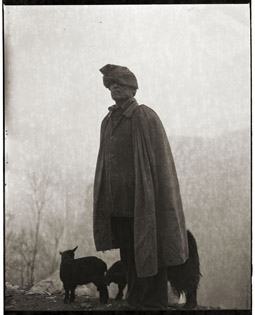
Man with Sheep, 2006, Adou
photo courtesy the artist
Man with Sheep, 2006, Adou
RONG RONG HAS BEEN A KEY FIGURE IN THE DEVELOPMENT OF CONTEMPORARY CHINESE PHOTOGRAPHY SINCE HIS PIONEERING WORK IN BEIJING’S ‘EAST VILLAGE’ IN THE EARLY 1990S.
Since meeting his Japanese wife Inri at the turn of the decade, the pair have collaborated on a string of intensely autobiographical photographic series documenting their lives together and the changing nature of their surrounds. In June 2007 they opened the Three Shadows Photography Art Centre in Caochangdi, on the north-eastern outskirts of Beijing. As well as holding a darkroom, digital studio and library, the centre has hosted artists’ residencies and staged a series of innovative group and solo exhibitions highlighting current trends and talent in China’s emerging photographic art scene.
Dan Edwards spoke to Rong Rong about the centre and the inaugural Three Shadows Photography Award. Dan’s article about Three Shadows can be accessed here.
When did you and Inri first conceive of the Three Shadows Photography Art Centre?
In 2005. Initially it was just a dream for Inri and me. In 2001 I visited many artistic communities across Europe and saw a lot of spaces dedicated to photography. As a photographer I felt they were so lucky to have such places, where you could see work, exchange ideas and find a lot of research material. China is such a big country, but it didn’t have these things—in this respect China was a blank. I didn’t go to a real college to study photography, but experienced a long self-taught process. China doesn’t have a photographic museum or archive, so at least we wanted to establish a library for everyone to use as a basis of communication. Slowly the idea of the centre became bigger and bigger.
Why did you choose this site rather than 798 [Beijing’s most famous art zone, in Dashanzi]?
In 2005 I started looking for a place and in 2006 we started to plan. We went to 798 but finally we chose this site because it is very quiet. Also my company is located near here. Originally this site held a very old building. At first we wanted to renovate the old structure but later we decided to demolish it, and talk to a designer about building a library, café and so on.
Although Three Shadows is an exhibition space, we also have other functions. For example we hold forums and artist residencies. If the artists lived at 798 it might be too noisy. These factors indicated we needed a quiet neighbourhood. So I had a very clear aim, and looked for a site based on that. 798 is currently undergoing very rapid development, and I can see the speed and direction it’s headed in—it’s like a big supermarket. They want to have everything there. So I didn’t think the environment suited our independent gallery.
What were your aims in creating the centre?
The most important question for me was, where is China’s photographic history? On the surface in recent years China seems to have an abundance of photographic history, but in fact it doesn’t have its own foundation or system—there are no photographic museums, archives or collections. The country lacks these things so we wanted to start and slowly build them up, because Inri and I met through photography. In 1999 I had an exhibition in Tokyo, and she came to see it. We wanted to set up a platform to introduce photography to a broader audience and show the beauty and joy of the form. We now have a small permanent collection that is slowly growing.
Do you act as an agent for other artists as well?
Yes, we have some of the functions of a commercial gallery, but we also have many functions a commercial gallery doesn’t have, such as providing residencies, hosting forums, publishing and providing library and darkrooms facilities. We don’t have any financial support from the government—we depend on ourselves. Every penny for running the centre comes from selling our work. Inri and I put all our money back into the centre. We hope the money can eventually go into a public foundation so Three Shadows can become a fully independent institution.
Can anyone apply for Three Shadows residencies, or are they for Chinese photographers?
They are mainly for international artists, as it’s easier for most local artists to come here—although if you are from somewhere far away like Sichuan or Tibet you can also get a residency. We mainly want to provide a bridge for communication between Chinese and international artists. We have already had six or seven foreign artists come through here: American, Spanish, Finnish. When they come here they can produce work and use the library and darkroom. But the most important thing is to communicate with local artists.
When did you and Inri come up with the idea of the annual Three Shadows Photography Award? Was it part of the original idea of the Centre?
Yes, because finding emerging artists with potential is very important. My own experience tells me that in a certain period of your career being encouraged or complimented by others, and having the chance to communicate with other artists, is very important. Of course China has other kinds of photographic awards—official government or commercial awards given by companies. But I think the Three Shadows award is completely different. We have our own conception of the development and language of contemporary Chinese photography.
The press release says you received nearly 300 submissions. Were you surprised by the size of the response?
Not very surprised, because China has such a large population. At the same time, this was the first time we had run the award, so 300 entrants was pretty good. It was hard to narrow the entrants down, but the finalists we selected already know their direction. My original idea was to select eight to ten finalists, but when we saw how many good works there were, we eventually settled on 31. Then we had the exhibition and the international judges arrived to give the award on the basis of the finalists.
Was there a lot of new talent you hadn’t seen before?
I hadn’t seen much of the work before—most of the artists were very new and very young.
The award is open to any Chinese citizen or anyone of Chinese descent, so were there many submissions from outside the mainland?
This year there were not many non-mainland people. Among the finalists there were four—one each from Hong Kong, Taiwan, New York and Germany.
Based on the award submissions and your work here at the centre, do you see any particular trends in Chinese photography at the moment?
Digital techniques are being very widely used. Hand processing is becoming very rare and is slowly disappearing, which I think is a pity. Of course I don’t reject the new techniques, but I think hand processing is very important. Many young people have already abandoned these techniques.
What about at the level of subject matter?
One thing I noticed is that everyone wanted to express their private selves. Unlike older photographic trends that were focussed on society or big topics, younger artists are focussed on their inner world.
When did you first encounter the work of the winning photographer Adou?
In 2008 we started thinking about an award for young artists. The Three Shadows curator Zhang Li went to various places to scout for new talent. He went to many places like Guangzhou and Lianzhou and collected a lot of material. Adou wasn’t part of any formal art festival or exhibition—he had just printed his work and was selling it on the roadside. Our staff saw it and brought it back. He was a designer for ten years, then he quit and became a photographer. When I saw his pictures I found them very attractive—I feel Adou’s photography has the weight of time and history in it. So we found him and said we wanted to hold an exhibition of his work. Originally he just printed his work using a computer, but when I talked to him he agreed to use traditional hand processing techniques to reproduce his pictures. It really suits his work.
So was the Outward Expressions exhibition [at Three Shadows in March-April 2008] the first time Adou had exhibited in a gallery?
The first time. Also the first time he had hand processed his photographs.
In terms of Chinese contemporary art, the focus of the international market in recent years has very much been on painting. Do you think this a reflection of what has been happening at the level of practice in China?
Yes, this is a big problem. Chinese photography is 30 or 40 years, or even more, behind Chinese painting. Photography became an independent artform very late in China. Maybe this has something to do with the Chinese system, because photography has always served the government—photographic themes have always been focussed on the government. In recent years it’s become a bit better, but previous work had no artistic value.
Do you think this is changing? Is Chinese photography developing its own traditions?
On the surface it seems so, but in fact I think it’s not enough, because China doesn’t have good photographic institutions, critics or publications that give people the chance to see original works. There is also a lack of communication—the world’s top photographers don’t have much opportunity to come to China.
Is photography taught in Chinese art schools as an artform?
There are a few courses but not many. I think it’s really important to have an independent college of photography, but China doesn’t have one at present. All the courses are taught by departments within broader art colleges. For example, the Chinese Academy of Fine Arts [in Beijing] has a course in photographic history and the students sometimes have classes in the Three Shadows library. Also Qinghua University [one of China’s top universities situated in Beijing] has had classes here. Something really funny—when the students visited the darkroom, they had never seen an enlarger before. Even more amazing, they had never seen 35mm film before. Most of the students were young girls in their 20s, and they used their digital cameras to take pictures of the 35mm film. I thought it was really funny.
Did you feel the award entrants were very aware of the history and traditions of photography in and outside China? For example were they aware of your work in the East Village back in the early-1990s?
I think they know something, but it comes from the web. They lack contact with original works and other artists, which I think is very important. Looking at prints and original work is very different. Also a working environment where they can communicate with foreign artists is really lacking. Of course they can find a lot of information online, but they lack real experience. Three Shadows can provide this. Society is based more and more on the virtual, but I feel real experience is still very important.
Thanks to Wang Yi for her help translating the interview.
RealTime issue #92 Aug-Sept 2009 pg. web
© Dan Edwards; for permission to reproduce apply to realtime@realtimearts.net
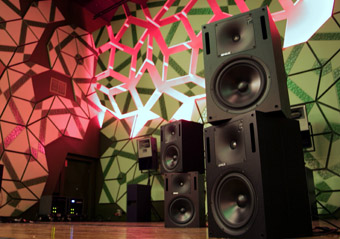
Bernard Parmegiani installation, Melbourne, LA4
photo by Mark Derbyshire
Bernard Parmegiani installation, Melbourne, LA4
“In 1999 a group of RMIT students presented a collection of experimental sound and music events. Ten years on, this collection of events, Liquid Architecture, has grown into one of Australia’s most significant festivals with a national touring program of concerts, installations and forums.” Gail Priest
In RealTime 91 Gail Priest interviews Liquid Architecture director Nat Bates to find out more about this year’s national tour and to look back at how the festival has evolved over the past ten years.
This selection from the RealTime archive also reflects on the festival’s history by singling out a few of its many highlights. Read about Bernard Parmegiani playing in Melbourne during LA4 in “liquid architecture: the parmegiani experience”, an event which Nat Bates remembers as his “number one highlight.” In “sound bodies”, a duet by Clayton Thomas and Jim Denley stands out as writer Tony Osborne’s “highlight of the week” when he samples Sydney’s LA7. Recalling last year’s LA9, “sounds solid, sounds fluid” highlights not one but “two outstanding performances”, those of festival director Nat Bates and Marcus Schmickler; the latter’s creation was “powerful, verging on spiritual, with no drugs required.”
sounds continuous
gail priest: nat bates, liquid architecture 10
liquid architecture: the parmegiani experience
simon sellars
sound bodies
tony osborne: liquid architecture 7, sydney
sounds solid, sounds fluid
gail priest: liquid architecture 9, sydney
Aucourant, AUREC, 0899-1
http://www.aucourantrecords.com
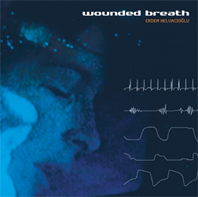 Turkish musician Erdem Helvacioglu is best known for his work with electric guitar and computer processing, drawing favourable comparisons with guitar/laptop artist Christian Fennesz (although Helvacioglu offers a significantly more polite if somewhat florid version of even Fennesz’s most accessible music). However with his latest release, Wounded Breath, Helvacioglu seems largely to have eschewed the guitar and instead produced an album of electroacoustic compositions.
Turkish musician Erdem Helvacioglu is best known for his work with electric guitar and computer processing, drawing favourable comparisons with guitar/laptop artist Christian Fennesz (although Helvacioglu offers a significantly more polite if somewhat florid version of even Fennesz’s most accessible music). However with his latest release, Wounded Breath, Helvacioglu seems largely to have eschewed the guitar and instead produced an album of electroacoustic compositions.
After several listens the overall impression is of digital reverberation. This is not to say that these compositions are geared towards any discrete exploration of the parameters or expanses of synthetic space creation, nor that they are pursuing reverberation as a means of sound production in and of itself. Instead there is the sense that echo, reverb and digitally induced spaciousness has been injudiciously applied to just about every sound in these compositions. While this may lend the album superficial production slickness, it has the effect of homogenising not only the sounds used to construct the works—which have effectively had any sharp corners or angles sheared away with the sonic equivalent of a sander and buffer—but the compositions themselves. Perhaps Helvacioglu’s work in film soundtracks might explain this overactive fascination with digital reverberation. However, even the sonic codes of mainstream action cinema don’t require quite this degree of synthesised echo.
It may seem churlish to chastise an artist for the overuse of a particular effect or form of signal processing. However, any argument that could be constructed in relation to other musical genres positing a division between electronic effects and an artist’s aesthetics is hardly applicable to electroacoustic or electronic music. An artist’s choice of the processes for modifying sounds is no more or less significant than their selection of sounds upon which those processes are deployed, if indeed these two features can be considered separately. A given sound, once affected or processed, is not only a new sound, it is the sound as heard in the work, and this is what listeners encounter. In some cases, processing is not an afterthought so much as the stimulus for the work. Therefore, in electroacoustic compositions such as these, processing must be considered not only as integral to the compositions, but a serious indicator of the aesthetics involved.
Unfortunately, listening beneath the echo isn’t a particularly rewarding experience. While the reverberation in these compositions might promise a series of potentially sensational spaces, they are ultimately rather drably adorned, or alternately filled with little of interest. Many of the sounds used here—despite how they may have been generated—will be familiar to even casual listeners of electronic music produced in the last 50 or so years: bleeps, bubbling yibbles, deep winding drones, shuffling white noise and so on. Structurally the works offer few surprises, following a simple (and well-worn) formula of peak and trough. This gives all the works a kind of unit structure that becomes maddeningly predictable long before the CD is through. Added to this is a reliance upon the cavalcade of affective clichés that echo is so often used to induce. Yes, the various reverberations all sound ‘great’ and fulfil all the related adjectives—‘rich’, ‘deep’, ‘cavernous’, ‘spacey’, ‘watery’, ‘cold’, ‘scary’ and so on—but regrettably it doesn’t leave the listener with anything much of interest to engage with. Swamped in reverb the sounds don’t really get much of a chance to speak for themselves, and, as a result, in a slightly strange way, neither does the artist.
Peter Blamey
Dual Plover/Kwanyin-Sub Jam 029, 2009
www.dualplover.com, www.subjam.org
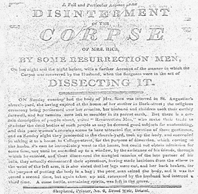 Lucas Abela has been exploring noise performance using a variety of self-constructed instruments for over a decade. Since 2003 Abela’s instrument of choice has been a sheet of glass, which he plays by humming, squealing and raspberry-blowing against it, the miked signal subsequently fed through a utility belt of effects pedals. The performance is spectacular and concludes when he smashes the glass over his head. Showmanship aside, the sounds Abela elicits in his improvised onslaughts are often extraordinary.
Lucas Abela has been exploring noise performance using a variety of self-constructed instruments for over a decade. Since 2003 Abela’s instrument of choice has been a sheet of glass, which he plays by humming, squealing and raspberry-blowing against it, the miked signal subsequently fed through a utility belt of effects pedals. The performance is spectacular and concludes when he smashes the glass over his head. Showmanship aside, the sounds Abela elicits in his improvised onslaughts are often extraordinary.
After touring extensively across Asia and Europe as a solo artist, Abela has settled on China as the home for his latest project—a band. Rice屎Corpse sees him join with experimental rock drummer Yang Yang and improvising saxophonist Li Zenghui trying his hand at piano. After four rehearsals and minimal language-based communication, the trio made a recording and went on a tour of China (courtesy of an AsiaLink residency). The resulting six track CD, Mrs Rice, is co-released by Abela’s Dual Plover label and Kwanyin, the sub-label of SubJam, run by artist and promoter Yan Jun.
Abela admits that this CD sounds nothing like anything he’s done before and he’s right. The use of piano and drums lend many of the tracks what could be described as a more accessible melodic and rhythmic drive than we have come to expect. This is established immediately in “Mountain”, where almost genteel piano notes are met by subtle under rumbles from Abela. These notes quickly develop into discordant jabs and a rocking drum section kicks in establishing a chunky middle section in which Abela takes a lead break squealing the track to a new intensity. It’s a catchy and romping jazz-fusion piece that you could actually dance to if you were so inclined.
This comfortable zone is immediately undermined by “Stamp on my balls.” Discarding tight cohesion, it reveals the artists on exploratory journeys with occasional collisions. Abela purrs and sucks, the piano skitters, there are sudden drum punctums along with distant howls and caterwauls in Mandarin. This is call and response—the artists getting to know each other musically, offering and borrowing, creating a spacious piece that shifts through a variety of dynamics.
In “Desktop Frog” there's a collective launch: a brittle scattering of drums, washes of piano notes and growing undulations on glass creating the effect of bad weather approaching. Abela takes over, producing tones akin to organ notes but with a metallic edge, wailing and moaning, until a four beat drum count down introduces splatter hysteria.
Several of the tracks are tangibly gothic, a mood amplified by the morbid newspaper story reproduced on the sleeve about Mrs Rice, a woman from Bristol in a past non-specified, whose body was disinterred for its organs not once but twice. The title of track 4, “Resurrection Men”, is taken from the same article and its pounding piano progressions, primal drum rolls and the mounting intensity of Abela’s freeform swirls certainly suggest the Boogie Man is coming to take us away…This track is wild and expansive and yet completely integrated. My personal favourite.
“Peking Duck” could be called a song. Abela sings along, matching piano and drums note for note, sounding like Rolf Harris’ wobble board crossed with a duck. It’s a short pounding track showing yet another kind of conversation between the artists.
It’s hard not to read the gruesome body snatchers narrative into the final track “Mrs Rice.” Low piano notes and wide handspan chords offer a silent film ambience, while Abela creates low burblings and deathly moans. Yang Yang's drums come to the fore with sporadic bass drum thumps like hands banging on a coffin, accompanied by cymbal skitterings and the track ends, again, in an all out squall.
As a whole Mrs Rice is a fascinating experience. It certainly has its moments of noise assault but the dynamics between and within the tracks are testament to the improvisatory skills of the artists, and a sense that they are seeking new territories. The persistence of Zenghui’s piano stabbing and jabbing wears thin by the end, and I feel that Yang Yang’s drums often get lost in the mix with the recording muddied every now and then by total overdrive. What is most interesting about Mrs Rice is the intense cohesiveness of the ensemble and the range of explorations encapsulated on the six tracks. Doubtful he'll be able to bring the Chinese artists to tour, Lucas Abela is in the process of exploring a similar band format in Australia.
Gail Priest
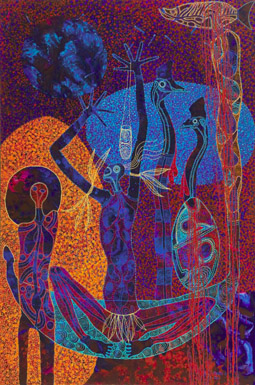
Cassowary Dream, Arone Meeks
image courtesy of the artist and Cairns Regional Art Gallery
Cassowary Dream, Arone Meeks
A sharp rustle of leaves disturbs the gentle drone of distant traffic. A lithe, nimble figure emerges from the shrub. She darts ahead, disappearing into the distance; a woodland nymph in white trainers.
Steady footsteps tracing a barren path are the initial, glaring feature in Barbara Dover’s video, Looking for Blue Arrow. The slightly shaky handheld camera brings forth a toxic rush of adrenaline and a subtle, sickly claustrophobia as it navigates a swirling track of dry, crunching gravel and bare, wooden stairs carved into the landscape. Surrounded on both sides by sparse vegetation, the unseen subject slows and breathing intensifies, capturing a vivid sense of that desperation and fear felt by hunted prey.
The walker, with camera, is on the Blue Arrow Walking Track in Mt Whitfield Conservation Park, north of Cairns—Cassowary Country. Etched in a sign is the word BLUE and an arrow symbol. The letters are like markings on a gravestone, but the name itself has become irrelevant, obsolete. All that remains is a sad irony. Blue Arrow, the last cassowary of a population which once inhabited the area was attacked and killed by two pet dogs in 1996.
Dover’s work is part of a Cairns Regional Art Gallery exhibition, This Is Cassowary Country, a vibrant hive of visual splendour, drawing from a diverse range of artists and media to explore the conflicting relationships between humans and the creatures with whom we share our environment. There are finely crafted ceramic and glass pieces from Mollie Bosworth and Terry Eager, as well as a series of woven works from Susan Doherty. Gerhard Hillmann also exhibits a colourful collection he describes as an “organic photo montage.”
Local Aboriginal artist Arone Meeks draws from traditional history and artistic techniques in creating his own striking, spiritual manifestation of the cassowary, titled Cassowary Dreams.
The regal bird gazes out from an acrylic portal contained within a mythic realm. His crest of bone and skin sits upon him like a crown. So otherworldly, yet humanized, this majestic beast could be an ancient hieroglyph of an Egyptian god. But he is a god that bleeds. A dark, crimson stain oozes from his chest like a scar on the canvas or a crack in a cave wall. Meeks injects a surreal, almost sci-fi ambience into his work. The electric blues and lava-like brush strokes place his mystic, archetypal characters in a distorted, volcanic landscape which transcends time and space.
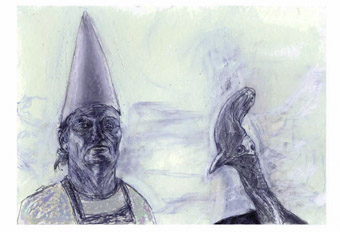
If the Cap Fits (from column installation Follies), Margaret Genever
image courtesy of the artist and Cairns Regional Art Gallery
If the Cap Fits (from column installation Follies), Margaret Genever
Margaret Genever contributes a significant portion of the exhibition. One of her works is a three-piece collection of mixed media installations in which circular windows open onto complex, re-generating worlds.
View from the Heavens is a mish-mash mosaic of shoes, painted black, jutting out from a spherical base, and looking like ashen, post-apocalyptic rubble. At second glance, flecks of blue and red peer shyly through the slick, oily veneer, like rare cassowaries in a desolate urban wasteland.
There are gumboots, grandma’s sensible pumps, the iconic Aussie thong, a strappy pair of heels, a child’s slipper, the cartoon face of a dog still prominent under the thick paint. Connotations of carbon footprints confront the viewer at eye-level. These are the stiff, mundane shields which we don each day to protect ourselves from the earth, eliminating the sensation of touch, allowing us to tread without pain or awareness.
Directly behind this work is an installation titled View from the Centre of the Earth. Layered on shoe soles is a fascinating and fragile ecosystem. The skeletons of leaves are exposed and imprinted on the earth. Intricate debris and delicate remnants of butterflies dwell below the surface. A dragonfly is perched precariously on one sole, perfectly formed and preserved despite the weight of the world balanced tenuously on tiny wings.
The third work, View from the Future, is on the floor. Leaves like snowflakes lie undisturbed and frond prints in charcoal dust dance on a forest floor. There are no shoeprints stamped clumsily without care and thought. No trace of humanity. Just as there are no arrowed footprints planted softly in the earth by a flightless phoenix of red, blue and black.
Genever articulates a prophetic sentiment which resonates throughout the exhibition. Our existence and the survival of the cassowary are directly entwined.
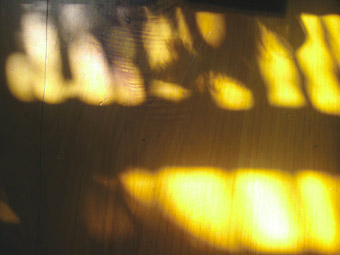
Peripheral (video), Beth Shorter
image courtesy of the artist and Cairns Regional Art Gallery
Peripheral (video), Beth Shorter
Imagine drifting contentedly through an afternoon in your cosy home. Your eyes are half closed. You are on the periphery of consciousness. Particles of light leak through your eyelids. Colours swirl in the room like dust motes until you’re breathless and dizzy. Shapes arrange themselves in some sort of strange celestial dance.
Some artists strive to be at the cutting edge. Beth Shorter’s mixed media works in Peripheral, however, explore this notion of being at the edge of things in an ephemeral, rather than an in-your–face way. Her subject is the nature of light in domestic spheres—the ordinary spaces or “non-places” that, upon closer inspection, reveal little worlds full of pattern and colour.
In Ambiguous Highlight, a slide image on paper, amoeba-like spheres rendered in baby pink and blue float in a field of ink and midnight. An ochre crescent grounds the work, although this sensible colour is mostly relegated to the sideline. Ambiguous Highlight’s companion piece, Accentuated Light, sees the same pastel orbs morph and multiply—are they engaged in a courtship dance or fighting to each outshine the darkness? These pieces owe something to clever out of focus camera work and have a shifting, transitional quality.
Their digital sister work, Unobserved Objects, delivers a more heady rush of colour with traffic light red and green, that iridescent blue particular to insects and Moroccan mosques, and variations of lilac, turquoise and aquamarine, all afloat in the night sky. This work makes me think of driving at night through the rain, where city lights take on the quality of a hazy, enticing carnival. But then, another viewer might see something entirely different.
This exhibition, comprising both digital and slide prints on bamboo paper, oils on canvas, short film and installation, invites interpretation while celebrating ambiguity. The oils, interesting technically, also contribute to the overall ephemeral effect, although occasionally they tend to concretise the subject that elsewhere dances in everyday spaces.
In the short film, Shorter initially draws us in with indistinct green shapes. You may just make out some organic matter—is that a lacy palm frond stirring in the breeze? Once recognition has taken place the work assumes the feel of a balmy night in the tropics. Then, a segue, and we gradually see more literal objects as the camera moves in and out of focus. We contemplate various surfaces in the domestic space, such as a brick wall, a timber fence and ridged heavy fabric, although these items are never precisely placed. It is more about textures and their collective effect on the viewer.
The celestial notion of the images on paper is continued in the installation titled Shadow Play. Comprising movable ceramic disks suspended from the ceiling like a children’s mobile, this is an interactive piece that invites the viewer to enter the artist’s realm. By moving the disks you are able to manipulate the interplay of objects, and observe the resulting shadows on the blank canvas of the gallery wall. Once again we see the interconnectedness of objects and light create beguiling patterns in space. This time it is the viewer and not the artist who manipulates the medium to see the light.
In her artist’s statement Beth Shorter writes briefly about the specific spaces she has inhabited, three separate houses in Far North Queensland, and how her work is specific to the light, foliage and interior details of these environments. While it is true that delicate palm fronds at the edge of things evoke the tropics, and that light may be particular to place, in the manipulation of these elements Shorter has also created other worlds. In these familiar “un-spaces” are other meanings all our own.
These gentle and intriguing works have the effect of winding one’s mind down, a lovely thing in our increasingly frenetic world. Meditative, experiential and intimate, take the time to allow these pieces of everyday magic to come to you.
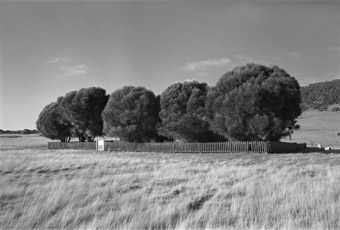
The Healing Garden, Wybalenna, Flinders Island, Tasmania from Portrait of a Distant Land, 2005. silver gelatin print
copyright Ricky Maynard, courtesy Stills Gallery
The Healing Garden, Wybalenna, Flinders Island, Tasmania from Portrait of a Distant Land, 2005. silver gelatin print
“It’s pretty important you know, the land, it doesn’t matter how small, it’s something, just a little sacred sight, that’s Wybalenna. There was a massacre there, sad things there, but we try not to go over that. Where the bad was we can always make good.”
Indigenous Tasmanian speaker
The Healing Garden, Wybalenna, Flinders Island Tasmania is one of many images from Portrait of a Distant Land, a retrospective of Ricky Maynard’s photography staged by Sydney’s MCA and exhibited at Cairns Regional Gallery. Initially the landscape is seemingly serene and rustic—grassland with several velvety trees enveloped by a forlorn picket fence. Apparently innocuous, the composition of the landscape draws you in, with its luminous gate and rickety fence that bind the spongy trees. What incredible trees. Am I looking at a sacred site, a site of worship? Only upon reading the accompanying text do I learn of the ghastly horror commemorated here, accentuating the burden Indigenous Australians have to bear and their determination to survive.
Ricky Maynard is an award-winning Aboriginal photographer who lives and works on Flinders Island and is one of the Ben Lomond/Cape Portland people. His finely crafted black and white prints are neatly framed in rosewood, but the images are sometimes raw and often haunting. Portrait of a Distant Land combines discrete lines of inquiry from five exhibitions over two decades of documentary photography. And to this overview Maynard adds the byline, “Do not forget these faces—they hold something you would not believe.” Hence an individual’s face, a description of circumstance, the surface of an environment, all imbue the collection with multiplicity and meaning.
In the early 1980s Maynard began his journey to capture through the camera his culture—landmarks, people, places and experiences which would otherwise have been lost or gone unrecognised. His dedication to documenting histories of Indigenous peoples is revealed in his considered choice of subject matter—certain eras, places, jobs, kinds of country and everyday life.
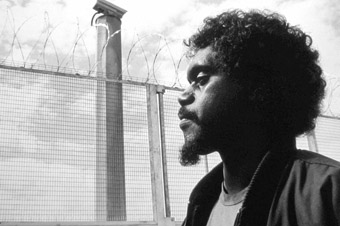
Untitled from No More Than What You See series, 1994
copyright Ricky Maynard, image courtesy of the artist and Stills Gallery, Sydney
Untitled from No More Than What You See series, 1994
The insight into daily life takes the viewer into a range of situations, from the heart of Tasmania to the tip of North Queensland, from the bush to the ‘burbs, from expanse to confinement. In No More Than What You See (1993), an untitled image of a man looking in the mirror shows the plight of incarcerated indigenous people in the South Australian prison system. The black border of the photo seriously constrains the image, the technique continuing throughout the series. These works are aptly hung in a cell-like room of the gallery, amplifying the sense of restriction. We see the out of focus back of a man in his 20-30s, looking into a rivet-framed mirror, in sharp contrast with his focused reflection. The white walls and mirror that frame his head and chest, the tube of toothpaste and assorted toiletries evoke a stark existence and a sense of despair. Again Maynard’s simple composition provides visual interplay as the eye darts back and forth between the two perspectives, animating the image and giving it life, if a bleak one.
This state is juxtaposed with indigenous triumphs. The portraiture from Returning To Places That Name Us 2000 is a series of large scale headshots, defiant in the face of horrible injustices. The photographs are inspired by the landmark High Court of Australia ruling that recognised the existence of traditional lands of the Wik people in Cape York, North Queensland. The images fill the gallery like Easter Island guardians. One such portrait, the face of Joe, Wik Elder, shows a wise and knowledgeable Aboriginal man fixing a penetrating gaze upon his lot. The white prickly beard, wiry hair, creases on the forehead and pursed lips suggest a steely presence. Joe appears to be missing an eye in the dark deepness of his face. I have to move several times past the glare from the gallery light, to see what is not there. Perhaps more considered composition, or Maynard magic.
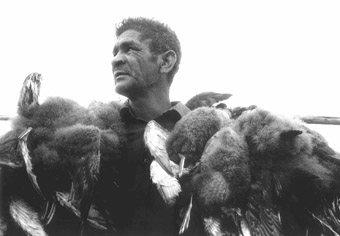
Athol Burgess from The Moonbird People series 1985-88, printed by the artist 2007
copyright Ricky Maynard. Image courtesy of Australian Institute of Aboriginal and Torres Strait Islander Studies, Canberra
Athol Burgess from The Moonbird People series 1985-88, printed by the artist 2007
Returning To Places That Name Us 2000, The Moon Bird People 1985-88, Urban Diary 1997, In The Footsteps Of Others 2003, and No More Than What You See 1993 and ten new images are the works that comprise Portrait of a Distant Land. Maynard’s choice for his portraiture and landscapes are black and white gelatin silver prints rather than colour. This makes for a more neutral setting for this highly evocative work whose sense is historic rather than emotive.
Portrait of a Distant Land provides a poignant and reflective expedition for the viewer. It offers cultural insights and gestures that are revealing of traditional and contemporary life. While reminding me of the challenges facing these people, I was left with a sense of hope for the reclaiming of Indigenous culture—exhibiting Ricky Maynard’s photography, especially his Wik work, here in Northern Queensland suggests the possibility that a viewer might find a relative staring back at them.
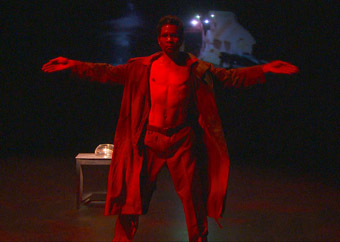
Earl Rosas, Whispering Limbs, Bonemap
A dancer, Earl Rosas, enters a darkened space, bare-chested. He balances a bowl with goldfish on his head. Subtle images of ripples are projected on a large screen on the back wall, underscored by watery musical rhythms. The dancer fluidly eases his way to the floor, as though the life he bears is sacred. The right angled shapes he makes with his arms are intriguing, hinting at ritual, and so precise and contained that I soon lose my fear for the fish’s safety.
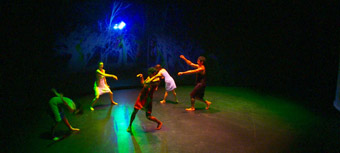
Bonemap, Whispering Limbs
Rosas exits and the mood shifts: enter a troupe of bright young things, two men (Rosas and Efeso Fa'anana) and three women (Rebecca Youdell, Lisa Fa'alafi, Leah Shelton) dressed in their best sharp suits and elegant dresses. Powerful synchronised articulations belie their demure appearance. They also manifest on the wide screen behind, running fast-forward over a neat lawn, evoking partygoers at an afternoon garden soiree. Gradually, onstage the dancers break form, their movements becoming disjointed and irregular. They appear disturbed, even slightly manic, as they work their way through a kind of collective bodily neurosis, moving towards a tall cylindrical scrim; a white bone in the dark.
Slithering under the scrim they undress to reveal silk slips—the men too, one in a lacy black number and the other in red. Now the performers are less constrained, transformed even. They slither out and once again we see their doubles in projection. This time they move through a midnight bushland setting, their urgent pace contrasting with the ghostly sentinel-like trees.
More striking moments ensue; memorable are the eerie image of a girl floating in a suitcase holding a single light globe, and an extraordinary representation of a live 'meringue' doll. Here, the performer brings an innocuous piece of white material to life. She emerges from it slowly as if from a cake or a cocoon. The material then morphs into a skirt which although voluminous restricts her movement. This beautiful metamorphosis may ultimately be a limiting one.
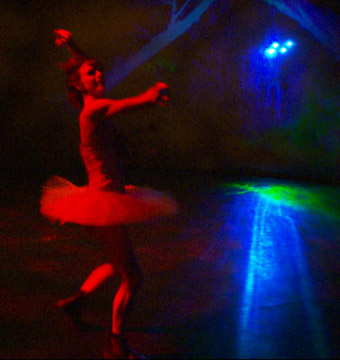
Rebecca Youdell, Whispering Limbs, Bonemap
The funny bone gets a tickling too; Rebecca Youdell’s quirky bush ballerina throws us her bouquet of weeds at the end of a gum chewing interlude, and Efeso Fa’anana’s figure in overalls fusses over a perfect circle of lawn, before handing out a piece to an audience member as if it were a slice of real estate.
The theme of water is revisited in the form of three raincoat clad creatures in gumboots trudging over to a small pool. Here they proceed to drip and leak slowly from their costumes as if beings made entirely of liquid. Perhaps this is an ironic comment on water consumption in these times of climate concern.
Shadow play is another device explored in Whispering Limbs. At one point the three female dancers teeter behind the scrim in exaggerated heels, hats and structured hoop skirts. They posture suggestively, their shadows evoking a larger than life burlesque show. Here we are caught between the real bodies of performers and their darker spirits, privy to the interplay of the tangible and the ephemeral. This sequence climaxes with the arrival of a metallic frame structure, where the fish makes its final appearance. The bowl becomes a coveted item for the dancers, instigating a mad scramble for possession. Thankfully, the enigmatic man of the first scene ensures its survival. We are left with the image of this serene being holding the goldfish in the bowl, just as the world holds him in its lulling turn. Order has been restored.
Whispering Limbs evokes issues and images of spirituality, ecological sustainability, transformation and doubling, generating a metaphysical whirlpool of ideas and images. The media components integrate with the physical performance perfectly to produce a work that, in the end, defies categorisation. Beautiful and strange, Whispering Limbs is part dark ritual, part mad hatter's tea party.
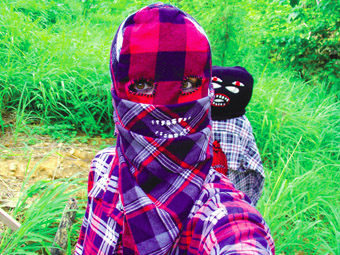
Combat Drag (video still), 2008, Jemima Wyman
images courtesy the artist and Milani Gallery Brisbane 2009.
Combat Drag (video still), 2008, Jemima Wyman
It’s night (cam). You’re in the scrub, playing at bushrangers. A voice from the rough end of hell tells you, “It’s coming to get us.” Is this your big brother playing tricks, or something far more sinister?
In Jemima Wyman’s video work Combat Drag a small army of flannelette-clad forms stake out their territory. Like YouTube zealots they posture and pose with menace in out of the way places, waving twigs as if they were guns. These figures have an essence of the Monkey Magic ninja, but also of dispossessed Australian youths. In addition to the iconic flannie, the performers in Combat Drag wear exquisitely crafted woollen masks with sewn expressions—like those belonging to the slightly odd-shaped toys you can buy in gallery shops. Only the performers’ mouths and eyes are visible, enhancing a fearful sense of the unseen and unknown.
This work disconcerts by skewing the familiar. Cultural symbols, ideas about identity and images of extremism trip each over each other. The strange masks, ‘terrorists’ in flanelette, ambiguous setting and a disturbing voiceover alerting us to the approach of “something big and scary” collectively evoke a corporeal response. The fear we are meant to experience, nonetheless, feels contrived and ironic—we are told in no uncertain terms that we should be afraid.
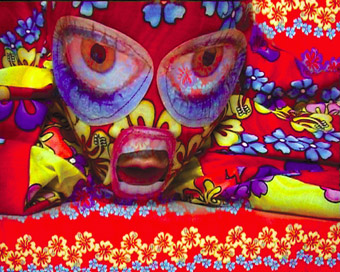
Whak’emall (video still), 2006, Jemima Wyman
images courtesy the artist and Milani Gallery Brisbane 2009
Whak’emall (video still), 2006, Jemima Wyman
More menacing for me is the work titled Whak’emall, which features a figure somewhere between a tantrum-throwing toddler and another backyard terrorist. Masking is also featured in this work, with the toy-like puppet toddler/terrorist garbed in a vertigo-inducing hibiscus-printed coverall. This garment has a homemade quality about it: part pyjamas and part straitjacket. Here too, the headpiece is customized, this time with appliquéd facial features and a hole cut out for the performer’s mouth. Red squiggles suggest the bloodshot eyes of a character both temperamental and nightmarish.
At one point the performer spins the mask to reveal a similarly disturbing face on a yellow hibiscus background. The personality of the subject does not change, despite the disorienting shift in camouflage. Different factions adopt different guises but the militant ideology remains the same.
The construction of this video work has a calculated naivety, its visual and audio quality evoking a YouTube posting or sinister home video. Wyman aims to disarm us, using familiar techniques to frame her disturbing figures.
Whak’emall and Combat Drag evoke a subjective state where extremists—be they toy, toddler, suburban youth or terrorist—find a sense of belonging and achieve oneness by donning masks. But along the way, Jemima Wyman leaves plenty of gaps into which we may insert other meanings of our own.

Earl Rosas, Whispering Limbs, Bonemap
IN WHISPERING LIMBS THE VERY FORCES OF NATURE HAVE MORPHED AND DISTORTED. WE ARE GRIPPED BY A FEELING OF FOREBODING. AN UNDERCURRENT OF BURGEONING CHAOS BUBBLES BENEATH THE SURFACE OF THIS STRANGE PARALLEL LAND.
Those who dwell here are twisted, hybrid versions of humanity, moving with a strange blend of supreme elegance and exaggerated rigidity, teetering and towering on stiletto heels, then shuffling ominously like the dancing undead.
Bonemap’s new work takes us into a dark, cosmic realm fraught with unseen danger and illicit desire. It is a creative explosion of diverse dance and movement, haunting soundscape, evocative new media art and vivid costume design. Whispering Limbs furthers Bonemap’s deeply introspective dialogue with nature, exploring ecology through physical and visual expression. Here Rebecca Youdell and Russell Milledge collaborate with dancer Earl Rosas and Brisbane-based performance ensemble Polytoxic.
At the show’s beginning Rosas appears like an ancient shaman. He enters slowly and carefully, a goldfish bowl filled with water balanced precariously on his head. Concentration is etched on his face, the atmosphere tense and electric as his dark, sinewy limbs twist, bend and mould in a precise articulation of quiet, renewable strength and infinite balance. Like a mystic yogi he meditates on deep, unspeakable thoughts, encapsulated in the spherical vessel. Or perhaps he is a titan, suspended in space, carrying a blue planet.

Bonemap, Whispering Limbs
But there are new images to dream on. A large, creamy cloud of stiff cloth rises in a box high on the wall. As it floats and expands an arm emerges, like a seeking periscope. It darts and curves gracefully as if with a life of its own. A woman’s face and torso follow the arm and the cloud becomes an elegant ballgown.The woman dances, like a beautiful figurine in a music box, the skirt billowing below her. She pushes it down again and again, but soon it consumes her and plunges both of them back into darkness.
We enter other worlds of dancing dolls and dresses. Rebecca Youdell struts about in tutu and clunking boots, chews gum and glares at the audience, nonchalant and distinctly unimpressed. Her brattish rudeness unleashes itself in a dance of pure, unadulturated glee; her delicate, agile spins and twirls amaze and utterly captivate. But she grows bored. With wicked playfulness the doll-like figure launches into a bizarre, somewhat disturbing corroboree. Before her performance ends she unfastens a tired corsage of weeds and hurls it into the audience, like a demonic bride tossing her floral bouquet.
These are just some of the vivid imaginings which form the surreal collage that is Whispering Limbs. Water is a recurring, connective theme. At one point three performers appear in raincoats and gumboots. They trudge across the stage, water leaking from within their coats. It rains from them. They tip their boots in unison, pouring the water into a pond. In the finale Rosas returns with his water vessel and goldfish. This time he places it high on a metallic structure as menacing girls in old-fashioned, hooped skirts lurk threateningly underneath. Could it be, in this nightmarish ending, that this fish-bowl world is symbolic of our own?
Whispering Limbs is an intoxicating, immersive, hyper-sensory experience—a dark dreamscape. We feel the beauty and coarseness of nature and ponder the ambiguity and unpredictability of the human psyche as the work’s blend of rich imagery and delicate symbolism burn into the memory.
On Edge, Bonemap, Whispering Limbs, design, media Russell Milledge, composer Steven Campbell, performers Rebecca Youdell, Earl Rosas, Polytoxic [Lisa Fa’alafi, Efeso Fa’anana, Leah Shelton]; JUTE Theatre, Cairns, July 9-11.
RealTime issue #93 Oct-Nov 2009 pg.
© Kate Cooper; for permission to reproduce apply to realtime@realtimearts.net
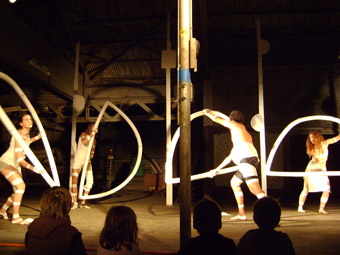
Cast, Blueprint, Zane Saunders
photo Jenny Fraser
Cast, Blueprint, Zane Saunders
FOUR EPHEMERAL FIGURES EMERGE FROM BEHIND TALL, METALLIC TREE-LIKE SHAPES AT THE BACK OF CRATE 59’S DECAYING INDUSTRIAL SITE. MARKED IN WHITE CLAY AND WEARING STRIPS OF CLOTH REMINISCENT OF BANDAGES, THE PERFORMERS APPEAR TO BE FROM ANOTHER TIME AND PLACE.
They clasp bony, life-sized, half-moon structures—the shape echoed in their facial markings. Together they guide us through a re-imagining of traditional fire and land clearing practices in Cape York. Fluid in their symbology, the performers morph from spirit to animal to human and back again.
Blueprint, a new work conceptualised by indigenous artist Zane Saunders for the On Edge festival in Cairns incorporates dreaming, circus references and the everyday to create a trance-like elegy for the dying land. We see natural formations and ancient tribes displaced by the elements, ingeniously represented by tiny styrofoam beads tossed by wind. In a burial ceremony the audience are invited to offer flowers to the deceased land at a half-moon grave.
In the aftermath of this event Saunders presents us with an indelible image. A battered fan turns the pages of what appears to be a bible and scatters printed images across the floor. Here the lines between performance and installation blur. We are cued for grief and let into the moment with a Bob Dylan track from a ghetto blaster. We are reminded that, yes indeed, “The times, they are a-changin.” A hazard light, stage left, flashes a yellow sunset as the lights dim and the first part of Blueprint ends, with an apparent snuffing out of human and animal life.
This vignette of grief has its companion piece in part two of Blueprint, where the performers celebrate regeneration of the land and the renewal of life. There is fresh energy and a greater sense of pace, and after a time, the land is re-born. Domino-like structures, possibly monuments to civilisation or colonial invasion, are knocked down. Lines of string demarcate—and perhaps reclaim—this land as spiritual territory. Like a tightrope walker, Saunders takes centre stage, balancing a long pole horizontally in his hands, while walking intently towards us. The intensity of the action is juxtaposed with Saunders’ relaxed grip as he appears to embody the spirit of both creation myth and circus performance. A ritualistic fire ceremony ensues, the performers lighting incense coils. Curls of smoke permeate the space and soften the raw industrial feel of Crate 59.
Blueprint is a new work exploring environmental management issues in an evocative, and sometimes abstract, way. It reminds us that, while it must go though fire to yield new beginnings, our land should be afforded all the ceremonies we would a loved one.
Zane Saunders, Blueprint, with Jess Jones, Joelle Baines and Hanzard, sound Nicholas Mills; Crate 59 Gallery, July 9 & 11..
RealTime issue #93 Oct-Nov 2009 pg.
© Victoria Carless; for permission to reproduce apply to realtime@realtimearts.net
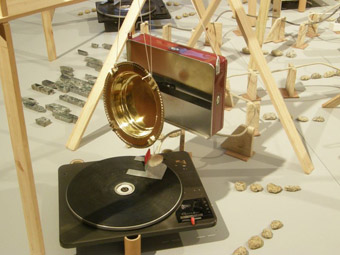
Ernie Althoff, The Middle Eight, Geelong Gallery
courtesy the artist
Ernie Althoff, The Middle Eight, Geelong Gallery
You can hear Ernie Althoff’s work as soon as you enter the Geelong Gallery—a quiet, metallic ringing—and as you walk around the gallery, gentle sounds permeate the space and affect your appreciation of the art on display.
Althoff’s work, The Middle Eight, sits on a long, low plinth on the floor of an otherwise empty room in the centre of the gallery, adjacent to another, larger room that contains the main body of work in the exhibition, The Freedom of Angels, Sculpture in a Century of Upheaval, of which it forms a pivotal element. In a program note, Althoff explains that the work’s title refers both to the geometry of the room, which is in the middle of the gallery, and to “the musical term denoting the ‘bridge’ part of a pop song that differs from the verse-and-chorus units. Hence, The Middle Eight signifies both the physical structure of the installation and the music it plays.”
This survey exhibition includes works ranging in style from neo-classical, such as Cesare Lapini’s delightful late 19th century marble The Kiss of Love, through modernist to postmodern, including the powerful abstract steel fabrications of Clement Meadmore, Inge King and Ron Robertson-Swann, the ironic assemblage of Aleks Danko and Rosalie Gascoigne’s transcendentally beautiful panels made from found crates. Mounted on industrial scaffolding rather than conventional museum plinths, the works in this exhibition, by some of the most important figures in Australian art, traverse the range of visual language and cultural perspectives of the 20th century, an era from which we have now perhaps gained sufficient distance that we can fully appreciate the enormous social, technological and artistic changes that it encompassed.
The Middle Eight comprises nine old phono turntables sitting beneath timber frames that support a variety of metal and timber objects, including eight brass gongs, various baking tins and food cans, some augmented with springs, and small sheets of plywood. Mounted on the turntables are small metal brackets and, as the turntables revolve, the brackets strike dangling strings fitted with hammers that strike the gongs, tins and other objects to produce a range of delicate ringing and clattering sounds. The result is like an eight note gamelan augmented by other sounds, and with only small differences between its tones. The swaying hammers aren’t always activated at every revolution of the turntable, and even when they are, they might not strike the target object — there is a high level of chance built into the work. The components are generally cheap, found objects, but assembled with much care. Even the electrical cable connecting the turntables is laid out on small plywood mountings, and rows of small stones are arranged in between the turntables to add another visual dimension to the work. The turntables turn at the uniformly slow speed of 16 rpm, and given the low probability of the hammers striking their targets, there are often long pauses between particular tones, and the melodic sequence that results is endlessly variable. The overall effect is of ambient sound a little like wind-chimes but more complex. In the uniquely resonant space of the Geelong Gallery, this music is intriguing and seductive.
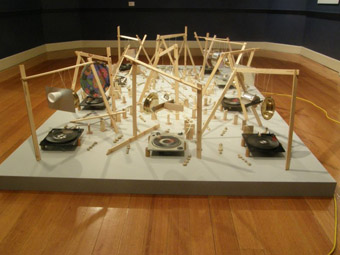
Ernie Althoff, The Middle Eight, Geelong Gallery
courtesy the artist
Ernie Althoff, The Middle Eight, Geelong Gallery
Althoff has been making kinetic works of this kind since the late 1970s. Typically they involve the use of very simple objects set up to generate a variety of sounds, sometimes meditative and sometimes chaotically loud and intrusive. In some previous works, Althoff has included audience participation in the design, but here the audience simply looks and listens. Conceptually, there is irony in the artist’s use of the turntable, which was invented to replay recorded sound accurately, but which is now used to generate new sound aleatorically.
The sculpture exhibition draws on a quote from Michelangelo, “I saw (an) Angel in the marble and carved until I set him free.” Althoff’s work sets sound free from its metal and timber constructions. Through the twin catalysing forces of electrical power and the composer’s design, sound is now encouraged to flow from musical and unmusical objects. The listener can experience and understand familiar ambient sounds anew, and better understand what it is to engage in the act of making sound or music. By using electro-mechanical devices (the turntables) to activate the tins and gongs, Althoff shows how the musician catalyses an object in a way that establishes its meaning and renders it an instrument. These electro-mechanical devices parody human musicians executing a score. The score, or orchestration, is not as precise as those of some other mechanical music-making devices such as player-pianos, but is more calculated and precise in nature than, say, a chime activated only by the wind.
Showing The Middle Eight in a sculpture exhibition contextualises Althoff’s work as sculpture rather than as sound art or performance. In the concert hall, the work would be judged against other forms of musical performance, and we now see how this interpretation can limit appreciation. When seen as sculpture, Althoff’s work enlarges our understanding of musical objects, visual art objects and everyday objects, questioning the distinction between commonplace materials and art. Importantly, it adds to the exhibition the elements of the electro-mechanical device, kinetic sculpture and Art Povera, completing the Geelong Gallery’s finely detailed picture of 20th century sculpture.
See Dean Linguey’s interview with Ernie Althoff : RT #70, p46
Ernie Althoff, The Middle Eight, in the exhibition The Freedom of Angels, Sculpture in a Century of Upheaval, Geelong Gallery, May 8-July 5
RealTime issue #91 June-July 2009 pg. web
© Chris Reid; for permission to reproduce apply to realtime@realtimearts.net
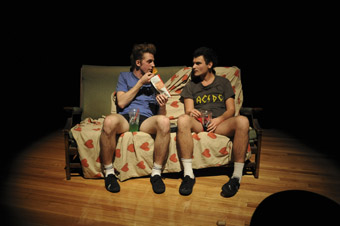
Tully Arnot and Chris Petkovic performing Beavis and Butthead, NightTime: Petty Theft, Performance Space
photo by Heidrun Löhr
Tully Arnot and Chris Petkovic performing Beavis and Butthead, NightTime: Petty Theft, Performance Space
A character straight from a B-grade sci-fi film speaks amicably to a small group of people of his expeditions aboard a grand star ship. He tells us that there is no currency in the future, but muses he is glad to be with us tonight in our present. Video records of his adventures in space play on stacks of old TV sets behind him. The footage is ripped from Star Trek, the Next Generation. This is Matt Rocheford’s performance, part of the first half of NightTime: Petty Theft.
In the most recent of Performance Space’s periodical short works nights artists were encouraged by the curatorial team to borrow, steal, appropriate and remix—all in the name of art.
The CarriageWorks Bay 20 theatre was set up for standing and mingling amongst installation works in the first half. Tully Arnot and Chris Petkovic sit on a couch being Beavis and Butthead. Video works by Jorey Corson and Blaine Cooper are looped on a commandingly large screen. In an intimate performance Phil Spencer asks you to sit on a milk crate opposite him and confess ‘have you ever stolen something?’ For your confession you are rewarded with a cashew nut.
I noticed a distinct ambivalence in the works staged towards the moral ground on which ‘theft’ stands. Underlying this was a questioning of the terms on which an artist can appropriate others’ words, images and ideas, and rehash them for their own work. When is the remix quotation and when is it plagiarism? And what is the outcome of the constant recycling of cultural icons? Some works suggested reference as flattery, some were critical or derisive of their original, and a few (and this is the danger of remix) were simply derivative.
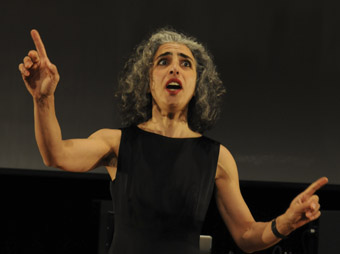
Katie Molino performing Already Gathered, NightTime: Petty Theft, Performance Space
photo by Heidrun Löhr
Katie Molino performing Already Gathered, NightTime: Petty Theft, Performance Space
The second half, a sit-down show, was a clash of theatre-type performances and multimedia and film works. Brown Council came out in T-shirts that read FRESH, NOW, HOT, HYPE. Recycling historic images of feminism and pop music, they feebly tried to set fire to their nylon bras (now removed) with cigarette lighters to Beyoncé’s hit song “All The Single Ladies.” I doubt that Beyoncé got royalties for this performance.
In a self-reflexive monologue Katia Molino affirmed the claim that everything in the theatre has already been done. A Soda-Jerk film constructed an hilarious fictional history of hip-hop culture entirely through sampling existing footage and sound—appropriate given the abundant use of samples and remix in hip-hop music.
The finale for the evening was audio-visual duo They Live with a recut of John Carpenter’s classic zombie film, They Live, performing their own sound piece over the top. The creepy ambient music made the film scarier than it actually is. Usually I would be laughing at the dated special effects but I was drawn into the relationship between the live music and the film that now seemed to have a renewed contemporary relevance. I am torn though—is it more homage than original work? For this NightTime it shouldn’t have mattered, as the platform was set up to celebrate postmodern pastiche and piracy. Still, although funny and all very cynical, there was something about the endless recycling of pop culture references that left me feeling empty.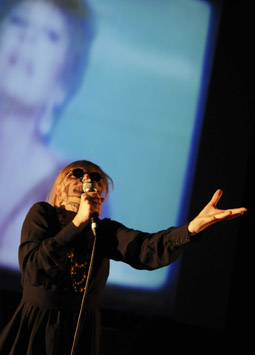
They Live performing Here to Chew Bubblegum, NightTime: Petty Theft, Performance Space
photo by Heidrun Löhr
They Live performing Here to Chew Bubblegum, NightTime: Petty Theft, Performance Space
Performance Space: NightTime: Petty Theft, curators Lara Thoms, Rosie Dennis, Rebecca Conroy; CarriageWorks, Sydney, June 19
RealTime issue #91 June-July 2009 pg.
© Megan Garrett-Jones; for permission to reproduce apply to realtime@realtimearts.net
Rosie Dennis’ strong reputation in the performance world has been built on the success of 20-30 minute, intense and fast-paced dance/performances, described in RealTime as “manic”, “electric” and “obsessive-compulsive.”
But her latest work, Fraudulent Behaviour, is twice the usual duration and, with her distinctive style adapted to a more sustainable, often whimsical and, at points, almost meditative pace, it marks a departure for Dennis.
Exploring the human predisposition for hurtful lies and harmless un-truths this work has an ironically honest quality, both in content and delivery. Yet there is a strong sense of the surreal in Fraudulent Behaviour. Through bizarrely down-to-earth conversations with a rubber duck and long-time invisible friend Elvira, and child-like storytelling via a rudimentary puppet show, Dennis breathes life into the truism that ‘truth is stranger than fiction.’
Amid these exchanges—Dennis and duck, Dennis and audience, Dennis and neurotic Dennis—subtle nuances, rhythmic repetition and a sharp sense of humour highlight the infinite instances in which we utilise deception. “I love that, I lurve that, I LOVE that”, she exclaims, and we snigger, caught out, wondering the number of times and ways we have already said that today.
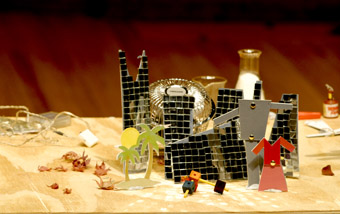
Set detail, Rosie Dennis, Fraudulent Behaviour, Performance Space
photo by Heidrun Löhr
Set detail, Rosie Dennis, Fraudulent Behaviour, Performance Space
But Fraudulent Behaviour goes beyond simply illustrating Nietzsche’s proposition that “we need lies in order to live”, which Dennis writes on her whiteboard. A makeshift snow-globe, flashing Hotel Tropicana sign and the duck’s fake flower lei are some of Dennis’ numerous kitsch references to the notion of Paradise. They suggest that our web of lies (large and small, to ourselves and others) constructs a false reality, an idyllic destination far more attractive than our inescapable, internal one.
In an interview in 2006, “Confessions of a fast talker,” Dennis described herself as “difficult to program” due to her falling between categorisations of dance and theatre, and the reluctance of arts organisations, especially in Australia, to schedule short works. The idea of producing longer, 45-60 minute performances was an issue of creative integrity: “I don’t want to do that, I want to be true to what I enjoy,” she explained.
It seems fitting then, that a work about our relationship to truth asks if Dennis is still being true to herself by making it. Of course, what Fraudulent Behaviour serves to illustrate is that we need lies in order to live, because truth is subject to change. Only lies are reliable.
confessions of a fast talker
keith gallasch talks with improviser rosie dennis
anamorphic srchive: the rosie dennis file
martin del amo
rosie dennis: one from the heart
winnie love
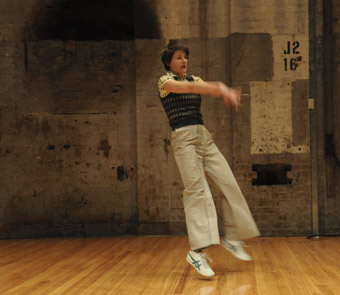
Rosie Dennis, Fraudulent Behaviour, Performance Space
photo by Heidrun Löhr
Rosie Dennis, Fraudulent Behaviour, Performance Space
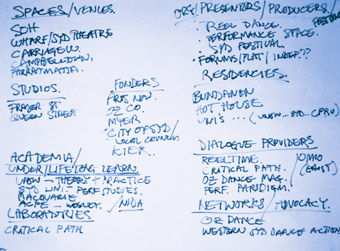
White Board, Where is Independent Dance in Sydney? Symposium
photo Erin Brannigan
White Board, Where is Independent Dance in Sydney? Symposium
The flotsam washed up on an Adelaide beach and collected by photographer Narelle Autio, as displayed on the cover of this edition of RealTime, becomes material for her faux taxonomical reverie on the peculiarly consoling if sometimes disturbing beauties of transience and decay (p54). There are times when artists themselves feel like detritus tossed about and discarded by economies in flux and the restructurings of funding bodies. In RealTime 90 we bewailed Arts NSW’s application of callous funding criteria and its abandonment of the independent dance sector [p22]. In a message to artists, performer Jeff Stein, disturbed by the millions spent by Events NSW on the first Vivid Festival while the small to medium arts sector languishes, aptly proposed a counter-festival titled Gloom. Stein regards it as hypocritical that “the NSW Government through Events NSW is celebrating how creative Sydney is at the same time, through Arts NSW, increasingly not supporting the arts, especially the small to medium sector, which is really struggling.” In this edition we focus on arts infrastructure issues in Sydney: the survival of the independent dance sector, the ennabling role of the Queen Street/FraserStudios spaces for artists [p21], and the visions of the directors of Performance Space and CarriageWorks [p19-20] so critical to many of Sydney’s innovative artists. The emergence of independent creative spaces like Red Rattler in the inner west [p27] and the growing strength of adventurous and supportive arts centres in Sydney’s west, provide new hope for artists. Marcus Westbury’s extensive Catalyst forum program at the MCA capitalises on a city brimming with invention. But unless basic issues of subsistence and survival for the small to medium arts sector are seriously and formally addressed by the NSW Government, the city’s under-funded innovators may well be washed up on the shore of lost hope.
RealTime issue #91 June-July 2009 pg. 1
© Keith Gallasch; for permission to reproduce apply to realtime@realtimearts.net
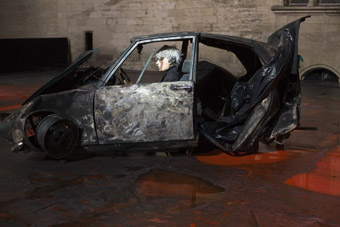
‘Andy Warhol’, Inferno, Romeo Castellucci,
photo Luca Del Pia
‘Andy Warhol’, Inferno, Romeo Castellucci,
ON THE DAY THAT THE G20 SUMMIT CONVENED IN LONDON AND BANKERS WORE JEANS TO WORK TO AVOID VIOLENT ATTACK, THE SPILL 2009 LAUNCH SAW HEADS LITERALLY ROLL. OR DID IT? AN AUDIENCE, FROM THE CITY AND BEYOND, MERRILY WATCH MARISA CARNESKY, MAGICAL PERFORMANCE ARTISTE, “MAKE SOME CUTS.” SHE PUNISHES AN AUDIENCE MEMBER FOR POINTING THE FINGER BY SLICING IT OFF WITH A GUILLOTINE; SHE GRADUATES TO A HAND, A HEAD AND A CHAINSAW TO THE STOMACH. AS WE CHEER HER ILLUSIVE MASSACRE ON, IT SEEMS THAT THE FESTIVAL WILL BE ABOUT COMPLICITY, EXCESS AND AMBIGUITY. SO WHAT DOES THE FUTURE HOLD FOR US AMIDST THIS LANDSCAPE OF BLAME AND RUIN?
Romeo Castellucci’s Inferno is an ever-evolving cycle of striking images from an (after)life that is familiar, yet distant. White noise thunders painfully as we see our reflection in the mirrored wall of a giant cube. Suddenly the surface flicks into a transparent panel, beyond which a group of toddlers play with colourful toys, oblivious to the black silk cloud that ominously expands above them. Their amplified giggling pierces the auditorium. Next to the cube, a sinister Andy Warhol lifts his Polaroid camera and snaps us, the flash imprinting itself onto our retinas. Later, a crowd of many people gather around the now black-surfaced cube as haunting choral music intones oppressively. One by one, they climb onto the cube-top and, arms outstretched, drop backwards into white light, a stunning, angelic freefall of anonymous departure. As each of them plummets, the title of one of Warhol’s works appears on a screen above them.
Life is hell, art in its ephemerality is death, and this is the story of everyman, everywoman, everyone, of past and present and future. Like the recurring image of a circle that links the trilogy, it is now and forever. Inferno moves through the motions of a detached self-reflexive aesthetic, never drawing us close enough to feel the heat of its magnitude. Flames envelop a grand piano as the crowd stands by and stares, but I am left cold amongst eternal possibilities of meaning.
Following on from the harrowingly beautiful Purgatorio (RT 87, p4), Paradiso is an installation in which, five at a time, we clamber from a small white space through the circle of a dark tunnel into an endless, sightless, humid black. The sound of running water embraces us. Our eyes adjust to see arcs of a waterfall gushing from a gap high in the wall. And then something wriggling there, pale and small. An insect? An angel? Caught at its waist it squirms, panting and yelping, an embodiment of solitary helplessness.
Just as we can’t save the toddlers from the ‘dangerous’ cloud, we can do nothing to free this figure from its hostile eternity, yet we are imaginatively active in placing it there. We are continuously reminded of the necessity of our presence, but also of our powerlessness within this structure. Yet we struggle on.
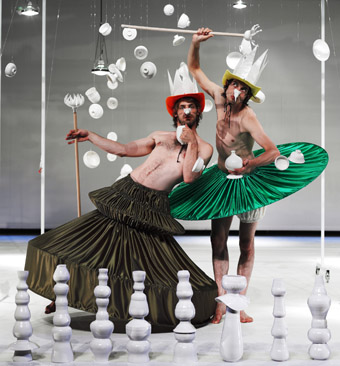
The Porcelain Project, Needcompany
photo Miel Verhasselt
The Porcelain Project, Needcompany
In Grace Ellen Barkey and Needcompany’s The Porcelain Project, a pristine white stage is fronted by a line of mismatched undulating vases. Sturdy structures are dotted about, showcasing the delicate porcelain pieces. A table over-laden with precariously stacked crockery suddenly starts to shake autonomously, the piles clatter and fragments drop heavily to the floor. To the uneasy music of drawn out discords and irregular clicking, a long-haired, bearded dancer creeps into view, bare-chested and white-trousered, with a long white spike of a porcelain nose. He looks at us mischievously and leaps through this porcelain playground, landing on the revolving platform of a circular podium. His nose protrudes through a string-curtain of jagged porcelain scraps, making them tinkle and sing. This jester is joined by a female companion in orange silk breeches and a bikini, the top two pointy porcelain funnels. She sinks onto her back beneath a clothes rail and, as the fool deftly manipulates strings to make a row of bowls dance above her, she arches her back to follow the porcelain wave, marionette-like.
More characters enter this absurd court to cavort around, kings and princesses in luxuriously coloured crinolines and hose, with oversized crowns and grotesquely phallic porcelain appendages. Their balletic elegance sweeps through into overtly sexual gestures, and the decadence of the porcelain seems to fall in on itself amid a strange exoticism, like some sort of disquieting colonial madness. The king orates nonsensically into a microphone, men grapple beneath women’s skirts and everyone is objectified by their porcelain appendages. The dancers continually look to us for approval with a childlike innocence that jolts when juxtaposed with the trembling, unsated eroticism of their dance. Drawn into this chaos, we’re never released from tension, abundance colouring this smooth, white, fantastical world. So what have we been responsible for creating?
Made during the Bush era, Rajni Shah’s durational performance, Dinner with America, is loaded with many images through which we must find our own path. The expansive floor is divided by a bark-chip maze that is gradually rearranged by two handmaidens, forcing us to relocate to new territory out of their way. Shah wears long gloves, a blonde wig and a white dress that stretches out across the floor around her. Her face is waxy white, both ‘beautiful’ and rigidly artificial. She slowly sings “Amazing Grace”, summoning echoes of the Trail of Tears, the Civil War, the evangelical South. She strikes potent gestures—a hand on the hip or a fist in the air—evoking multiple icons, from the Statue of Liberty to Marilyn Monroe. She continues to sing, glamorous, bored, defiant, sexy, poised, hollow, immaculate, and we watch on in solitary worship of this figure that morphs before and within us.
Speakers feed the voices of many Americans into the space; they talk with pride and shame about freedom, opportunity, racism, democracy. Meanwhile, the lights dim and we peer closer. Shah removes her dress and gloves to reveal not white, but brown skin, a sparkly mini-dress, stars-and-stripes platforms. Her postures become extreme, she crouches open-legged, her voice strains and quavers. And later, in a moment of captivating silence, she removes the mini-dress, boots, false eyelashes, wig, and finally the latex mask. She stands naked, small and strong and beautiful in the half-light: a crystal moment of fragile, powerful honesty.
She leaves, returning—casually dressed—with platters of fruit and chocolate, and small envelopes containing questions about cultural identity, America, freedom. The landscape of spirituality, segregation and spectacle transforms into a shared community space for laughter and debate. Perhaps a new perspective is all it takes.
In Gob Squad’s Saving the World, a huge semicircular panorama of seven screens envelops the first few rows of the audience. Three members of the Gob Squad team arrive onscreen, caped and alert, ready to ‘save’ as much of the world as they possibly can, from the 180 degree landscape of the early morning pavement on London’s South Bank. With the help of a magician, a clown, Cupid, the Grim Reaper and lots of silly costumes, rather than setting off on a G20 protest, they instead go about recording the world; committing it to film, banking it as a playful, life-affirming archive of the everyday. As the sun rises over the city, they address us—we’re posited in an unknown future—describing contemporary life in a seemingly improvised free-flow, like eccentric kids’ TV presenters. They run across the promenade pavement, energetically illustrating aspects of modern life: the Thames is an ocean, North of the river—“the land of plenty”, a row of restaurants—Hollywood. As the day progresses they enlist the help of bemused passers-by to explain concepts such as “dancing”, “expectations”, “soul”, “money”. The film is beautifully put together (though not edited, rewound or reshot during the 24 hour filming period), the manic pace broken with close-ups of individual members of the public on each screen.
But it’s hard to fit everything in, and the team argue about what to save. They speak out to their future selves, who sit amongst us in the audience, but things haven’t worked out as well as hoped: no big lottery win, a broken heart better left unmentioned, and a new look that doesn’t suit. The present selves jump back into the film to restart the celebration: the future might not work out so well, but let’s live in the moment, enjoy what we have, and make a circus of the mundane every chance we get.
SPILL 2009: Romeo Castellucci, Inferno, direction, set design, lighting, costumes Romeo Castellucci, music Scott Gibbons, choreography Cindy Van Aker, Romeo Castellucci, set-design collaboration Giacomo Strada, Istvan Zimmermann, Giovanna Amoroso, lighting design Andrea Berselli; Barbican Theatre, April 2-3; Paradiso, conception Romeo Castellucci with Dario Boldrini, Michelangelo Miccolis, set Giacomo Strada, Istvan Zimmermann, Giovanna Amoroso, Barbican Silk Street Theatre, April 2-9; Grace Ellen Barkey and Needcompany, The Porcelain Project, concept Lemm&Barkey, choreography Grace Ellen Barkey, porcelain Lot Lemm, set, costumes Lemm&Barkey; Barbican Silk Street Theatre, April 14-15; Rajni Shah, Dinner with America, performed & created by Lucille Acevedo-Jones, Lucy Cash, Rajni Shah, film Lucy Cash, lighting design Cis O’Boyle; LABAN Theatre, April 6-7; Gob Squad, Saving the World, concept Gob Squad, video Miles Chalcraft, Martin Cooper, sound design Sebastian Bark, Jeff McGrory, costume, props Emma Cattell, Kerstin Honeit, Greenwich Dance Agency, April 9-10; SPILL, London, April 2-26
RealTime issue #91 June-July 2009 pg. 5
© Eleanor Hadley Kershaw; for permission to reproduce apply to realtime@realtimearts.net
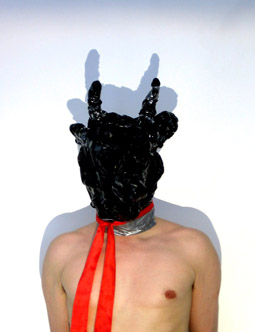
A Forest, Pacitti Company
photo courtesy Pacitti Company
A Forest, Pacitti Company
HERE’S A STORY. NOT A BEDTIME STORY, BUT A STORY TO WAKE YOU UP. THE STORY OF A FLEET OF JET-BLACK RAVENS WHO DIVE BOMB DOWN TO EARTH. KNOCKING OUT THE POWER PLANT OUTSIDE OF TOWN, THEY KEEP COMING, CRASHING THROUGH THE BASEMENTS, THE LIVING ROOMS, THE POLITICIANS’ CORRIDORS AND ALL THE TRAPPINGS OF BOURGEOIS LIFE.
This is one of the dark fairy tales told in Pacitti Company’s A Forest, an intimate performance for a small audience gathered around a gleaming mound of coins. Three performers cohabit the space: Robert Pacitti telling stories from the circle’s periphery; Sheila Ghelani serving as hostess, an intermediary between audience and event; and Richard Eton as the stooge, the fall guy, his body a canvas for Ghelani’s manipulations. She circles the space coyly, offering first her breasts and later a pair of pig’s feet. Eton burrows into the coins, dances to exhaustion and finally becomes a landscape of small trees, affixed with hot wax to the contours of his supine body. Pacitti tells story after story in a carefully modulated tone that is both demure and gleeful, taunting us to join in an indulgence of depravity and refusal. It feels as if the work itself wants to be like that hole in culture, the one blown open by the ravens; it wants to transform the pile of money we are staring at into an empty void, capitalism’s hollow heart. This is a deliberately audacious piece of theatre, and its success depends on each individual audience member choosing to go along with it. But then this is spelled out at the very beginning. Pacitti says, “You have two choices: believe everything is okay, or drown in shit.”
Pacitti is also the founder and curator of the biennial SPILL Festival, now in its second instalment. Just as he intends A Forest to be an interruption within culture, the works he has selected for the festival also feel like irruptions of culture’s dark side. Julia Bardsley’s Aftermaths: A Tear in the Meat of Vision draws an extended and multi-textured analogy between the current crisis of capitalism and ideas of religious rapture and apocalypse. Bardsley appears on a cross-shaped catwalk as part space cowboy, part revivalist preacher, her teeth gleaming with diamonds and a horsehair tail trailing behind her. The audience stands in four inwardly facing sections, divided by the catwalk and surrounded on the outside by large video projections.
Capitalism can be a soft target, especially when it’s already down, but Aftermaths digs below the surface to expose primal fears and desires, a craving for accumulation which hopes desperately to forestall annihilation. “Welcome to the black market”, Bardsley declares, “I will be the eye by which you see the sight of things hidden.” Her visuals and immersive sound experience are striking, and the glossy, black catwalk a powerful theatrical statement. But despite being surrounded on all sides by fleshy, visceral images, and despite the dance-club feeling of the throbbing soundtrack, the experience still feels distant; the piece remains too theatrically self-conscious to be totally immersive. Maybe this makes sense: rather than replacing the spectacle of capitalism with the spectacle of anti-capitalism, Bardsley leaves her viewers questioning, free to choose, as individuals rather than members of a congregation of converts.
In keeping with the festival’s commitment to audience engagement, at its centre was an unprecedented mashup of art, counterculture and politics: the 12-hour, dusk-till-dawn Visions of Excess. This swirling mix of provocations and performances included Bruce Labruce’s troupe of blue-eyed, (fake) blood-drenched, masturbating zombies; Ron Athey’s wig-wearing, (real) blood-soaked self-fisting; Samantha Sweeting’s one-to-one breast-feeding encounter; and host David Hoyle’s sharp-tongued mix of universal bonhomie with strident class and gender militancy. Visions of Excess admirably expands the frame of the art festival and the kinds of work to which it lends legitimacy. But this expanding frame also overlaps with others. An unsettling coincidence was the fact that Visions’ venue (the Shunt arches under London Bridge station) placed it next door to the London Dungeon attraction, with its own less transgressive deployment of blood-soaked zombies. Inside the event, the atmosphere and audience shared much with London’s club scene, bringing its own celebratory sense of community, but also its hierarchies and exclusions. And throughout the evening, I often found myself twice-removed from the events, being unable to directly see what was happening and instead looking through a glowing swarm of digital camera displays. Overall, the event produced a complicated, shifting blend of different forms of community: we were sometimes consumers, sometimes voyeurs, sometimes engulfed within a collective, and sometimes singled out as intimate partners.
For me, the works which were most effective in this context of expanding and overlapping frames were those which attended to their circumstances, creating or commenting upon their own framing. In Zackary Drucker’s interactive performance, crowded onlookers, hungry for spectacle, were twisted into unwitting accomplices. Pushing forward to try to glimpse his reclining, hermaphroditically posed body, we were invited to help ‘perfect’ the image by plucking all the hairs from his body with individual tweezers. And Franko B’s I’m Thinking of You featured first Franko and then a series of volunteers each sitting naked on a gilded swing for an hour. The idyllic, beautifully lit scene was a point of constancy through the evening. Amidst an orgy of complex images, mesmerising, unsettling, innocent and provocative, its simplicity worked its way subtly under the skin.
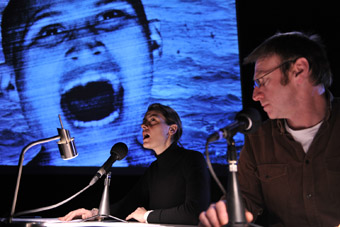
Cathy Naden, Richard Lowdon, Void Story, Forced Entertainment
photo photo Hugo Glendinning
Cathy Naden, Richard Lowdon, Void Story, Forced Entertainment
The festival also saw the premiere of Forced Entertainment’s Void Story, in which the famously risk-taking company try out a radical new direction: narrative. The piece depicts the awful misadventures of a hapless couple who through an endless night are shot, evicted, chased through sewers, knifed at a fun fair and harassed by ghosts. The story is presented through two elements: four seated actors who, as in a radio play, read from visible scripts and manufacture sound effects; and a backdrop of projected black and white illustrations of the narrative. The images are crude photo-collages, filled with glitches and artefacts and the same set of recycled pictures. They are beautiful: stark and deliberately imperfect, obviously handmade, a welcome refusal of the seamless computer-generated characters and landscapes that have become ubiquitous in mediatised culture. In contrast, this is work in which the seams are very much visible, flaunting its status as make-believe.
And yet, despite everything, I start to feel something for these two characters. When one has his leg caught in a bear trap, the sound of breaking bone is only electronic crackling, and the projected image is just a picture of a trap pasted onto a photo of an actor, and the howling actor is not feeling any pain; and yet my stomach turns anyway. This discomfort is part of a wider pleasure, which is the reality of being told a story. It’s like something the narrator says in Tim Etchells’ 2008 novel, The Broken World, which describes an immense and unending computer game. Rejecting those who question the reality of the game, he asks, “Is it reality to be even asking if it’s reality in the first place?…In the end The BW is just a part of reality. It is in the world—a part of the world. That’s all there is to say.”
The final theatre piece of the festival is another Pacitti Company work, Intermission, a mesmerising solo performance by Sheila Ghelani. Ghelani alternates between nine microphones, each labelled with a mode of performance: fact, fiction, high horse, karaoke… The piece appears to set itself up as the chance to tell it like it is, once and for all, on a series of controversial topics: abortion, death, religion, cannibalism. But as Ghelani shifts between topics and modes of address, what emerges is less a strident, coherent manifesto and, more interestingly, a complicated overlap of different voices and contradictory beliefs. As with the storytelling in A Forest or Void Story, as with the theatricality of Aftermaths, and as with the overlapping audiences in Visions of Excess, Intermission foregrounds the fact that there is no place outside culture from which to stage an intervention. Any intervention into the way things are will always be made out of things that already are—readers, actors, witnesses, places—just twisted, made strange, spilling out of their boundaries.
Pacitti Company, A Forest, conceived and directed by Robert Pacitti, co-devised and performed by Richard Eton, Shelia Ghelani, Robert Pacitti, music Sebastian Castagna; The Pit, Barbican Theatre, April 7-9; Pacitti Company, Intermission, made by Robert Pacitti and Sheila Ghelani, performer Sheila Ghelani; Soho Theatre, April 22-24; Julia Bardsley, Aftermaths: A Tear in the Meat of Vision, created and performed by Julia Bardsley, music Andrew Poppy; Laban Centre, April 13-18; Forced Entertainment, Void Story, Soho Theatre, April 21-25; Visions of Excess, curators Ron Athey, Lee Adams; Shunt Vaults, April 12
RealTime issue #91 June-July 2009 pg. 4
© Theron Schmidt; for permission to reproduce apply to realtime@realtimearts.net
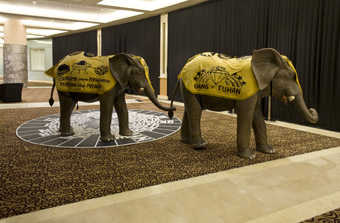
Cari Selamat installation, Eku Nugroho
image courtesy of Jakarta Arts Council
Cari Selamat installation, Eku Nugroho
I’M WELL-DISPOSED TOWARD ANY FESTIVAL THAT LETS FRESH IDEAS SEEP INTO THE STARCHY CONSERVATISM OF NATIONAL INSTITUTIONS. I ALSO HAVE A SOFT SPOT FOR ANY EVENT WHOSE LAUNCH PARTY HAS PEOPLE DANCING WITH THEIR UNDERPANTS ON THE OUTSIDE. THUS I WAS HELPLESSLY INFATUATED BY THE JAKARTA BIENNALE LAUNCH AT THE NATIONAL GALLERY OF INDONESIA. SECONDS AFTER THE DIGNITARIES HAD LEFT, A RAMSHACKLE TRUCK LOADED WITH SPEAKERS WAS BLARING MUSIC FROM THE SIDE COURTYARD, AND A RENT-A-CROWD OF OVERSTIMULATED RAVERS MATERIALISED TO THRUST AND JIGGLE UNDER THE VIDEO PROJECTIONS IN DAY-GLO PLASTIC COSTUMES.
Apparently the genre of hectic Hi-NRG techno on display is called Pantura. It’s a truckstop disco genre, I’m told, with extra glowsticks. As for the thronging crowds sporting pool floaters and coloured goggles, I don’t know where they fit into the biennale picture, nor did I get the overall message of the performance—except that it would supposedly be to my benefit if I shook my “pantat.” Nonetheless I’m convinced that every exhibition launch should have one of these as antidote to launch-speech bombast. And I can’t imagine a launch for any public event here lasting long if it were shy of raucousness.
Jakarta seethes and steams, and frankly, stinks its way into the air of every event that takes place in its messy, corrupt, crowded confines. You can’t for a moment forget where you are, as you fight through traffic to reach the venue, as your accommodation floods, as the toxic traffic pollution settles in a thin, carcinogenic layer on the roof of your mouth. The Jakarta Biennale has a pervasive sense of place that some other cities lack the sloppy public health standards to provide. It’s therefore possibly the only thing that could succeed in such an environment—a messy, ambitious event that revels in, riffs upon and constantly interrogates the intrusive urban morass it calls home. Oh, and did I mention how big the city is? Depending where you draw the boundary, Jakarta contains between seven and 30 million people in continuous urban agglomeration. It’s a whole, inescapable, world.
This year’s biennale, titled Arena, has been much anticipated due to the rogues gallery of cult art scene figures pulling the levers: artistic direction by Ade Darmawan, curators from his notorious Jakarta arts collective Ruang Rupa, and Bandung’s Selasar Sunaryo gallery—a crew that traverses the spectrum between high end commercial gallery society and ratbag media activism. It’s something like an arts A-team. I’m not sure if the festival’s belligerent naming stems from the inevitable themes of art in a city such as this or, perhaps, if it was named in an act of resignation to the combative stances of the curators and artists themselves. Whatever the causal link, the result is a festival that fits its title singularly well: an engaged, aggressive and sometimes clashing tumult.
the fluid zone
Of the three sub-programs, just two are active while I am in town: Zona Pertaraungan/Conflict Zone, and Zona Cair/Fluid Zone. I’m not sure which of those sponsored the gallery rave, but in general they are both less underpants-driven. The launch kicks off a good, though variable, exhibition. The Fluid Zone makes more conventional use of gallery space. Most prominently, Jompet’s elaborate, grandiloquent installation keeps me captivated for a good half hour. He has filled an entire hall with ranks of a robotically animated historical Indonesian army band, complete with drums, playing an eldritch military tattoo intercut with multiple channels of video on miscellaneous screens, depicting the artist recreating the ancient Javanese dances of dedication performed amongst the machines at an old Dutch sugar refinery. The proud and problematic icons of Javanese culture reinvented as empty poltergeists reads to me like an essay in the revisionist cultural iconography implicated in the ANZAC legend but here with a different kind of colonial angst.
Around the main hall I’m grabbed by the emergent theme of reappropriation of mundane objects: Tintin Wulia (Denpasar/Melbourne) has created a muted rainbow of forged passports. Roslisham Ismail (“Ise” to those who caught his residency at Sydney’s Artspace) has collaged loanshark handbills into a lurid wall banner spelling out NEP, the euphemistic acronym of the Malaysian affirmative action economic regime. The most eyeball-searing work in the category is David Grigg’s photo documentary of Philippine slum gang tattoos. I can’t tell if I like its inarticulate bloodiness, but I can’t look away, which amounts to the same thing.
And the show goes on, a rush-hour pile-up of works in this crossroads of southeast Asia. The Fluid Zone has the lion’s share of international artists, with attendees from across Australia and ASEA. This regional focus, we are told by curator Agung Hujatnikajennong, is less an attempt to leap into the globalised biennale circuit than a logical outgrowth of Jakarta’s cosmopolitan history. He presents the event as something of an exchange between neighbouring peers as opposed to, I suppose, marketing for the entrenched oligarchs of a global art market to which Indonesia is peripheral. It’s as much noble sentiment as it is a great way to save on airfares.
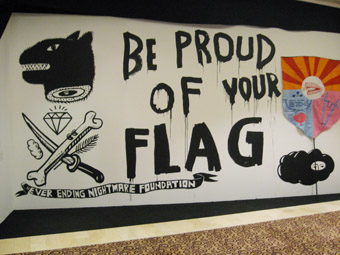
Zinester Flag, Eku Nugroho
photo Dan Mackinlay
Zinester Flag, Eku Nugroho
the conflict zone
Across the gallery courtyard from the slick internationalism of the Fluid Zone, is the gallery component of Zona Pertarungan/Conflict Zone. This program is curated by Ardi Yunanto, editor of the bilinigual Indonesian contemporary art magazine Karbon. At Ruang Rupa, Ardi has also managed the Jakarta 32ºC program of urban interventions. Sydneysiders may recall him presenting a retrospective of that project at the recent Sydney Biennale event, Constellations 3: Extra/Ordinary Cities: The Cultural Dynamics of Urban Intervention. It’s clearly a core passion for him—urban intervention is everywhere in the program Ardi has assembled. And where the Fluid Zone is regional, Zona Pertarungan is consciously parochial, and relentlessly political.
This program is also more physically dispersed, colonising an exhausting inventory of public sites across the city. Works are anything from murals to subverted advertising on billboards, to outright illegal fake street signage. The gallery show, then, is less the works themselves than a convenient digest of pieces scattered throughout the city for those too lazy to sift through the chaos of Jakarta slums trying to pick out which bits might be art. However the show’s role is not solely documentary—some works are too ephemeral to find, such as the Carterpaper collective’s hilarious culture jams, and some are entirely imaginary, such as Ari Dina Krestyawan’s attempt to insert surreal stream-of-consciousness “public announcements” into the LED displays above the city’s main road. That latter work exists only as a composited video, not the only work whose installation was cancelled in last-minute failures in negotiations with the sign’s owners.
As heated as the debate about Australia’s diminishing supply of art spaces can get, Jakarta’s space is so constrained in comparison that it seems a cautionary fable. Every inch of streetscape is the subject of multiple conflicting regimes of ownership, corrupt regulation, protection rackets, and so on. Curator Ardi recounted the story of a large mural of chess pieces on the pylons of a freeway flyover. The work, by designers Saleh Husein and Kudaponi is a painted tribute to the impromptu chess playing tables that set up in the shade. Between the council fees, the bribes and outright protection rackets the cost of keeping it there is comparable to renting commercial billboard space. The chess mural treads a little close to faux-folksy celebration of the poor by richer artists for my taste, although Ardi is quick to itemise the exhaustive community consultations that the artists had gone into spanning months—not to mention an ignominious defeat in a chess tournament for the artists.
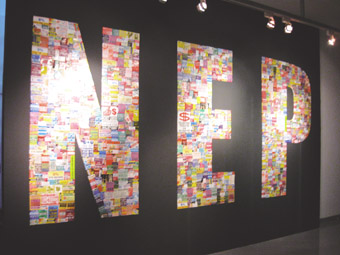
NEP, 2009, Roslisham Ismail aka Ise
photo Dan Mackinlay
NEP, 2009, Roslisham Ismail aka Ise
in the malls
When the Fluid Zone program escapes the national gallery it is not to the streets, but to the shopping malls. Most prominent is Indonesia’s richest, the Grand Indonesia Shopping Town, which is a Biennale sponsor and has artworks nestled between their Gucci outlet and their Moulin Rouge-themed foodhall. The show here is not light on politics nor social critique, both implicit and blatant. On the former side, Australia’s Craig Walsh has installed the latest in his series //Incursions//, where a video projection conjures an apparent flood destroying the contents of the shopfront. It’s strangely effective here, in this city of flash floods and broken plumbing, compared to regulated, risk-assessed Australia.
Other works are on the didactically anti-consumerist side. Manila-based Poklong Anading’s work “caskets” is a climbing wall up the sides of the mall atrium, whose holds are resin casts of consumer ephemera. It’s a defiantly ugly, uncollectable work that seems strangely at home amidst the cacophony of advertising that is the mall. Eko Nugroho delivers his photocopy-based, polemical zine aesthetic with a brash critique of the corruption of politics and religion told through the medium of giant model elephants and graffiti robots. The quieter satire of Wiyoga Muhardranto’s erogenous shopping bag sculptures, with their breasts and voluptuous curves, mocks the empty seduction of advertising, even as they themselves function as exquisite, and exquisitely acquirable objects of consumption.
This last work crystallises a contradiction in the biennale progam. It’s not just that, between the commercial festival sponsor branding and Indonesian mall-kitsch backdrops it’s hard to pick the faint critical signals from the noise of shopping. Agung argues it’s a pragmatic necessity if the biennale is to be relevant. Jakarta has no public space, as Ardi has discovered, and if one does wish to be engaged with a middle class public and not just the poor, where else should the work be hung? Fot me, it’s a rude shock—in Australia, I explain, we demurely conceal this conflict with a polite separation between the consumerism of the art market and the romantic purity of the artist.
between conflict & fluidity
The problem that perturbs me more is the distinction in venues and media, and subject matter, between the Conflict and Fluid Zones. If it’s a concession to the necessities of engaging with diverse audiences then it seems unfortunate to sequester the subject matter and the audiences, leaving the urban elites to dally in sophisticated self-critique and the poor to celebrate their tribulations in best-practice community development projects.
On the other hand, I also wonder where else I could find a festival that is so thorough in its attempt to engage with a whole city, from the wealthiest to the poorest, all on their own terms. It’s a vindication of the biennale’s boldness that I can even make these criticisms, that I may muse on the small failings in presentation of a director and curators who have so thoroughly engaged with their city. This biennale has been one of the most thought-provoking events I have witnessed, a bold dive into the the details of a city that seems larger than my entire country. I’m coming back.
Jakarta Biennale, Arena, 2009, artistic director Ade Darmawan, Jakarta, Feb 6-27, www.jakartabiennale.com
RealTime issue #91 June-July 2009 pg. 8-9
© Dan MacKinlay; for permission to reproduce apply to realtime@realtimearts.net
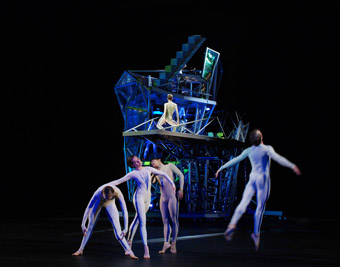
Nearly Ninety, Merce Cunningham Dance Company
photo Anna Finke
Nearly Ninety, Merce Cunningham Dance Company
MERCE CUNNINGHAM TURNED 90 ON THURSDAY. THAT DAY, I AM AT THE NEW MUSEUM ON THE LOWER EAST SIDE AT AN EXHIBITION TITLED THE GENERATIONAL: YOUNGER THAN JESUS, A JAM-PACKED SURVEY OF 50 ARTISTS UNDER THE AGE OF 33, WHICH “(DRAWS) FROM THE BELIEF THAT SOME OF THE MOST ENDURING GESTURES IN ART HAVE BEEN CARRIED OUT BY ARTISTS EARLY IN THEIR CAREERS.” AS THOUGH AGE HAS SUDDENLY BECOME A DEFINING FACTOR, ACROSS TOWN AT BAM IS THE PREMIERE OF CUNNINGHAM’S NEW WORK, NEARLY NINETY, WITH MUSIC BY SONIC YOUTH, JOHN PAUL JONES AND TAKEHISA KOSUGI, UNDER THE SEASON’S TITLE OF MERCE CUNNINGHAM AT 90.
Cunningham was 25 when he presented his first solo show. He was 34 when he formed his company with John Cage, and set about ridding modern dance of expressionism, narrative, cause and effect and most particularly, its dependence on music. His intention was, and still is, that dance itself should be the subject of dance. To serve his ideas, he formed a movement vocabulary that in turn became a technique, which is where I first encountered him at 16 in a church hall on Friday nights. (Coincidentally I was first listening to Sonic Youth about the same time.)
Despite writing an abundance of essays on his influence on dance while at university, Nearly Ninety was the first work of Cunningham’s that I have had the opportunity to see live, and I was both excited and slightly apprehensive that I would find it outmoded, particularly with all those unitards.
The stage is filled with dancers warming up, stretching and rehearsing phrases. I get a thrill watching this casual run through. Here they are: the stag jumps, the triplets, the jolting moves into the air that come from nowhere and evaporate just as quickly. The precision of the dancers is evident, even in tracksuits.
The first part of Nearly Ninety has the dancers performing downstage in front of a screen, serving for both video projections and as an opaque division for a metal tower behind, part Tower of Babel, but mostly Dr Who Tardis, inside which the musicians play on three levels. The dancers begin in duets, supporting and moving into one another with an attitude that suggests the partnering is coincidental, and just as easily move away from each other. From my position, up high, I am reminded of science videos of cells free floating, attaching and separating. They are wearing unitards, complete with gloved hands on one side, with patterned angles of black and white. On the white side, there is the clear ripple of muscle: the muscular effort involved in executing this Cunningham vocabulary.
It is hard work, all this theory. The independence of each dancer, the independence of each move that enforces an almost clinical clarity, calls for an intense virtuosity, but not the kind that shows itself off in a flinging abandon or finds a release. This is constricted, solid, intellectual. I feel my own muscles tightening in empathy.
The dancers are constantly on and off stage, and always within the dance as they enter and exit. There are moments of almost extreme slow motion, punctuated by flickers of speed, each dancer with their own timing and phrasing. Legs arc out and bodies lean, creating protractor-like measurement of angles between body and floor, between limbs, and space between bodies. There is no movement outside the Cunningham lexicon, nothing pedestrian which, knowing my dance history, shouldn’t be a surprise, but is.
In the second half, the screen disappears, and the tower behind is turned so that the musicians become more visible, a larger part of the visual texture. The movement now is faster with more of the company on stage for more of the time. The overall feel is fluid, though individual movements are just as staccato and autonomous. There are brief moments of silence where the dancers’ footfalls and jumps are audible, but mostly the music score takes its turn in precise intervals between Kosugi, Jones and Sonic Youth: ambient, static-y or swirling.
I enjoy watching this dance. I enjoy thinking through again what a great innovator Merce Cunningham was, evident here within his movement. I am almost moved to tears seeing him in his wheelchair for the curtain call, dressed in a soft velvet suit.
Yet this performance occupies a strange place. It is incredible to see this technique, these dancers live, in the here and now. But it also has a certain museum quality—the innovative phase of the choreography has passed. Placed against what the New York Times calls the “trendy” elements (the music, the tower, the video projections), I find the work jarring. I cannot put Kim Gordon, in heels, playing her guitar with her super cool stance together with these unitard-clad dancers in front of her. This is partly because Sonic Youth’s music sprawls, spirals and builds towards a climax in a most un-Cunningham-like way, but also because choreographer and musicians seem from different eras.
This is, of course, most likely the point—to reframe the dance continually, to allow it to be constantly re-seen, and though one might argue that Cunningham did make his ‘enduring gesture’ early in his career, it still certainly endures. It’s like a live mash-up, not too dissimilar from the sampling of random elements of the much younger ‘digital natives’ over at the New Museum.
Merce Cunningham Dance Company, Nearly Ninety, choreographer Merce Cunningham, music composed & performed by John Paul Jones, Takehisa Kosugi, and Sonic Youth (Kim Gordon, Thurston Moore, Lee Ranaldo, Steve Shelley), decor Benedetta Tagliabue, costumes Romeo Gigli, lighting Brian MacDevitt, video design Franc Aleu; BAM, Howard Gilman Opera House, April 16-19
RealTime issue #91 June-July 2009 pg. 10
© Jane McKernan; for permission to reproduce apply to realtime@realtimearts.net
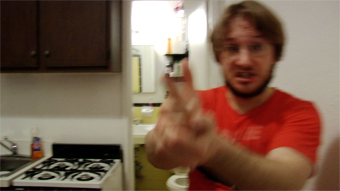
Zachary Oberzan, Rambo Solo, Nature Theater of Oklahoma
photo Peter Nigrini
Zachary Oberzan, Rambo Solo, Nature Theater of Oklahoma
UPFRONT I WILL ADMIT TWO THINGS. ONE: I HAVE NEVER SEEN THE FILM RAMBO. TWO: I AM UNABASHEDLY A FAN OF THE NATURE THEATER OF OKLAHOMA, HAVING SEEN THEIR PRODUCTION NO DICE (RT89, P6) AT THE SYDNEY FESTIVAL IN JANUARY THIS YEAR.
So in some ways I come full of expectations, and in other ways with none at all. Rambo Solo is, as the title suggests, a solo show performed by Zachary Oberzan, conceived and directed by Pavel Liska and Kelly Copper, the directors of Nature Theater, in conversation with Oberzan. To describe the show is possibly to undermine the brilliance of its simplicity, but I will because, like good conceptual theatre, the stating of the idea goes nowhere near the experience of it. It is simply this: we the audience are invited individually into the theatre by Oberzan, who, wearing a dressing gown and ugg boot style slippers, leads us to a cushion on the carpeted floor.
When we are all seated, and he has changed into track pants and an old red T-shirt bearing the words “Putting the Man into Romance”, he ascends the stage, which is more like a sideways gangplank across the room, and the show begins. Behind him hangs a white sheet onto which are projected a triptych of video versions of Oberzan in his tiny New York apartment. All four Oberzans, though we only hear the live one, begin to narrate the story of Rambo or more correctly the plot of the novel, First Blood by David Morrell, on which the movie version of Rambo was based. This continues, following various sub-plots, right through to the bloody end.
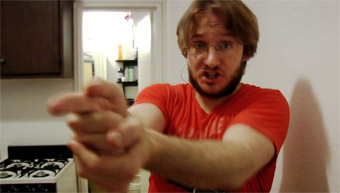
Zachary Oberzan, Rambo Solo, Nature Theater of Oklahoma
photo Peter Nigrini
Zachary Oberzan, Rambo Solo, Nature Theater of Oklahoma
The video Oberzans, with various stages of facial hair growth, utilise locations within the apartment to flesh out the story. The bath serves as both a prisoner of war camp and cell; the loft bed, the top of a sheer cliff; a standard lamp next to a chair with the cord draped over his arm, a hospital. The live Oberzan gives us the story without props or set, except for a large bag of M&M’s, a bottle of water, a belt, and later a large Rambo style knife. He mirrors the actions of the video versions of himself, including some fairly feeble martial arts moves whenever he mentions that Rambo is a “green beret” or, more often, “fucking bad ass.”
To anyone who has suffered through a friend’s retelling of the plot of a novel or film in far too much detail—much like listening to the narrating of someone else’s dream—this might sound like an arduous night in the theatre. It is, however, quite the reverse.
As in No Dice, Rambo Solo uses the repetition of a recorded conversation, with all Oberzans wearing iPods. However this time, the only part of the conversation we hear is what we presume to be Oberzan’s, though it mostly takes the form of a monologue and there are recurring moments when Oberzan is silent, or ends his sentences with a question as though asking for confirmation that he is right. At the beginning he asks how much he should describe, “like as though you don’t know the plot?”, to which there is no audible answer. But towards the end of the show, when he asks “Hello?” as if to check he is still being listened to, the audience on the night I was there were so sucked in that they felt compelled to answer out loud, “Yes!”
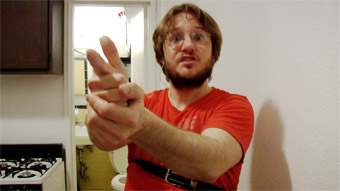
Zachary Oberzan, Rambo Solo, Nature Theater of Oklahoma
photo Peter Nigrini
Zachary Oberzan, Rambo Solo, Nature Theater of Oklahoma
The use of the video versions of Oberzan, filmed repetitions of him retelling the story, and the repeated iPod material, emphasise the plain storytelling nature of the piece but also undo notions of any stable reading. Equally, Oberzan’s particular delivery, more naturalistic than No Dice’s hyperbole, but similarly stilted, made me question whether he was doing a Stallone impersonation or that was his actual speaking voice. At one point, when talking about the film version of Rambo, he says, “I don’t know about acting anymore”, I too feel I don’t know about acting an more. Is he acting? Is he enacting himself—a man who has an unreal obsession with a trash novel, and a slightly frightening attitude to weapons and self-protection—or is this a knowing characterisation?
The line between authenticity and pretence keeps shifting, particularly when we learn that the trailer for a film, Flooding With Love For The Kid (Oberzan’s own adaptation for screen from the novel), shown at the end, is advertising a real film that Oberzan has made (in which he plays all the characters) and is selling in the foyer.
In one part of Rambo Solo, Oberzan calls First Blood his Hamlet. I feel like Nature Theater are my Shakespeare with their ability to find the poetic within the most everyday subject matter, to talk about theatre at the same time as making it, and to be so entertaining and funny in that faux amateur performance style, yet somehow tingeing it all with a sense of melancholy and despair. They are themselves, as Oberzan would say, “Fuckin Bad Ass.”
Nature Theater of Oklahoma, Rambo Solo, concept & direction Pavol Liska & Kelly Copper in conversation with performer Zachary Oberzan, design & video Peter Nigrini; Soho Rep, March 19-April 19
RealTime issue #91 June-July 2009 pg. 12
© Jane McKernan; for permission to reproduce apply to realtime@realtimearts.net
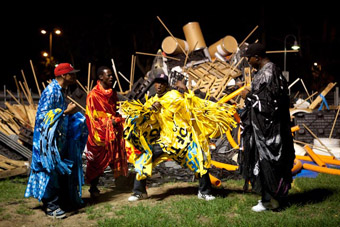
Darrio aka Manifest, Kon aka J.Manifest, Yasim aka J.Krucial, Omar aka Scrappy, ACTIVATE 2750, Ash Keating
photo Alex Kershaw
Darrio aka Manifest, Kon aka J.Manifest, Yasim aka J.Krucial, Omar aka Scrappy, ACTIVATE 2750, Ash Keating
samson & delilah wins camera d’or
Warwick Thorton’s Samson & Delilah, featured on the cover and in interview and review in RealTime 90 (pp 23, 24), has won the Camera d’Or at the 2009 Cannes Film Festival for Best Debut Feature Film. The film was programmed in the Official Selection and shown in Un Certain Regard—a category for “films that express a personal vision, with an emphasis on special cultural expression and cinematic innovation.” The film is currently screening in Australian cinemas and will be shown later this year on ABC TV.
kronos quartet plays jon rose
The American string quartet, Kronos, have collaborated with Australian violinist and composer Jon Rose (RT90, p48) on Music From 4 Fences, a work commissioned by the Sydney Opera House and premiered June 5. Rose has played fences around the world for decades and, more recently, with partner Hollis Taylor has sounded them across Australia (as documented in Taylor’s book, RT82, p40). After hearing Rose’s Rabbit-Proof Fence, Kronos leader David Harrington came to Sydney to meet the composer. A work for barbed wire fence (with its connotations of brutal containment of land, animals and humans) is the result.
heart library: st vincent’s hospital
George Khut researches the use of biofeedback “for re-imagining how we think of, and experience ourselves in relation to our bodies.” After its successful showing at Campbelltown Arts Centre as part of the 2008 Mirror States media arts exhibition, Khut’s The Heart Library Project will make its first appearance in a hospital, Sydney’s St Vincent’s, where it will be open to patients, staff and the public. In 2008, Keith Gallasch wrote, “The Heart Library goes much further [than previous Khut works] in transforming states of being into artistic mirrorings and with greater audience-as-co-maker participation. The visitor retires to a gently darkened space, stretches out on a cushioned platform, holds a sensor in each hand and encounters themself, life-sized, on a screen above. The pace of the heartbeat yields a flow of snow or blossom-like drift over the body and changes in colour and sound. For some participants the variation is subtle, for others relatively dramatic in intensity. On leaving the space, you enter another hung with full-scale drawings by other participants reflecting what they’d just experienced. A number are distinctive artworks and all are revealing about where people see their bodies, centred or off-balance, wounded, anxious or enjoyed” (RT87, p34).
As part of this Australia Council supported research project and in collaboration with dLux Media Arts, Khut reports that “he will also be collaborating with clinical psychologist Steven Albert and youth arts-health worker Emma Watkins of Urban Arts Base to explore the potential of this work as a vehicle for promoting mental health awareness to young people negotiating issues such as anxiety, panic attacks and depression.” The Heart Library Project at St Vincent’s, An Interactive Art Project by George Khut, Level 4, Xavier Ward, St. Vincent’s Public Hospital, Darlinghurst, Sydney, July 6-19, www.georgekhut.com
emerge festival
Multicultural Arts Victoria’s Emerge Festival will be a potent reminder, and news for many, of the dramatically changing Australian multicultural landscape, not least with its large contribution from immigrant African artists. Emerge is a celebration of Victoria’s many undiscovered refugee cultures and includes a much warranted focus on the plight of the Burmese people. The festival commemorates the United Nations World Refugee Day and celebrates Refugee Week in Australia with a series of concerts and events around Melbourne, June 16-July 26.
The festival commences with a five-hour Fitzroy Town Hall concert featuring many African artists alongside Australian Indigenous and Maori performers. The town hall event includes an Ethiopian coffee ceremony, a wide range of cuisines, workshops in and displays of Pacific Island body percussion, African drumming, belly dancing, henna tattooing, hairbraiding and concert performances from African communities from across the continent: Guinea, Sierra Leone, Burundi, Sudan, Ethiopia, Tanzania, Congo, Zimbabwe and Ethiopia. Other events in Emerge embrace cultures from Afghanistan and India to Turkey and Japan. www.multiculturalarts.com.au/events2009/emerge.shtml
it’s a jungle out there
Martin del Amo sees the city as a rich source of choreographic material. His new work will premiere at Campbelltown Art Centre, June 24-27. Titled It’s a jungle out there, it will “physicalise Sydney’s labyrinthine, many-faceted nature, distilling the complexity of the urban experience into a multi-layered performative fabric made of dance, story telling and electronic sound design.”
www.campbelltown.nsw.gov.au
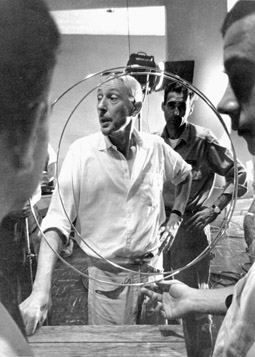
Len Lye on the set of Fountain of Hope, 1959
image courtesy Len Lye Foundation
Len Lye on the set of Fountain of Hope, 1959
len lye retrospective, acmi
For lovers of experimental cinema who live outside of Melbourne, it’s time to invest in a bargain airfare and head to the Australian Centre for the Moving Image for a remarkable world premiere, a major retrospective of the work of Len Lye. One of the great, innovative artists of the cinema, New Zealander and cosmopole, experimental filmmaker, poet, painter, kinetic sculptor and theorist Len Lye (1901-1980), is being celebrated at ACMI in collaboration with the Govett-Brewster Art Gallery (New Plymouth, NZ). As well as major creations, the retrospective will include, says ACMI, “art works and materials never exhibited before—ranging from early sketches, paintings and batiks, through to his photographic work, animation and documentary films, and extraordinary motorised kinetic sculptures.” Lye worked in New Zealand, Sydney, Samoa, London (where her exhibited paintings in the 1936 International Surrealist Exhibition) and moved to New York in the 1950s. He pioneered the still hugely influential technique of ‘direct filmmaking’—painting, drawing, animating and stenciling directly onto celluloid. In RealTime 92 (Aug-Sept), Brisbane co-director of the Otherfilm Film Festival, Danni Zuvela, will review the exhibition and interview its ACMI co-curator Alessio Cavallaro (working with Tyler Cann, Curator of the Len Lye Collection and Archives). Len Lye—An Artist in Perpetual Motion, ACMI Screen Gallery, admission free, ACMI, Federation Square, Melbourne, July 16-Oct 11, www.acmi.net.au
ash keating’s activate 2750
Images from Melbourne artist Ash Keating’s ACTIVATE 2750, a work created earlier this year as a C3West project in Penrith, 50 km west of Sydney, postcode 2750, in association with SITA Environmental Solutions, will be shown at Breenspace in Sydney in June-July. Keating was invited by the MCA as part of C3west (with Penrith Performing & Visual Arts; Campbelltown Arts Centre and Casula Powerhouse) to work with SITA to create a new work. Keating decided to engage with key public places and “areas of consumption” in the city. As he reports in his blog, “It would involve me physically intercepting and manipulating material waste destined for burial at the SITA landfill in Kemps Creek. Activate 2750 would be the culmination of a series of waste interventions I had actioned over the course of a year starting with 2020? in May 2008, followed by Label Land in August, working in Korea on an Asialink residency with ten first year art students intercepting fabric label waste and manipulating it into costumes which we later paraded around Seoul in a series of public actions.”
Since 2002, Keating had worked for his late mother’s waste audit and consultancy company, travelling “Australia wide, as a visual auditor assessing the amount of commercial and industrial waste sent to landfill. This experience opened my eyes to the disregard that industry in general has for sustainability…” Keating salvaged 52 square metres of waste material to create “an apocalyptic zoological habitat. As well, shopping trolleys were manipulated into eccentric movable waste machines by the local artists and art students who were all encouraged to…push them, in a series of performative processions” along the highway, the city’s shopping strip and into Westfield Plaza. “Another part of Activate 2750 involved dance performances by Darrio Phillips and his Krumping students.” Activate 2750, writes Keating, “highlighted the disposal of commercial and industrial waste, by redirecting it into the public realm.” Ash Keating, ACTIVATE 2750, Breenspace, Sydney, www.breenspace.com; http://activate-2750.blogspot.com
realtiming
RealTime staff have been busier than usual in 2009 with the publication of Experimental Music: Audio Explorations in Australia (UNSW Press), edited by Gail Priest, who was also one of the participating artists in a recent Artspace show, Between Site and Space, that came out of a 2008 residency with Tokyo Wonder Site. Priest has been working on the sound design for Karen Therese’s performance work, Riot Act, which has premiered at Campbelltown Arts Centre, and Martin del Amo’s It’s a jungle out there, at the same venue. Keith Gallasch and Virginia Baxter led a reviewing team at Dance Massive in Melbourne in March and, in May, travelled to Adelaide for Artlink’s symposium, Changing Climates, on the future of arts magazines (Artlink will be placing the papers online). In April, Keith ran a review-writing workshop in Cairns as part of the Induce program for artists, and will return in July for more workshopping at the On Edge Festival. He recently returned from Korea where he was guest of the Chuncheon International Mime Festival (see RT92 for a report on this distinctive event).
RealTime issue #91 June-July 2009 pg. 13
© RealTime ; for permission to reproduce apply to realtime@realtimearts.net
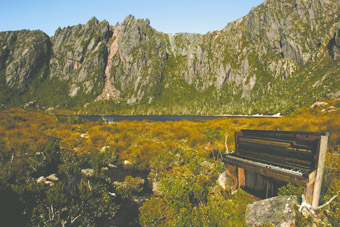
Ross Bolleter’s Ruined Pianos
photo Peter Whyte-Roar Film
Ross Bolleter’s Ruined Pianos
ONE OF THE TRADITIONS OF TEN DAYS ON THE ISLAND SEEMS TO BE TO PRESENT AN ASTONISHING THEATRICAL SPECTACLE RICH IN GRANDEUR AND VISIONARY SCOPE. TWO YEARS AGO, WE GOT DREAM MASONS, AN OUTDOOR SHOW THAT WAS HUGE IN SCOPE AND VISION, AND AN AWFUL LOT OF PEOPLE SAW IT. I THOUGHT IT WAS BREATHTAKING, BUT IT ALSO HAD A FEW PROBLEMS. METAMORPHOSIS WAS FASCINATINGLY SIMILAR—AMAZING THEATRE, YET SOMETHING NOT QUITE RIGHT. IT WAS ALMOST TOO AMAZING.
Metamorphosis, a collaboration between Theatre Vesturport of Iceland and David Farr’s Lyric Theatre of Hammersmith, is an interpretation of Franz Kafka’s The Metamorphosis. Gregor Samsa awakens one day to find himself transformed into something hideous, something not human. His family are terrified and disgusted by his new state. His sister tries to communicate but, in the end, she cannot and Gregor dies alone.
The incredible, two storey set for this work must be one of the most lavish I’ve encountered, so finely tuned that every tiny detail glowed. On the second floor, we saw Gregor’s room as if looking down into it—this clash with the normal perspective downstairs produced vertigo and discordance. The Nick Cave-Warren Ellis soundtrack added richness, yet even more incredible was the feat of athleticism accomplished by Gísli Örn Gardarsson in his performance as Gregor. He scuttled about, even hanging from the ceiling, totally in control of his physicality and his realisation of Gregor. The rest of the cast gave stylised, almost robotic performances that contrasted strongly with the humanity exuded by Gardarsson, asking us, who is human.
It was all too easy to pick sides here though, as what we could see was actually an athlete who could elicit compassion from an audience while hanging upside down five metres in the air. He was too easy to like, and the family too easy to judge. Or was it that spectacle itself disallowed the complexity I craved?
When I saw the Auckland Theatre Company’s Hatch, everything that had left me uneasy about Metamorphosis was thrown into sharp relief. Hatch is the real tale of Joseph Hatch, who made a fortune boiling down thousands of penguins for their oil on Macquarie Island. Nasty. The idea of exploring the history of a repugnant capitalist and environmental vandal supreme is a peculiar one. The man is unlikeable, yet such was the craft of this performance that I was seduced.
Historically, Hatch had pleaded his case to the public after his licence to operate was revoked. The show is a recreation of the lectures he gave in Hobart. But this is a lot more than historical recreation; the show presents us with a clash of ideologies embodied in the ultimately tragic story of an intriguing character. Hatch gave us his point of view for an hour: he spoke of industry, civilisation and progress. He spoke of hard work, tackling the elements, economic vision and daring—and it was fascinating. The man’s life, his epic migrations, his contribution to the history of Australia, New Zealand and Tasmania were gripping theatre. I’d never known of him, but here was a life that encountered historical giants such as HG Wells, Sir Douglas Mawson and Baron Rothschild as opponents during the movement against his slaughter of penguins.This was very probably the world’s first pro-environmental campaign.
Stuart Devenie is a masterful actor, bringing Joseph Hatch to robust life, and even making him likeable. For an arch capitalist, a murderer of thousands of beautiful wild birds he comes across as charismatic and funny. The ambiguity is palpable and discomforting. I was amused and challenged by this show, as well as being impressed by how effectively one man and a slide projector can hold an audience. Especially poignant was the chime of the Hobart GPO clock marking time; sheer coincidence and yet Devenie worked the chimes into the performance. When the clock finally struck seven, Hatch wordlessly stared out the City Hall window, open mouthed, maybe afraid. His time was up. The theatrical power of this small, perfect moment was memorable, but so was everything about this admirably tight show.
I can’t truly say that Hatch was a better show than Metamorphosis, that isn’t the point. This isn’t some contest of theatrical styles, but I did wonder if populist spectacle is the answer to our needs. I was glad to see Ten Days catering for all comers in the end.
Ross Bolleter’s Ruined exhibition at the Bond Store of the Tasmanian Art Gallery & Museum offered a glimpse into the extraordinarily creative and unique mind of one of Australia’s most vital—what? What is Bolleter exactly? This isn’t an easy question, for although he is certainly a gifted musician, he is also an historian and a curator. He collects ruined pianos—pianos that have been left to the mercy of the elements, stored on their sides in sheds and covered in tools, gone mouldy and had possums draw their last breath and rot in them.
Bolleter plays the pianos, talks about them and presents each one’s story. His investigations into the sound made by ruined pianos requires a precise sensitivity to history, as well as a very refined understanding of the potential for sound to convey meaning. When one considers the importance of the piano as a centrepiece to the colonial household, which Bolleter drove home in his enlightening and informative lectures, one begins to grasp the sheer scale of his project—investigating colonialism and its residue by concentrating on a particular object. Bolleter plays ruined pianos with a great deal of respect for “what the piano offers”, and this would appear to be the resonance of history itself. There are no wrong notes; there is only the presence of time and the impact of place.
Much is implied by the simple tale of how a piano got to be left in the bush, how it was taken up river, who it was played by and every other tiny detail that has affected the sound that Bolleter coaxed from it, even if there was nothing but a rusty frame to be tapped and plucked. In doing so, he is pointing to our nation’s past and in this fractured, yet totally and deeply considered music, lies Australia’s colonial history: its triumphs and its shame. This is a powerful and moving project, clearly years in the making. Ross Bolleter is a unique artist with an engrossing vision.
I liked a lot about Ten Days on the Island this year, but Ross Bolleter’s Ruined stood out as unique, truly engaged with the people (of the towns of Stanley, Derby and Ross) and with the history of Tasmania.
Theatre Vesturport and Lyric Hammersmith, Metamorphosis, adapted & directed by David Farr and Gísli Örn Gardarsson, performers Nína Dögg Filippusdóttir, Ingvar E Sigurdsson, Kelly Hunter, Jonathan McGuiness, Gísli Örn Gardarsson, music Nick Cave, Warren Ellis, design Börkur Jónsson, costume Brenda Murphy, lighting Hartley TA Kemp, sound Nick Manning; Theatre Royal, March 27-April 1; Auckland Theatre Company, Hatch, writer Geoff Chapple, director Colin McColl, performer Stuart Devenie, design Denise Hosty, Tony Rabbit; Hobart Town Hall, March 27-30; Ruined, exhibition curation and demonstrations by Ross Bolleter, The Bond Store, Tasmanian Art Gallery & Museum, March 27-May 5; Ten Days on the Island, Hobart, March 26-April 24
RealTime issue #91 June-July 2009 pg. 14
© Andrew Harper; for permission to reproduce apply to realtime@realtimearts.net
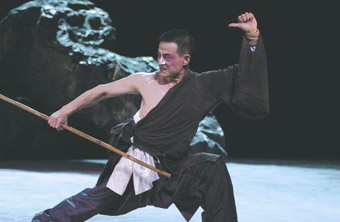
Wu Hsing-kuo, Lear, Legend Theatre
courtesy of the artist
Wu Hsing-kuo, Lear, Legend Theatre
TO A CHAOTIC, CLASHING MUSICAL JANGLING, WU HSING-KUO ENTERS THE STAGE DRESSED IN A FLAMBOYANT CHINESE SILK ROBE DECORATED WITH RED FLAMES. HE JERKS AND ROCKS BACK AND FORTH ON HIS CURVED-SOLED PLATFORM BOOTS, FLINGING HIS MANE OF WILD HAIR AND FANNING A WAIST-LONG WHITE BEARD IN A COMIC DEMONSTRATION OF UNSTEADY, UNDIGNIFIED OLD AGE. ABOVE THE STAGE THE ILLUMINATED SUBTITLES READ: “ACT I: THE PLAY (KING LEAR).”
The chronology has been compressed. Lear is already on the heath, at the climax of his insanity triggered by his betrayal by daughters Goneril and Regan, and his regret at disowning Cordelia. One moment, enraged by his loss of respect, he yells: “Dost thou know me?” The next, however he plays peek-a-boo behind his sleeves, humorously embodying Goneril’s “old fools are babes again.”
In the tradition of Beijing Opera, the monologues in Contemporary Legend Theatre’s one-man production are spoken and sung in Mandarin. Little of the original play’s script is replicated verbatim and the audacious decision to rewrite Shakespearian dialogue demonstrates the confidence and creativity of this Taiwanese company, which aims to reinvigorate traditional art forms by recontextualising classic stories and producing genuinely intercultural productions.
There’s a surprisingly postmodern moment when Lear removes his wig and beard revealing Hsing-kuo underneath. “You’re not Lear!”, he tells these props, implicating himself—the actor who plays no less than eight characters in this performance—in this struggle for identity. Self-strangulation submerges Hsing-kuo’s personality and with a minor costume alteration he is transformed into the virtuous nobleman, Kent. Now he speaks of himself as Lear’s “shadow” and “storyteller.” Thus the brilliant weaving of metaphor and double meaning continues.
In Act Two, “The Playing (Fool)”, Hsing-kuo is a consummate jester, amusing us with a fast-paced mixture of physical comedy, linguistic riddles and irreverent impersonation. He sarcastically replays the situation that lead to the king’s demise, where daughters Goneril, Regan and Cordelia must declare they love their father best to get a cut of his kingdom. We know that Regan’s proclamation is a pernicious lie when, dressed in pink skirt, he parodies her moonwalking, flourishing a sequinned rag over her twitching shoulder and begging for a bigger “piece of meat.”
Hsing-kuo’s portrayal of the suicidal Gloucester and the fighting half-brothers, Edgar and Edmund, are equally engaging though more sober portraits. This superb singer, actor and movement artist commands the stage absolutely—as Act Three, titled “A Player: Wu Hsing-kuo”, explicitly acknowledges. In order to depict Lear mourning the needless death of Cordelia, the performer is pared back to his raw abilities. Wearing a simple black cloak, he speaks with unaffected voice and sings without the accompaniment of instruments. It’s a powerful portrayal of a man who has been stripped of everything.
The performance ends with Lear’s death, which is represented by his slow ascent into a column of icy light. This lifting of Hsing-kuo’s limp body from the stage was probably the only way my fixation on this truly amazing artist could be broken.
Contemporary Legend Theatre, Taiwan, King Lear, adapted from the play by William Shakespeare, director, performer Wu Hsing-kuo, Ten Days on the Island, Theatre Royal, Hobart, April 4-5
RealTime issue #91 June-July 2009 pg. 15
© Bec Tudor; for permission to reproduce apply to realtime@realtimearts.net
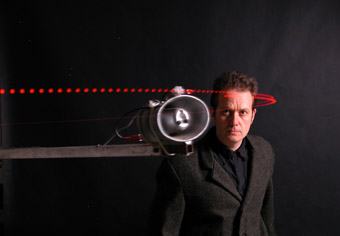
Ray Lee, Siren
courtesy the artist
Ray Lee, Siren
IN A FIELD OF STEEL TRIPODS TWO MEN WAIT AT THE READY. CABLES SNAKE ACROSS THE FLOOR AND STEPLADDERS REST BELOW SOME OF THE TALLEST DEVICES. DOZENS OF HORIZONTAL ARMS OF VARIOUS LENGTHS EXTEND OUTWARDS FROM THE TOPS OF THE TRIPODS, SUPPORTING AT THEIR EXTREMITIES BARE SPEAKERS TIPPED WITH RED LEDS. FOUR FLOODLIGHTS AND A CHAIN OF YELLOW LEDS, FORMING A CORDON AROUND THE INSTALLATION, PROVIDE THE ONLY LIGHT WITHIN THIS CAVERNOUS WAREHOUSE SPACE FOR SIREN, A WORK BY UK ARTIST RAY LEE.
With the efficient air of a technician at work, one man steps up to a device and switches it on: “BAAaaaaaaaaaa…” A single bold note is delivered into the still atmosphere. The musical quality is like that of a piano accordion, yet it is so perfectly pitched and consistently sustained that the source can only be artificial. As each instrument is brought to life, small torches and screwdrivers are used to make adjustments and in response to this tweaking the tonal cry of an apparatus rises or drops. Occasionally the hair-raising lilt of an air raid siren is mimicked amidst a building and discordant cacophony.
Wandering around the periphery of this installation, I approach a speaker pointing directly at me and make a remarkable discovery. This instrument’s note travels in a physical beam and when I’m in its trajectory all other noise peels away so that, despite the soup of sound around me, a single pure note is all I hear. When the workmen set the mechanical arms spinning, this phenomenon of physics, the Doppler effect, creates even more astounding results. Like the mythical siren song, for a time I hear female voices. Later, it’s a repeated orchestral cadence. Yet the synchronicity that creates these impressions is ephemeral and the beautiful illusions break down, disintegrating back into the thick aural chaos from which new patterns build.
This sensorial bombardment morphs and builds for almost 40 minutes, the tension exacerbated by the urgent flailing of apparatuses. So at the performance’s climax when the main lights are cut, the vision of tangled red tracings created by the spinning LEDs is a glorious visual delight. This magical final scene—free from mechanical operations that hitherto focused my attention—sketches in three dimensions the environment of artificial sound that’s been built before me.
The performance ends and I am thrust brusquely back into reality with an unceremonious flood of houselights. My eyes struggle to adjust, my teeth and inner ears are aching and my sternum still buzzes with vibration. I feel pummelled and perforated, not just physically, but also emotionally. Exiting into the dark Sunday evening, I’m overwhelmed with something like loneliness. The inhuman quality of this beautifully strange encounter leaves me thirsty for the warmth of human contact.
Siren, creator Ray Lee, performers Ray Lee, Harry Dawes, Queen Victoria Museum & Art Gallery, Inveresk, Launceston, Ten Days on the Island, March 27-April 5
RealTime issue #91 June-July 2009 pg. 15
© Bec Tudor; for permission to reproduce apply to realtime@realtimearts.net
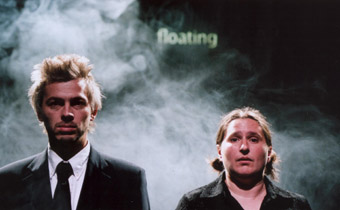
Hugh Hughes, Sioned Rowlands, Floating
photo John Baucher
Hugh Hughes, Sioned Rowlands, Floating
“HELLO EVERYONE!” HUGH HUGHES, THE CREATOR-PERFORMER OF FLOATING (FROM ANGLESEY, AN ISLAND OFF WALES) SMILES DISARMINGLY AT US ALL FROM FRONT OF STAGE. THE HOUSE LIGHTS ARE UP AND WE ALL SAY ”HELLO” BACK, IF A LITTLE SHEEPISHLY. “THIS SHOW IS ABOUT MAKING A CONNECTION.” HIS GRIN WIDENS AND HE WHIPS A SQUARE OF LAMINATED CARD OUT OF HIS POCKET. THE WORD “CONNECTION” IS HANDWRITTEN ON IT IN CAPITALS. HE GOES ON TO DESCRIBE, IN HIS WELSH BROGUE, HOW WE HAVE ALL MADE A “CHOICE” (ANOTHER CARD PRESENTED) TO BE HERE TONIGHT AND THAT FOR A MOMENT HE WOULD LIKE US TO FORGET EVERYTHING OUTSIDE OF THE WALLS OF THE THEATRE.
It could be said that every artist aims to make a connection with their audience, ranging from lodging an interesting proposition to leaving any one person transformed. Three Ten Days on the Island shows—Floating, Evolution and S20—explore the idea of connection in ways that push the comfort envelope.
I don’t think I’m alone in wanting to shrink in my seat when confronted with participatory theatre. “No”, I cry in cowardice, “I want to be entertained, not be the entertainment.” The first few minutes of Floating are loaded with this fear. The show is a fantastical, low and high tech extravaganza devised to tell a ‘what if’ tale about the day the bridge connecting Anglesey and the mainland fell down, thereby setting the isle adrift in the Atlantic. With Hughes playing himself throughout and co-performer Sioned Rowlands flitting between characters, the pair first lead us painstakingly through all of the components of their story using props that include a few sticks of furniture, key pieces of clothing, a Powerpoint presentation, a slide projector, two screens and a large tub of water. They engage audience volunteers to connect with aspects of the imminent story from the comfort of their seats, handing around items like an inflated globe of the world, old wrestling magazines and a ‘clicky ball.’
Floating is a beautiful exercise in making do and getting by in order to tell a vast adventure of an island let loose in the Atlantic and it sits somewhere between theatre, school lesson and Powerpoint lecture. Beginning shrunk in my seat, I found myself sitting taller, engaging in the madness and delighting in being part of a room full of giggling adults. Ironically, once Hughes and Rowlands actually fell into the throes of their story telling, they slipped away from the interactive atmosphere which I felt was the heart of the show and my attention drifted like their island. Once they had followed Anglesey through a delightful loop of the Atlantic and Arctic oceans—including Hughes being temporarily snap frozen in the Arctic—the isle was returned to its rightful place and the players refocused their attentions on the audience. I’ve wondered since, what made this interactive experience different and I think it’s that these players were upfront about the discomfort, mitigating it with humour and charm. Having successfully dissolved that membrane between stage and seat, the show didn’t really end. Hughes had to cheekily tell us that we should probably ‘get back out there’ when nobody wanted to move from their seats. Many hovered outside, holding to this temporary bubble of community.
While interaction is not compulsory, I’m caught in the gaze of Patricia Piccinini’s Big Mother. Her liquid, brown eyes stare directly at me and in them I think I see pain, longing or perhaps conflict. A suckling human baby at her breast, this creature’s bodily characteristics mix human with ape. I find it hard to look away. I’m very familiar with images of Piccinini’s work, but I wasn’t prepared for the prickling, emotional sensation of standing in front of this life-sized primate built from silicone and animal hair.
In a coup for the Tasmanian Museum and Art Gallery, Piccinini has mounted a large collection of her work in a show titled Evolution, including several custom-made pieces. Drawing from her family of creatures in silicone, automotive and video format, the works are spread throughout the entire museum, including witty installations within the colonial, archaeological and popular biological collections. The latter is where Bottom Feeder now lives—a small creature standing within one of the dioramas—its fleshy bottom presented to the room and its small shark-like head peering at us from behind.
Catching a lengthy floor talk by the artist, I’m equally surprised by Piccinini’s presence. Expecting someone cool in more ways than one, instead here is a woman who appears to wear her heart and her beliefs on her sleeve. Rather than trying to scare people with nightmarish visions of the future, she talks of her desire to present solutions to problems. For example, her Surrogate Mother, which has multiple pouches on her back, tiny clawed feet emerging, has been imagined as a safe way to raise hairy nosed wombats, thereby saving them from extinction. She says, “I hope that my work evokes a gut response.” It did.
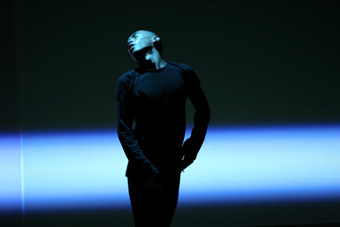
Hiroaki Umeda, while going to a condition, S20
photo Julieta Cervantes
Hiroaki Umeda, while going to a condition, S20
Moving from unexpected comfort to its opposite, Japanese dancer Hiroaki Umeda suggests that his work is devised to strip thought in favour of pure, physical experience. The work comprises three distinct, yet linked pieces, exercises in bitter-sweet endurance—loud, silent, frustrating, uncomfortable, discordant, repetitive, meditative, poetic and delicate.
In the first work, Duo, Umeda barely moves from the one spot in front of a screen. Front lit, he and his sharply outlined shadow are twinned with a life sized digital avatar projected in real time onto a screen to his left. Initially he is completely still within the wall of white noise that greets our ears. We watch, we wait. What follows is dance that mirrors contemporary life, where we may find ourselves watching a screen version alongside nearby reality. Umeda’s fine movements, tiny flicks of the hands or legs, are utterly controlled and elegant, and yet my eyes constantly shift to his mimicking digital self, that is more flicker than flick. As the energy of the dance increases, the avatar is more manipulated, breaking into white noise or slowing such that the sweep of his digital arms leaves a painterly trace. Throughout, the blips and bass beats of the accompanying soundscape are loud and deep enough to resonate within the bodies of the audience.
Umeda’s last piece, titled While going to a condition, tests the bounds of our attention. With Butoh-like concentration, Umeda builds the work slowly. From complete stillness, he gradually layers in repetitive movements. Lines across the two screens behind him continually shift between notional column, arch, field and horizon, creating a space for the work. I find myself lost within the performance and its ‘noise scape’, my thoughts drifting. It’s difficult to remember Umeda’s exact movements, but I still register the feeling of muddled anticipation, as though we are wading towards a release, which eventually arrives after minutes of intense strobing. Umeda’s tight movements give way to fluid, passionate, exhausting dance madness, then return to silent stillness as the work ends. I, for one, sigh with a mixture of relief and respect. Umeda pants with exertion as he bows in thanks.
“Remember, the more you put in, the more you get out of it”, intones Hugh Hughes with a parental note in his voice and I feel that this is true for all of these works. Surrendering to Umeda’s wall of noise, Hughes’ moments of “connection”, or a Piccinini hybrid’s eyes provided for unique, if not always comfortable experiences. Registered in my body in ways that go beyond the cerebral, they’ve stayed with me—like tiny art scars.
Hoipolloi Theatre, Floating, creator-performers Hugh Hughes, Sioned Rowlands, Playhouse Theatre, April 2-5; Patricia Piccinini, Evolution, Tasmanian Museum & Art Gallery, March 14-June 14; S20, Duo & while going to a condition, creator-performer Hiroaki Umeda; Montevideoaki, Hiroaki Umeda, video Octavio Itube, camera Miguel Gromponse; Peacock Theatre, March 27-29
RealTime issue #91 June-July 2009 pg. 16
© Judith Abell; for permission to reproduce apply to realtime@realtimearts.net
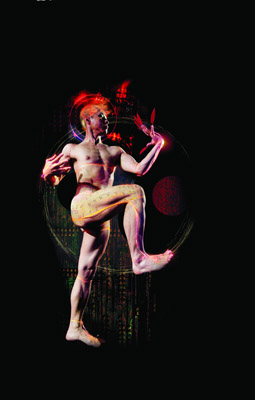
Daniel Yeung
courtesy the artist
Daniel Yeung
THE UNTITLED DOUBLE BILL WITH DANIEL YEUNG AND RAKA MAITRA FEATURES INDEPENDENT SOLO PERFORMANCES BY THESE TWO ACCOMPLISHED DANCERS. WITH YEUNG BEING FROM HONG KONG AND THE INDIAN-BORN MAITRA BASED IN SINGAPORE, THIS TEN DAYS ON THE ISLAND EVENT REPRESENTS A SELECT SAMPLE OF ORIGINAL CONTEMPORARY DANCE FROM ASIA.
Yeung’s Medi.C proposes applying healing principles from traditional Chinese medicine to the body, mind and soul of New China. This ambitious concept is explored through highly energetic, virtually non-stop movement. Yeung’s scantily-clad body is nimble and flexible—running, bending, spinning, pivoting and cartwheeling in a veritable demonstration of the physical abilities of a human body in its prime.
Moving image projection, with a rhythmic soundtrack of industrial and bodily noise, is central to Yeung’s performance. He engages with a low-positioned projector to create a series of fantastic visual effects with and on his body. When the apex of split and mirrored cityscape footage aligns with the centre of his chest, he appears to speed through time and space. Later, his form becomes a pulsing network of multicoloured meridian pathways.
Yeung is constantly tethered to the audio-visual components of his production. For the most part, his synchronisation is a testament to his supreme discipline as a physical performer. On the few occasions where his timing fails I am conscious of watching a routine that has, perhaps, been too strictly choreographed. Yeung’s background in visual art may account for his intellectual approach to dancing, and his concern here to integrate his artform so tightly with other media.
In contrast, Raka Maitra’s performance—an exploration on the theme of water—is a freer, slower paced and more evocative experience. Digital projection is employed with greater delicacy, abstract imagery being projected downwards onto the stage floor creating a series of ‘pools’ to be traversed. Maitra’s journey is both psychological and emotional: she begins by ‘floating’ in a foetal position, glides and struggles through various tidal forces, and eventually stands with her face turned joyously into the rain.
As a dancer, Maitra is more accessible to her audience than the disciplined Yeung. Her body is the primary tool of communication and accordingly her movement, rather than any other element of the production, holds full attention. Though her curvaceous form is veiled in a full-length crimson dress, Maitra moves articulately, full of femininity and strength. The influence of Odissi and Serraikella Chhua, traditional dance forms derived from martial arts, brings qualities of the warrior to her often earthy and primal physical expression.
These are disparate performances exploring the flexibility of dance as a communicative and inherently visual medium providing raw insight into the potential of two rising contemporary dancers.
Daniel Yeung and Raka Maitra; Ten Days on the Island, Earl Arts Centre, Launceston, April 4-5
RealTime issue #91 June-July 2009 pg. 17
© Bec Tudor; for permission to reproduce apply to realtime@realtimearts.net
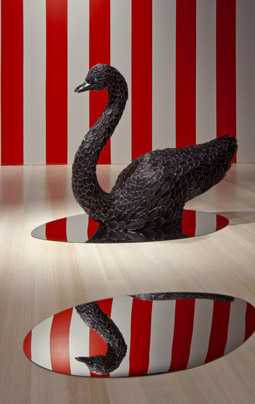
Installation detail, Hospitality, Icelandic Love Corporation
photo courtesy Ten Days on the Island
Installation detail, Hospitality, Icelandic Love Corporation
WALKING INTO ICELANDIC LOVE CORPORATION’S HOSPITALITY IS LIKE ENTERING A SURREAL CIRCUS TENT. MIRRORS REFLECT RED AND WHITE STRIPED WALLS, AN OVERSIZED JEWEL-EYED SWAN RESTS BENEATH A DISCO BALL, WHILE A PROJECTED VIDEO PROVIDES A HARMONICA SOUNDTRACK. THE OPENING NIGHT PERFORMANCE ADDS TO THE SENSORY OVERLOAD, WHEN THE ARTISTS’ SPECIALTY COOKING FILLS THE SPACE WITH THE AROMA OF SPICY FRIED PASTRIES. IT’S AN UNLIKELY AND OVERWHELMING ENVIRONMENT, AND YET THE PARTICIPATORY PERFORMANCE TURNS THE OTHERWISE ANXIETY INDUCING SPACE INTO A WELCOMING AND FUN EXPERIENCE.
The Icelandic Love Corporation (ILC) is a collaborative trio of female artists Sigrún Hrólfsdóttir, Jóni Jonsdóttir and Eirún Sigurdardóttir who work across a range of mediums but are most renowned for their performances. Their art is celebratory and humorous, exploring themes of love and the unexpected.
Elements of play are evident everywhere in this bizarre exhibition. Amidst the uneven lighting, the giant black swan and a velvet tent are dramatically spotlit. Hand crocheted eggs nestled within the dark tent require some co-ordinated bending to view. Those of us wearing skirts at the opening avoid the perilous egg-shaped mirrors on the floor. The disco ball is a quirky addition although, disappointingly, it doesn’t throw any light against the walls.
The objects, clustered in the centre of the gallery, take up little floor space but the carnivalesque red and white stripes fill the walls, breaking down the seriousness, and emptiness, of the gallery’s white cube, creating an illusion of intimacy.
The video, A Black Swan, projected onto the only unpainted section of the wall in an uncomfortable location, opens and closes with animated red and white striped curtains that rhyme with the surrounding walls. It’s a somewhat tragic but simultaneously humorous tale, which conveys the ILC’s mantra: “Love conquers all! The future is beautiful.” The story is closely related to the exhibition’s title, Hospitality, exploring as it does the topical issues of unwanted foreign guests and fear of the unknown.
The native Australian black swan is believed to pose a threat to the native European white swan, and the killing of black swans is actually encouraged in Denmark to prevent interbreeding, which would apparently result in grey swans. In the video, we follow the journey of a crudely animated pair of black swans departing Australia. One is shot as they pass over Europe and, after briefly meeting a white swan, the lonely bird is plunged into a fiery landscape of crocheted flames. Eventually, the reluctant bird exits through a barrier where it meets a white swan, falls in love, and after caressing and contentedly curling up together, they eventually morph into grey scale birds—the dreaded half-breeds. The quirky symbolism, jerky animation and simple harmonica soundtrack are quaint, and the inclusion of the crocheted flames and other craft references connect the animation with the rest of the exhibition beyond the swan subject matter.
Googled, The Black Swan Theory refers to an unpredictable, unexpected but high-impact event or occurrence. In Europe, it was long assumed that all swans were white, and the term ‘black swan’ was used as a metaphor for something that did not exist. However, when Europeans discovered the native Australian black swan in the 18th century, this long-held belief was destroyed. The term can be widely applied,for example to the literary phenomenon of Harry Potter, 9/11, the current financial crisis or the introduction of rabbits and cane toads into Australia—all entities and incidents that seem foreseeable in hindsight. Hospitality doesn’t appear to explore the theory per se, despite the suggestion of the text accompanying the exhibition. However, the video does relate to the origins of the theory, and the exhibition certainly tries to create an unexpected gallery environment by combining a selection of improbable images and objects.
The performance appears quite disconnected from the exhibition. It involves an inverse interpretation of the notion of hospitality. Our Icelandic ‘guests’ set up a temporary kitchen at one end of the striped gallery, cooking for their ‘hosts’ traditional Icelandic deep-fried pastries, or Kleiners, which are to be accompanied by a glass of cold milk. Unlike regular openings, where the exhibiting artists mingle with the viewers, there is little personal communication between the ILC and us. The trio stand behind a table, churning out the cardamon spiced treats, handing out copies of the recipe, complete with crude illustrations, for us to try at home, and stopping people as they try to walk away with wine rather than milk. As someone who is unable to drink milk, I’m one of the many who is pulled up; and while I’m embarrassed at the time, on reflection I realise that this is not the first time I’ve felt the uncomfortable predicament of whether or not to refuse food that people have hospitably cooked for me at the risk of my feeling sick. This familiar, and yet incredibly personal, dilemma, whether or not to offend, made the performance for me. While I understand that there are probably good reasons why there was no documentation of the performance shown during the four-week exhibition, it’s a shame that most viewers were oblivious to what I felt was the strongest part of Hospitality.
Apart from the performance, I found myself engaging with the exhibition rather intellectually, marvelling at the kitsch, the effect of the striped walls, the shine of the swan’s beak. I don’t necessarily see this as a bad thing. Hospitality is a fun experience, living up to the ILC claim that they “like to have a dialogue and discussion with [their] audience and humour is a good way of doing that.”
The Icelandic Love Corporation, Hospitality, CAST gallery, Ten Days on the Island, Hobart, March 26-April 24
RealTime issue #91 June-July 2009 pg. 17
© Lucy Hawthorne; for permission to reproduce apply to realtime@realtimearts.net
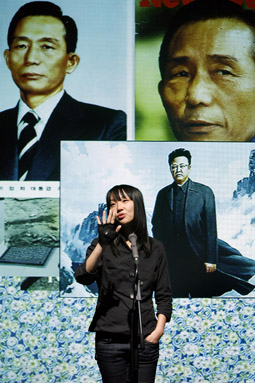
Miriam Yung Min Stein, Rimini Protokoll
photo Barbara Braun
Miriam Yung Min Stein, Rimini Protokoll
IN RECENT YEARS, THE PERFORMANCE GROUP RIMINI PROTOKOLL HAS DEVELOPED AN INTERNATIONAL REPUTATION FOR ITS GROUNDBREAKING, EXPERIMENTAL WORK. FORMALLY ESTABLISHED IN 2002, THE GROUP CONSISTS OF STEFAN KAEGI, HELGARD HAUG AND DANIEL WETZEL WHO FIRST MET IN THE EARLY 1990S WHILE STUDYING AT THE INSTITUTE FOR APPLIED THEATRE STUDIES AT GIESSEN UNIVERSITY IN GERMANY. ALTHOUGH DISPERSED ACROSS THREE DIFFERENT COUNTRIES (KAEGI, WETZEL AND HAUG ARE BASED IN SWITZERLAND, GREECE AND GERMANY RESPECTIVELY), RIMINI PROTOKOLL HAS SERVED AS THE TITLE UNDER WHICH THEY HAVE PRODUCED AN EXTRAORDINARILY ECLECTIC BODY OF WORK.
What draws this work together is the emphasis placed on developing a performance, art, theatre and radio practice driven by ordinary people, experiences, encounters and events. In Cargo Sofia-X (which toured Europe in 2008), the audience was placed in the back of a converted, glass-sided truck manned by a Bulgarian truck driver who recounted stories about his work and life as he manoeuvred the audience between service stations, roadside diners and border checkpoints. In interviews, Rimini Protokoll describes these non-actors as “experts” rather than amateurs, because what interests them about the performers is the specific knowledge and forms of experience that they bring to bear on the work in question.
Among several Rimini Protokoll works currently touring Europe is Black Tie—a performance I attended at the HAU 1 Theatre in Berlin in March and which is being staged at the Vienna Festwochen in May and June this year. Black Tie is essentially a one-woman show performed by Miriam Yung Min Stein, a German woman born in South Korea in 1977 and adopted seven months later by a German couple who raised her, together with their other children, in Osnabrück in north-west Germany.
Like most of the “experts” who feature in Rimini Protokoll’s productions, Stein does not have a background in acting. Although she studied dramatic writing in the USA and worked with Christoph Schlingensief on his 2004 production Kunst und Gemüse (Art and Vegetables), she has largely practised as a journalist and a director in advertising and music television. In 2008 she published Berlin-Seoul-Berlin which recounts a 2006 journey to South Korea in search of her identity. It is around this preoccupation with tracing her roots that Black Tie is structured.
It is clear that the performance is going to be an intimate affair. Instead of entering via the usual doors, we are ushered in via the backstage entrance to take our places on temporary seating at the back of the stage which directs our gaze towards the well-lit auditorium. At the front of the stage, facing us, is a very simple set which features a large screen for projections, a podium and a small platform for an accompanying musician, Peter Dick.
A casually dressed Stein introduces herself to us, scans her adoption certificate, which promptly appears on the screen behind her, and informs us that, as a newborn baby, she was found in a box outside the Seoul town hall wrapped in newspaper (a story which, she later informs us, was revealed to her as a fabrication). While the set is sparse, Stein uses a remotely wired glove to add and move images on the screen behind her, including close-up images of sections of the daily papers in South Korea on the day she was “discovered”—images which prompt her to reflect on whether her small body was wrapped in the international politics section, or perhaps in advertisements for fruit and vegetables.
Stein also uses the screen to provide us with a potted history of the country in which she was born: a chronicle illustrated via a colourful collage of images pasted together almost like a child’s scrapbook. This digital ‘scrapbook’ also includes images of her (very blonde) German family taken when she was a child, along with a copy of a letter written by her German mother a year after she was adopted, in which she explains the difficulties Stein experienced in her first year growing up in Germany. Stein herself also reflects on these, citing painful moments in her life when her “difference” was made clearly apparent. She recounts, for example, the sense of pain and confusion she felt when the waiter at the Chinese restaurant she was dining at with her family spoke to her in Chinese; a traumatic event that prompted her to spend the rest of the evening under the table.
These memories and images are contrasted with photographs of “what might have been” via the introduction on stage of Hye-Jin Choi, a South Korean woman living in Berlin who draws on images from her own family album to provide us with a picture of traditional family life in South Korea. The cultural differences between Germany and South Korea are also highlighted via a clip from a South Korean reality television program in which a German woman is reunited with her birth parents on stage. As the young German woman moves toward her newfound South Korean relatives, they quickly begin distributing presents to her and her German family. Both parties look confused, nervous and uncomfortable, and the reunion is painfully awkward.
While Stein has no interest in appearing on such a program, Black Tie is about the central position her South Korean identity (or lack thereof) occupies in her life. While grateful to her German family for the opportunities with which they have provided her, she is clearly angry and, to a certain extent, bitter about what she describes as the “schwarze Löcher” (“black holes”) that are opened up in people’s lives by international adoption. This anger was clearly compounded when, after arriving in South Korea, she discovered that all information about her birth parents was lost when the adoption agency was destroyed in a fire.
As is revealed towards the end of the performance, in a last ditch attempt to learn more about her identity, Stein ordered a DNA profile, after spitting into a tube and posting it to an overseas lab. Among other things, the profile reveals that she has a one in five chance of developing Alzheimer’s. As the profile is projected on screen, the performance concludes with Stein’s melancholic reflections on the relationship between remembering and forgetting, on dates that have been lost, and on sense memories, people and places that have yet to be (and perhaps never will be) discovered.
The ending itself is a very open one (leaving the audience unsure when to applaud). Any attempt, however, to wrap up Stein’s story would have undermined the active, imaginative mode of engagement fostered by the eclectic collection of materials from which the performance is constructed. The strength of the work, however, rests primarily on Miriam Yung Min Stein’s performance, and on the “expert” manner in which she communicates a sense of her, at times, difficult experience growing up as a German strangely “out of place” in Germany.
Rimini Protokoll, Black Tie, script, direction, design Helgard Haug, Daniel Wetzel, performers Miriam Yung Min Stein, Hye-Jin Choi, music Peter Dick; HAU 1, Berlin, March 11-14
RealTime issue #91 June-July 2009 pg.
© Tara Forrest; for permission to reproduce apply to realtime@realtimearts.net
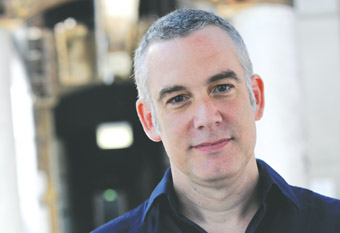
Daniel Brine
photo Heidrun Löhr
Daniel Brine
DANIEL BRINE HAS BEEN IN THE JOB AS DIRECTOR OF SYDNEY’S PERFORMANCE SPACE FOR SOME SIX MONTHS. HE’S AFFABLE, BRISK AND ENGAGING, RECENTLY FACILITATING SESSIONS IN THE WHERE IS INDEPENDENT DANCE IN SYDNEY? SYMPOSIUM (P22) WITH REASSURING EASE, ENSURING A CONFIDENT RESPONSE FROM PARTICIPANTS.
Now that he’s settled into his new role and is deeply immersed in creating the organisation’s business plan for 2010-2012, it seemed timely to ask about his developing vision for Performance Space, including his thematic approach to programming, a public program for building the artist-audience-Performance Space relationship and publishing possibilities that will expand and deepen our responses to artists’ work.
But I also wanted to ask Brine about the origins of his fascination with and commitment to interdisciplinarity, not least because it gives us a stronger sense of him as curator, programmer and director working closely with artists in a range of circumstances here and overseas, but also because his career is tied intimately to the recent history of interdisciplinary and hybrid practices. Brine’s responses to my questions follow in this edited version of our conversation.
vision, practicalities, discourse
Vision is a difficult word. I think the challenge is making things happen. In the last few years Fiona Winning (former Performance Space artistic director) focused on the transition to CarriageWorks. I think there’s a real challenge to match vision with what’s actually practical and possible within the constraints of where we are.
The way I’ve imagined things happening has been flavoured by what I’ve heard people talking about since I’ve arrived. I’ve found them really interested in the way discourse and discussion can be central to work. This is something that I’ve said I want to make central at Performance Space. So part of the vision is about trying to integrate discourse and discussion much more fully with the program, not just tacking an artist’s talk on the end of a show. I’m interested in ways that we read work, the ways audiences come to work and how that can be informed by things other than just sitting on a seat and watching it.
This is partly about how we understand programs of work and, specifically, the four discrete seasons Performance Space has at CarriageWorks. The four seasons idea is a practical solution financially but it also offers us programming opportunities in the ways we curate performance, finding threads of interconnection between the works. In a season we’ll have, say, four performances in Bay 20, plus an exhibition and a couple of residencies. It’s not big, so different sorts of discussions around different sorts of works can come together at one time. The loose thematic is the structure that we’re beginning to play with. But the works will inform the thematic rather the thematic dictating the work we select.
Were starting with umbrella themes. For instance, in 2010 we’re calling the first one You Are Here. Essentially it’s about location. We’ve been looking at works that make sense within that, gathering them together, going back to look at the theme and see if we can tighten it, re-define it and maybe call it something else. So we’re seeing how work and theme inform each other, which is our process of curating performance. Of course, questions of interdisciplinarity and risk, inclusion of practice that might be excluded by other critical frameworks, these are founding principles within which Performance Space works and these remain core to what we’re doing.
The second theme will be Generations—what it means to be part of a generation, a group of people of the same age and experiences. But also it might be about rejecting traditions or passing the baton between generations. The third Theme is Live Works—questions of things that happen in the world that you don’t really quite understand—with a focus on small works of performance art or live art. The final season we’re calling Rights and Responsibilities, drawing a little on the Performing Rights work that was done with the Live Art Development Agency and the Queen Mary University of London. They’re the four areas we’re looking at. For early 2011 we’re thinking ahead about sci-fi, utopias and distopias, all rolled in together.
the art life
I was born in Melbourne, lived in Edinburgh until I was six years old, then in Adelaide from 1972 until the early 80s. I did the full Architecture Degree, but I knew towards the end that I probably wasn’t going to practice and that I would be going down the route of architectural historian or architectural critic of some kind. But I couldn’t make a penny writing about anything and sort of fell into a job at the Australia Council. My very first job was working on a scheme called Community Environment Art and Design. That was looking at the intersection of visual art, public art and architecture. As soon as I was at the Australia Council I felt very much at home, really interested in practices and what was happening with artists. I was very lucky to work on the international program. It was a fantastic introduction to the visual arts in Australia. I was there for about three years.
At that time in Australia there was a movement in craft criticism, looking at questions of interdisciplinarity. A university, gallery and craft association consortium won one of the tenders in Australia Council Contemporary Craft Curators Scheme and I got the job. For me it was really interesting because it was about interdisciplinarity. I ended up writing my Arts Administration Masters on questions of interdisciplinarity in craft. My first show was called Homocraft (1995). I still think it was quite a good show. It was about the ways that artists’ sexuality was informing their practice using signs and symbols—signifiers and codes with a history, especially in gay communities.
I didn’t do that job very long because my partner was offered a residency in New York so I went to New York and did a stint at the American Craft Museum. And I enjoyed New York. I felt really liberated. I very much enjoyed the research at the museum. I liked being part of the institution. The craft wasn’t necessarily the sort of work I was interested in but I was learning a lot about collections, management and patrons.
In Australia I’d been offered the job as curator of the Tamworth Fibre and Textile Biennial so I was finishing that off while in New York. I’d selected the show before I’d left, did the catalogue in New York, came back to Australia to hang the show, went back to New York and started to look for jobs in the UK where I had family connections. I applied for a job in what was called the Combined Arts Department of the Arts Council of England. I got that job, principally I think because I could talk about interdisciplinarity.
from combined to live arts
The Combined Arts Department was a really weird mix—it was where arts centres, disability arts and multi-disciplinarity arts were housed. But the department had an Interdisciplinarity and Live Art wing and I found myself working on that. It was great, introducing me to a whole range of practices—including new media. Digital dance was particularly interesting at that time, a whole range of motion capture stuff going on. Live Art was sitting alongside new media but other artforms were also beginning to dabble in these areas. It was a great scheme to be working on and I got to know a whole lot of artists . Blast Theory, for example, had a strong performance practice in theatres but was just beginning to really push new media boundaries.
I was at the Arts Council when it was restructured, moving Live Art from Combined Arts back to the Visual Arts. The Combined Arts department was scrapped, although there was the creation of an Interdisciplinary Arts Unit. It was an interesting decision to separate Live Art from Interdisciplinary Practice. There are a whole lot of arguments as to why that might have happened, but it was simply a rationalisation and I went with it to Visual Arts. It was an old-fashioned understanding of what live art was [seeing it as performance art].
My ambition at the time was to be working in the field. There was a really good festival in the UK called the Now Festival run by Andrew Chetty. I left the Council and Andrew and I job-shared the Now 2000 festival. It was a great experience. The festival gave Gob Squad some of its first outings. Lone Twin and Blast Theory performed there.
live art development agency
In 2000, Lois Keidan had set up the Live Art Development Agency with Catherine Ugwu. They’d both been at the ICA. London Arts put out a tender for an agency to develop live art. Lois and Catherine bid for the tender and the Live Art Development Agency was formed. Catherine moved on to a very successful event-management business and I joined as Associate Director in 2001. At that point it was quite difficult. We were both working part-time. The agency was very small. We were working two or three days a week, but it was really fascinating. I knew the sort of artists that the agency was working with and it just made sense.
Lois had seed funding to raise the profile of performance in the visual arts field with a plan to hold an event at Tate Modern [Live Culture, 2003]. It consumed Lois and I for a number of years—a fantastic project to work on. And there was always the core of the agency’s work: professional development for artists including a bursary scheme we ran for years. The way we worked at the agency was that each project was set up with a different set of partners. China Live [with live art works from China] was officially a project of Live Art UK, a national network of live art promoters. We selected works as a curatorium, trying to be as inclusive as possible. At the same time, the agency drove it. I put the screening project together. There were other projects: a collaboration with Bluecoat placing performance within the Liverpool Biennial, linked in with working with Guillermo Gómez-Peña who was part of the international program of the biennial, as well as ours and the Tate program. We used his work as a springboard to ask questions about cultural identity in the UK, trying to get away from simply looking at cultural diversity as a question of race, asking broader questions about cultures and coming to the UK.
The fantastic thing about the agency is that we were small and we did everything. I even kept the books for many years. The nice thing about being small is also that you can focus where you want to focus. Lois and I were both interested in publishing so we did as much as we could there. We also established The Study Room, basically our library, for artists to use. It was something that happened organically, providing people with the opportunity to see stuff. I feel really proud of that. It was about cataloguing and saying to everyone we met, “Will you give us a DVD of your work.” We were trying to keep the room practice focused. We didn’t want it to go down the academic route. We wanted artists at the centre of what we were doing. And that’s why that space was really for artists or people who were studying the work.
I think we’ll start some form of library here. As things get going in 2010, we’ll collect material, pinch the Study Room idea and do it in our own way.
the attractor: performance space
I was attracted to Performance Space because there are very few organizations around the world specifically focused on questions of interdisciplinary performance practice, risk and innovation. That’s where I want to stay in terms of the artists I want to work with. After eight years working at the Live Art Development Agency, the model that we had was working extremely well. We’d also decided that the best thing for the organization was to remain small and focused and fleet of foot. I was personally looking for the challenge of working with a slightly bigger organization. There’s something right about coming back to Australia—interesting things are happening here, and I thought it’d be good to come back and be part of it.
programming the public
I think we’re going to try to create a physical space within each season, locating it in Track 12 where we’ll create public programs in the broadest possible sense. Existing events might happen there, like Reeldance’s Cinemoves, where artists gather to watch DVDs. Others will be artist-run discussion groups and other activities. They might be very, very simple. If an artist goes overseas, meets other artists and is interested in their work, brings a DVD back, we provide a space where they can hold a night, show the work, bring people together to discuss it. So it’ll be a mix of us instigating things and hopefully artists saying I want to use the space to do this.
This can also provide a space where audiences can meet. It might be academics from across Sydney who want to discuss performance in some way and want to set up a network in a neutral space. Or it might be local people from Redfern or Newtown coming together around our program. I’m imagining we’ll look at popular forms of engagement, like book clubs, and ask how we might use them. I’m imagining that this is also the space in which the library would happen, so in one corner there’ll be a little shelf that will grow to big shelves over time, where people will deposit materials and others will come and look at them. We’ll have screening and internet services as well and the capacity for small, impromptu performances.
We’re lucky enough to have funding from the Australia Council for a young and emerging producer who will run our public program, a full-time post for 18 months allowing us time in 2010 to experiment with the concept. It’s a risky strategy and we have to animate it to be successful.
publishing & connecting
We want to start to publishing on the web. It’s publishing in the loose sense, providing different ways for audiences to engage with work. I’d love a very short film for every single show we put on with the artist saying why they made the work—a little talking head or a tiny interview, whatever is comfortable for the artist, just to begin to suggest different ways of engaging with the work. I want to find ways for artists to write other sorts of texts. I’m hoping too that for every show we put on we’ll have an artist’s page published on our website—it might be an image, it might be an interview, or a critical text they’ve commissioned, something that they think provides audiences with another way to enter their work. I’d love to keep publishing these and at the end of the year, print them all off in some very cheap and cheerful way, bind them all together and make them publicly available.
a bright future
Sydney’s performance scene has long had a strong sense of community. Daniel Brine’s careful planning holds the promise of opportunities to strengthen and expand it, to develop a sense of its history, especially at a time when a potent new generation of performers is emerging, and to engage more closely with its audiences through conversation and publishing.
Performance Space at CarriageWorks, Sydney, www.performancespace.com.au
RealTime issue #91 June-July 2009 pg. 19
© Keith Gallasch; for permission to reproduce apply to realtime@realtimearts.net
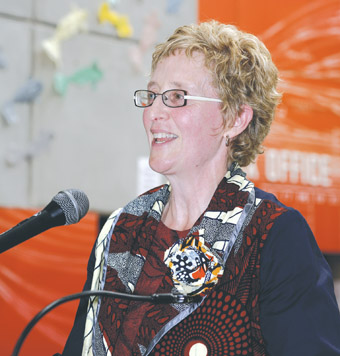
Sue Hunt
photo Keith Saunders
Sue Hunt
NOW IN ITS THIRD YEAR, CARRIAGEWORKS, “SYDNEY’S HOME FOR CONTEMPORARY ARTS AND CULTURE”, IS BECOMING AN ACKNOWLEGED PART OF THE CULTURAL LANDSCAPE. YOU KNOW THIS WHEN TAXI DRIVERS RECOGNISE THE NAME AND HAVE A PRETTY GOOD IDEA WHERE IT IS.
On a recent Friday, the huge Bay 17 housed a contemporary classical music concert by Chronology Arts, Bay 20 a production of Richard III, while in the so-called Tracks, Tess de Quincey performed Ghost Quarters and, next door, spoken word and hip hop artists presented a version of Alice in Wonderland. The vast foyer, at the same time, was crammed with Finders Keepers Market stalls displaying clothing, jewellery, publications and art works by dozens of largely young artisans selling to many hundreds of curious, eager purchasers. This was CarriageWorks, and its cafe and bar, working at full capacity. Its many different audiences (including those for the regular recording of So You Think You Can Dance) and users certainly know where it is.
readiness
The enormous task of opening CarriageWorks, six months on from her appointment in mid 2006, fell to the indefatigable Sue Hunt. With a background as a stage manager and as technical director for the Victorian State Opera for six years, she became the general manager of the Geelong Performing Arts Centre (1995-99) and was senior executive responsible for the business management of the Queensland Theatre Company (1999-2003). She was subsequently Director of Performing Arts for the Sydney Opera House (2003-06).
Asked if she thought her work prior to the CarriageWorks appointment prepared her for the monumental job it became, Hunt replies in the affirmative. “I think I was prepared for this job, in lots of ways. I’d done a number of building projects before if not of this scale. When I was at Geelong Performing Arts Centre, we did a re-fit of the building and I essentially project-managed that. At Queensland Theatre Company, we were funded to find a new home for the company, so I did all of that. I was certainly able to step in and say, I know what a client is, I know what the builders are talking about. I’ve run large and small organisations now and I think that gave me the ability to say, well, I’m creating a small organisation. And I’ve done a lot of work in my practice about organisational development and business improvement. I’ve also done a lot of work with theatre companies, opera companies, in management and production management and producing roles. Working with artists is my first love really—particularly having spent a lot of time as a production manager and technical director, making people’s visions happen, taking the vision of a creative team and fitting that with a budget and a schedule and a theatre and all of that kind of stuff. I always say stage managers are born and I was born a stage manager. And you know, I think stage management prepares you for almost anything!”
In her third year with the organisation she’s still bright eyed: undaunted and optimistic about CarriageWork’s future. Yes, she would love to have more funds to invest in Australian work and attract international productions, but, as with the building of a committed audience, these are long-term goals: “Unless you take a generational view, unless you think 25 years, you’re not going to think of the full potential of a place like this. And that goes to the level of investment that’s been put into it now and needs to be put into it in the future as well.”
the spirit of the place
Hunt thinks that central to the challenge of making the centre work is having a clear sense of it as a unique place: “Our vision for CarriageWorks is that it’s a place for creativity and innovation with a unique spirit. We spend a lot of time thinking about that. What has to be developed, and nurtured, cared about and loved is that spirit, and it comes with artists, resident companies and other users. So CarriageWorks Limited, who run the venue, needs a unique spirit as well. When Arts NSW first showed me through CarriageWorks I was absolutely taken by the size and scale but the thing that struck me most was what was possible for the contemporary arts sector.
“But how do you create something that doesn’t exist anywhere else? I’ll never forget, before we’d even opened, someone asked me: “What model are you basing CarriageWorks on?” I think there was a sense of, ‘Oh well, she’s come from the Opera House; is she going to create another Opera House?’ No. But there isn’t a model for it. There is CarriageWorks with its own sense of place and its unique spirit and geography.”
In terms of geography, Hunt recalls the thoughts of the architects, Tonkin Zulaikha Greer, that came from talking with the reference group, including Performance Space and other resident organisations. “There was a sense of bookending the city. You’ve got the Opera House at one end, which is large and grand and in the place that everyone thinks of as Sydney—the harbour. Generally the Opera House is for more traditional artforms and bigger companies. At the other end you have what will become a hotbed of invention and discovery and creativity. It is already, of course, but it will become known as that. I’d like to see it in the psyche of Sydney in the same way that the Opera House is and I’d like to see it internationally placed.”
audiences and community
Hunt is more than pleased with CarriageWorks’ progress: “Overall we’ve been very successful. We started with virtually no audience. No-one knew us. No-one had profiled CarriageWorks before it opened. So we were starting from zero. For a young organisation, we’ve done quite a bit of market research. We’re thrilled to know we do have a traditional audience that comes with Sydney Festival or Sydney Dance Company shows, but we do have a significantly different, younger profile, which is exciting—children, young adults and through to 35. It’s an audience that a lot of arts companies would kill to have. It comes with a great sense of community. We’re operating at over 80% capacity, and close to 90% activity most months.
“We’re up to nine organisations, including ourselves, that have offices in CarriageWorks. The café is starting to draw people who don’t have any other reason to be there. The diversity, whether it’s Sydney Children’s Festival or the Hip Hop Festival or Underbelly, which we had for a couple of years, or Performance Space’s work in its multifarious ways of being, these all build community.”
strategies & challenges
Hunt’s aim from the beginning, she says, “was to come up with a creative organisation, in and of itself—not a group of centre managers as was suggested to me, or a venue for hire—which assists companies and artists to be creative. What’s important to me is that the organisation learns as well and grows and develops, is adaptive to change and can operate differently. So I think the role of the CEO is to provide that vision and leadership, to keep people following that direction. I let my staff get on with what they need to do.”
A major challenge for CarriageWorks had been its responsibility for developing a commercial strategy for the undeveloped half of the site, but now the State Government has taken that over, which, says Hunt, “makes our job less labour-intensive. We can focus on getting the art space right and it means that we’re no longer responsible for being self-sustaining. We’re responsible for running an arts centre and money will flow to us for that, but the conversation is about how to continue to support and supplement what CarriageWorks needs while the other part is developed, the whole of the North Everleigh precinct and so on. All of that is very exciting. And we’re still deeply involved in the conversation.”
Securing a steady flow of hirers is critical, says Hunt. “Beyond Performance Space, there aren’t a whole lot of regular hirers as there are with venues like the Opera House and other arts centres. So you actually have to generate a lot of activity yourself. We have a producing team of one and a half—an executive producer and a part-time person. They work closely with marketing whose job is about not only shows or festivals we’re presenting but also helping to sell the building as a facility. Then there’s an operational team, which is really about taking bookings, contracting, planning all the events and delivering them, whether that’s front or back of house. Then there’s a finance person. So there are 14 or 15 people now and that’s about the level that we think will be sustainable. It took us the best part of 2007 to put in place the basic team. We’re really only just getting stable now and thinking what is sustainable, that means people don’t have to work 60 hours a week. The team feels like it’s a team.”
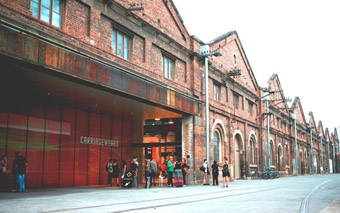
CarriageWorks
photo Keith Saunders
CarriageWorks
programming & investing
With its four annual seasons occupying the second of the performing spaces, Bay 20, the gallery and the rehearsal/workshop Tracks, Performance Space is a key resident—”the kernel of CarriageWorks’ contemporary arts focus”, says Hunt emphatically. From the beginning she thought that “what was important was not to double up on what Performance Space was doing, not to risk their program in any way. So then, we asked what’s an audience interested in within contemporary culture? What does an audience, rather than an artist, want to see in this place? Then, where’s the next bright thing coming from? So although we don’t have the ability right now to present a lot of work, we’ve been able to put in place some capped investments. Virtually every time we’ve said to those artists, you keep the box office, because their ideas and work came to us unfunded. We partnered companies and events that no-one had heard of at the time: The Rabble, Rinse Out Incorporated, Underbelly, Street Art. Hopefully, one day we will be able to support more works, bring in shows from Brisbane and Melbourne and overseas—because that’s an important part of getting an international focus. But right now we’re into a staged approach, with growth from within. We’ve been able to commission resident companies. We were able to put some money into developing ERTH’s Petting Zoo from an outdoor show to a theatre show; we’ve co-presented with Force Majeure; we’ve been able to present Stalker’s Stiltbreak as part of the Hip Hop festival and we’re co-presenting Marrugeku with Performance Space later in the year.”
In 2008, CarriageWorks generated an impressive 65% of it revenues, with the State Government providing the balance. “It’s pretty amazing for the second year of operation. Funding doesn’t cover all of our base fixed costs, so we’ve got to top that up and then what we’ve got left, we’re able to put into programs.” Hunt says that CarriageWorks “is a little over-dependent on So You Think You Can Dance in terms of venue rental” but, on the other hand, she’s glad that the organisation “is not reliant on box office in a big way” or on major sponsors, especially given the vulnerability of both areas in a recession, she says, recalling the devastating impact of the early 1990s downturn and the likely impact of the current one. “We’ve got to ensure that that level of venue rental keeps going. Otherwise, that’s when you start to worry.”
Hunt is emphatic that CarriageWorks operates as a state-subsidised organisation: “And that’s as it should be if you decide you want something like this. There’s not one arts centre in this country that isn’t supported by a government. There might be commercial theatres but they’re not art centres. So, being subsidised, that’s as it should be. It’s not a commercial house. It doesn’t have an 1,800 or 2,000 seat space. It doesn’t have a shopping centre above it. It was established for a particular sector and with particular community outcomes in mind—and I use ‘community’ in the broadest sense, of artists and their public.”
the future
Clearly the dream of being a commissioning and producing house rather than a venue for hire, if a strategically curated one for contemporary arts, is deeply attractive to Hunt: “If we were able to be the Sydney presenting home of our resident companies, that would be awesome. I’m sure we’ll get that sort of presentation money together over time; that’s when it will start to feel like it’s the real thing, and if, for example, Force Majeure’s new work premiered at CarriageWorks, then we could set it up to tour around the world. But, as I say, that’s in the long term.”
Hunt is also alert to the challenges faced by artists trying, with limited means, to make the most of CarriageWorks’ large spaces and technical and safety demands, a point strongly made by Fiona Winning in her 2009 Rex Cramphorn address. Early on came the realisation, says Hunt, that costs would be beyond some groups and that partnering would be essential, and there was a lot of it, she points out, in 2007 and 2008. Some artists—Tess de Quincey, Joey Ruigrok Van Der Werven, Song Company (for their bracing Easter performance, Tenebrae, have excelled at exploiting the massive foyer; and Alan Schacher transformed Bay 20 for The Bland Project. As Sue Hunt keenly points out, CarriageWorks uniquely offers opportunities for artists that yield audience responses like, “Oh my god, I couldn’t have seen that anywhere else.”
With its distinctive programming strategies, including a broad contemporary culture ambit (embracing hip-hop, huge street art creations, experimental music, works for children and special events like a photo exhibition “giving youth a say about Hepatitis C”), CarriageWorks, together with Performance Space’s radical explorations, indeed provides a home for diverse contemporary practices and audiences. Of course, neither organisation can meet all the needs of the growing numbers of rarely well-funded innovative artists, so it’s not surprising that new, smaller creative spaces are opening up, not least in Sydney’s inner-west (see p21). But it’s CarriageWorks above all that provides an invaluable, supportive gathering point for embracing and promoting contemporary culture in a city brimming with it.
CarriageWorks, Sydney, www.carriageworks.com.au
RealTime issue #91 June-July 2009 pg. 20
© Keith Gallasch; for permission to reproduce apply to realtime@realtimearts.net
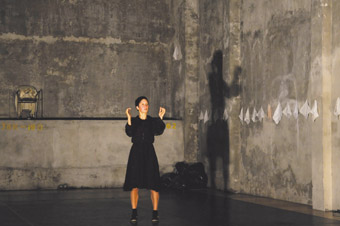
Alexandra Harrison, Dark, Not Too Dark, creative development at FraserStudios, Feb 9-27. Harrison will continue this development at Performance Space August 17-28
photo Heidrun Löhr
Alexandra Harrison, Dark, Not Too Dark, creative development at FraserStudios, Feb 9-27. Harrison will continue this development at Performance Space August 17-28
CHIPPENDALE HAS BEEN A HUB OF POOR BUT HAPPY CULTURAL ACTIVITY FOR A WHILE NOW. FIVE YEARS AGO, YOU COULD DO AN ART CRAWL OF AMAZING VENUES, ALL WITHIN THE FEW BLOCKS RUNNING BETWEEN CLEVELAND, ABERCROMBIE AND REGENT STREETS. PERFORMANCE SPACE DELIVERED PERFORMANCE, DANCE, MUSIC AND VISUAL ART; SPACE 3 OFFERED VISUAL ARTS AND IMPROVISED MUSIC; PELT CONCENTRATED ON SOUND PERFORMANCE AND AUDIOVISUAL INSTALLATION; AND FURTHER DOWN IN THE VALLEY LAN FRANCHI’S PRESENTED ALMOST ANYTHING YOU COULD IMAGINE.
Today all those spaces are gone—closed except for Performance Space (the only ‘legal’ venue), which moved to CarriageWorks at Eveleigh. However there is another wave of artists clinging to the few vacant spaces surrounding the massive construction site that once was the old Carlton Brewery on Broadway. Amazingly one of these spaces, FraserStudios, is a direct result of the construction, as the property developers have offered up the old warehouse on Kensington Street as a temporary space for artists.
The project development of FraserStudios has fallen to Sam Chester and James Winter, the tireless duo who have been behind Queen Street Studio, a rehearsal space for hire just around the corner in Chippendale. The pair started Queen Street in 2005 in response to the news that The Fromagerie (formerly Omeo), a well-loved dance rehearsal space in the old silos in Newtown, was set to close. And it was a big and scary venture. Winter says, “when we went through the signing of the lease we had all the people in our lives, including the solicitor we got pro bono, saying ‘you’ll go bankrupt in three months.’” As it was a commercial lease the financial pressures were considerable but within 6-9 months of opening they were operating at 50-70% occupancy, with the majority of hirers being independent artists. Winter believes it succeeded “because we know how we need to be treated as performing artists. We just applied that to how we ran with the business and the fit worked.”
Besides the hard work, and support from friends and volunteers, a key to the early success for Queen Street was a very amicable relationship with the landlords. However this relationship became problematic after the landlords changed their core business and renovated the building, removing the sound insulation. Chester says: “It just goes to show that in a commercial lease situation, that relationship is crucial and when it goes sour, it’s over, get out.”
Chester and Winter decided not to renew the lease on those premises however it was around this time that the City of Sydney and Frasers approached the team to take up the FraserStudio tender. Queen Street had received some small project grants from the City of Sydney and apparently had made an impression. Winter says, “We were really wanting to activate Chippendale as well as the top floor of our little studio. And so City of Sydney were really keen for the program to be delivered by people who were already kind of established, had a connection with Chippendale, and could deliver on what they said they were going to do.”
The pair resisted the offer for a while, wary of the prospect of working with big property developers. Chester says: “Queen Street’s only got a name… We don’t have lots of money.” However once the decision was made it was all action. Chester explains, “We turned it around really quickly. Frasers spoke to us at the end of June, and there was a lot of pressure to get it up. I think we had artists moving in within a month.”
The initial plan from Frasers and City of Sydney was to offer studios for visual artists. However Chester and Winter expanded the brief to include space for performing artists. Winter says “the whole picture involves [the performing arts] community and we’re not interested unless we can make that happen.” Chester continues: “There is no ongoing funding from [Frasers or City of Sydney]. They don’t pay us, we still run it as a Queen Street Project so everything that is created is created by us and administered by us and facilitated by us. So the performing arts space was a negotiated thing. They said we want visual arts and we said okay we’ll deliver that but we want [studio] 12 and 14 to make income so we can subsidise the project.”
As neither Chester nor Winter has a visual arts backgrounds they’ve brought in artist Peter Volich to oversee the visual arts program. Volich says that the studios offer “a fantastic opportunity for artists to work on a specific idea within their practice. Whether it be to prepare and finalise a body of work for exhibition—which many artists have used the residency for—or to develop a seed idea.” Over 30 artists have benefited from the free studio space and Volich believes the calibre of artists has been very high. “There have been a multitude of outcomes for the artists who have worked here: exhibitions both locally and interstate; curators and arts workers who have come in for studio visits etc…”
The performing arts component of the project began in January 2009 and not only is the space available for hourly hire, but there is also a series of subsidised programs, supported by Arts NSW and AusDance, providing free rehearsal space. Interestingly the first round of recipients reads like a list one would have expected from a residency program at the old Performance Space with a mix of established and emerging artists: De Quincey Co, Stalker, Rosie Dennis, Sue Healy, Jane McKernan, Alexandra Harrison, Rolandi Alejandro, Eddie Sharp, Mark Haslem and The Imperial Panda Festival. This program is clearly filling the gap that has developed since the move by Performance Space to CarriageWorks, which has concentrated the programming into four six-week blocks, thus offering fewer residency possibilities. In the light of some current funding imperatives that encourage inner-city artists to work in west and south western Sydney (from whence many artists initially fled), the eligibility criteria for these grants is particularly refreshing giving “priority to local performing artists (defined as inner-city Sydney) whose practice has been disrupted by development in the local community” [Queen Street Studio website].
Other programs are also facilitated by the Queen St team including ToolKit, a series of intensive workshops with artists such as Martin del Amo, Kate Gaul and Linda Luke; and Off the Shelf, a program for writers and directors to develop text-based works. These all reflect the ongoing philosophy of both Chester and Winter, which is about embracing and celebrating the entrepreneurial spirit of artists.
Of course this spirit is reflected in not only the work happening at FraserStudios but across a range of artist run spaces in Sydney. On the other edge of the construction site, Serial Space (initiated by Tameka Carter and Louise Dibben, and now run by Alex White, Zanny Begg and Alice Williams) is ramping up having just received an Autralia Council ARI grant. A few blocks across, Bill & George Studios appears to be thriving. In Marrickville, a dynamic group of women, fed up with the tenuous status of these kinds of venues have gone so far as to buy a warehouse and set up Red Rattler, a totally legal venue for experimental performance [p27]. And there are many more spaces hidden across the city. In fact Rebecca Conroy, one of those behind Bill & George, has recently formed Space Syndicate, a network of 24 independent spaces and intitiatives across the Marrickville and City of Sydney local government areas to lobby for the importance of these spaces in the overall cultural landscape.
Given the City of Sydney’s long-term Sustainable Sydney 2030 plan, The Queen Street/FraserStudio model is being watched closely. At this stage Sam Chester and James Winter are very positive about their partnership with the big end of town. Winter concludes: “We’re talking about a small arts organisation working with a multinational Singapore-based developer. But it’s the realisation that cutting all that status shit away we both have similar objectives in regard to this project. They need to revitalise this street, they need to placate the community and also be seen as being generous in regard to giving space to artists. Those things are important to us… What we have been able to achieve is above and beyond expectation and [Frasers has] actually realised that the people in the arts work extremely hard to make anything happen. I was saying to [a representative from Frasers] today that it’s been a really fascinating relationship. ‘We’ve had to change our perception of you and you’ve had to change your perception of us. But as soon as that’s happened we are actually in partnership.’ It’s a true partnership because we both share the agenda and the agenda is honest. And the agenda is about revitalisation.”
The word at the moment is that Queen Street/FraserStudios will remain active until September 2010 at least.
Queen Street/FraserStudios, 13 Kensington St Chippendale. The fourth round of applications for visual arts studios is coming up in July, and an open day will be held on June 21. www.queenstreetstudio.com/fraserstudios.html
RealTime issue #91 June-July 2009 pg. 21
© Gail Priest; for permission to reproduce apply to realtime@realtimearts.net

White Board, Where is Independent Dance in Sydney? Symposium
photo Erin Brannigan
White Board, Where is Independent Dance in Sydney? Symposium
ON APRIL 7 A SYMPOSIUM FOR INDEPENDENT ARTISTS AND ARTS PROFESSIONALS, WAS HOSTED BY THE SCHOOL OF ENGLISH, MEDIA AND PERFORMING ARTS (UNSW) AND PERFORMANCE SPACE WITH THE SUPPORT OF REALTIME AT UNSW KENSINGTON CAMPUS. WHERE IS INDEPENDENT DANCE IN SYDNEY? WAS SWIFTLY ORGANISED IN RESPONSE TO THE ARTS NSW FUNDING OUTCOMES FOR 2009 ANNOUNCED EARLY THIS YEAR THAT HAD A DEVASTATING IMPACT ON THE LOCAL INDEPENDENT DANCE SECTOR, MAINLY DUE TO A CHANGE IN FOCUS AWAY FROM INDIVIDUALS AND TOWARDS ORGANISATIONS AND PROGRAMS.
The broad aim of the symposium was to create an event where the community could “connect with peers, identify strengths and gaps in provision, and take a proactive role in determining the future of independent dance.” With many people commenting on the novelty of all being together in one room (highlighting the absence of effective social and industry events for Sydney’s dance community), the event was successful in providing a sense of focus and plans for concrete action.
The six hour symposium was attended by some 35 artists and administrators (from long-standing members of the community such as Tess De Quincey and Nikki Heywood to newcomers Rachel Morgan and Rachelle Hickson), and was framed by an opening ‘provocation’ from Julie-Anne Long and ‘case study’ in the person of Emma Saunders. Long talked about perceived or imagined binaries separating the independent community dotted around the inner city from institutionalised dance centring around the harbour; the possibility of choosing independence; and the reconfiguration of this binary to accommodate flows in both directions. Her descriptions of the Sydney Opera House as a UFO heading off out of here, and the Wharf precinct as a liner about to depart for other shores, were images that encapsulated the tenuous nature of current connections with these ‘edifices.’
Performance Space director Daniel Brine guided us through a variety of frameworks for discussion in smaller groups around two major themes: what “we” need (the infrastructure map); and what “I” need (the artist’s map). Topics such as our strength in diversity of practice, the imperative for independents to maintain their status through collective action, the entrepreneurial bent of this group of artists and the ideal of maintaining an uncompromised position in one’s practice produced exciting discussion. And a creative task in personal map-drawing produced some surreal and sometimes frightening results that would be perfect for the walls of the Arts NSW office on Elizabeth Street.
Ultimately, the visual maps with gaping holes and vortexes, along with Emma Saunders’ emotional articulation of everything we-always-wanted-to-say-but-didn’t, brought to the surface much of what had been simmering just beneath for many individuals feeling isolated and disheartened. Having been involved in this community for more than 20 years, it does seem to me the time is ripe for action with so many key players signing up in support. The foundational work done by artists such as Rosalind Crisp at Omeo Studio and supporters of local practice such as Performance Space, One Extra Dance and Critical Path has, over many years, produced a groundswell of activity, bringing in to focus the profound deficiencies in practical and financial support for ongoing practice, production and presentation. I guess we all anticipated what a choreographic laboratory like Critical Path in Sydney would mean; excellent work with nowhere to go.
Things did get a little fuzzy in the sixth hour, but my summary notes emphasise the desire for a clearer articulation of the sector in order to educate funding bodies and have the practice properly valued; to pursue places and spaces where the community can exist and connect; and to seek some relief from administrative work that eats up precious time and resources. Identifying the people and places already negotiating the objectives, such as the inimitable Sam Chester at Queen St and FraserStudios (p21), appeared to be one of the most logical steps forward.
The following is an excerpt from a letter sent to Mary Darwell (Executive Director, Arts NSW) which resulted from the day. It was signed by around 40 members of the Sydney dance community who met a few weeks after the Symposium:
“The sector was alarmed by the application of assessment criteria (audience numbers, financial sustainability) that severely disadvantaged most members without taking into account the challenges faced by the sector. Our gathering recognised that the independent dance community is a strong, supportive one, but that the lack of grants in 2009, the paucity of studio spaces for ongoing training and development of works, the modest commissioning funds at Performance Space and CarriageWorks, the absence of a major University-based School of Dance in NSW, all mean that independent dance artists in NSW work in an anxiety-making, fragmented environment…
“We believe that the issues of the health and future of the independent dance sector, as a whole, need to be taken into account in the 2010 funding round. We urge Arts NSW to consider the recommendations we have made here and those outlined by Ausdance NSW in its issues paper, particularly that assessment criteria be modified so that they are responsive to the actual conditions under which the sector operates; that peer assessment be made by peers; and that Arts NSW partner the sector to address studio space and administration issues.”
Other outcomes of the follow-up meeting included the setting up of a volunteer rotating working group of five (Alexandra Harrison, Nikki Heywood, Sue Healey, Julie-Anne Long and Martin del Amo); sponsorship from Sam Chester at FraserStudios in the form of space for meetings and communications support; and a briefing with Arts NSW regarding the new guidelines for funding released May 15, to be hosted by Ausdance NSW.
Where Is Independent Dance in Sydney?, symposium for Sydney dance artists and workers, facilitated by Daniel Brine, Director of Performance Space and Dr Erin Brannigan, Lecturer in Dance, School of English, Media and Performing Art, UNSW; April 7
RealTime issue #91 June-July 2009 pg. 22
© Erin Brannigan; for permission to reproduce apply to realtime@realtimearts.net
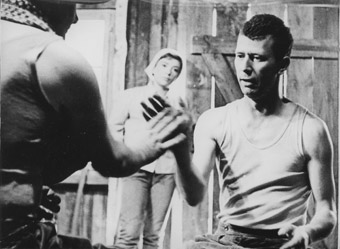
Spur der Steine/Traces of Stone
photo Günter Marczinkowsky
Spur der Steine/Traces of Stone
THE FESTIVAL OF GERMAN FILMS THIS YEAR BENEFITED GREATLY FROM THE PRESENCE OF SIX FILMS FROM THE ‘OTHER’ GERMANY: THE DEUTSCHE DEMOKRATISCHE REPUBLIK (DDR), THE GERMAN DEMOCRATIC REPUBLIC (GDR), OR ‘EAST GERMANY.’
Nestled alongside present-day productions at the festival set in the GDR or pertaining to its legacy—12 heißt: Ich liebe dich/12 Means: I Love You (Connie Walther, 2007) and Novemberkind/November Child (Christian Schwochow, 2008), both of which concentrate on familiar Stasi/police-state stories. Seeing films actually from the GDR puts contemporary treatments into some relief as (with exceptions such as Christian Petzold’s Yella, which screened at 2007’s festival) rather superficial and, perhaps surprisingly after all these years, ideologically determined.
Although Poland, Czechoslovakia and Hungary are considered to have produced more internationally recognised Eastern bloc filmmakers than the GDR, throughout its short existence from 1949 to 1990 its film industry was (as the festival program somewhat condescendingly states) ‘surprisingly’ productive and diverse. The films presented here concentrate on the work of three well-known and respected GDR directors: Frank Beyer, Heiner Carow and Konrad Wolf, none of whom can be considered straight propaganda artists (while being, to different degrees through the years, committed to their new state and its proclaimed socialist ideals even as they inevitably had problems along the way).
Perhaps the most ‘typical’ of these films in terms of socialist folk-heroism is Frank Beyer’s Karbit und Sauerampfer/Carbide and Sorel (1963), which tells the light-hearted story of a manly worker—though given idiosyncratic characterisation as a vegetarian non-smoker—after the war in 1945, who has to transport carbide from Wittenberge to Dresden so he and his comrades can restart a tobacco factory. Through the very accessible form of a comedic road trip (riffing on the chaos of post-war Germany but also, in one scene, a gullible US soldier), the film surveys the GDR at its ‘pre-’stage from a secure (newly Walled-in) future, as we watch Germany’s fragmentation at the hands of new Cold War geopolitics. Almost inadvertently, near the film’s end we glean that our earthy protagonist is a communist—communism therefore coming from ‘the people’ as opposed to being forced on them. This seems to perpetrate the silence that continues today around Hitler’s least discussed victims (which one might naively hope a communist cinema would eulogise), home-grown German communists. Secondly it elides the fact that those who did survive 12 years of Nazism were largely overrun in terms of political power by Soviet officials after the war. Demonstrating well the ‘folk art’ feel-good parable form to which much mainstream communist cinema aspires, Carbide and Sorel‘s historically problematic elements—echoing across the film’s setting (and horrific prior events), the time of its production, and from today’s perspective—make it all the more informative.
Still uplifting in its way but naturally grimmer in tone was Beyer’s and the GDR’s most internationally celebrated film, Jakob der Lügner/ Jacob the Liar (1974), winning a Silver Bear at the 1975 Berlinale (seen as a significant trans-Wall accolade) and nominated for a 1976 Academy Award for Best Foreign Film. Set in the Jewish ghetto in 1944, supposedly one of the first East German films to tackle the ‘Jewish issue’, this story concerns a cranky man who weaves a web of lies about the Red Army’s proximity (after inadvertently overhearing news through a Gestapo office door) and claiming he has a hidden radio. Culminating in Jacob’s improvised ‘broadcast’ behind the wall of an attic designed to convince his niece of their impending rescue (bringing to mind Roberto Benigni’s hugely popular 1997 film Life is Beautiful but without the same sentimentality), the film is interesting for its evocation of the power of imagination and virtuality in the form of productive lies (resulting in a sharply reduced Ghetto suicide rate). While the film typically posits the Soviets as the nascent unseen heroes of the war, in doing so it is hardly less propagandist than most Western films (and in the case of East and Central Europe, much closer to the truth).
The most interesting film, in part because it is actually about the intricate workings of the GDR, was Beyer’s Spur der Steine/Traces of Stone (1965-6), which attained an unintended ‘reflexivity’ when banned a few days into release, due no doubt to a level of moral and political nuance and complexity that almost beggars belief. The protagonists are an ambitious, seemingly liberal-reformist young Communist Party secretary newly in charge of a large construction project, and a cavalier site foreman who leads a bizarrely cowboy-styled band of troublemakers who openly disrespect Party authority and yet are also the most productive workers.
When a young female engineer arrives, both men become involved with her in different ways, resulting in an intricate and measured melodrama while also providing for a slowly building political/morality play, but without pedagogical ‘conclusion.’ By the end, the film’s founding moral universe—both political and personal—has been thoroughly unmoored (hence its banning). All this is rendered via a series of flashbacks made up of carefully framed black and white widescreen compositions. From these we gradually glean information unavailable to a present-tense ‘investigation’ scenario which the film cuts to periodically, featuring Workers Committee meetings where the young Party secretary is essentially put on trial for his personal-meets-political indiscretions (an adulterous relationship and resulting pregnancy the nexus issue).
Traces of Stone exemplifies the ability of some communist bloc films—the wishes of State producers and censors notwithstanding—to inspect an entire system at its coalface. Personal behaviour is intricately connected to political ‘responsibility’, and for long stretches here we see almost documentary images of people sitting in a drab room trying to administer the mysterious investigative mechanisms of bureaucratised socialist life. Somehow such an inquiry is made fascinating from the start, building in tension as combined with the much more elaborately staged flashback scenes. The film ultimately satisfies neither the state nor its critics, and liberal humanism in the form of what seemed a kind of love story is denied through a truly ‘modern’, very open ending. Even the ‘couple’ itself is finally unclear within an uneasy triangle that for a while proved ‘professionally’ very productive. In the end romantic love appears destroyed rather than refined, yet through the characters’ subtly transforming treatment of each other, a certain ethical gravitas, human honesty and empathy—perhaps a broader kind of sober (and properly socialist?) humanist rebellion—is strikingly voiced, even as everyone ends up ‘alone.’
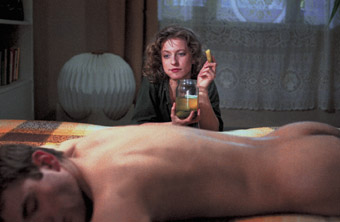
Coming Out
photo Wolfgang Fritsche
Coming Out
Heiner Carow’s Coming Out premiered the night the Wall came down, giving the film’s English-language title another layer of meaning. The portrayal of East Berlin’s late 1980s gay scene is striking (as shot on location with non-actors) in a fairly clear-eyed portrayal of subcultural life. The epicentre of the film occurs when a world-weary old man in a gay bar, after being partly assaulted by the film’s self-obsessed protagonist, offers a lesson—the story of how he became a communist when trying to survive in a death camp (as the Party was the best organised resistance going). After the war he worked to overcome all oppression and marginalisation. Just as this mythology of civil rights heroism is rankling the viewer after decades of real-world Communist bloc oppression, the old man emits a cutting lament: while in time the Jews and other minorities ceased to be victims of systematic persecution, “somehow the gays were forgotten.”
This political-historical level—which may have personal resonance for its gay director—adds not only a much appreciated grit to what would otherwise have been a reasonably familiar story but also invokes the very real sufferings of Hitler’s lesser known victims (if perhaps better remembered now than communists themselves) and their less familiar German story, with strong resonance in ‘free’ countries.
The other Carow film at the festival was supposedly the GDR’s biggest domestic commercial success. Die Legende von Paul and Paula/The Legend of Paul and Paula (1973), an absurdist comedy of sorts, strongly evokes early 70s everyday life and popular culture in the GDR. It also features what we would now call ‘magic realist’ interludes. This aesthetic contrast is echoed in the film’s thematic trajectory, where post-60s romanticism operates alongside a darker tonality. At the heart of the film lies tacit acknowledgment of socio-economic difference as seen through an affair between the clearly better-off Paul, who has a mysterious government job, and Paula, who works in a supermarket, and who live across the same street from each other (the ‘communist’ element of this disparity perhaps). Their affair comes across both as a libertarian rebellion against drab working life and moral-ideological prescription (hardly unique to the GDR then). In some ways seeming more time-locked than the other films here, The Legend of Paul and Paula entertains through its charming performances and absurdist love story (though Paula dies at the end while giving birth to their child) as well as providing a scattershot meditation on the minutiae of life as played out within an urban space that appears both constantly in-construction and in-decay, a perhaps realistic portrayal of GDR city life that nonetheless also offers metaphorical suggestion.
Solo Sunny (Konrad Wolf, 1978) was another huge domestic success, while also travelling well beyond its historical and political origins, and the Prenzlauer Berg locations offer a fascinating visual account of late 70s East Berlin. This story about Sunny, who wants to be a professional singer, at first glance seems to be about ‘losers’; heroism and stardom are certainly missing, while various low-rung entertainment spaces and scenarios familiar to anyone who has ever sought a career in music are in abundance. Yet the film cumulatively offers a ‘realistic’ affirmation of human attempts to live outside the life choices apparently on offer in the society of the day, for the creative effort involved irrespective of ‘success.’ Rather than a tragedy of existential failure or a ‘lesson’ about misguided dreams of bucking against the status quo, the film offers a modest but trenchant hymn of refusal—if its enduring popularity is anything to go by—when faced with a drab social real, no matter what the tangible results.
Irrespective of their varying focus on specific historical and political issues, these films offer both rich, unfamiliar insights into the ‘other’ (in many ways suppressed, since reunification) Germany from the grave, and more broadly resonant meditations on complex social, moral and existential problems that continue to cut across time and space.
Goethe Institut Audi Festival of German Films, Sydney, Brisbane, Melbourne, Perth, April 15-28
RealTime issue #91 June-July 2009 pg. 23
© Hamish Ford; for permission to reproduce apply to realtime@realtimearts.net
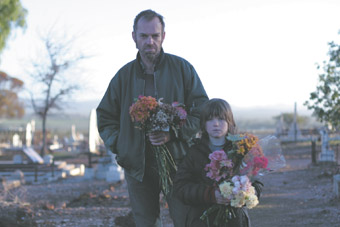
Hugo Weaving, Tom Russell, Last Ride
GLENDYN IVIN’S FIRST FEATURE LAST RIDE, WHICH PREMIERED AT THIS YEAR’S ADELAIDE FILM FESTIVAL, CATCHES THE WAVE OF HIS EARLIER EXPLOSIVE SHORT FILMS. HIS DARK LITTLE DRAMA, CRACKER BAG, SOARED TO THE GREATEST HEIGHTS A SHORT FILM CAN GO, WINNING THE PALME D’OR AT CANNES, A SPECIAL MENTION IN BERLIN AND DENDY AND AFI AWARDS. HIS FOLLOW-UP, THE DESERT, WAS ALSO NOMINATED FOR AN AFI AWARD.
Last Ride (based on the NSW Premier’s Award-winning novel by Denise Young) is a road trip through some unusual and majestically isolated South Australian landscapes, featuring a rough-as-guts Hugo Weaving as father Kev, on the run with his naive but on-the-cusp 10-year-old son Chook (Tom Russell), who just wants to stay put, longing for some sense of stability in his fragmented life.
From the opening scene—an industrial landscape of broken cars, where a lanky-haired kid in a too-big cap plays hide-and-seek with a gun—Ivin delves into the legacy of violence passed down the generations between fathers and sons, his film joining a recent spate of Australian features exploring the internalisation of male aggression: The Square, Ten Empty and Three Blind Mice. Kev is the victim of his own father’s neglect and rage. Although he tries to control it, he revisits the damage on his own son. Ivin’s exploration of this is sensitive and tender. Kev is doing his best with limited resources. The film cleverly holds back key information that will turn our judgement of Kev on its head. Central to this, and revealed in flashbacks, is Chook’s ambiguous relationship with Max (a memorably subtle performance by John Brumpton). Max gives the boy a toy car he always carries, bathes him at night, takes on a more caring father-figure role (or so we think).
But as the film starts to reveal cracks in the landscape, our heart aches for Chook, such a beguiling and sweet boy, as we imagine him hardened by adult betrayals, adjusting to deal with the cruelties and contradictions of the situations he is negotiating daily. As Ivin intends, we wonder how boys like him will end up. But for now, Chook is prepared to ask the hard questions of any adult he finds, to “roll on [his] back and float” when the going gets tough. We hope he stays in that place. But as the landscape becomes more and more impenetrable, we doubt it.
Rolling out languidly, the film sustains great dramatic tension alongside piercing beauty, with gently jangling guitar strings, particularly reminiscent of Wim Wenders’ work, especially the lingering pathos of Paris, Texas where characters drift through landscapes. There are continual reminders of nomadic lives: Kev claims to have Afghani and Aboriginal blood; he and Chook squat overnight in an Afghani museum where the boy steals a ‘magic’ vest for protection; Chook wakes up to a camel licking the front windscreen. Ivin has the confidence to use just the necessary words, the silences cleverly capturing a child’s view of a world he doesn’t completely understand. I’m reminded of Streeton’s Golden Summer painting and Frederick McCubbin’s Lost as the pair camp by a river surrounded by glorious, dead stringybark trees (a seething white mass sculpted to the sky) that dwarf boy and father, becoming a disenchanted forest.
The film’s pivotal moment, where Chook is abandoned in the middle of a lake containing just a few centimetres of water, trudging in an eternal shimmer to the horizon, is truly frightening and visually breathtaking, and makes you want to eat up the landscape whole. All of it reminds us of bigger issues too, the rivers and lakebeds drying up, a planet running out of water. But Greig Fraser’s unique cinematographic vision (and clever use of pull-focus) never distracts from the characters’ escalating tension; it becomes a true part of them. As Ivin notes: “I had already looked in Queensland, and we had been to Broken Hill and beyond on a writing trip, but everything I saw in South Australia just blew me away so we adapted the film to work around this new terrain. A little like how you might develop and rewrite characters after rehearsal, I would go out and find locations and then come back and work them into the script with Mac [Gudgeon]. In this way the script remained quite open and organic right to the very end.”
Working with the same tight-knit creative team as on his short films, Glendyn Ivin has unveiled an exquisitely crafted first feature with all the elements expertly woven and taut performances by Hugo Weaving and first-timer Tom Russell. It should be a hit on the international festival circuit. Let’s hope Ivin doesn’t join the rank of talented filmmakers taking too long to get a second film up and running (like Cate Shortland and Ivan Sen, to name just two of many).
Last Ride, director Glendyn Ivin, producers Nicholas Cole, Antonia Barnard, screenplay Mac Gudgeon, director of photography Greig Fraser, production designer Jo Ford, editor Jack Hutchings, composer Paul Charlier; opens nationally July 2
RealTime issue #91 June-July 2009 pg. 24
© Kirsten Krauth; for permission to reproduce apply to realtime@realtimearts.net
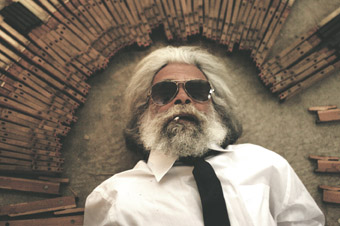
Jack Charles, Bastardy
JACK CHARLES OCCUPIES A NUMBER OF CONFLICTING IDENTITIES: ACTOR, HOMELESS PERSON, HEROIN ADDICT, HOMOSEXUAL, EX-CON, ACTIVIST AND MEMBER OF THE STOLEN GENERATION. HE ADDRESSES ALL OF THESE IN AMIEL COURTIN-WILSON’S DOCUMENTARY, BASTARDY, WHICH FOLLOWS THE INDIGENOUS ACTOR OVER NINE YEARS, TELLING STORIES OF PAST AND PRESENT EXPERIENCES.
When we first meet Charles, he is a homeless heroin addict. We watch in close-up as he injects. He addresses the camera moments after, confidently telling the director that if he hadn’t just witnessed this, he wouldn’t be able to tell that Charles was high. This scene immediately conveys the contrast between Charles’ bearing—his affected English accent, self-awareness, good looks and charisma—and his plight. This enables him to address the mainstream from the position of a fringe-dweller.
Courtin-Wilson, who directed the awarding-winning documentaries Chasing Buddha (2000) and Islands (2000) and whose short fiction CICADA (2009) screened at Cannes this year, again reveals his skills as a filmmaker in this intricately constructed documentary. While the film is visually and narratively fragmented, repeated visual motifs and the soundtrack, featuring several tracks by CocoRosie, bind the film. For example there are numerous shots of Charles walking the streets or travelling across the city by tram or taxi. Bastardy is also interspersed with atmospheric Super 8 footage of inner-Melbourne streetscapes, providing pause between segments of the film and complementing the repeated visual motif of Charles’ movement through the streets.
Bastardy reveals different aspects of Charles’ life and personality gradually. The film comprises archival footage, photographs and recreations as well as footage from the present. This includes Charles addressing the camera directly and guiding Courtin-Wilson to places around Melbourne alongside scenes such as his release from prison. Consequently a narrative about Charles’ life during the making of the documentary emerges next to an exploration of his past.
There is a strong focus on Charles’ physical surroundings in Bastardy, providing insight into his life and allowing the audience to view Melbourne from an alternative perspective. At the beginning of the film, when Charles is living on the streets we see where he sleeps and shoots up. In some of the most entertaining moments of the film, we see him guide Courtin-Wilson around the exterior of houses he burgled in the wealthy suburb of Kew. Later, we see him inside his housing commission flat, after returning from prison, attending to domestic chores and taking pleasure in finding that everything is as he left it.
In an interview with the ABC, Amiel Courtin-Wilson said he initially wanted to focus on Charles’ early life, filming interviews with friends and colleagues. In the end, these did not make it into the film; instead Charles tells his own stories. The focus on his present state compels the audience to consider the ongoing impact of Australia’s traumatic colonial history. As a member of the Stolen Generation Charles speaks of the impact of the abuse he suffered in the boys’ homes where he grew up and of finding family members later in life.
Bastardy also addresses Charles’ acting career, which he managed to maintain despite frequent prison sentences, drugs and industry attitudes to Aboriginal actors. Beginning his career in theatre, he co-founded the first Aboriginal theatre, Nindethana, with Bob Maza in 1971. Bastardy includes archival footage of Charles acting on stage and in films, including The Chant of Jimmie Blacksmith (Fred Schepisi 1978), Bedevil (Tracey Moffat 1993) and Tom White (Alkinos Tsilimidos 2004). After the screening of Bastardy at Melbourne’s Blak Nite Cinema, actor Aaron Pederson spoke of the obstacles that are placed in the way of Indigenous actors to this day, and of the need for mainstream film and television to be braver in their casting.
While Bastardy doesn’t flinch from depicting the hardships of Charles’ life or the darker sides of his personality, it’s an enjoyable film. With his indomitable spirit and wit, Charles is a pleasure to watch and Courtin-Wilson weaves together themes, incidents and stories engagingly and provocatively. Jack Charles’ experiences raise crucial issues about the ongoing impact of the Stolen Generation and racism in Australia, but the man’s history is also important because of his contribution to mainstream and Indigenous culture though his activism and a long acting career.
Bastardy, Siren Visual DVD: screening Palace Cinemas; winner Best Documentary Jury Prize, 2008 FCCA (Film Critics Circle of Australia) Awards.
Bastardy, director Amiel Courtin-Wilson, director of photography Germain McMicking, producer Phillipa Campey, Film Camp, editors Jack Hutchings, Bill Murphy, Richard Lowenstein, composer Steve Benwell, 2008, 83mins; www.bastardydocumentary.com
RealTime issue #91 June-July 2009 pg. 24
© Lucille Paterson; for permission to reproduce apply to realtime@realtimearts.net
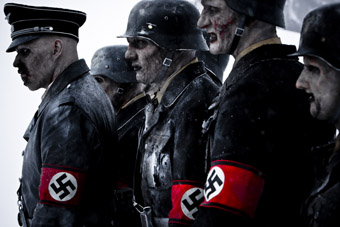
Dead Snow
AS ALWAYS, THIS YEARS’ REVELATION PERTH INTERNATIONAL FILM FESTIVAL HELPS REDEFINE THE CUTTING EDGE WITH A MIX OF BOLD, INFORMATIVE AND EXOTIC FARE. IN A PROGRAM PACKED WITH CHALLENGES AND SURPRISES, IT’S HARD TO SINGLE OUT A FEW FOR ATTENTION. NONETHELESS, IN A MEDIA-SATURATED WORLD, TODAY’S FESTIVAL-GOER CAN OFTEN USE ALL THE ADVICE THEY CAN GET, SO HERE ARE MY PICKS FROM A VERY TEMPTING PROGRAM.
Programmer Jack Sargeant’s expertise in underground culture and his affinity for outsiders and freaks is evident in the programming of NYC Foetus, the 2005 documentary about little-known post-punk legend JG Thirwell. Thirwell is way more interesting than some perhaps overexposed figures, though with the success of the fabulously neurotic Adult Swim cartoon Venture Bros, for which he’s been providing soundtracks, Thirwell is acquiring a new generation of hip young fans. Often regarded as the stereotypical ‘difficult’ artist, in NYC Foetus, Thirwell’s personality doesn’t grate at all; he comes across as thoughtful, complex and, prodigiously—almost scarily—talented. Director Clement Tuffreau has woven together reflective interview material with some of the New York underground’s key figures, shedding light not just on the artist but on the immensely creative post-punk/no-wave period as a whole. Music fans already familiar with this narrative will revel in the film’s loving incorporation of never before seen archival footage of Thirwell’s various incarnations as Foetus, Steroid Maximus and Manorexia as well as the liberal doses of his distinctive sound.
A very different music documentary unfolds over Soul Power’s 93 minutes. Crafted from the ‘outtakes’ of the 1973 documentary When We Were Kings which documented the infamous prize fight between Muhammad Ali and George Foreman, Soul Power charts the staging of the legendary black soul music festival in Kinshasa known as Zaire ‘74. This doco shows how that event achieved almost mythological status as the defining moment of 20th century African-American music: that amazing mid-70s Black Power moment of ‘the brotherman in the motherland’ is captured in all its glory here. The way the film’s extensive verité footage (apparently edited down from a mammoth 125 hours) cuts between the magic on stage and the chaos backstage reminded me of Gimme Shelter—unsurprising when you realise that one of the key cinematographers was the celebrated Albert Maysles. You don’t have to be a fan of soul—James Brown’s funkadelic finery and pure 1970s porno moustache is worth the price of entry alone.
Two other contemporary documentaries stand out: We Are Wizards and Saint Death. We Are Wizards follows the craze known as Pottermania—but if you think this is a standard fan-boy type of account, think again, because the film’s real story has less to do with the bespectacled boy-wizard Harry Potter than with the enormous corporate might marshalled against the actions of young acolytes. Big corporations disgracing themselves with wrong-headed and heavy-handed reprisals against the people who make their merchandise relevant is nothing new, but stories of young fans standing up to corporate lawyers still are. Personally, I find good documentaries on fan culture dangerously seductive—someone else’s obsession, told well, can be contagious–and though this didn’t quite convert me to the cult of Harry Potter it did endear me to his gutsy little fans. Those interested in contemporary cultural and legal machinations of intellectual property and copyfighting need to see this film.
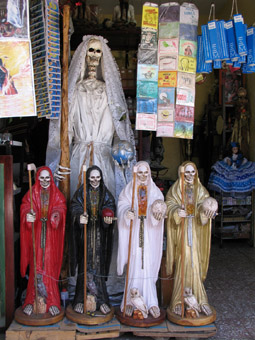
Santa Muerte
Another cult with a growing legion of fans is the Mexican cult known as Saint Death, represented as a skeleton in a wedding dress. Revelation is screening the utterly fascinating 2007 Mexican documentary Santa Muerte, narrated by Gael Garcia Bernal (of Motorcycle Diaries fame), which explores how this surprisingly recent phenomenon has arisen, and how its devotees continue to multiply. Despite the condemnation of the Catholic Church, which won’t recognise the ‘death saint’, increasing numbers of Mexicans, it seems, are making offerings for love and luck at the flourishing portable shrines and ad hoc altars springing up in her honour around the country. With Mexico often in the news for the wrong reasons, this documentary by the indefatigable activist filmmaker Eva S Aridjis proves incredibly illuminating as to how the oddly charismatic figure of Santa Muerte fulfils a particular need in the Mexican people.
The merging of traditional and contemporary beliefs characterises the 2007 animation, Sita Sings the Blues. Remarkable Indian-Canadian artist Nina Paley wrote, directed and almost entirely animated this dazzling feature-length extravaganza. Brisbane International Film Festival audiences last year adored this film’s slightly manic form, which interweaves events from the Hindu legend of the Ramayana, a conversation between Indian shadow puppets, musical interludes with sultry blues numbers by Annette Hanshaw and raw, emotional scenes from the artist’s own life. The bizarre parallels the film draws out between the ancient mythological tale and the contemporary biographical story create a free-wheeling atmosphere reinforced by the virtuosic display of different 2D animation styles.
Two recent Nordic releases programmed at Revelation show the breadth of contemporary cinema in Scandinavia. The quirky 2009 indie film Original, about a hapless rube named Henry, is notable for its innovative use of the ready-made sets at a well-known budget furniture chain, and the stunning rockabilly turn of Tuva Novotny playing Henry’s eye-gougingly decorative love interest. No less visually engaging, but coming from a distinctly different generic place is the Norwegian feature Død Snø (Dead Snow), whose noteworthy cinematography is the work of Bond University graduate Matthew Weston. When we see a group of medical students embark on a skiing holiday at a remote shack in the woods, we know immediately that we’re in for a ‘vacation gone wrong’ flick—but the film’s twist can be summed up in four words: vengeance-seeking Nazi zombies. Død Snø is a film that knows its audience and gives them what they want: humour, titillation and bravery from sexy leads, and lovingly detailed flesh-eating from the undead.
Where Død Snø provides a frosty glimpse of Norwegian (and Finnish) alpine wonderlands, another Revelation film offers cinema-goers a trip to the jungle. The remote Amazonian setting of A Festa da Menina Morta (The Dead Girl’s Feast) is rare even in international film festivals. This often brutal Brazilian feature, about a young mystic channelling the spirit of a dead girl, has divided critics, some of whom have criticised its inclusion of ‘indie Latin’ hallmarks, such as animal bloodletting. Considering this is well contextualised as within the santeria tradition which powers the film, the animal cruelty scenes seemed less disturbing than some of its other confronting fare. While it won’t work for those with delicate sensibilities, there is much to like in this non-family-friendly film beside the eye-opening Amazon imagery and soundtrack, including the film’s unconventional approach to cinematography, which slips between shaky, observational documentary style in the wide shots to beautifully composed close shots.
The Brazilian rainforest may be the only gorgeous, exotic location which does not feature in The Fall. Made largely with director Tarsam Singh’s own funds in 2006 and released last year, The Fall is an adventure-fantasy which unfolds around the story told by an injured stuntman to a little girl he befriends in hospital. While others will swoon over the glorious costuming and dynamically choreographed action (as you’d expect from a director better known for video clips), it’s impossible not to fall for the headspinning range of locations—the Czech Republic, Sumatra, Fiji, Bali, The Dead Vlei claypan in Namibia, as well as some of the most extraordinary Indian locations—the labyrinth Jantar Mantar in Jaipur, the Andaman Islands, Pangong Lake in Ladakh, the ‘Blue City’ of Jodhpur in Rajastan. The lush weirdness of this film typifies Revelation’s reputation for imaginative and risky programming, as well as the willingness of Perth audiences to embrace this film festival.
Revelation Perth International Film Festival, Perth, July 2-12, www.revelationfilmfest.org
RealTime issue #91 June-July 2009 pg. 25
© Danni Zuvela; for permission to reproduce apply to realtime@realtimearts.net
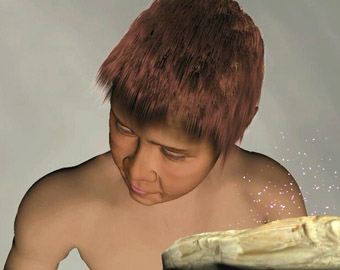
The Boy Who Had the Magic Word and the Whispering Moth
AUSTRALIA AND CANADA WERE ESTABLISHED AS COLONIES WHOSE FOUNDING FORCIBLY OCCUPIED TERRITORIES THAT HAD BELONGED TO ABORIGINAL PEOPLES FOR THOUSANDS OF YEARS (40,000 IN THE CASE OF AUSTRALIA AND 12,000 IN CANADA). BOTH INDIGENOUS CULTURES SHARE A MUTUAL SPIRITUAL UNDERSTANDING OF TOTEMIC CONNECTIONS AND COLLECTIVE CONSCIOUSNESS, AS WELL AS BEING THE ONLY TWO FIRST NATION PEOPLES TO REFER TO THEMSELVES AS ABORIGINAL. THROUGH THE LENS OF ANIMATION, BIG EYE: ABORIGINAL ANIMATION FROM AUSTRALIA AND CANADA EXPLORES THE MANY SIGNIFICANT CORRESPONDENCES BETWEEN THE FIRST NATIONS PEOPLES OF THESE TWO COUNTRIES.
Curators Jenny Fraser and Lubi Thomas, together with assistant curators Rennae Hopkins and Maggie McDade, have produced a resonant and imaginative study of recent creative work by Aboriginal artists and filmmakers from Australia and Canada. Staged over an array of screens throughout QUT’s versatile multimedia space, The Block, the show is more than a survey. It also included a popular interactive component, where participants create short moving animations in Flash in a permanently set up drop-in lab. Crucially, the curators’ thoughtful selections and presentation establish an international, interdisciplinary dialogue between Australian and Canadian animation.
Animation is naturally a hybrid medium, as Big Eye’s inclusion of claymation, CGI and machinima, and traditional line-drawn 2D styles shows. However, the focus on this stubbornly heterogeneous field carries a political charge as well. In Australia, unlike Canada, creative work in the moving image is conspicuously canalised into the very different worlds of filmmaking and (new) media arts. As self-described ‘digital native’ Jenny Fraser notes in the exhibition’s floornotes, “(a)pparently the two entities shall never meet, and sadly the Aboriginal sub-sections of those industries have followed suit. However, in other countries, like Canada, the arts world is bighearted enough to embrace and support both, simultaneously. On a curatorial level, animation was chosen as a screen-based genre that crosses that divide with ease, along with the other divides, like age, education and socio-economic status.”
Border-crossing is addressed in Australian Aboriginal artist Aroha Groves’ use of Second Life in her work, What is a Blakfulla doing in a virtual realm? Her sexy, pistol-wielding machinima transcends the limitations imposed by time and place in the creation of a provocative online Aboriginal character. Fusing contemporary and historical pop cultural motifs with hints of menace tempered with absurdism, Groves’ work clearly delights in the potential for experiment and play with identity afforded by art-making in the digital realm. This work, like Canadian Skawennati Tricia Fragnito’s TimetravellerTM (2008), employs digital animation tools to question the role of representation in the fantasy of online personae and suggests some emancipatory possibilities of cyberspace for Aboriginal people.
The limitless worlds of plasticine animation are explored in Orphan Boy (2004) by the Gunbalanya Community and Gozer Media, from Western Arnhem Land. This communally-authored piece, together with sister story The Echidna and the Turtle (2003), makes expressive and dynamic use of plasticine to relate key dreaming stories. Orphan Boy’s carefully composed soundscape contrasts with the deliberately rough-hewn visuals, just as the sticky, fingerprinted faces are complemented by brilliant cobalt and magenta sparkles signalling the Rainbow Serpent’s magic. The boldness of the forms and dramatic flair with which this dreaming is related are engrossing—the film completely captured this spectator. While the Canadian claymation counterpart, Dennis and Melanie Jackson’s Wapos Bay Series (2009), utilises a much more ‘licked finish’ to depict the life of a fictitious community in northern Saskatchewan, its primary appeal is also the charming way in which the clay characters, sets and mise-en-scene are engagingly deployed to narrate important cultural stories.
Similarly, both the wonderful Australian The Dreaming Series (the second edition of which aired recently on SBS) and the Canadian Raven Tales Series featured in Big Eye revolve around narrating key stories in serial form. Jenny Fraser describes these as “examples of Creation Stories from an animist perspective in action. Generally animals are a great mirror for our own behaviours. This is in reflection of the true essence of our identity. Everything else comes after the beginning…”
For all these similarities, there are some key differences between the nurturing of contemporary Australian and Canadian Aboriginal animations. The most notable of these is put perfectly by Fraser when she notes that, before Canada’s official Apology to its own Stolen Generation, the Canadian Government “had handed over $350 million compensation to Residential School Abuse sufferers and this was invested into culturally significant intitiatives, such as talking circles, language revitalisation and digital storytelling projects.” Amidst all the discussions about intergenerational trauma and the reconciliation process, the suggestion here for a similarly proactive, positive, generative response at the Australian national level seems like excellent advice.
Big Eye’s suite of films is the richer for the inclusion of key recent works like The Boy Who Had the Magic Word and the Whispering Moth (writer John Graham, animators Rebekah Pitt, Christine Peacock, 2005).This film is a contemporary myth, or re-Dreaming, which works to reinforce existing ideas—about secret words and sacred knowledge—by connecting ancient storytelling traditions with contemporary animation and literary practice. Boy and Moth’s simultaneous sense of time past and present is emblematic of the approach in Big Eye overall which, according to Jenny Fraser, is about striving “to honour the past as our teacher, honour the present as our creation, and honour the future as our inspiration… this is ‘Dreaming’ in action.”
Big Eye: Aboriginal Animation from Australia and Canada, curators Jenny Fraser, Lubi Thomas, assistant curators Rennae Hopkins, Maggie McDade, artists Jenny Fraser, Aroha Groves, The Gunbalanya Community & Gozer Media
Frank McLeod & Aboriginal Nations, Christine Peacock, Rebekah Pitt & John Graham; from Canada: Dark Thunder Productions, Raven Tales, Skawennati Tricia Fragnito, Rabbit and Bear Paws, The Healthy Aboriginal Network; QUT The Block, April 28-May 15
RealTime issue #91 June-July 2009 pg. 26
© Danni Zuvela; for permission to reproduce apply to realtime@realtimearts.net
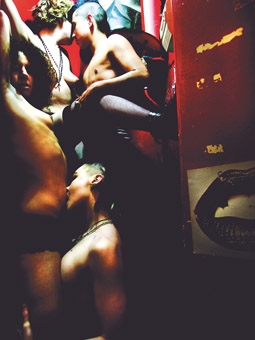
One Night Stand
THE INAUGURAL PERV FILM FESTIVAL, HELD AT THE NEWLY POPE (PLACE OF PUBLIC ENTERTAINMENT) LICENSED RED RATTLER “CREATIVE PLAYGROUND” IN SYDNEY’S MARRICKVILLE, SHOWCASED CUTTING EDGE, INFLUENTIAL QUEER EROTICA REVEALING A RANGE OF SEXUAL PRACTICES AS DIVERSE AS THE QUEER COMMUNITY ITSELF. ASSUMPTIONS THAT CAST THOSE IN SEXUAL MINORITIES AS ‘PERVERTS’ ARE TOSSED ASIDE AND UNDERMINED BY THE PERV PROGRAM AS AUDIENCES FACE THE REALISATION THAT THERE REALLY IS NO NORMATIVE APPROACH TO SEXUALITY AND DESIRE. INSTEAD, THE THRUST OF PERV IS INCLUSIVE, CELEBRATING DIVERSITY AND DIFFERENCE.
The festival was programmed with a refreshingly international scope shown in the inclusion of work from American and European filmmakers, but also provided by the keynote of festival guest, New York filmmaker Katrina del Mar, who presented a retrospective of her short films and music videos.
Del Mar subtly suggested that we don’t search for too much meaning in her work: “Just because”, she reasons when introducing Punchin and Cussin, a rock-video style clip in which tough looking girls box, play drums and swear in many languages. It’s fun, driven by the sheer revelry of girls doing things that girls aren’t supposed to, with a punk F-you attitude.
The cult Gang Girl films are the main attraction in del Mar’s retrospective. In Gang Girls 2000, fictionalised New York girl gangs—The Sluts, Ponies, Glitter Girls and The Blades—pick allegiances when a dispute over a run-over push-bike and a kidnapped pug dog escalates into all out gang warfare. In the Q&A that followed someone asked del Mar about the violence between women in her films. She shrugged, “It’s just things that I think about.” Surf Gang, the next instalment, also offers lashings of violence, but this time more nihilistically, the girls filling a void in their lives with senseless brutality. There are some stunning shots of the iconic New York Rockaway Beach while a Ramones song about the same beach plays. Shots of real surfing cutting away to the girls doing Gidget style ‘blue-screen surfing’ drew knowing chuckles from the audience.
In the Q&A, one bold viewer actually suggested that del Mar should work a bit more on script development. This prompted the filmmaker to talk about the often ad hoc way that her films come together. “I once found these girls in a gas station”, she recalls, “and just asked them, do you want to be in a film?” Of the plot holes in Surf Gang, del Mar says that some people had to go home and the rest had to keep working, so they just “made up an ending.” The underlying DIY-ness of her work sees del Mar unpretentiously assume the voice of a subversive culture, while the use of Super 8mm film lends a warm, nostalgic quality to her fusions of punk-rock iconography and girl on girl fantasy.
The relationship between sexual performance and real sexual conduct is brought into question in One Night Stand/Pour Une Nuit (France, 2006). In making this gritty ‘dyke and trans’ porno, director Emilie Jouvet solicited performers from Paris’ queer community to basically do what they wanted, and in this sense the film approaches sex as it ‘really is.’ Players met and discussed their desires and fantasies, and then were left to play out the intimate scenes ‘naturally’ in front of the cameras. Interviews with the actors shown before the film reveal a sense of collaboration and their involvement with issues raised in One Night Stand.
One actor suggests that “sexuality shouldn’t be dramatised, it should be experienced.” Another talks about the film depicting “the reality” of their “trans body.” The result is something revolutionary, at least when viewed in terms of conventional pornography. The diverse collection of encounters plays out in almost real time, with editing kept to a minimum. There are no staged ‘money’ shots, and the audience is left to cope occasionally with a few seconds of awkward camera adjustment rather than have scenes interrupted. This certainly leads to a voyeuristic feel, as if we are being let in to a world that exists whether we watch it or not. It’s hot too—the players are confident in their own bodies and in sexual interactions. They are free to explore and certainly without the appalling or coercive conditions for which the mainstream porn industry has been criticised. Artifice occasionally asserts itself in the attempts at romantic narrative and, ultimately, in the knowledge that this is, after all, a performance for the camera. Yet, in making the so-called ‘private’ public, One Night Stand moves away from contrived representation, encouraging us to stand back and appreciate unique sexualities without taboo.
The final session of Perv was given over to its short film competition. The 10 finalists constituted a promising mix of local and international up-and-coming filmmakers working loosely in the queer erotic genre. This was a site for experimental erotica, shown in films such as Kym Farman’s pastoral Devil’s Dairy Maid (US, 2008)—a black and white silent film that sexualised the churning of butter. Was this a comment on women’s domestic work, the historic repression of women’s sexuality or the vilification of women as witches? Or it could have simply been echoing del Mar’s “just because.” Catherine Corringer’s This is the Girl (France, 2007) was another experimental piece involving a disjunctive series or images featuring a female boxer, an ambiguous coach/doctor, and a man who is a sex toy. Worth a mention is Tory Blow’s giggle-rousing Hole in the Wall (Australia, 2008)—a two-minute sequence in which a gender ambiguous ‘glory hole’ moves unpredictably of its own accord.
The judges’ award went to Virginia Barratt for Boy Inchoate (Australia, 2008), a whimsical documentary-style film that looked at the beginnings of transing from female to male through the lens of the filmmaker’s relationship with the transer. The film succinctly and cohesively fused domestic snapshots, interviews and wordplay. The Audience Choice awards also went to locals, tied between Tonnette Stanford’s queer Bold and the Beautiful parody, The Vicious and the Delicious (Australia, 2008), and True L.O.V.E (Australia, 2009) directed by Jackson Badger, in which a split screen is used to show a gender ambiguous ‘boy’ and a forceful ‘daddy’ playing out a slave and master fantasy. I’d like to add to this a commendation to the Perv organisers for giving a platform to these works where perhaps there wasn’t one, and for getting this exciting and thought-provoking event up and running.
Perv Film Festival, Red Rattler, April 23-26, Marrickville, Sydney, www.pervfilmfestival.org; www.redrattler.org
RealTime issue #91 June-July 2009 pg. 27
© Megan Garrett-Jones; for permission to reproduce apply to realtime@realtimearts.net
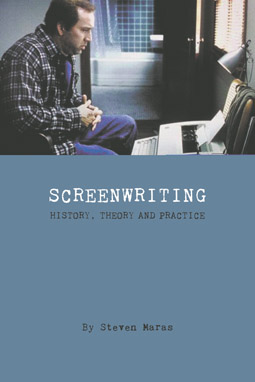 ROBERT MCKEE IS IN AUSTRALIA THIS MONTH, ON THE ROAD WITH HIS ALWAYS WELL-ATTENDED SEMINAR SERIES, PASSING DOWN FROM ON HIGH THE SO-CALLED PRINCIPLES OF THE WELL-WRITTEN SCREENPLAY. WHEN IT COMES TO CLASSICAL, WHITE BREAD STORYTELLING, MCKEE DOES INDEED KNOW HIS STUFF. BUT TO SAY THAT HE’S PASSING IT DOWN FROM ON HIGH IS NOT SO FAR FROM THE TRUTH.
ROBERT MCKEE IS IN AUSTRALIA THIS MONTH, ON THE ROAD WITH HIS ALWAYS WELL-ATTENDED SEMINAR SERIES, PASSING DOWN FROM ON HIGH THE SO-CALLED PRINCIPLES OF THE WELL-WRITTEN SCREENPLAY. WHEN IT COMES TO CLASSICAL, WHITE BREAD STORYTELLING, MCKEE DOES INDEED KNOW HIS STUFF. BUT TO SAY THAT HE’S PASSING IT DOWN FROM ON HIGH IS NOT SO FAR FROM THE TRUTH.
Certainly, that is the way that McKee himself, along with fellow screenwriting gurus Syd Field and Christopher Vogler, tend to think about concepts such as three-act structure and central conflict theory: as theological tenets to be taken on faith, commandments chiselled in stone. When McKee touts himself on his website as “the world authority on Writing”, complete with a capital “W”, he is talking about writing as though it were some kind of Platonic absolute and his take on it the One True Way to enlightenment and a three-film studio deal. As Charlie Kaufman says to his brother Donald, a McKee devotee, in Adaptation, “You sound like you’re in a cult.”
It is perhaps no surprise that Kaufman, in the doughy form of Nicolas Cage, appears on the cover of Screenwriting: History, Theory and Practice, a new book by University of Sydney academic Steven Maras. Like Kaufman, Maras is highly sceptical of this strand of extreme fundamentalism in screenwriting, as he is of anyone who talks about the modern screenplay as though it were an ahistorical phenomenon. For Maras, such claims are not only historically incorrect, but loaded with political and strategic intent as well.
A much-debated form of writing, at once both technical and poetic in function, the screenplay is not something that emerged fully formed at the dawn of cinema’s sound era. Nor is it the teleological endpoint of an evolution in screenwriting practice, a view that implicitly considers photoplays, continuity scripts and scenarios lesser forms of writing struggling to become screenplays. For Maras, the contemporary notion of screenwriting and the centrality of the modern screenplay form to the studio system and film financing have both emerged, to a large extent, out of language. They are the spoils of a battle fought in the pages of industry magazines and photoplay handbooks, theoretical tracts and studio records—not to mention in the pages of the modern screenwriting bibles—to construct the figure of the screenwriter as a creative professional and the author of a film, while installing his work, the screenplay, at the centre of the filmmaking process.
In Screenwriting, Maras sets himself the task of sketching out the borders of this battle, seeking to show how certain key ideas about screenwriting and the screenplay, far from being the eternal truths they are so often sold as, came to be normalised and institutionalised over many decades. Drawing on a meticulously researched range of sources from the 1910s to today, Maras does this through in-depth analysis of screenwriting discourse. He gives space to so many competing voices—critics, theorists, screenwriters and filmmakers—that the result is often cacophonous in its completism.
The book is not a chronological history, but a logically structured argument. From questions about the screenplay’s literary status and how we might approach the form as readers, the book proceeds to wrestle with long-entrenched ideas about the screenplay as a blueprint for production and the notion of what it means to write for the screen. There is also a chapter on auteur theory and its antagonistic relationship with screenwriting, a brilliantly executed argument suggesting that both auteurist and screenwriting discourses alike developed in response to Hollywood’s assembly line mentality, which separated writing from production, conception from execution, leaving everyone on either side feeling the need to assert their creative centrality.
By pulling the seemingly transcendental form of the screenplay back to earth and its historical context, Maras implicitly begins to open up a space in which other forms and practices of writing might be possible. Such alternatives are hinted at in the book’s opening pages, where another type of ‘screen writing’—that with the all-important space between the words—is first introduced. For the most part, this concept then disappears into the background of Maras’s discussion, which is by its own admission primarily concerned with the discursive roots of our more dominant ideas about screenwriting. But the two-word version, screen writing, re-emerges in the book’s conclusion, challenging us to think beyond normative standards. It is well worth the wait.
This is the screen writing of Alexandre Astruc’s caméra-stylo and Agnès Varda’s cinécriture, a writing, not merely for the screen, but on or with it. It is a writing less reliant on language than it is on the material of cinema, on images and sounds arranged in time. While some screenwriters might well argue that this is a loose, auteur-centric definition of writing, Maras suggests, in my view correctly, that by expanding that definition outwards to take in other forms of what he calls “scripting”, we are opening up a greater field of possibilities for the creation of cinema itself. (While Maras’s use of the word “scripting” occasionally seems somewhat redundant, identical in meaning to the rather more appealing “screen writing”, one appreciates not having to double-check every mention in the book of its title for either the compound or two-word construction.)
Maras’s conclusion thus points in new directions, both for the study of screenwriting and, perhaps more importantly, the practice itself. These new directions seem particularly relevant here in our Australian context, where normative standards of story and screenplay have become so central to the funding equation and cinematic ideas so marginal. While Robert McKee claims that an emphasis on story will help writers avoid so-called development hell, in the creative centres of this country an over-emphasis on story—or at least, an under-emphasis on cinema—has in fact become a circle of that hell. Speaking at the Brisbane International Film Festival in 2005, Adrian Martin summed up the situation succinctly. “To wait eight years between projects only to go into development hell refining the script is a very bad trend in Australian cinema”, he said. “Everything gets loaded, gets invested, in the script. Scripts, of course, are very important, though they’re not necessarily the most important thing in a movie. What’s important in a movie is the movie. It’s the cinema.”
In the end, this is what Maras’s book is really about. An important and long-overdue contribution to the historiography of screenwriting, it is also something more than that, as the very best criticism and scholarship always is. In attempting to broaden the horizons of screenwriting, Steven Maras also broadens those of the cinema. As Charlie Kaufman thinks to himself in the final moments of Adaptation: “Who cares what McKee thinks? This feels right.”
Steven Maras, Screenwriting: History, Theory and Practice, Wallflower Press, London, 2009, 256 pages, 978-1-905674-81-7
RealTime issue #91 June-July 2009 pg. 28
© Oscar Michaels; for permission to reproduce apply to realtime@realtimearts.net
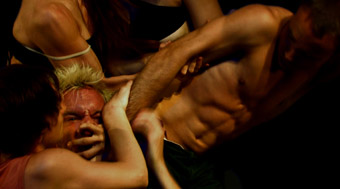
Raft of Medusa
MOVES09’S NARRATIVE-THEMED PROGRAM PROVED TO BE A CHARACTERISTICALLY DYNAMIC FINAL FLOURISH FOR OUTGOING DIRECTOR PASCALE MOYSE. IN ADDITION TO THE FESTIVAL’S DISTINCTIVE MIX OF SCREENDANCE AND MOVING IMAGE, MOYSE HANDS ON AN ENVIABLE LEGACY OF ESTABLISHED FUNDING AND SUBSTANTIAL AUDIENCE GOODWILL TO CURRENT MANAGER GALA PUJOL.
During her three year tenure, Moyse steered the Manchester-based event into a new homebase at the city’s arthouse cinema, in addition to working partnerships with a range of regional, national and international organisations, this year including Northwest-based Comma Pres, Sadler’s Wells in London (home of the curatorially innovative dance/film series Live Screen) and a globe-spanning network of screendance sister festivals.
For 2009, an ongoing commitment to non-traditional, city-wide access points variously included Shelly Love’s newly commissioned exploration of historical portraiture, created for public screen viewing; downloadable podcasts and mobile phone content and Eloi Maduell’s kaleidoscopically interactive pLayModes installation at the Lowry. An additional gallery-set program featured Lutz Gregor’s Raft of Medusa (2008), a contemporary reinterpretation of the Géricault painting. Sergei Eisenstein made reference to “the eye taking a walk” within the process of graphic composition. Gregor’s use of high definition, chiaroscuro-lit, ultra-slow motion leads the viewing eye at leisure along sightlines created between subtly shifting figural groupings.
Maya Deren famously exhorted filmmakers to avoid “trying to invent a plot that moves” and instead to “use the movement of wind, or water…as a poem might celebrate these.” Hilary Goodall’s adjacently sited floor and ceiling projections Earthmoves 1+2 (2008), thus threaded together naturally occurring movement patterns of English summer, as traceries of twigs and branches, surface water currents, and profusion of blossom sat amid viewing friendly deckchairs, picnic hamper and daisy speckled astroturf.
A series of discussion forums at the Cornerhouse Cinema opened with recent work from established British artists Alex Reuben and Becky Edmunds, created during respective residencies in Brazil and Swedish Lapland, with both exploring non-linear narrative forms. Later, Ian Patterson’s speculation on the narrative potential of virtual environments and Paolo Cirio on the genre of recombinant fiction—meshing factually based content with conventions imported from gaming and the blogosphere—represented the festival’s continued slant towards new media-influenced input.
A specially curated, afternoon set edition of Brighton-based South East Dance Agency’s Dance For Camera Nights featured current agency fellowship recipient Lucy Cash enlisting her audience in an improvised Q&A for a collectively imagined film project. She then outlined her own creative approach as the parallel multi-branchings of “quantum storytelling.” A one-day version of the highly influential Open Source Video Dance Forum, led by Simon Fildes at the festival’s end, catalysed grassroots-upwards dialogue, drawing together such historically disparate approaches to movement and narrativity as Maya Deren’s theory of vertical progression and web 2.0 facilitation.
Festival debuts for innovative strands included Max Hatler and Noriko Okaku’s laptop-enabled live performance of intertwined electronic audio and fleeting, fragmented visuals, shown at The Green Room in association with Liverpool-based festival of alternative media, Abandon Normal Devices. A program curated by poetry publishers Comma Press screened within the airily atmospheric surroundings of the Cervantes Institute, showcasing an inventive marriage of non-linear narrative and visual collage, including Manchester-based filmmaker Kate Jessop’s subtle augmentation of Simon Armitage’s rhythmic cadences, On Miles Platting Station (2008), as slate-grey palette of archive commuter footage and red/amber/green rotation of isolated signal lights followed giant, yellow-centred daisies, gently sprouting between long disused sleepers.
From a newly introduced program for younger audiences, Charlotte Dolman’s highly accomplished What’s In Store (2008) created an appealingly anarchic, convincingly self-contained stop-motion world of self-willed cleaning products in broom cupboard hi-jinx. Julie Angel foregrounded the subjective experience of a young, male parkour practitioner in Feedback Loop (2008) as spatially disorienting, body-cam footage of feet and hands reached for slanted concrete, brick and metal, before alighting in a rectangular-framed oasis of green.
In the first of two historically relevant programming slots, a BFI selected cross section of Czeck filmmaker and animator Jan Svankmajer’s output spanned three post-war decades of surrealist influenced work, while Lotte Reiniger’s The Adventures of Prince Achmed, from 1926, set intricate, cursively stylised hand-cut paper silhouettes of heroes, princesses and hydra-headed creatures against vivid washes of background colour.
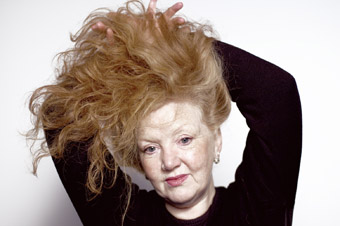
Requiem for the Redhead?
Alternative approaches to narrativity, threaded throughout individual programs and composed of what film editor Walter Murch has referred to as ‘unanticipated collisions’, included Marlene Millar and Philip Szporer’s carefully considered portrait of a dancer at mid-life, intercutting a close-in camera journey across freckled expanses of skin with blue-tinged blurring of coolly distanced movement states in 40 (2009). Lucy Cash’s playfully associative natural history, Requiem for the Redhead? (2008), allowed her the dual role of writer and director, combining voice-over strands of folk myth, urban slang and scientific data with fine rhythmic calibration of imagery, subverting the conventions of photographic portraiture in a fast-moving and visually inventive mug shot-style cascade of copper tops and strawberry blondes.
Aaron Epstein and Daniel Stedman’s The Moth and the Firefly (2008) provided a witty masterclass in narrative economy, offsetting insect movement trajectory against silent film style intertitles. Contrastingly, Jeff Chiba Stearn’s Yellow Sticky Notes (2007) achieved a virtuosic feat of autobiographical animation, mixing high profile world events—as jumping flour sacks and waving blades of grass shimmered, swirled and transformed into rabbit-eared twin towers and a water-spewing tsunami giant—with the ephemeral jottings of personal ‘to do’ lists scribbled on post-it pads. The title of second-time filmmaker Mark Jones’ delicately nuanced documentary, Taken By The Air (2008), reflected both the allure of weightless inversion and its ever present threat of fatality. Beginning with the rhythmic patterning of young feet on stone stairways, a sophisticated balance of photography, DV footage and voice-over contrasted arc lights and feathered costumes with metal harness clamps and nylon rope, as fragments of monologue, given new meaning by cumulative weighting of context, repeated at the film’s end.
A continuing festival focus on global partnership saw carte blanche extend across three continents, as Barcelona-based NU2’s programme of Spanish-made work, introduced by director Núria Font, opened with Aitor Echeverria’s rhythmically inventive linkage of isolated body parts in Aprop (2006), and included Isabel Rocamora’s characteristic measured pacing and studied painterly aesthetic, counterbalanced by a less evenly worked narrative thread, in Promise of Fallen TIme (2008).
A series of African-themed films, curated and presented for Moves by Jeannette Ginslov, featured Guy Spiller’s ethereal, hallucinatory graphics, illustrating the transformative properties of ancient firelit ritual in Trance Dance (2007), and the outsider perspective of Sergio Cruz’ colour and heat drenched fusion of Mozambican music-making, movement and run-down urban environment in Exotica (2009).
Completing the trilogy, a selection from Australia’s ReelDance archive included Madeleine Hetherton and Rowan Marchingo’s luminously photographed portrayal of triangular family tensions in Shadow Play (2007), while a second viewing of Gideon Obrazanek and Edwina Throsby’s deceptively easy-watch movement palette of finger-pointing, head-shaking and bum wiggles in Dance Like Your Old Man (2007)—previously screened in Britain as part of Brighton-based Dance for Camera programming—pinpointed subtle shifts into darker layers of emotional shading as narrated episodes of relationship breakdown within the complex father-daughter bond translate visually into unsettling slow motion and extreme close-up.
Dance filmmaker Douglas Rosenberg has commented on the often precarious positioning of fellow artists, stating that ‘dance itself is a marginal artform and certainly dance film and video makers must be considered on the margins of the margin.” Moves09 presented an appealing model of international networking and co-operation for artists, audiences and festivals, at a pivotal time for the artform’s development. As boundaries expand to include medium-specific composition, an international era of screendance 2.0 appears to be with us.
Moves09, Cornerhouse and other venues, Manchester, April 23-28
RealTime issue #91 June-July 2009 pg. 29
© Chirstinn Whyte; for permission to reproduce apply to realtime@realtimearts.net
WHEN ASKED HOW SHE KNEW GOOD ART, GERTRUDE STEIN REPORTEDLY RETORTED, ”IT MAKES ME ITCH.” HOW DO WE JUDGE GOOD ART—ESPECIALLY GOOD MEDIA ART WHEN THE FIELD IS STILL RELATIVELY NEW AND OUR AUSTRALIAN SECTOR OPERATES AT A DISTANCE FROM THE GLOBAL HUBS OF MEDIA ART PRODUCTION? OUR UNIQUE AUSTRALIAN SENSIBILITY, CONCEPTUAL AND GEOGRAPHICAL DISTANCE CAN ALSO UNFORTUNATELY LEAD TO PAROCHIALISM.
Rather than relying on scratching an itch to identify outstanding work we most often employ a jury or peer review system to ensure fairness and adherence to high standards. In our modern legal system a jury is a sworn body of people convened to render a rational, impartial verdict, its members usually given time off from their daily life to deliberate. In the art world, judges, jurors, peers or assessors are expected to display impartial expertise across a large and encompassing discipline, and must fit often un- or underpaid jury work into already tight schedules.
How carefully is the jury process considered? Are there transparent criteria for selecting a winning artist, project or text? How much time are assessors given to review projects? How appropriately are they paid? Does the process become one of self-enhancement that awards the most personally charming entrant; the most politically opportune artwork; or the candidate who fits best the current institutional profile rather than setting any visionary precedent? Are the technically compliant outcomes of award, residency and prize deliberations always ethical or fair?
the process
Having made the transition from applicant to juror over the past five years, I have found myself sitting in judgment in 30 or so situations ranging from the heavy responsibility of the singular juror to negotiating unwieldly email discussions amongst 20. These have included net art commissions for Rhizome and Turbulence in New York; international symposiums and exhibitions such as several ISEA and Futuresonic Festivals; assessments for ANAT, AFC and the Australia Council for the Arts; art and industry prizes like SmartyBlog, AIMIA and the Queensland Premier’s Award for New Media Art; and, recently, assessing 320 entrants over five days on the five-person Hybrid Arts Jury at Ars Electronica in Austria.
Most challenging was the day-long Second Life Architecture Award “Open Jury” meeting of seven jurors of diverse backgrounds held during the Ars Electronica Festival in 2007. A live audience filled the jury hall—some being entrants in the award. Proceedings were netcast, in real time, to a public square in Second Life where the avatars of global entrants and a general audience also gathered. Our singular jury avatar, resplendent in a pink and green Chanel suit, explored each short-listed project in-world as audience avatars looked on. This online process was simultaneously screened back into the jury room. Inside a constant feedback loop, with no ‘cone of silence’, every word and gesture of the jury was publicly, globally accountable, including the repeated proclamations of an internationally respected senior architect (with no virtual world experience) of “It’s all rubbish!” Five outstanding finalists were eventually selected and we adjourned for beer and schnitzel.
Jury duty is hard, hard work. Academic assessments and online peer reviews are far less charged, as automated forms, comment boxes and rating systems are designed to ensure emotional detachment. However nothing can compare with the personal interaction and vigorous debate that characterises an art jury. It can assume the mantle of a courtroom drama of the Boston Legal kind, with otherwise sane and rational individuals displaying ruthless strategies, pathos and absurdity. Over hours or weeks, bizarre behaviour can emerge as individuals grapple to make decisions. And these decisions are not taken lightly as the outcomes will set agendas for a sector, promote and reward certain artists and artforms.
the people
Permit me to make some observations on the personalities engaged and tactics employed, to a greater or lesser extent, in these grand deliberations.
The Player: Having watched the movie Rainman they know it’s all a numbers game. Their strategy is to rate their favoured artist at around 85-100%, while rating the other strong contenders, or those who seem to be favoured by other jurors, in the bottom 15 %. A shrewder variant of the Player will subtly trade with others for ranking, forfeiting some favourite projects to ensure the elevation of others.
The Persuader: They sit up late in bars bending the ears of other jurors; send prolific emails extolling the virtues of a project; and bring complimentary articles on it to other jurors’ attention. Their lengthy implorings, peppered with rational and emotional hooks, seldom ensure a winning choice.
The Tantrum Thrower: They walk around muttering angrily, or indeed sometimes shouting unabashedly that noone else understands the criteria, the sector, the audience, the projects. They threaten to walk out, talk to the press, issue a dissenting statement. Some tantrum throwers take it further than this, later publishing disparaging articles on the jury process, questioning the character and suitability of the other jurors.
The Dictator: They are often corporate, museum or festival directors without specific knowledge of the arena being juried or, alternately, a highly distinguished and fiercely opinionated veteran jury chair. They truly believe they know best, blocking opinions and discussion in favour of the quick decision. Equally destructive is the politically appointed juror who demonstrates complete disengagement—sometimes falling asleep during deliberations. Strong coffee and dark chocolate should be mandatory assessment refreshments.
The Consensus Seeker: The world would be perfect if everyone agreed, and this juror wants the process to be a shared, harmonious experience. Except, rarely does everyone totally agree. The decision must be made, the announcement has to go out, the publicity department is waiting for copy, but the consensus seeker is undeterred. To them the process is more important than the outcome. Eternal optimism as a redeeming quality is either endlessly infuriating or infectiously refreshing.
the prize
Hopefully sharing the elation of reaching a satisfying consensus—when all are at a point of emotional and physical exhaustion—it’s time to go public. The statements are written, the jury gird their collective loins and, no matter what, smile. At the Announcement, the winner(s) feel deservedly rewarded or are stunned. Those without a prize generously congratulate the winners, and the gossip and rumours start. Everyone is a critic after the fact and of course would have made a better decision. The Art Dealer is the happiest person in the room, grinning from ear to ear, as the profile of their artist instantly soars with this new accolade and its public recognition, financial reward, possible acquisition and career acceleration.
solutions
And there we have it. If we want to award work that really makes us itch, that poses provocative questions, coalesces bodies of knowledge and delivers an accessible and engaging audience experience, then jury selection and the jury process are crucial. But do we want important assessments to be made in airport lounges between flights by exhausted experts? Providing appropriate remuneration and sufficient time to deliberate on all aspects of the works in competition underpins the construction of a vibrant media arts sector.
My vision for our future has Gertrude scratching wildly—immersed in the exteroceptive delights of sight, taste, smell, touch, hearing and balance; revelling in kinaesthetic satisfaction; and savouring her intellectual engagement with the new modalities and emergent practices of media arts.
RealTime issue #91 June-July 2009 pg. 30
© Melinda Rackham; for permission to reproduce apply to realtime@realtimearts.net






 A NEW BOOK, EXPERIMENTAL MUSIC: AUDIO EXPLORATIONS IN AUSTRALIA, FROM UNSW PRESS, OPENS ‘SCENIC’ WINDOWS ONTO HIDDEN WORLDS OF AUDIO CULTURE AND CONTEMPORARY MUSIC-MAKING FOR THOSE WHO MAY HAVE BEEN CAUGHT IN ITS SPELL AND WONDERED WHERE IT ALL CAME FROM.
A NEW BOOK, EXPERIMENTAL MUSIC: AUDIO EXPLORATIONS IN AUSTRALIA, FROM UNSW PRESS, OPENS ‘SCENIC’ WINDOWS ONTO HIDDEN WORLDS OF AUDIO CULTURE AND CONTEMPORARY MUSIC-MAKING FOR THOSE WHO MAY HAVE BEEN CAUGHT IN ITS SPELL AND WONDERED WHERE IT ALL CAME FROM. 




































































































 Turkish musician Erdem Helvacioglu is best known for his work with electric guitar and computer processing, drawing favourable comparisons with guitar/laptop artist Christian Fennesz (although Helvacioglu offers a significantly more polite if somewhat florid version of even Fennesz’s most accessible music). However with his latest release, Wounded Breath, Helvacioglu seems largely to have eschewed the guitar and instead produced an album of electroacoustic compositions.
Turkish musician Erdem Helvacioglu is best known for his work with electric guitar and computer processing, drawing favourable comparisons with guitar/laptop artist Christian Fennesz (although Helvacioglu offers a significantly more polite if somewhat florid version of even Fennesz’s most accessible music). However with his latest release, Wounded Breath, Helvacioglu seems largely to have eschewed the guitar and instead produced an album of electroacoustic compositions. Lucas Abela has been exploring noise performance using a variety of self-constructed instruments for over a decade. Since 2003 Abela’s instrument of choice has been a sheet of glass, which he plays by humming, squealing and raspberry-blowing against it, the miked signal subsequently fed through a utility belt of effects pedals. The performance is spectacular and concludes when he smashes the glass over his head. Showmanship aside, the sounds Abela elicits in his improvised onslaughts are often extraordinary.
Lucas Abela has been exploring noise performance using a variety of self-constructed instruments for over a decade. Since 2003 Abela’s instrument of choice has been a sheet of glass, which he plays by humming, squealing and raspberry-blowing against it, the miked signal subsequently fed through a utility belt of effects pedals. The performance is spectacular and concludes when he smashes the glass over his head. Showmanship aside, the sounds Abela elicits in his improvised onslaughts are often extraordinary.




















































 ROBERT MCKEE IS IN AUSTRALIA THIS MONTH, ON THE ROAD WITH HIS ALWAYS WELL-ATTENDED SEMINAR SERIES, PASSING DOWN FROM ON HIGH THE SO-CALLED PRINCIPLES OF THE WELL-WRITTEN SCREENPLAY. WHEN IT COMES TO CLASSICAL, WHITE BREAD STORYTELLING, MCKEE DOES INDEED KNOW HIS STUFF. BUT TO SAY THAT HE’S PASSING IT DOWN FROM ON HIGH IS NOT SO FAR FROM THE TRUTH.
ROBERT MCKEE IS IN AUSTRALIA THIS MONTH, ON THE ROAD WITH HIS ALWAYS WELL-ATTENDED SEMINAR SERIES, PASSING DOWN FROM ON HIGH THE SO-CALLED PRINCIPLES OF THE WELL-WRITTEN SCREENPLAY. WHEN IT COMES TO CLASSICAL, WHITE BREAD STORYTELLING, MCKEE DOES INDEED KNOW HIS STUFF. BUT TO SAY THAT HE’S PASSING IT DOWN FROM ON HIGH IS NOT SO FAR FROM THE TRUTH.


